2.1: Observational Studies
2.1.1: What are Observational Studies?
An observational study is one in which no variables can be manipulated or controlled by the investigator.
Learning Objective
Identify situations in which observational studies are necessary and the challenges that arise in their interpretation.
Key Points
- An observational study is in contrast with experiments, such as randomized controlled trials, where each subject is randomly assigned to a treated group or a control group.
- Variables may be uncontrollable because 1) a randomized experiment would violate ethical standards, 2) the investigator may simply lack the requisite influence, or 3) a randomized experiment may be impractical.
- Observational studies can never identify causal relationships because even though two variables are related both might be caused by a third, unseen, variable.
- A major challenge in conducting observational studies is to draw inferences that are acceptably free from influences by overt biases, as well as to assess the influence of potential hidden biases.
- A major challenge in conducting observational studies is to draw inferences that are acceptably free from influences by overt biases, as well as to assess the influence of potential hidden biases.
Key Terms
- causality
-
the relationship between an event (the cause) and a second event (the effect), where the second event is understood as a consequence of the first
- observational study
-
a study drawing inferences about the possible effect of a treatment on subjects, where the assignment of subjects into a treated group versus a control group is outside the control of the investigator
A common goal in statistical research is to investigate causality, which is the relationship between an event (the cause) and a second event (the effect), where the second event is understood as a consequence of the first. There are two major types of causal statistical studies: experimental studies and observational studies. An observational study draws inferences about the possible effect of a treatment on subjects, where the assignment of subjects into a treated group versus a control group is outside the control of the investigator. This is in contrast with experiments, such as randomized controlled trials, where each subject is randomly assigned to a treated group or a control group. In other words, observational studies have no independent variables — nothing is manipulated by the experimenter. Rather, observations have the equivalent of two dependent variables.
In an observational study, the assignment of treatments may be beyond the control of the investigator for a variety of reasons:
- A randomized experiment would violate ethical standards: Suppose one wanted to investigate the abortion – breast cancer hypothesis, which postulates a causal link between induced abortion and the incidence of breast cancer. In a hypothetical controlled experiment, one would start with a large subject pool of pregnant women and divide them randomly into a treatment group (receiving induced abortions) and a control group (bearing children), and then conduct regular cancer screenings for women from both groups. Needless to say, such an experiment would run counter to common ethical principles. The published studies investigating the abortion–breast cancer hypothesis generally start with a group of women who already have received abortions. Membership in this “treated” group is not controlled by the investigator: the group is formed after the “treatment” has been assigned.
- The investigator may simply lack the requisite influence: Suppose a scientist wants to study the public health effects of a community-wide ban on smoking in public indoor areas. In a controlled experiment, the investigator would randomly pick a set of communities to be in the treatment group. However, it is typically up to each community and/or its legislature to enact a smoking ban. The investigator can be expected to lack the political power to cause precisely those communities in the randomly selected treatment group to pass a smoking ban. In an observational study, the investigator would typically start with a treatment group consisting of those communities where a smoking ban is already in effect.
- A randomized experiment may be impractical: Suppose a researcher wants to study the suspected link between a certain medication and a very rare group of symptoms arising as a side effect. Setting aside any ethical considerations, a randomized experiment would be impractical because of the rarity of the effect. There may not be a subject pool large enough for the symptoms to be observed in at least one treated subject. An observational study would typically start with a group of symptomatic subjects and work backwards to find those who were given the medication and later developed the symptoms
Usefulness and Reliability of Observational Studies
Observational studies can never identify causal relationships because even though two variables are related both might be caused by a third, unseen, variable. Since the underlying laws of nature are assumed to be causal laws, observational findings are generally regarded as less compelling than experimental findings.
Observational studies can, however:
- Provide information on “real world” use and practice
- Detect signals about the benefits and risks of the use of practices in the general population
- Help formulate hypotheses to be tested in subsequent experiments
- Provide part of the community-level data needed to design more informative pragmatic clinical trials
- Inform clinical practice
A major challenge in conducting observational studies is to draw inferences that are acceptably free from influences by overt biases, as well as to assess the influence of potential hidden biases.

Observational Studies
Nature Observation and Study Hall in The Natural and Cultural Gardens, The Expo Memorial Park, Suita city, Osaka, Japan. Observational studies are a type of experiments in which the variables are outside the control of the investigator.
2.1.2: The Clofibrate Trial
The Clofibrate Trial was a placebo-controlled study to determine the safety and effectiveness of drugs treating coronary heart disease in men.
Learning Objective
Outline how the use of placebos in controlled experiments leads to more reliable results.
Key Points
- Clofibrate was one of four lipid-modifying drugs tested in an observational study known as the Coronary Drug Project.
- Placebo-controlled studies are a way of testing a medical therapy in which, in addition to a group of subjects that receives the treatment to be evaluated, a separate control group receives a sham “placebo” treatment which is specifically designed to have no real effect.
- The purpose of the placebo group is to account for the placebo effect — that is, effects from treatment that do not depend on the treatment itself.
- Appropriate use of a placebo in a clinical trial often requires, or at least benefits from, a double-blind study design, which means that neither the experimenters nor the subjects know which subjects are in the “test group” and which are in the “control group. “.
- The use of placebos is a standard control component of most clinical trials which attempt to make some sort of quantitative assessment of the efficacy of medicinal drugs or treatments.
Key Terms
- regression to the mean
-
the phenomenon by which extreme examples from any set of data are likely to be followed by examples which are less extreme; a tendency towards the average of any sample
- placebo
-
an inactive substance or preparation used as a control in an experiment or test to determine the effectiveness of a medicinal drug
- placebo effect
-
the tendency of any medication or treatment, even an inert or ineffective one, to exhibit results simply because the recipient believes that it will work
Clofibrate (tradename Atromid-S) is an organic compound that is marketed as a fibrate. It is a lipid-lowering agent used for controlling the high cholesterol and triacylglyceride level in the blood. Clofibrate was one of four lipid-modifying drugs tested in an observational study known as the Coronary Drug Project. Also known as the World Health Organization Cooperative Trial on Primary Prevention of Ischaemic Heart Disease, the study was a randomized, multi-center, double-blind, placebo-controlled trial that was intended to study the safety and effectiveness of drugs for long-term treatment of coronary heart disease in men.
Placebo-Controlled Observational Studies
Placebo-controlled studies are a way of testing a medical therapy in which, in addition to a group of subjects that receives the treatment to be evaluated, a separate control group receives a sham “placebo” treatment which is specifically designed to have no real effect. Placebos are most commonly used in blinded trials, where subjects do not know whether they are receiving real or placebo treatment.
The purpose of the placebo group is to account for the placebo effect — that is, effects from treatment that do not depend on the treatment itself. Such factors include knowing one is receiving a treatment, attention from health care professionals, and the expectations of a treatment’s effectiveness by those running the research study. Without a placebo group to compare against, it is not possible to know whether the treatment itself had any effect.
Appropriate use of a placebo in a clinical trial often requires, or at least benefits from, a double-blind study design, which means that neither the experimenters nor the subjects know which subjects are in the “test group” and which are in the “control group. ” This creates a problem in creating placebos that can be mistaken for active treatments. Therefore, it can be necessary to use a psychoactive placebo, a drug that produces physiological effects that encourage the belief in the control groups that they have received an active drug.
Patients frequently show improvement even when given a sham or “fake” treatment. Such intentionally inert placebo treatments can take many forms, such as a pill containing only sugar, a surgery where nothing is actually done, or a medical device (such as ultrasound) that is not actually turned on. Also, due to the body’s natural healing ability and statistical effects such as regression to the mean, many patients will get better even when given no treatment at all. Thus, the relevant question when assessing a treatment is not “does the treatment work? ” but “does the treatment work better than a placebo treatment, or no treatment at all? “
Therefore, the use of placebos is a standard control component of most clinical trials which attempt to make some sort of quantitative assessment of the efficacy of medicinal drugs or treatments.
Results of The Coronary Drug Project
Those in the placebo group who adhered to the placebo treatment (took the placebo regularly as instructed) showed nearly half the mortality rate as those who were not adherent. A similar study of women found survival was nearly 2.5 times greater for those who adhered to their placebo. This apparent placebo effect may have occurred because:
- Adhering to the protocol had a psychological effect, i.e. genuine placebo effect.
- People who were already healthier were more able or more inclined to follow the protocol.
- Compliant people were more diligent and health-conscious in all aspects of their lives.
The Coronary Drug Project found that subjects using clofibrate to lower serum cholesterol observed excess mortality in the clofibrate-treated group despite successful cholesterol lowering (47% more deaths during treatment with clofibrate and 5% after treatment with clofibrate) than the non-treated high cholesterol group. These deaths were due to a wide variety of causes other than heart disease, and remain “unexplained”.
Clofibrate was discontinued in 2002 due to adverse affects.

Placebo-Controlled Observational Studies
Prescription placebos used in research and practice.
2.1.3: Confounding
A confounding variable is an extraneous variable in a statistical model that correlates with both the dependent variable and the independent variable.
Learning Objective
Break down why confounding variables may lead to bias and spurious relationships and what can be done to avoid these phenomenons.
Key Points
- A perceived relationship between an independent variable and a dependent variable that has been misestimated due to the failure to account for a confounding factor is termed a spurious relationship.
- Confounding by indication – the most important limitation of observational studies – occurs when prognostic factors cause bias, such as biased estimates of treatment effects in medical trials.
- Confounding variables may also be categorised according to their source: such as operational confounds, procedural confounds or person confounds.
- A reduction in the potential for the occurrence and effect of confounding factors can be obtained by increasing the types and numbers of comparisons performed in an analysis.
- Moreover, depending on the type of study design in place, there are various ways to modify that design to actively exclude or control confounding variables.
Key Terms
- peer review
-
the scholarly process whereby manuscripts intended to be published in an academic journal are reviewed by independent researchers (referees) to evaluate the contribution, i.e. the importance, novelty and accuracy of the manuscript’s contents
- placebo effect
-
the tendency of any medication or treatment, even an inert or ineffective one, to exhibit results simply because the recipient believes that it will work
- prognostic
-
a sign by which a future event may be known or foretold
- confounding variable
-
an extraneous variable in a statistical model that correlates (positively or negatively) with both the dependent variable and the independent variable
Example
- In risk assessments, factors such as age, gender, and educational levels often have impact on health status and so should be controlled. Beyond these factors, researchers may not consider or have access to data on other causal factors. An example is on the study of smoking tobacco on human health. Smoking, drinking alcohol, and diet are lifestyle activities that are related. A risk assessment that looks at the effects of smoking but does not control for alcohol consumption or diet may overestimate the risk of smoking. Smoking and confounding are reviewed in occupational risk assessments such as the safety of coal mining. When there is not a large sample population of non-smokers or non-drinkers in a particular occupation, the risk assessment may be biased towards finding a negative effect on health.
Confounding Variables
A confounding variable is an extraneous variable in a statistical model that correlates (positively or negatively) with both the dependent variable and the independent variable. A perceived relationship between an independent variable and a dependent variable that has been misestimated due to the failure to account for a confounding factor is termed a spurious relationship, and the presence of misestimation for this reason is termed omitted-variable bias.
As an example, suppose that there is a statistical relationship between ice cream consumption and number of drowning deaths for a given period. These two variables have a positive correlation with each other. An individual might attempt to explain this correlation by inferring a causal relationship between the two variables (either that ice cream causes drowning, or that drowning causes ice cream consumption). However, a more likely explanation is that the relationship between ice cream consumption and drowning is spurious and that a third, confounding, variable (the season) influences both variables: during the summer, warmer temperatures lead to increased ice cream consumption as well as more people swimming and, thus, more drowning deaths.
Types of Confounding
Confounding by indication has been described as the most important limitation of observational studies. Confounding by indication occurs when prognostic factors cause bias, such as biased estimates of treatment effects in medical trials. Controlling for known prognostic factors may reduce this problem, but it is always possible that a forgotten or unknown factor was not included or that factors interact complexly. Randomized trials tend to reduce the effects of confounding by indication due to random assignment.
Confounding variables may also be categorised according to their source:
- The choice of measurement instrument (operational confound) – This type of confound occurs when a measure designed to assess a particular construct inadvertently measures something else as well.
- Situational characteristics (procedural confound) – This type of confound occurs when the researcher mistakenly allows another variable to change along with the manipulated independent variable.
- Inter-individual differences (person confound) – This type of confound occurs when two or more groups of units are analyzed together (e.g., workers from different occupations) despite varying according to one or more other (observed or unobserved) characteristics (e.g., gender).
Decreasing the Potential for Confounding
A reduction in the potential for the occurrence and effect of confounding factors can be obtained by increasing the types and numbers of comparisons performed in an analysis. If a relationship holds among different subgroups of analyzed units, confounding may be less likely. That said, if measures or manipulations of core constructs are confounded (i.e., operational or procedural confounds exist), subgroup analysis may not reveal problems in the analysis.
Peer review is a process that can assist in reducing instances of confounding, either before study implementation or after analysis has occurred. Similarly, study replication can test for the robustness of findings from one study under alternative testing conditions or alternative analyses (e.g., controlling for potential confounds not identified in the initial study). Also, confounding effects may be less likely to occur and act similarly at multiple times and locations.
Moreover, depending on the type of study design in place, there are various ways to modify that design to actively exclude or control confounding variables:
- Case-control studies assign confounders to both groups, cases and controls, equally. In case-control studies, matched variables most often are age and sex.
- In cohort studies, a degree of matching is also possible, and it is often done by only admitting certain age groups or a certain sex into the study population. this creates a cohort of people who share similar characteristics; thus, all cohorts are comparable in regard to the possible confounding variable.
- Double blinding conceals the experiment group membership of the participants from the trial population and the observers. By preventing the participants from knowing if they are receiving treatment or not, the placebo effect should be the same for the control and treatment groups. By preventing the observers from knowing of their membership, there should be no bias from researchers treating the groups differently or from interpreting the outcomes differently.
- A randomized controlled trial is a method where the study population is divided randomly in order to mitigate the chances of self-selection by participants or bias by the study designers. Before the experiment begins, the testers will assign the members of the participant pool to their groups (control, intervention, parallel) using a randomization process such as the use of a random number generator.
2.1.4: Sex Bias in Graduate Admissions
The Berkeley study is one of the best known real life examples of an experiment suffering from a confounding variable.
Learning Objective
Illustrate how the phenomenon of confounding can be seen in practice via Simpson’s Paradox.
Key Points
- A study conducted in the aftermath of a law suit filed against the University of California, Berkeley showed that men applying were more likely than women to be admitted.
- Examination of the aggregate data on admissions showed a blatant, if easily misunderstood, pattern of gender discrimination against applicants.
- When examining the individual departments, it appeared that no department was significantly biased against women.
- The study concluded that women tended to apply to competitive departments with low rates of admission even among qualified applicants, whereas men tended to apply to less-competitive departments with high rates of admission among the qualified applicants.
- Simpson’s Paradox is a paradox in which a trend that appears in different groups of data disappears when these groups are combined, and the reverse trend appears for the aggregate data.
Key Terms
- partition
-
a part of something that had been divided, each of its results
- Simpson’s paradox
-
a paradox in which a trend that appears in different groups of data disappears when these groups are combined, and the reverse trend appears for the aggregate data
- aggregate
-
a mass, assemblage, or sum of particulars; something consisting of elements but considered as a whole
Women have traditionally had limited access to higher education. Moreover, when women began to be admitted to higher education, they were encouraged to major in less-intellectual subjects. For example, the study of English literature in American and British colleges and universities was instituted as a field considered suitable to women’s “lesser intellects”.
However, since 1991 the proportion of women enrolled in college in the U.S. has exceeded the enrollment rate for men, and that gap has widened over time. As of 2007, women made up the majority — 54 percent — of the 10.8 million college students enrolled in the U.S.
This has not negated the fact that gender bias exists in higher education. Women tend to score lower on graduate admissions exams, such as the Graduate Record Exam (GRE) and the Graduate Management Admissions Test (GMAT). Representatives of the companies that publish these tests have hypothesized that greater number of female applicants taking these tests pull down women’s average scores. However, statistical research proves this theory wrong. Controlling for the number of people taking the test does not account for the scoring gap.
Sex Bias at the University of California, Berkeley
On February 7, 1975, a study was published in the journal Science by P.J. Bickel, E.A. Hammel, and J.W. O’Connell entitled “Sex Bias in Graduate Admissions: Data from Berkeley. ” This study was conducted in the aftermath of a law suit filed against the University, citing admission figures for the fall of 1973, which showed that men applying were more likely than women to be admitted, and the difference was so large that it was unlikely to be due to chance.
Examination of the aggregate data on admissions showed a blatant, if easily misunderstood, pattern of gender discrimination against applicants.
Aggregate Data:
Men: 8,442 applicants – 44% admitted
Women: 4,321 applicants – 35% admitted
When examining the individual departments, it appeared that no department was significantly biased against women. In fact, most departments had a small but statistically significant bias in favor of women. The data from the six largest departments are listed below.
Department A
Men: 825 applicants – 62% admitted
Women: 108 applicants – 82% admitted
Department B
Men: 560 applicants – 63% admitted
Women: 25 applicants – 68% admitted
Department C
Men: 325 applicants – 37% admitted
Women: 593 applicants – 34% admitted
Department D
Men: 417 applicants – 33% admitted
Women: 375 applicants – 35% admitted
Department E
Men: 191 applicants – 28% admitted
Women: 393 applicants – 24% admitted
Department F
Men: 272 applicants – 6% admitted
Women: 341 applicants – 7% admitted
The research paper by Bickel et al. concluded that women tended to apply to competitive departments with low rates of admission even among qualified applicants (such as in the English Department), whereas men tended to apply to less-competitive departments with high rates of admission among the qualified applicants (such as in engineering and chemistry). The study also concluded that the graduate departments that were easier to enter at the University, at the time, tended to be those that required more undergraduate preparation in mathematics. Therefore, the admission bias seemed to stem from courses previously taken.
Confounding Variables and Simpson’s Paradox
The above study is one of the best known real life examples of an experiment suffering from a confounding variable. In this particular case, we can see an occurrence of Simpson’s Paradox . Simpson’s Paradox is a paradox in which a trend that appears in different groups of data disappears when these groups are combined, and the reverse trend appears for the aggregate data. This result is often encountered in social-science and medical-science statistics, and is particularly confounding when frequency data are unduly given causal interpretations.

Simpson’s Paradox
An illustration of Simpson’s Paradox. For a full explanation of the figure, visit: http://en.wikipedia.org/wiki/Simpson’s_paradox#Description
The practical significance of Simpson’s paradox surfaces in decision making situations where it poses the following dilemma: Which data should we consult in choosing an action, the aggregated or the partitioned? The answer seems to be that one should sometimes follow the partitioned and sometimes the aggregated data, depending on the story behind the data; with each story dictating its own choice.
As to why and how a story, not data, should dictate choices, the answer is that it is the story which encodes the causal relationships among the variables. Once we extract these relationships we can test algorithmically whether a given partition, representing confounding variables, gives the correct answer.

Confounding Variables in Practice
One of the best real life examples of the presence of confounding variables occurred in a study regarding sex bias in graduate admissions here, at the University of California, Berkeley.
2.2: Controlled Experiments
2.2.1: The Salk Vaccine Field Trial
The Salk polio vaccine field trial incorporated a double blind placebo control methodolgy to determine the effectiveness of the vaccine.
Learning Objective
Demonstrate how controls and treatment groups are used in drug testing.
Key Points
- The first effective polio vaccine was developed in 1952 by Jonas Salk at the University of Pittsburgh.
- Roughly 440,000 people received one or more injections of the vaccine, about 210,000 children received a placebo, consisting of harmless culture media, and 1.2 million children received no vaccination and served as a control group, who would then be observed to see if any contracted polio.
- Two serious issues arose in the original experimental design: selection bias and diagnostic bias.
- The combination of randomized control and double-blind experimental factors, which were implemented in the second version of the experimental design, has become the gold standard for a clinical trial.
Key Terms
- control group
-
the group of test subjects left untreated or unexposed to some procedure and then compared with treated subjects in order to validate the results of the test
- placebo
-
an inactive substance or preparation used as a control in an experiment or test to determine the effectiveness of a medicinal drug
The Salk polio vaccine field trials constitute one of the most famous and one of the largest statistical studies ever conducted. The field trials are of particular value to students of statistics because two different experimental designs were used.
Background
The Salk vaccine, or inactivated poliovirus vaccine (IPV), is based on three wild, virulent reference strains:
- Mahoney (type 1 poliovirus),
- MEF-1 (type 2 poliovirus), and
- Saukett (type 3 poliovirus),
grown in a type of monkey kidney tissue culture (Vero cell line), which are then inactivated with formalin. The injected Salk vaccine confers IgG-mediated immunity in the bloodstream, which prevents polio infection from progressing to viremia and protects the motor neurons, thus eliminating the risk of bulbar polio and post-polio syndrome.
The 1954 Field Trial
Statistical tests of new medical treatments almost always have the same basic format. The responses of a treatment group of subjects who are given the treatment are compared to the responses of a control group of subjects who are not given the treatment. The treatment groups and control groups should be as similar as possible.
Beginning February 23, 1954, the vaccine was tested at Arsenal Elementary School and the Watson Home for Children in Pittsburgh, Pennsylvania. Salk’s vaccine was then used in a test called the Francis Field Trial, led by Thomas Francis; the largest medical experiment in history. The test began with some 4,000 children at Franklin Sherman Elementary School in McLean, Virginia, and would eventually involve 1.8 million children, in 44 states from Maine to California. By the conclusion of the study, roughly 440,000 received one or more injections of the vaccine, about 210,000 children received a placebo, consisting of harmless culture media, and 1.2 million children received no vaccination and served as a control group, who would then be observed to see if any contracted polio.
The results of the field trial were announced April 12, 1955 (the 10th anniversary of the death of President Franklin D. Roosevelt, whose paralysis was generally believed to have been caused by polio). The Salk vaccine had been 60–70% effective against PV1 (poliovirus type 1), over 90% effective against PV2 and PV3, and 94% effective against the development of bulbar polio. Soon after Salk’s vaccine was licensed in 1955, children’s vaccination campaigns were launched. In the U.S, following a mass immunization campaign promoted by the March of Dimes, the annual number of polio cases fell from 35,000 in 1953 to 5,600 by 1957. By 1961 only 161 cases were recorded in the United States.
Experimental Design Issues
The original design of the experiment called for second graders (with parental consent) to form the treatment group and first and third graders to form the control group. This design was known as the observed control experiment.
Two serious issues arose in this design: selection bias and diagnostic bias. Because only second graders with permission from their parents were administered the treatment, this treatment group became self-selecting.
Thus, a randomized control design was implemented to overcome these apparent deficiencies. The key distinguishing feature of the randomized control design is that study subjects, after assessment of eligibility and recruitment, but before the intervention to be studied begins, are randomly allocated to receive one or the other of the alternative treatments under study. Therefore, randomized control tends to negate all effects (such as confounding variables) except for the treatment effect.
This design also had the characteristic of being double-blind. Double-blind describes an especially stringent way of conducting an experiment on human test subjects which attempts to eliminate subjective, unrecognized biases carried by an experiment’s subjects and conductors. In a double-blind experiment, neither the participants nor the researchers know which participants belong to the control group, as opposed to the test group. Only after all data have been recorded (and in some cases, analyzed) do the researchers learn which participants were which.
This combination of randomized control and double-blind experimental factors has become the gold standard for a clinical trial.

The Salk Polio Vaccine Field Trial
Jonas Salk administers his polio vaccine on February 26, 1957 in the Commons Room of the Cathedral of Learning at the University of Pittsburgh where the vaccine was created by Salk and his team.
2.2.2: The Portacaval Shunt
Numerous studies have been conducted to examine the value of the portacaval shunt procedure, many using randomized controls.
Learning Objective
Assess the value that the practice of random assignment adds to experimental design.
Key Points
- A portacaval shunt is a treatment for the liver in which a connection is made between the portal vein, which supplies 75% of the liver’s blood, and the inferior vena cava, the vein that drains blood from the lower two-thirds of the body.
- Of the studies on portacaval shunts, 63% were conducted without controls, 29% were conducted with non-randomized controls, and 8% were conducted with randomized controls.
- The thinking behind random assignment is that any effect observed between treatment groups can be linked to the treatment effect and cannot be considered a characteristic of the individuals in the group.
- Because most basic statistical tests require the hypothesis of an independent randomly sampled population, random assignment is the desired assignment method.
Key Terms
- shunt
-
a passage between body channels constructed surgically as a bypass
- random assignment
-
an experimental technique for assigning subjects to different treatments (or no treatment)
A portacaval shunt is a treatment for high blood pressure in the liver. A connection is made between the portal vein, which supplies 75% of the liver’s blood, and the inferior vena cava, the vein that drains blood from the lower two-thirds of the body. The most common causes of liver disease resulting in portal hypertension are cirrhosis , caused by alcohol abuse, and viral hepatitis (hepatitis B and C). Less common causes include diseases such as hemochromatosis, primary biliary cirrhosis (PBC), and portal vein thrombosis. The procedure is long and hazardous .

The Portacaval Shunt
This image is a trichrome stain showing cirrhosis of the liver. Cirrhosis can be combatted by the portacaval shunt procedure, for which there have been numerous experimental trials using randomized assignment.
Numerous studies have been conducted to examine the value of and potential concerns with the surgery. Of these studies, 63% were conducted without controls, 29% were conducted with non-randomized controls, and 8% were conducted with randomized controls.
Randomized Controlled Experiments
Random assignment, or random placement, is an experimental technique for assigning subjects to different treatments (or no treatment). The thinking behind random assignment is that by randomizing treatment assignments, the group attributes for the different treatments will be roughly equivalent; therefore, any effect observed between treatment groups can be linked to the treatment effect and cannot be considered a characteristic of the individuals in the group.
In experimental design, random assignment of participants in experiments or treatment and control groups help to ensure that any differences between and within the groups are not systematic at the outset of the experiment. Random assignment does not guarantee that the groups are “matched” or equivalent, only that any differences are due to chance.
The steps to random assignment include:
- Begin with a collection of subjects – for example, 20 people.
- Devise a method of randomization that is purely mechanical (e.g. flip a coin).
- Assign subjects with “heads” to one group, the control group; assign subjects with “tails” to the other group, the experimental group.
Because most basic statistical tests require the hypothesis of an independent randomly sampled population, random assignment is the desired assignment method. It provides control for all attributes of the members of the samples—in contrast to matching on only one or more variables—and provides the mathematical basis for estimating the likelihood of group equivalence for characteristics one is interested in. This applies both for pre-treatment checks on equivalence and the evaluation of post treatment results using inferential statistics. More advanced statistical modeling can be used to adapt the inference to the sampling method.
2.2.3: Statistical Controls
A scientific control is an observation designed to minimize the effects of variables other than the single independent variable.
Learning Objective
Classify scientific controls and identify how they are used in experiments.
Key Points
- Scientific controls increase the reliability of test results, often through a comparison between control measurements and the other measurements.
- Positive and negative controls, when both are successful, are usually sufficient to eliminate most potential confounding variables.
- Negative controls are groups where no phenomenon is expected. They ensure that there is no effect when there should be no effect.
- Positive controls are groups where a phenomenon is expected. That is, they ensure that there is an effect when there should be an effect.
Key Terms
- confounding variable
-
an extraneous variable in a statistical model that correlates (positively or negatively) with both the dependent variable and the independent variable
- scientific control
-
an experiment or observation designed to minimize the effects of variables other than the single independent variable
What Is a Control?
A scientific control is an observation designed to minimize the effects of variables other than the single independent variable. This increases the reliability of the results, often through a comparison between control measurements and the other measurements.
For example, during drug testing, scientists will try to control two groups to keep them as identical as possible, then allow one group to try the drug. Another example might be testing plant fertilizer by giving it to only half the plants in a garden: the plants that receive no fertilizer are the control group, because they establish the baseline level of growth that the fertilizer-treated plants will be compared against. Without a control group, the experiment cannot determine whether the fertilizer-treated plants grow more than they would have if untreated.
Ideally, all variables in an experiment will be controlled (accounted for by the control measurements) and none will be uncontrolled. In such an experiment, if all the controls work as expected, it is possible to conclude that the experiment is working as intended and that the results of the experiment are due to the effect of the variable being tested. That is, scientific controls allow an investigator to make a claim like “Two situations were identical until factor X occurred. Since factor X is the only difference between the two situations, the new outcome was caused by factor X. “
Controlled Experiments
Controlled experiments can be performed when it is difficult to exactly control all the conditions in an experiment. In this case, the experiment begins by creating two or more sample groups that are probabilistically equivalent, which means that measurements of traits should be similar among the groups and that the groups should respond in the same manner if given the same treatment. This equivalency is determined by statistical methods that take into account the amount of variation between individuals and the number of individuals in each group. In fields such as microbiology and chemistry, where there is very little variation between individuals and the group size is easily in the millions, these statistical methods are often bypassed and simply splitting a solution into equal parts is assumed to produce identical sample groups.
Types of Controls
The simplest types of control are negative and positive controls. These two controls, when both are successful, are usually sufficient to eliminate most potential confounding variables. This means that the experiment produces a negative result when a negative result is expected and a positive result when a positive result is expected.
Negative Controls
Negative controls are groups where no phenomenon is expected. They ensure that there is no effect when there should be no effect. To continue with the example of drug testing, a negative control is a group that has not been administered the drug. We would say that the control group should show a negative or null effect.
If the treatment group and the negative control both produce a negative result, it can be inferred that the treatment had no effect. If the treatment group and the negative control both produce a positive result, it can be inferred that a confounding variable acted on the experiment, and the positive results are likely not due to the treatment.
Positive Controls
Positive controls are groups where a phenomenon is expected. That is, they ensure that there is an effect when there should be an effect. This is accomplished by using an experimental treatment that is already known to produce that effect and then comparing this to the treatment that is being investigated in the experiment.
Positive controls are often used to assess test validity. For example, to assess a new test’s ability to detect a disease, then we can compare it against a different test that is already known to work. The well-established test is the positive control, since we already know that the answer to the question (whether the test works) is yes.
For difficult or complicated experiments, the result from the positive control can also help in comparison to previous experimental results. For example, if the well-established disease test was determined to have the same effectiveness as found by previous experimenters, this indicates that the experiment is being performed in the same way that the previous experimenters did.
When possible, multiple positive controls may be used. For example, if there is more than one disease test that is known to be effective, more than one might be tested. Multiple positive controls also allow finer comparisons of the results (calibration or standardization) if the expected results from the positive controls have different sizes.

Controlled Experiments
An all-female crew of scientific experimenters began a five-day exercise on December 16, 1974. They conducted 11 selected experiments in materials science to determine their practical application for Spacelab missions and to identify integration and operational problems that might occur on actual missions. Air circulation, temperature, humidity and other factors were carefully controlled.
Chapter 1: Introduction to Statistics and Statistical Thinking
1.1: Overview
1.1.1: Collecting and Measuring Data
There are four main levels of measurement: nominal, ordinal, interval, and ratio.
Learning Objective
Distinguish between the nominal, ordinal, interval and ratio methods of data measurement.
Key Points
- Ratio measurements provide the greatest flexibility in statistical methods that can be used for analyzing the data.
- Interval data allows for the degree of difference between items, but not the ratio between them.
- Ordinal measurements have imprecise differences between consecutive values, but have a meaningful order to those values.
- Variables conforming only to nominal or ordinal measurements cannot be reasonably measured numerically, they are often grouped together as categorical variables.
- Ratio and interval measurements are grouped together as quantitative variables.
- Nominal measurements have no meaningful rank order among values.
Key Terms
- sampling
-
the process or technique of obtaining a representative sample
- population
-
a group of units (persons, objects, or other items) enumerated in a census or from which a sample is drawn
Example
- An example of an observational study is one that explores the correlation between smoking and lung cancer. This type of study typically uses a survey to collect observations about the area of interest and then performs statistical analysis. In this case, the researchers would collect observations of both smokers and non-smokers, perhaps through a case-control study, and then look for the number of cases of lung cancer in each group.
There are four main levels of measurement used in statistics: nominal, ordinal, interval, and ratio. Each of these have different degrees of usefulness in statistical research. Data is collected about a population by random sampling .
Nominal measurements have no meaningful rank order among values. Nominal data differentiates between items or subjects based only on qualitative classifications they belong to. Examples include gender, nationality, ethnicity, language, genre, style, biological species, visual pattern, etc.

Defining a population
In applying statistics to a scientific, industrial, or societal problem, it is necessary to begin with a population or process to be studied. Populations can be diverse topics such as “all persons living in a country” or “all stamps produced in the year 1943”.
Ordinal measurements have imprecise differences between consecutive values, but have a meaningful order to those values. Ordinal data allows for rank order (1st, 2nd, 3rd, etc) by which data can be sorted, but it still does not allow for relative degree of difference between them. Examples of ordinal data include dichotomous values such as “sick” versus “healthy” when measuring health, “guilty” versus “innocent” when making judgments in courts, “false” versus “true”, when measuring truth value. Examples also include non-dichotomous data consisting of a spectrum of values, such as “completely agree”, “mostly agree”, “mostly disagree”, or “completely disagree” when measuring opinion.
Interval measurements have meaningful distances between measurements defined, but the zero value is arbitrary (as in the case with longitude and temperature measurements in Celsius or Fahrenheit). Interval data allows for the degree of difference between items, but not the ratio between them. Ratios are not allowed with interval data since 20°C cannot be said to be “twice as hot” as 10°C, nor can multiplication/division be carried out between any two dates directly. However, ratios of differences can be expressed; for example, one difference can be twice another. Interval type variables are sometimes also called “scaled variables”.
Ratio measurements have both a meaningful zero value and the distances between different measurements are defined; they provide the greatest flexibility in statistical methods that can be used for analyzing the data.
Because variables conforming only to nominal or ordinal measurements cannot be reasonably measured numerically, sometimes they are grouped together as categorical variables, whereas ratio and interval measurements are grouped together as quantitative variables, which can be either discrete or continuous, due to their numerical nature.
Measurement processes that generate statistical data are also subject to error. Many of these errors are classified as random (noise) or systematic (bias), but other important types of errors (e.g., blunder, such as when an analyst reports incorrect units) can also be important.
1.1.2: What Is Statistics?
Statistics is the study of the collection, organization, analysis, interpretation, and presentation of data.
Learning Objective
Define the field of Statistics in terms of its definition, application and history.
Key Points
- Statistics combines mathematical and non-mathematical procedures into one discipline.
- Statistics is generally broken down into two categories: descriptive statistics and inferential statistics.
- Statistics is an applied science and is used in many fields, including the natural and social sciences, government, and business.
- The use of statistical methods dates back to at least the 5th century BC.
Key Terms
- statistics
-
a mathematical science concerned with data collection, presentation, analysis, and interpretation
- empirical
-
verifiable by means of scientific experimentation
Example
- Say you want to conduct a poll on whether your school should use its funding to build a new athletic complex or a new library. Appropriate questions to ask would include: How many people do you have to poll? How do you ensure that your poll is free of bias? How do you interpret your results?
Statistics Overview
Statistics is the study of the collection, organization, analysis, interpretation, and presentation of data. It deals with all aspects of data, including the planning of its collection in terms of the design of surveys and experiments. Some consider statistics a mathematical body of science that pertains to the collection, analysis, interpretation or explanation, and presentation of data, while others consider it a branch of mathematics concerned with collecting and interpreting data. Because of its empirical roots and its focus on applications, statistics is usually considered a distinct mathematical science rather than a branch of mathematics. As one would expect, statistics is largely grounded in mathematics, and the study of statistics has lent itself to many major concepts in mathematics, such as:
- probability,
- distributions ,
- samples and populations,
- estimation, and
- data analysis.
However, much of statistics is also non-mathematical. This includes:
- ensuring that data collection is undertaken in a way that produces valid conclusions,
- coding and archiving data so that information is retained and made useful for international comparisons of official statistics,
- reporting of results and summarized data (tables and graphs) in ways comprehensible to those who must use them, and
- implementing procedures that ensure the privacy of census information.
In short, statistics is the study of data. It includes descriptive statistics (the study of methods and tools for collecting data, and mathematical models to describe and interpret data) and inferential statistics (the systems and techniques for making probability-based decisions and accurate predictions based on incomplete data).
How Do We Use Statistics?
A statistician is someone who is particularly well-versed in the ways of thinking necessary to successfully apply statistical analysis. Such people often gain experience through working in any of a wide number of fields. Statisticians improve data quality by developing specific experimental designs and survey samples. Statistics itself also provides tools for predicting and forecasting the use of data and statistical models. Statistics is applicable to a wide variety of academic disciplines, including natural and social sciences, government, and business. Statistical consultants can help organizations and companies that don’t have in-house expertise relevant to their particular questions.
History of Statistics
Statistical methods date back at least to the 5th century BC. The earliest known writing on statistics appears in a 9th century book entitled Manuscript on Deciphering Cryptographic Messages, written by Al-Kindi. In this book, Al-Kindi provides a detailed description of how to use statistics and frequency analysis to decipher encrypted messages. This was the birth of both statistics and cryptanalysis, according to the Saudi engineer Ibrahim Al-Kadi.
The Nuova Cronica, a 14th century history of Florence by the Florentine banker and official Giovanni Villani, includes much statistical information on population, ordinances, commerce, education, and religious facilities, and has been described as the first introduction of statistics as a positive element in history.
Some scholars pinpoint the origin of statistics to 1663, with the publication of Natural and Political Observations upon the Bills of Mortality by John Graunt. Early applications of statistical thinking revolved around the needs of states to base policy on demographic and economic data, hence its “stat-” etymology. The scope of the discipline of statistics broadened in the early 19th century to include the collection and analysis of data in general.
1.1.3: The Purpose of Statistics
Statistics teaches people to use a limited sample to make intelligent and accurate conclusions about a greater population.
Learning Objective
Describe how Statistics helps us to make inferences about a population, understand and interpret variation, and make more informed everyday decisions.
Key Points
- Statistics is an extremely powerful tool available for assessing the significance of experimental data and for drawing the right conclusions from it.
- Statistics helps scientists, engineers, and many other professionals draw the right conclusions from experimental data.
- Variation is ubiquitous in nature, and probability and statistics are the fields that allow us to study, understand, model, embrace and interpret this variation.
Key Terms
- sample
-
a subset of a population selected for measurement, observation, or questioning to provide statistical information about the population
- population
-
a group of units (persons, objects, or other items) enumerated in a census or from which a sample is drawn
Example
- A company selling the cat food brand “Cato” (a fictitious name here), may claim quite truthfully in their advertisements that eight out of ten cat owners said that their cats preferred Cato brand cat food to “the other leading brand” cat food. What they may not mention is that the cat owners questioned were those they found in a supermarket buying Cato, which doesn’t represent an unbiased sample of cat owners.
Imagine reading a book for the first few chapters and then being able to get a sense of what the ending will be like. This ability is provided by the field of inferential statistics. With the appropriate tools and solid grounding in the field, one can use a limited sample (e.g., reading the first five chapters of Pride & Prejudice) to make intelligent and accurate statements about the population (e.g., predicting the ending of Pride & Prejudice).
Those proceeding to higher education will learn that statistics is an extremely powerful tool available for assessing the significance of experimental data and for drawing the right conclusions from the vast amounts of data encountered by engineers, scientists, sociologists, and other professionals in most spheres of learning. There is no study with scientific, clinical, social, health, environmental or political goals that does not rely on statistical methodologies. The most essential reason for this fact is that variation is ubiquitous in nature, and probability and statistics are the fields that allow us to study, understand, model, embrace and interpret this variation.
In today’s information-overloaded age, statistics is one of the most useful subjects anyone can learn. Newspapers are filled with statistical data, and anyone who is ignorant of statistics is at risk of being seriously misled about important real-life decisions such as what to eat, who is leading the polls, how dangerous smoking is, et cetera. Statistics are often used by politicians, advertisers, and others to twist the truth for their own gain. Knowing at least a little about the field of statistics will help one to make more informed decisions about these and other important questions.

The Purpose of Statistics
Statistics teaches people to use a limited sample to make intelligent and accurate conclusions about a greater population. The use of tables, graphs, and charts play a vital role in presenting the data being used to draw these conclusions.
1.1.4: Inferential Statistics
The mathematical procedure in which we make intelligent guesses about a population based on a sample is called inferential statistics.
Learning Objective
Discuss how inferential statistics allows us to draw conclusions about a population from a random sample and corresponding tests of significance.
Key Points
- Inferential statistics is used to describe systems of procedures that can be used to draw conclusions from data sets arising from systems affected by random variation, such as observational errors, random sampling, or random experimentation.
- Samples must be representative of the entire population in order to induce a conclusion about that population.
- Statisticians use tests of significance to determine the probability that the results were found by chance.
Key Term
- inferential statistics
-
A branch of mathematics that involves drawing conclusions about a population based on sample data drawn from it.
In statistics, statistical inference is the process of drawing conclusions from data that is subject to random variation–for example, observational errors or sampling variation. More substantially, the terms statistical inference, statistical induction, and inferential statistics are used to describe systems of procedures that can be used to draw conclusions from data sets arising from systems affected by random variation, such as observational errors, random sampling, or random experimentation. Initial requirements of such a system of procedures for inference and induction are that the system should produce reasonable answers when applied to well-defined situations and that it should be general enough to be applied across a range of situations.
The outcome of statistical inference may be an answer to the question “what should be done next? ” where this might be a decision about making further experiments or surveys, or about drawing a conclusion before implementing some organizational or governmental policy.
Suppose you have been hired by the National Election Commission to examine how the American people feel about the fairness of the voting procedures in the U.S. How will you do it? Who will you ask?
It is not practical to ask every single American how he or she feels about the fairness of the voting procedures. Instead, we query a relatively small number of Americans, and draw inferences about the entire country from their responses. The Americans actually queried constitute our sample of the larger population of all Americans. The mathematical procedures whereby we convert information about the sample into intelligent guesses about the population fall under the rubric of inferential statistics.
In the case of voting attitudes, we would sample a few thousand Americans, drawn from the hundreds of millions that make up the country. In choosing a sample, it is therefore crucial that it be representative. It must not over-represent one kind of citizen at the expense of others. For example, something would be wrong with our sample if it happened to be made up entirely of Florida residents. If the sample held only Floridians, it could not be used to infer the attitudes of other Americans. The same problem would arise if the sample were comprised only of Republicans. Inferential statistics are based on the assumption that sampling is random. We trust a random sample to represent different segments of society in close to the appropriate proportions (provided the sample is large enough).
Furthermore, when generalizing a trend found in a sample to the larger population, statisticians uses tests of significance (such as the Chi-Square test or the T-test). These tests determine the probability that the results found were by chance, and therefore not representative of the entire population.

Linear Regression in Inferential Statistics
This graph shows a linear regression model, which is a tool used to make inferences in statistics.
1.1.5: Types of Data
Data can be categorized as either primary or secondary and as either qualitative or quantitative.
Learning Objective
Differentiate between primary and secondary data and qualitative and quantitative data.
Key Points
- Primary data is data collected first-hand. Secondary data is data reused from another source.
- Qualitative data is a categorical measurement expressed not in terms of numbers, but rather by means of a natural language description.
- Quantitative data is a numerical measurement expressed not by means of a natural language description, but rather in terms of numbers.
Key Terms
- primary data
-
data that has been compiled for a specific purpose, and has not been collated or merged with others
- qualitative data
-
data centered around descriptions or distinctions based on some quality or characteristic rather than on some quantity or measured value
- quantitative
-
of a measurement based on some quantity or number rather than on some quality
Example
- Qualitative data: race, religion, gender, etc. Quantitative data: height in inches, time in seconds, temperature in degrees, etc.
Primary and Secondary Data
Data can be classified as either primary or secondary. Primary data is original data that has been collected specially for the purpose in mind. This type of data is collected first hand. Those who gather primary data may be an authorized organization, investigator, enumerator or just someone with a clipboard. These people are acting as a witness, so primary data is only considered as reliable as the people who gather it. Research where one gathers this kind of data is referred to as field research. An example of primary data is conducting your own questionnaire.
Secondary data is data that has been collected for another purpose. This type of data is reused, usually in a different context from its first use. You are not the original source of the data–rather, you are collecting it from elsewhere. An example of secondary data is using numbers and information found inside a textbook.
Knowing how the data was collected allows critics of a study to search for bias in how it was conducted. A good study will welcome such scrutiny. Each type has its own weaknesses and strengths. Primary data is gathered by people who can focus directly on the purpose in mind. This helps ensure that questions are meaningful to the purpose, but this can introduce bias in those same questions. Secondary data doesn’t have the privilege of this focus, but is only susceptible to bias introduced in the choice of what data to reuse. Stated another way, those who gather secondary data get to pick the questions. Those who gather primary data get to write the questions. There may be bias either way.
Qualitative and Quantitative Data
Qualitative data is a categorical measurement expressed not in terms of numbers, but rather by means of a natural language description. In statistics, it is often used interchangeably with “categorical” data. Collecting information about a favorite color is an example of collecting qualitative data. Although we may have categories, the categories may have a structure to them. When there is not a natural ordering of the categories, we call these nominal categories. Examples might be gender, race, religion, or sport. When the categories may be ordered, these are called ordinal categories. Categorical data that judge size (small, medium, large, etc. ) are ordinal categories. Attitudes (strongly disagree, disagree, neutral, agree, strongly agree) are also ordinal categories; however, we may not know which value is the best or worst of these issues. Note that the distance between these categories is not something we can measure.
Quantitative data is a numerical measurement expressed not by means of a natural language description, but rather in terms of numbers. Quantitative data always are associated with a scale measure. Probably the most common scale type is the ratio-scale. Observations of this type are on a scale that has a meaningful zero value but also have an equidistant measure (i.e. the difference between 10 and 20 is the same as the difference between 100 and 110). For example, a 10 year-old girl is twice as old as a 5 year-old girl. Since you can measure zero years, time is a ratio-scale variable. Money is another common ratio-scale quantitative measure. Observations that you count are usually ratio-scale (e.g. number of widgets). A more general quantitative measure is the interval scale. Interval scales also have an equidistant measure. However, the doubling principle breaks down in this scale. A temperature of 50 degrees Celsius is not “half as hot” as a temperature of 100, but a difference of 10 degrees indicates the same difference in temperature anywhere along the scale.

Quantitative Data
The graph shows a display of quantitative data.
1.1.6: Applications of Statistics
Statistics deals with all aspects of the collection, organization, analysis, interpretation, and presentation of data.
Learning Objective
Describe how statistics is applied to scientific, industrial, and societal problems.
Key Points
- Statistics can be used to improve data quality by developing specific experimental designs and survey samples.
- Statistics includes the planning of data collection in terms of the design of surveys and experiments.
- Statistics provides tools for prediction and forecasting and is applicable to a wide variety of academic disciplines, including natural and social sciences, as well as government, and business.
Key Terms
- population
-
a group of units (persons, objects, or other items) enumerated in a census or from which a sample is drawn
- statistics
-
The study of the collection, organization, analysis, interpretation, and presentation of data.
- sample
-
a subset of a population selected for measurement, observation, or questioning to provide statistical information about the population
Example
- In calculating the arithmetic mean of a sample, for example, the algorithm works by summing all the data values observed in the sample and then dividing this sum by the number of data items. This single measure, the mean of the sample, is called a statistic; its value is frequently used as an estimate of the mean value of all items comprising the population from which the sample is drawn. The population mean is also a single measure; however, it is not called a statistic; instead it is called a population parameter.
Statistics deals with all aspects of the collection, organization, analysis, interpretation, and presentation of data. It includes the planning of data collection in terms of the design of surveys and experiments.
Statistics can be used to improve data quality by developing specific experimental designs and survey samples. Statistics also provides tools for prediction and forecasting. Statistics is applicable to a wide variety of academic disciplines, including natural and social sciences as well as government and business. Statistical consultants can help organizations and companies that don’t have in-house expertise relevant to their particular questions.
Descriptive and Inferential Statistics
Statistical methods can summarize or describe a collection of data. This is called descriptive statistics . This is particularly useful in communicating the results of experiments and research. Statistical models can also be used to draw statistical inferences about the process or population under study—a practice called inferential statistics. Inference is a vital element of scientific advancement, since it provides a way to draw conclusions from data that are subject to random variation. Conclusions are tested in order to prove the propositions being investigated further, as part of the scientific method. Descriptive statistics and analysis of the new data tend to provide more information as to the truth of the proposition.

Summary statistics
In descriptive statistics, summary statistics are used to summarize a set of observations, in order to communicate the largest amount as simply as possible. This Boxplot represents Michelson and Morley’s data on the speed of light. It consists of five experiments, each made of 20 consecutive runs.
The Statistical Process
When applying statistics to a scientific, industrial, or societal problems, it is necessary to begin with a population or process to be studied. Populations can be diverse topics such as “all persons living in a country” or “every atom composing a crystal”. A population can also be composed of observations of a process at various times, with the data from each observation serving as a different member of the overall group. Data collected about this kind of “population” constitutes what is called a time series. For practical reasons, a chosen subset of the population called a sample is studied—as opposed to compiling data about the entire group (an operation called census). Once a sample that is representative of the population is determined, data is collected for the sample members in an observational or experimental setting. This data can then be subjected to statistical analysis, serving two related purposes: description and inference.
Descriptive statistics summarize the population data by describing what was observed in the sample numerically or graphically. Numerical descriptors include mean and standard deviation for continuous data types (like heights or weights), while frequency and percentage are more useful in terms of describing categorical data (like race). Inferential statistics uses patterns in the sample data to draw inferences about the population represented, accounting for randomness. These inferences may take the form of: answering yes/no questions about the data (hypothesis testing), estimating numerical characteristics of the data (estimation), describing associations within the data (correlation) and modeling relationships within the data (for example, using regression analysis). Inference can extend to forecasting, prediction and estimation of unobserved values either in or associated with the population being studied. It can include extrapolation and interpolation of time series or spatial data and can also include data mining.
Statistical Analysis
Statistical analysis of a data set often reveals that two variables of the population under consideration tend to vary together, as if they were connected. For example, a study of annual income that also looks at age of death might find that poor people tend to have shorter lives than affluent people. The two variables are said to be correlated; however, they may or may not be the cause of one another. The correlation could be caused by a third, previously unconsidered phenomenon, called a confounding variable. For this reason, there is no way to immediately infer the existence of a causal relationship between the two variables.
To use a sample as a guide to an entire population, it is important that it truly represent the overall population. Representative sampling assures that inferences and conclusions can safely extend from the sample to the population as a whole. A major problem lies in determining the extent that the sample chosen is actually representative. Statistics offers methods to estimate and correct for any random trending within the sample and data collection procedures. There are also methods of experimental design for experiments that can lessen these issues at the outset of a study, strengthening its capability to discern truths about the population. Randomness is studied using the mathematical discipline of probability theory. Probability is used in “mathematical statistics” (alternatively, “statistical theory”) to study the sampling distributions of sample statistics and, more generally, the properties of statistical procedures. The use of any statistical method is valid when the system or population under consideration satisfies the assumptions of the method.
1.1.7: Fundamentals of Statistics
In applying statistics to a scientific, industrial, or societal problem, it is necessary to begin with a population or process to be studied.
Learning Objective
Recall that the field of Statistics involves using samples to make inferences about populations and describing how variables relate to each other.
Key Points
- For practical reasons, a chosen subset of the population called a sample is studied—as opposed to compiling data about the entire group (an operation called census).
- Descriptive statistics summarizes the population data by describing what was observed in the sample numerically or graphically.
- Inferential statistics uses patterns in the sample data to draw inferences about the population represented, accounting for randomness.
- Statistical analysis of a data set often reveals that two variables (properties) of the population under consideration tend to vary together, as if they were connected.
- To use a sample as a guide to an entire population, it is important that it truly represent the overall population.
Key Terms
- sample
-
a subset of a population selected for measurement, observation, or questioning to provide statistical information about the population
- variable
-
a quantity that may assume any one of a set of values
- population
-
a group of units (persons, objects, or other items) enumerated in a census or from which a sample is drawn
Example
- A population can be composed of observations of a process at various times, with the data from each observation serving as a different member of the overall group. Data collected about this kind of “population” constitutes what is called a time series.
In applying statistics to a scientific, industrial, or societal problem, it is necessary to begin with a population or process to be studied. Populations can be diverse topics such as “all persons living in a country” or “every atom composing a crystal.”. A population can also be composed of observations of a process at various times, with the data from each observation serving as a different member of the overall group. Data collected about this kind of “population” constitutes what is called a time series.
For practical reasons, a chosen subset of the population called a sample is studied—as opposed to compiling data about the entire group (an operation called census). Once a sample that is representative of the population is determined, data is collected for the sample members in an observational or experimental setting. This data can then be subjected to statistical analysis, serving two related purposes: description and inference.
- Descriptive statistics summarizes the population data by describing what was observed in the sample numerically or graphically. Numerical descriptors include mean and standard deviation for continuous data types (like heights or weights), while frequency and percentages are more useful in terms of describing categorical data (like race).
- Inferential statistics uses patterns in the sample data to draw inferences about the population represented, accounting for randomness. These inferences may take the form of: answering yes/no questions about the data (hypothesis testing), estimating numerical characteristics of the data (estimation), describing associations within the data (correlation ) and modeling relationships within the data (for example, using regression analysis). Inference can extend to forecasting, prediction and estimation of unobserved values either in or associated with the population being studied. It can include extrapolation and interpolation of time series or spatial data, and can also include data mining.
The concept of correlation is particularly noteworthy for the potential confusion it can cause. Statistical analysis of a data set often reveals that two variables (properties) of the population under consideration tend to vary together, as if they were connected. For example, a study of annual income that also looks at age of death might find that poor people tend to have shorter lives than affluent people. The two variables are said to be correlated; however, they may or may not be the cause of one another. The correlation phenomena could be caused by a third, previously unconsidered phenomenon, called a confounding variable. For this reason, there is no way to immediately infer the existence of a causal relationship between the two variables.
To use a sample as a guide to an entire population, it is important that it truly represent the overall population. Representative sampling assures that inferences and conclusions can safely extend from the sample to the population as a whole. A major problem lies in determining the extent that the sample chosen is actually representative. Statistics offers methods to estimate and correct for any random trending within the sample and data collection procedures. There are also methods of experimental design for experiments that can lessen these issues at the outset of a study, strengthening its capability to discern truths about the population.
Randomness is studied using the mathematical discipline of probability theory. Probability is used in “mathematical statistics” (alternatively, “statistical theory”) to study the sampling distributions of sample statistics and, more generally, the properties of statistical procedures. The use of any statistical method is valid when the system or population under consideration satisfies the assumptions of the method.
1.1.8: Critical Thinking
The essential skill of critical thinking will go a long way in helping one to develop statistical literacy.
Learning Objective
Interpret the role that the process of critical thinking plays in statistical literacy.
Key Points
- Statistics can be made to produce misrepresentations of data that may seem valid.
- Statistical literacy is necessary to understand what makes a poll trustworthy and to properly weigh the value of poll results and conclusions.
- Critical thinking is a way of deciding whether a claim is always true, sometimes true, partly true, or false.
- The list of core critical thinking skills includes observation, interpretation, analysis, inference, evaluation, explanation, and meta-cognition.
Key Terms
- statistical literacy
-
the ability to understand statistics, necessary for citizens to understand mateiral presented in publications such as newspapers, television, and the Internet
- critical thinking
-
the application of logical principles, rigorous standards of evidence, and careful reasoning to the analysis and discussion of claims, beliefs, and issues
Each day people are inundated with statistical information from advertisements (“4 out of 5 dentists recommend”), news reports (“opinion polls show the incumbent leading by four points”), and even general conversation (“half the time I don’t know what you’re talking about”). Experts and advocates often use numerical claims to bolster their arguments, and statistical literacy is a necessary skill to help one decide what experts mean and which advocates to believe. This is important because statistics can be made to produce misrepresentations of data that may seem valid. The aim of statistical literacy is to improve the public understanding of numbers and figures.
For example, results of opinion polling are often cited by news organizations, but the quality of such polls varies considerably. Some understanding of the statistical technique of sampling is necessary in order to be able to correctly interpret polling results. Sample sizes may be too small to draw meaningful conclusions, and samples may be biased. The wording of a poll question may introduce a bias, and thus can even be used intentionally to produce a biased result. Good polls use unbiased techniques, with much time and effort being spent in the design of the questions and polling strategy. Statistical literacy is necessary to understand what makes a poll trustworthy and to properly weigh the value of poll results and conclusions.
Critical Thinking
The essential skill of critical thinking will go a long way in helping one to develop statistical literacy. Critical thinking is a way of deciding whether a claim is always true, sometimes true, partly true, or false. The list of core critical thinking skills includes observation, interpretation, analysis, inference, evaluation, explanation, and meta-cognition. There is a reasonable level of consensus that an individual or group engaged in strong critical thinking gives due consideration to establish:
- Evidence through observation,
- Context skills,
- Relevant criteria for making the judgment well,
- Applicable methods or techniques for forming the judgment, and
- Applicable theoretical constructs for understanding the problem and the question at hand.
Critical thinking calls for the ability to:
- Recognize problems, to find workable means for meeting those problems,
- Understand the importance of prioritization and order of precedence in problem solving,
- Gather and marshal pertinent (relevant) information,
- Recognize unstated assumptions and values,
- Comprehend and use language with accuracy, clarity, and discernment,
- Interpret data, to appraise evidence and evaluate arguments,
- Recognize the existence (or non-existence) of logical relationships between propositions,
- Draw warranted conclusions and generalizations,
- Put to test the conclusions and generalizations at which one arrives,
- Reconstruct one’s patterns of beliefs on the basis of wider experience, and
- Render accurate judgments about specific things and qualities in everyday life.
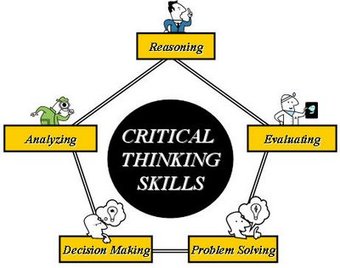
Critical Thinking
Critical thinking is an inherent part of data analysis and statistical literacy.
1.1.9: Experimental Design
Experimental design is the design of studies where variation, which may or may not be under full control of the experimenter, is present.
Learning Objective
Outline the methodology for designing experiments in terms of comparison, randomization, replication, blocking, orthogonality, and factorial experiments
Key Points
- The experimenter is often interested in the effect of some process or intervention (the “treatment”) on some objects (the “experimental units”), which may be people, parts of people, groups of people, plants, animals, etc.
- A methodology for designing experiments involves comparison, randomization, replication, blocking, orthogonality, and factorial considerations.
- It is best that a process be in reasonable statistical control prior to conducting designed experiments.
- One of the most important requirements of experimental research designs is the necessity of eliminating the effects of spurious, intervening, and antecedent variables.
Key Terms
- dependent variable
-
in an equation, the variable whose value depends on one or more variables in the equation
- independent variable
-
in an equation, any variable whose value is not dependent on any other in the equation
- experiment
-
A test under controlled conditions made to either demonstrate a known truth, examine the validity of a hypothesis, or determine the efficacy of something previously untried.
Example
- For example, if a researcher feeds an experimental artificial sweetener to sixty laboratory rats and observes that ten of them subsequently become sick, the underlying cause could be the sweetener itself or something unrelated. Other variables, which may not be readily obvious, may interfere with the experimental design. For instance, perhaps the rats were simply not supplied with enough food or water, or the water was contaminated and undrinkable, or the rats were under some psychological or physiological stress, etc. Eliminating each of these possible explanations individually would be time-consuming and difficult. However, if a control group is used that does not receive the sweetener but is otherwise treated identically, any difference between the two groups can be ascribed to the sweetener itself with much greater confidence.
In general usage, design of experiments or experimental design is the design of any information-gathering exercises where variation is present, whether under the full control of the experimenter or not. Formal planned experimentation is often used in evaluating physical objects, chemical formulations, structures, components, and materials. In the design of experiments, the experimenter is often interested in the effect of some process or intervention (the “treatment”) on some objects (the “experimental units”), which may be people, parts of people, groups of people, plants, animals, etc. Design of experiments is thus a discipline that has very broad application across all the natural and social sciences and engineering.
A methodology for designing experiments was proposed by Ronald A. Fisher in his innovative books The Arrangement of Field Experiments (1926) and The Design of Experiments (1935). These methods have been broadly adapted in the physical and social sciences.

Old-fashioned scale
A scale is emblematic of the methodology of experimental design which includes comparison, replication, and factorial considerations.
- Comparison: In some fields of study it is not possible to have independent measurements to a traceable standard. Comparisons between treatments are much more valuable and are usually preferable. Often one compares against a scientific control or traditional treatment that acts as baseline.
- Randomization: Random assignment is the process of assigning individuals at random to groups or to different groups in an experiment. The random assignment of individuals to groups (or conditions within a group) distinguishes a rigorous, “true” experiment from an adequate, but less-than-rigorous, “quasi-experiment”. Random does not mean haphazard, and great care must be taken that appropriate random methods are used.
- Replication: Measurements are usually subject to variation and uncertainty. Measurements are repeated and full experiments are replicated to help identify the sources of variation, to better estimate the true effects of treatments, to further strengthen the experiment’s reliability and validity, and to add to the existing knowledge of the topic.
- Blocking: Blocking is the arrangement of experimental units into groups (blocks) consisting of units that are similar to one another. Blocking reduces known but irrelevant sources of variation between units and thus allows greater precision in the estimation of the source of variation under study.
- Orthogonality: Orthogonality concerns the forms of comparison (contrasts) that can be legitimately and efficiently carried out. Contrasts can be represented by vectors and sets of orthogonal contrasts are uncorrelated and independently distributed if the data are normal. Because of this independence, each orthogonal treatment provides different information to the others. If there are
treatments and
orthogonal contrasts, all the information that can be captured from the experiment is obtainable from the set of contrasts. - Factorial experiments: Use of factorial experiments instead of the one-factor-at-a-time method. These are efficient at evaluating the effects and possible interactions of several factors (independent variables). Analysis of experiment design is built on the foundation of the analysis of variance, a collection of models that partition the observed variance into components, according to what factors the experiment must estimate or test.
It is best that a process be in reasonable statistical control prior to conducting designed experiments. When this is not possible, proper blocking, replication, and randomization allow for the careful conduct of designed experiments. To control for nuisance variables, researchers institute control checks as additional measures. Investigators should ensure that uncontrolled influences (e.g., source credibility perception) are measured do not skew the findings of the study.
One of the most important requirements of experimental research designs is the necessity of eliminating the effects of spurious, intervening, and antecedent variables. In the most basic model, cause (
) leads to effect (
). But there could be a third variable (
) that influences (
), and
might not be the true cause at all.
is said to be a spurious variable and must be controlled for. The same is true for intervening variables (a variable in between the supposed cause (
) and the effect (
)), and anteceding variables (a variable prior to the supposed cause (
) that is the true cause). In most designs, only one of these causes is manipulated at a time.
1.1.10: Random Samples
An unbiased random selection of individuals is important so that in the long run, the sample represents the population.
Learning Objective
Explain how simple random sampling leads to every object having the same possibility of being chosen.
Key Points
- Simple random sampling merely allows one to draw externally valid conclusions about the entire population based on the sample.
- Advantages of random sampling are that it is free of classification error, and it requires minimum advance knowledge of the population other than the frame.
- Simple random sampling best suits situations where not much information is available about the population and data collection can be efficiently conducted on randomly distributed items, or where the cost of sampling is small enough to make efficiency less important than simplicity.
Key Terms
- population
-
a group of units (persons, objects, or other items) enumerated in a census or from which a sample is drawn
- random sample
-
a sample randomly taken from an investigated population
Sampling is concerned with the selection of a subset of individuals from within a statistical population to estimate characteristics of the whole population . Two advantages of sampling are that the cost is lower and data collection is faster than measuring the entire population.

Random Sampling
MIME types of a random sample of supplementary materials from the Open Access subset in PubMed Central as of October 23, 2012. The colour code means that the MIME type of the supplementary files is indicated correctly (green) or incorrectly (red) in the XML at PubMed Central.
Each observation measures one or more properties (such as weight, location, color) of observable bodies distinguished as independent objects or individuals. In survey sampling, weights can be applied to the data to adjust for the sample design, particularly stratified sampling (blocking). Results from probability theory and statistical theory are employed to guide practice. In business and medical research, sampling is widely used for gathering information about a population.
A simple random sample is a subset of individuals chosen from a larger set (a population). Each individual is chosen randomly and entirely by chance, such that each individual has the same probability of being chosen at any stage during the sampling process and each subset of
individuals has the same probability of being chosen for the sample as any other subset of
individuals. A simple random sample is an unbiased surveying technique.
Simple random sampling is a basic type of sampling, since it can be a component of other more complex sampling methods. The principle of simple random sampling is that every object has the same possibility to be chosen. For example,
college students want to get a ticket for a basketball game, but there are not enough tickets (
) for them, so they decide to have a fair way to see who gets to go. Then, everybody is given a number (0 to
), and random numbers are generated. The first
numbers would be the lucky ticket winners.
In small populations and often in large ones, such sampling is typically done “without replacement” (i.e., one deliberately avoids choosing any member of the population more than once). Although simple random sampling can be conducted with replacement instead, this is less common and would normally be described more fully as simple random sampling with replacement. Sampling done without replacement is no longer independent, but still satisfies exchangeability. Hence, many results still hold. Further, for a small sample from a large population, sampling without replacement is approximately the same as sampling with replacement, since the odds of choosing the same individual twice is low.
An unbiased random selection of individuals is important so that, in the long run, the sample represents the population. However, this does not guarantee that a particular sample is a perfect representation of the population. Simple random sampling merely allows one to draw externally valid conclusions about the entire population based on the sample.
Conceptually, simple random sampling is the simplest of the probability sampling techniques. It requires a complete sampling frame, which may not be available or feasible to construct for large populations. Even if a complete frame is available, more efficient approaches may be possible if other useful information is available about the units in the population.
Advantages are that it is free of classification error, and it requires minimum advance knowledge of the population other than the frame. Its simplicity also makes it relatively easy to interpret data collected via SRS. For these reasons, simple random sampling best suits situations where not much information is available about the population and data collection can be efficiently conducted on randomly distributed items, or where the cost of sampling is small enough to make efficiency less important than simplicity. If these conditions are not true, stratified sampling or cluster sampling may be a better choice.
Chapter 21: Social Change
21.1: Social Change and Collective Behavior
21.1.1: Social Change
Collective behavior can result in social change through the formation of cohesive social movements.
Learning Objective
Analyze a real-life example, such as the Voting Rights Act, in terms of social change
Key Points
- Collective behavior can be distinguished from group behavior, and it is also distinct from deviant and conforming actions.
- Collective behavior can be observed in four types of groupings of people: the crowd, the mass, the public, and social movements, although other phenomena, such as fads and rumors, are also considered to be forms of collective behavior.
- Studying collective behavior improves our understanding of how to organize social movements to initiate social change.
- There are two main reasons for studying collective behavior. First, to reduce the damage caused by events such as natural disasters and riots by understanding how people behave in these situations; second, studying collective behavior improves our understanding of how to organize social movements in order to initiate social change.
- A crowd is an assembly of people who come together with a shared purpose or intent, and have an influence over one another. The four type of crowds, as identified by Herbert Blumer, are casual, conventional, expressive and acting. Diffuse crowds are crowds that are scattered across large distances.
- Posited by Gustave Lebon in 1896, contagion theory asserts that crowds have a hypnotic influence over their members, which, combined with the anonymity that individuals in a crowd can enjoy, leads to irrational and emotional behavior.
- Convergence Theory proposes that crowd behavior is the product of like-minded individuals coming together and is not an inherent characteristic of the crowd itself.
- A combination of the theories of convergence and contagion, the emergent-norm theory states that crowd behavior is the product of the convergence of like-minded people, the sense of anonymity in a crowd and shared emotions. Underlying this theory is the symbolic-interactionist perspective.
- Understanding crowds as “gatherings,” which are temporary and are formed by an assembling process, allows us to create a distinction between what causes people to gather and what actions they take once they have gathered. Moreover, seeings crowds as gatherings also refutes the idea that crowds can impair judgment.
- A panic is a sudden terror which dominates thinking and can affect groups of people. A moral panic is a mass movement that arises when an invidual or group, frequently a minority or subculture, is perceived to be a threat to society.
- A riot is a form of civil disorder that is characterized by disorganized groups lashing out and disturbing the peace in a sudden and intense rash of violence, vandalism or other crime. Riots typically reflect grievance or a sense of dissatisfaction with existing conditions. Unlike a mob, a riot is violent crowd behavior without a specific objective.
- “Mass hysteria” is a phrase used to describe a large group of people who share a mental state of fear or anxiety.
- A fad is a fashion that gains salience quickly in a culture or subculture, and remains popular for a brief period of time before losing its appeal dramatically.
- A rumor is an unverified account or explanation of events circulating from person to person and pertaining to an object, event, or issue in public concern.
Key Terms
- riot
-
Wanton or unrestrained behavior; uproar; tumult.
- Collective behavior
-
The expression collective behavior was first used by Robert E. Park, and employed definitively by Herbert Blumer, to refer to social processes and events which do not reflect existing social structure (laws, conventions, and institutions), but which emerge in a “spontaneous” way.
Collective behavior refers to social processes and events that do not reflect existing social structure (laws, conventions, and institutions), as they emerge in a “spontaneous” way. Collective behavior might also be defined as action that is neither conforming (in which actors follow prevailing norms) nor deviant (in which actors violate those norms). Rather, collective behavior, a third form of action, takes place when norms are absent or unclear, or when they contradict each other. Scholars have devoted far less attention to collective behavior than they have to either conformity or deviance.
Examples of collective behavior include: religious revival meetings (like those depicted in the documentary Marjoe), a panic in a burning theater (e.g., the Kentucky Beverly Hills Supper Club fire), a sudden widespread interest in a website (e.g., MySpace) or clothing item (e.g., WristStrong bracelets), a collective social movement to improve the environment (e.g., Greenpeace), or the rapid spread of rumors (e.g., that Barack Obama is Muslim or not a US citizen). These diverse actions fall within the area sociologists call collective behavior.
Collective behavior differs from group behavior in three ways:
- Collective behavior involves limited and short-lived social interactions, while groups tend to remain together longer.
- Collective behavior has no clear social boundaries; anyone can be a member of the collective, while group membership is usually more discriminating.
- Collective behavior generates weak and unconventional norms, while groups tend to have stronger and more conventional norms.
Traditionally in sociology, collective behavior is displayed by four types of groupings of people: the crowd, the public, the mass, and the social movement . While there is debate over what should be included under the label of “collective behavior” among sociologists today, often included are additional behaviors like: rumors, riots, and fads.

Types of Social Movements
The four types of social movements, as described by cultural anthropologist David Aberle
Collective Behavior and Social Change
Collective behavior can actually change elements of society. This is the component of collective behavior known as “social movements. “
On March 7, 1965, African American leaders led a march of 600 people in an attempt to walk the 54 miles (87 km) from Selma to the state capital in Montgomery. Only six blocks into the march, however, state troopers and local law enforcement attacked the peaceful demonstrators with billy clubs, tear gas, rubber tubes wrapped in barbed wire, and bull whips. They drove the marchers back to Selma. The national broadcast showing footage of lawmen attacking unresisting marchers seeking the right to vote provoked a national response. Eight days after the first march, Lyndon Johnson delivered a televised address to garner support for the voting rights bill he had sent to Congress. In it he stated:
But even if we pass this bill, the battle will not be over. What happened in Selma is part of a far larger movement which reaches into every section and state of America. It is the effort of American Negroes to secure for themselves the full blessings of American life. Their cause must be our cause too. Because it is not just Negroes, but really it is all of us, who must overcome the crippling legacy of bigotry and injustice. And we shall overcome.
Johnson signed the Voting Rights Act of 1965 on August 6. The 1965 Act suspended poll taxes, literacy tests, and other subjective voter tests. It authorized Federal supervision of voter registration in states and individual voting districts where such tests were being used. The act had an immediate and positive impact for African Americans. Within months of its passage, 250,000 new black voters had been registered. Within four years, voter registration in the South had more than doubled.
Understanding how to organize a social movement to pursue social change is one of the areas studied by sociologists. The insights gained from these studies can provide movement members the tools they need to succeed .

Stages of Social Movements
The different stages of social movements, as adapted from Blumer (1969), Mauss (1975) and Tilly (1978)
Riots
A riot is a form of civil disorder characterized by disorganized groups lashing out in a sudden and intense rash of violence, vandalism, or other crime. While individuals may attempt to lead or control a riot, riots are typically chaotic and exhibit herd-like behavior. Riots often occur in reaction to a perceived grievance or out of dissent. Historically, riots have occurred due to poor working or living conditions, government oppression, taxation or conscription, conflicts between races or religions, the outcome of a sporting event, or frustration with legal channels through which to air grievances. Riots typically involve vandalism and the destruction of private and public property. Riots, while destructive, have often played a role in social change.
21.2: Sources of Social Change
21.2.1: Sources of Social Change
Social movement theories seek to explain how social movements form and develop.
Learning Objective
Analyze the similarities and differences in the various social movement theories – deprivation, mass-society, structural-strain, resource-mobilization, political process and culture
Key Points
- Famous social movement theories include deprivation theory, mass-society theory, structural-strain theory, resource-mobilization theory, political process theory and culture theory.
- Deprivation theory posits that social movements emerge among people who believe themselves to be deprived of certain goods or resources.
- Mass-society theory posits that social movements are comprised of people who feel marginalized from the rest of society.
- Structural-strain theory posits that social movements arise as a result of six factors: structural conduciveness, structural strain, growth and spread of a solution, precipating factors, lack of social control, and mobilization.
- Resource-mobilization theory places resources at the center of the emergence and success of social movements. In this case, resources include knowledge, money, media, labor, solidarity, legitimacy, and internal and external support from a powerful elite.
- Cultural theory underscores the importance of culture and addresses the free-rider problem. This theory also emphasizes the critical role of injustice in movement formation, stating that successful movements have to create injustice frames to mobilize people.
Key Terms
- free rider
-
The free-rider problem refers to the idea that people will not be motivated to participate in a social movement that will use up their personal resources like time or money if they can still receive the benefits without participating.
- injustice frame
-
An injustice frame is a collection of ideas and symbols that illustrate both how significant the problem the movement is concerned with is as well as what the movement can do to alleviate it.
- cultural theory
-
Cultural theory underscores the importance of culture and addresses the free-rider problem. This theory also emphasizes the critical role of injustice in movement formation, stating that successful movements have to create injustice frames to mobilize people.
A variety of theories have attempted to explain how social movements develop. Some of the better-known approaches include deprivation theory, mass-society theory, structural-strain theory, resource-mobilization theory, political process theory and culture theory. Deprivation theory and resource-mobilization have been discussed in detail in this chapter’s section entitled “Social Movements. “
This particular section will thus pay attention to structural-strain theory and culture theory, while mass-society theory and political process theory will be discussed in greater detail later in “International Sources of Social Change” and “External Sources of Social Change,” respectively.
Structural-Strain Theory
Structural-strain theory proposes six factors that encourage social movement development:
- Structural conduciveness: people come to believe their society has problems
- Structural strain: people experience deprivation
- Growth and spread of a solution: a solution to the problems people are experiencing is proposed and disseminates
- Precipitating factors: discontent usually requires a catalyst (often a specific event) to turn it into a social movement
- Lack of social control: the entity to be changed must be at least somewhat open to the change; if the social movement is quickly and powerfully repressed, it may never materialize
- Mobilization: this is the actual organizing and active component of the movement; people do what needs to be done in order to further their cause.
Here is a case in point to illustrate the example of structural-strain theory. Structural conduciveness would occur when a group of people become disgruntled by a change in society. Structural strain is when these people feel a sense of displeasure due to the change, such as being upset or angry. These people propose a solution, such as a demonstration. Precipitating factors, such as being provoked by a non-protester, prompt a negative reaction (such as yelling or throwing something). If the movement is not strong enough, there will be no change; however, if there is enough influence, change is possible. Mobilization occurs when people work together in order to enact social change, such as meeting with government officials in order to change a law or policy.
This theory is subject to circular reasoning since it claims that social/structural strain is the underlying motivation of social movement activism, even though social movement activism is often the only indication that there was strain or deprivation. This kind of circular reasoning is also evident in deprivation theory (people form movements because they lack a certain good or resource), which structural-strain theory partially incorporates and relies upon.
Culture Theory
Culture theory builds upon both the theories of political process (the existence of political opportunities is crucial for movement development) and resource-mobilization (the mobilization of sufficient resources is central to movement formation and success), but it also extends them in two ways. First, it emphasizes the importance of movement culture. Second, it attempts to address the free-rider problem.
Injustice Frames
Both resource-mobilization theory and political process theory incorporate the concept of injustice into their approaches. Culture theory brings this notion of injustice to the forefront of movement creation, arguing that in order for social movements to successfully mobilize individuals, they must develop an injustice frame. An injustice frame is a collection of ideas and symbols that illustrates how significant the problem is and what the movement can do to alleviate it.
Injustice frames have the following characteristics:
- Facts take on their meaning by being embedded in frames, which can render them either relevant and significant or irrelevant and trivial.
- People carry around multiple frames in their heads.
- Successful reframing involves the ability to enter into the worldview of our adversaries.
- All frames contain implicit or explicit appeals to moral principles.
Free-Rider Problem
In emphasizing the injustice frame, culture theory also addresses the free-rider problem. The free-rider problem refers to the idea that people will not be motivated to participate in a social movement that will use up their personal resources (e.g., time, money, etc.) if they can still receive the benefits without participating. In other words, if person X knows that movement Y is working to improve environmental conditions in his neighborhood, he is presented with a choice: to join or not join the movement. If X believes the movement will succeed without her, she can avoid participation in the movement, save her resources, and still reap the benefits—this is free-riding. A significant problem for social movement theory has been to explain why people join movements if they believe the movement can/will succeed without their contribution. Culture theory argues that, in conjunction with social networks being an important contact tool, the injustice frame will provide the motivation for people to contribute to the movement.
Framing processes includes three separate components:
- Diagnostic frame: the movement organization frames the problem—what they are critiquing
- Prognostic frame: the movement organization frames the desirable solution to the problem
- Motivational frame: the movement organization frames a “call to arms” by suggesting and encouraging that people take action
Diagnostic framing of the problem involves an understanding what the problem actually is – what specifically needs to be solved. The prognostic frame is the desired solution – what people think will work to change the situation. Motivational framing is when others are inspired to take action without an actual law or policy in place – such as making a suggestion about how to improve and appealing to people’s morals and values.
21.2.2: External Sources of Social Change
Social change is influenced by random as well as systematic factors, such as government, available resources, and natural environment.
Learning Objective
Discuss the factors that contribute to social change
Key Points
- Social change is said to come from two sources: random or unique factors (such as climate, weather, or the presence of specific groups of people) and systematic factors (such as government, available resources, and the social organization of society).
- The political-process theory emphasizes the existence of political opportunities as essential to the formation of social movements.
- According to this theory, the three vital elements of movement formation are insurgent consciousness (collective sense of injustice), organizational strength (in leadership and resources), and political opportunities (the receptivity or vulnerability of the existing political system).
- While this theory has been criticized for not paying enough attention to movement culture, it is also beneficial as it addresses the issue of timing for the emergence of movements.
- Political opportunities refer to the receptivity or susceptibility of the existing political system to challenge and change.
- Since this theory argues that all three components – insurgent consciousness, organizational strength, and political opportunities – are important for movement formation, it is able to address the issue of timing in the emergence of movements (i.e. why do movements form when they do).
- An extension of this theory, known as the political mediation model, considers how the political context facing a movement intersects with the strategic choices that the movement makes.
Key Terms
- resource-mobilization theory
-
Resource-mobilization theory places resources at the center of the emergence and success of social movements. In this case, resources include knowledge, money, media, labor, solidarity, legitimacy, and internal and external support from a powerful elite.
- pluralism
-
A social system based on mutual respect for each other’s cultures among various groups that make up a society, wherein subordinate groups do not have to forsake their lifestyle and traditions but, rather, can express their culture and participate in the larger society free of prejudice.
Basically, social change comes from two sources. One source is random or unique factors such as climate, weather, or the presence of specific groups of people. Another source is systematic factors, such as government, available resources, and the social organization of society. On the whole, social change is usually a combination of systematic factors along with some random or unique factors.
There are many theories of social change. Generally, a theory of change should include elements such as structural aspects of change (like population shifts), processes and mechanisms of social change, and directions of change.
Political Process Theory
Political Process Theory, sometimes also known as the Political Opportunity Theory,is an approach to social movements heavily influenced by political sociology. It argues that the success or failure of social movements is primarily affected by political opportunities. Social theorists Peter Eisinger, Sidney Tarrow, David Meyer, and Doug McAdam are considered among the most prominent supporters of this theory. Political Process Theory is similar to resource mobilization theory (which considers the mobilization of resources to be the key ingredient of a successful movement) in many regards, and emphasizes political opportunities as the social structure that is important for social movement development. Political Process Theory argues that there are three vital components for movement formation: insurgent consciousness, organizational strength, and political opportunities.
“Insurgent consciousness” refers back to the notions of deprivation and grievances. In this case, the idea is that certain members of society feel like they are being mistreated or that somehow the system they are a part of is unjust . The insurgent consciousness is the collective sense of injustice that movement members (or potential movement members) feel and serves as the motivation for movement organization.
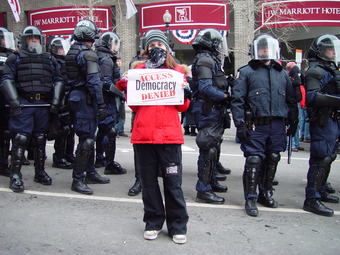
Political Process Theory
One of the advantages of the political process theory is that it addresses the issue of timing or emergence of social movements. Photo taken at the 2005 U.S. Presidential inauguration protest.
“Organizational strength” falls in line with resource-mobilization theory, arguing that in order for a social movement to organize it must have strong leadership and sufficient resources.
Finally, “political opportunity” refers to the receptivity or vulnerability of the existing political system to challenge. This vulnerability can be the result of any of the following (or a combination thereof):
- growth of political pluralism
- decline in effectiveness of repression
- elite disunity; the leading factions are internally fragmented
- a broadening of access to institutional participation in political processes
- support of organized opposition by elites
One of the advantages of the political process theory is that it addresses the issue of timing of the emergence of social movements. Some groups may have the insurgent consciousness and resources to mobilize, but because political opportunities are closed, they will not have any success. The theory, argues that all three of these components are important for the successful creation of a movement.
Critics of the political process theory and resource-mobilization theory point out that neither theory discusses the culture of movements to any great degree. This has presented culture theorists an opportunity to expound on the importance of culture.
21.2.3: The Four Social Revolutions
The Four Social Revolutions refer to the identification of social change through modes of subsistence.
Learning Objective
Analyze the various social revolutions in terms of how each contributes to the development of the next stage, for example, moving from horticulturist to agrarian
Key Points
- The development of a society in terms of its primary means of subsistence can be divided into the following stages: hunter-gatherer, pastoral, horticultural, agrarian, industrial, and post-industrial.
- For hunter-gatherer societies, the primary means of subsistence are wild plants and animals. Hunter-gatherers are nomadic and non-hierarchical. Archeological data suggests that all humans were hunter gatherers prior to 13,000 BCE.
- For pastoral societies, the primary means of subsistence are domesticated livestock. Pastoralists are nomadic. They can develop surplus food, which leads to higher population densities than hunter-gatherers, along with social hierarchies and more complicated divisions of labor.
- In horticultural societies, the primary means of subsistence is the cultivation of crops using hand tools.
- In agrarian societies, the primary means of subsistence is the cultivation of crops through a combination of human and non-human means, such as animals and/or machinery.
- In industrial societies, the primary means of subsistence is industry, which is a system of production based on the mechanized manufacturing of goods. In post-industrial societies, the primary means of subsistence is service-oriented work, rather than agriculture or industry.
- For horticultural societies, the primary means of subsistence is the cultivation of crops using hand tools.
- For agrarian societies, the primary means of subsistence is the cultivation of crops through a combination of human and non-human means, such as animals and/or machinery.
- In industrial societies, the primary means of subsistence is industry, which is a system of production that is based on the manufacturing of goods.
- In post-industrial societies, the primary means of subsistence is based on service-oriented work, rather than agriculture or industry.
- Changes in the primary means of subsistence can have implications for other aspects of society, leading to developments, such as an increasing degree of specializiation, a greater use of technology and a higher prevalence of inequality.
Key Terms
- agriculture
-
the art or science of cultivating the ground, including the harvesting of crops, and the rearing and management of livestock; tillage; husbandry; farming
- Hunter-gatherer
-
a member of a group of people who live by hunting animals and gathering edible plants for their main food sources, and who do not domesticate animals or farm crops
- subsistence
-
that which furnishes support to animal life; means of support; provisions, or that which produces provisions; livelihood
The Four Social Revolutions
Most societies develop along a similar historical trajectory. Human groups begin as hunter-gatherers, after which they develop pastoralism and/or horticulturalism. After this, an agrarian society typically develops, followed finally by a period of industrialization (sometimes a service industry follows this final stage). Not all societies pass through every stage, and some societies remain at a particular stage for long periods of time, even while others become more complex. Still other societies may jump stages as a result of technological advancements from other societies .

The stages of societal development
The relationship between the stages of societal development (top row) and its implications (bottom row) are complex and interdependent.
Hunter-Gatherers
The hunter-gatherer way of life is based on the consumption of wild plants and wild animals. Consequently, hunter-gatherers are often mobile, and groups of hunter-gatherers tend to have fluid boundaries and compositions. Typically, in hunter-gatherer societies, men hunt wild animals while women gather fruits, nuts, roots, and other vegetation. Women also hunt smaller wild animals.
The majority of hunter-gatherer societies are nomadic. Because the wild resources of a particular region can be quickly depleted, it is difficult for hunter-gatherers to remain rooted in a place for long. Because of their subsistence system, these societies tend to have very low population densities.
Hunter-gatherer societies are characterized by non-hierarchical social structures, though this is not always the case. Given that hunter-gatherers tend to be nomadic, they generally cannot store surplus food. As a result, full-time leaders, bureaucrats, or artisans are almost never supported by hunter-gatherer societies. The egalitarianism in hunter-gatherer societies tends to extend to gender relations as well.
Pastoralism
In a pastoralist society, the primary means of subsistence are domesticated animals (livestock). Like hunter-gatherers, pastoralists are often nomadic, moving seasonally in search of fresh pastures and water for their animals. In a pastoralist society, there is an increased likelihood of surplus food, which, in turn, often results in greater population densities and the development of both social hierarchies and divisions of labor.
Pastoralist societies still exist. For example, in Australia, the vast, semi-arid interior of the country contains huge pastoral runs called sheep stations. These areas may be thousands of square kilometers in size. The number of livestock allowed in these areas is regulated in order to sustain the land and to ensure that livestock have enough access to food and water.
Horticulturalist Societies
In horticulturalist societies, the primary means of subsistence is the cultivation of crops using hand tools. Like pastoral societies, the cultivation of crops increases population densities and, as a result of food surpluses, allows for an even more complex division of labor. Horticulture differs from agriculture in that agriculture employs animals, machinery, or other non-human means to facilitate the cultivation of crops. Horticulture relies solely on human labor for crop cultivation. Horticultural societies were among the first to establish permanent places of residence. This was due to the fact they no longer had to search for food; rather, they cultivated their own.
Agrarian Societies
In agrarian societies, the primary means of subsistence is the cultivation of crops using a mixture of human and non-human means, like animals and machinery. In agriculture, through the cultivation of plants and the raising of domesticated animals, food, feed, fiber and other desired commodities are produced.
In comparison with the previously mentioned societal types, agriculture supports a much greater population density and allows for the accumulation of excess product. This excess product can either be sold for profit or used during winter months. Because in agricultural societies, farmers are able to feed large numbers of people whose daily activity has nothing to do with food production, a number of important developments occur. These include improved methods of food stores, labor specialization, advanced technology, hierarchical social structures, inequality, and standing armies.
Industrialization
In an industrial society, the primary means of subsistence is industry, which is a system of production based on the mechanized manufacture of goods. Like agrarian societies, industrial societies lead to even greater food surpluses, resulting in even more developed social hierarchies and an even more complex division of labor.
The industrial division of labor, one of the most notable characteristics of this societal type, in many cases leads to a restructuring of social relations. Whereas in pre-industrial societies, relationships would typically develop at one’s place of worship, or through kinship and housing, in industrial societies, relationships and friendships can occur at work.
Post-Industrial
In a post-industrial society, the primary means of subsistence is derived from service-oriented work, as opposed to agriculture or industry. Importantly, the term post-industrial is still debated, in part because it is the current state of society. Generally, in social science, it is difficult to accurately name a phenomenon while it is occurring.
Most highly developed countries are now post-industrial. This means the majority of their workforce works in service-oriented industries, like finance, healthcare, education, or sales, rather than in industry or agriculture. This is the case in the United States .
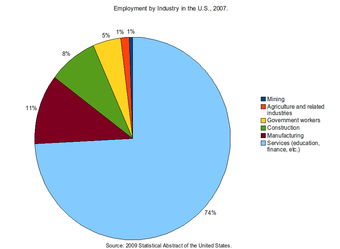
Employment in the US according to industry, 2007
Less than 2% of the US population is employed in agriculture.
21.2.4: Gemeinschaft and Gesellschaft
Gemeinschaft describes groups in which the community takes precedence over the individual; gesellschaft prioritizes the individual.
Learning Objective
Examine the similarities and differences between Ferdinand Tonnies’s concepts of gemeinschaft and gesellschaft in relation to human interactions in society
Key Points
- Gemeinschaft and gesellschaft, which can be generally translated as “community” and “society” respectively, are two sociological categories introduced by German sociologist Ferdinand Tönnies.
- Gemeinschaft describes groups in which the members attach as much, if not more, importance to the groups itself as they do to their own needs. Gemeinschaft can be based on shared space and beliefs, as well as kinship. Gemeinschaft is characterized by ascribed status.
- Gesellschaft refers to groups in which associations never take precedence over the interests of the individual.
- Gesellschaft, unlike gemeinschaft, places more emphasis on secondary relationships rather than familial or community bonds, and it entails achieved, rather than ascribed, status.
- A normal type is a purely conceptual tool that makes use of logic and deduction, as opposed to Max Weber’s ideal type, which is a framework used to understand reality that draws on elements from history and society.
Key Terms
- community
-
A group sharing a common understanding and often the same language, manners, tradition and law. See civilization.
- normal type
-
A normal type is a purely conceptual tool that makes use of logic and deduction, as opposed to Max Weber’s ideal type, which is a framework used to understand reality that draws on elements from history and society.
- ideal type
-
An ideal type is not a particular person or thing that exists in the world, but an extreme form of a concept used by sociologists in theories. For example, although there is not a perfectly “modern” society, the term “modern” is used as an ideal type in certain theories to make large-scale points.
Gemeinschaft and gesellschaft are sociological categories for two normal types of human association introduced by the German sociologist Ferdinand Tönnies. A normal type, as coined by Tönnies, is a purely conceptual tool to be built up logically, whereas an ideal type, as coined by Max Weber, is a concept formed by accentuating main elements of a historic/social process. Tönnies’ 1887 book Gemeinschaft und Gesellschaft sparked a major revival of corporatist thinking, including an increase in the support for guild socialism, and caused major changes in the field of sociology.
Gemeinschaft
Gemeinschaft (often translated as community) is a group in which individuals take into account the needs and interests of the group as much as, if not more than, their own self interest. Furthermore, individuals in gemeinschaft are regulated by common mores, or beliefs, about the appropriate behavior and responsibilities of members with respect to each other and to the group at large.
Gemeinschaft is thus marked by “unity of will. ” Tönnies saw the family as the most perfect expression of gemeinschaft; however, he expected that gemeinschaft could be based on shared place and shared belief as well as kinship, and he included globally dispersed religious communities as possible examples of gemeinschaft. Gemeinschaft involves ascribed status, which refers to cases in which an individual is assigned a particular status at birth. For example, an individual born to a farmer will come to occupy the parent’s role for the rest of his or her life.
Gemeinschaften are broadly characterized by a moderate division of labour, strong personal relationships, strong families, and relatively simple social institutions. In such communities there is seldom a need to enforce social control externally, due to a collective sense of loyalty individuals feel for society.
Gesellschaft
In contrast, gesellschaft (often translated as society, civil society or association) describes associations in which, for the individual, the larger association never takes precedence over the individual’s self interest, and these associations lack the same level of shared mores. Gesellschaft is maintained through individuals acting in their own self interest. A modern business is a good example of gesellschaft: the workers, managers, and owners may have very little in terms of shared orientations or beliefs—they may not care deeply for the product they are making—but it is in all their self interest to come to work to make money, and thus the business continues. Gesellschaft society involves achieved status where people reach their status through their education and work.
Unlike gemeinschaften, gesellschaften emphasize secondary relationships rather than familial or community ties, and there is generally less individual loyalty to society. Social cohesion in gesellschaften typically derives from a more elaborate division of labor. An example of gemeinschaft in the world today would be an Amish community. The United States would be considered a gesellschaft society. Such societies are considered more susceptible to class conflict as well as racial and ethnic conflicts. The social upheavals during the Reconstruction era of the United States complicated the sociological category of gemeinschaft because former slaves, whose kinship ties were complicated under slavery, forged new communities that shared aspects of both gemeinschaft and gesellschaft.
Talcott Parsons considered gemeinschaft to represent a community of fate, whose members share both good and bad fortune, as opposed to the pursuit of rational self-interest that characterized gesellschaft.
Eric Hobsbawm has argued that as globalisation turns the entire planet into an increasingly remote kind of gesellschaft, similarly collective identity politics seek a factitious remaking of the qualities of gemeinschaft by reforging artificial group bonds and identities.
Fredric Jameson highlights the ambivalent envy felt by members of gesellschaft for remaining enclaves of gemeinschaft, even as the former inevitably corrode the existence of the latter.
21.2.5: Capitalism, Modernization, and Industrialization
Sociologists Weber, Marx and Durkheim envisioned different impacts the Industrial Revolution would have on both the individual and society.
Learning Objective
Compare the similarities and differences between Weber’s Rationalization, Marx’s Alienation and Durkheim’s Solidarity In relation to the Industrial Revolution
Key Points
- Weber imagined that an increasing rationalization of society would lead to man being trapped in a iron cage of rationality and bureaucracy.
- Marx believed that capitalism resulted in the alienation of workers from their own labor and from one another, preventing them from achieving self-realization (species being).
- Finally, Durkheim believed that industrialization would lead to decreasing social solidarity.
- Bureaucracy is a type of organizational or institutional management that is based upon legal-rational authority. Weber believed that industrialization was leading to a growing influence of rational ideas and thought in culture, which, in turn, led to the bureaucratization of society.
- Karl Marx understood species being to be the original or intrinsic essence of the species. A simplified understanding of species being is that it is a form of self-realization or self-actualization resulting from fulfilling or meaningful work.
- Durkheim imagined that industrialization would lead to a decrease in social solidarity, which can be defined as a sense of community. He referred to this decrease in social solidarity as anomie, a French word for chaos.
- Durkheim imagined that industrialization would lead to a decrease in social solidarity, which can be defined as a sense of community.
- Durkheim referred to the decrease in social solidarity resulting from industrialization as anomie, a French word for chaos.
- Industrializing societies would be characterized by specialization in that individuals would occupy different roles and occupations in a given society. According to Durkheim, specialization would lead to interdependence between the various components of society. He referred to this interdependence as organic solidarity.
- Societies exhibit mechanical solidarity when the source of its cohesion is the homogeneity of its individuals in terms of their work, educational and religious training and lifestyles.
Key Terms
- species being
-
Karl Marx understood species being to be the original or intrinsic essence of the species, which is characterized by pluralism and dynamism: all beings possess the tendency and desire to engage in multiple activities to promote their mutual survival, comfort and sense of inter-action. A simplified understanding of species being is that it is a form of self-realization or self-actualization resulting from fulfilling or meaningful work.
- anomie
-
Alienation or social instability caused by erosion of standards and values.
- alienation
-
Emotional isolation or dissociation.
As Western societies transitioned from pre-industrial economies based primarily on agriculture to industrialized societies in the 19th century, some people worried about the impacts such changes would have on society and individuals. Three early sociologists, Max Weber, Karl Marx, and Emile Durkheim, envisioned different outcomes of the Industrial Revolution on both the individual and society and described these effects in their work.
Weber and Rationalization
Max Weber was particularly concerned about the rationalization of society due to the Industrial Revolution and how this change would affect humanity’s agency and happiness. Weber’s understanding of rationalization was three-fold: firstly, as individual cost-benefit calculations; secondly, as the transformation of society into a bureaucratic entity; lastly, and on a much wider scale, as the opposite of perceiving reality through the lens of mystery and magic (disenchantment). Since Weber viewed rationalization as the driving force of society and given that bureaucracy was the most rational form of institutional governance, Weber believed bureaucracy would spread until it ruled society.
As Weber did not see any alternative to bureaucracy, he believed it would ultimately lead to an iron cage : there would be no way to escape it. Weber viewed this as a bleak outcome that would affect individuals’ happiness as they would be forced to function in a society with rigid rules and norms without the possibility of change.
Related to rationalization is the process of disenchantment , in which the world is becoming more explained and less mystical, moving from polytheistic religions to monotheistic ones and finally to the Godless science of modernity. Those processes affect all of society, removing “sublime values… from public life” and making art less creative.
Marx and Alienation
Karl Marx took a different perspective on the Industrial Revolution. According to Marx, a capitalist system results in the alienation (or estrangement) of people from their “species being.” Species being is a concept that Marx deploys to refer to what he sees as the original or intrinsic essence of the species, which is characterized both by plurality and dynamism: all beings possess the tendency and desire to engage in multiple activities to promote their mutual survival, comfort and sense of inter-connection
In a capitalist society (which co-evolved with the Industrial Revolution), the proletariat, or working class, own only their labor power and not the fruits of their labor (i.e. the results of production). The capitalists, or bourgeoisie, employ the proletariat for a living wage, and, in turn, they keep the products of the labor. A major implication of this system is that workers lose the ability to determine their lives and destinies by being deprived of the right to conceive of themselves as the director of their actions, to determine the character of their actions, to define their relationship to other actors, and to use or own the value of what is produced by their actions. This is what Marx refers to as alienation.
Durkheim and Solidarity
Similar to Weber and Marx, Durkheim also believed that the societal changes brought upon by industrialzation could eventually lead to unhappiness. According to Durkheim, an important component of social life was social solidarity, which can be understood as a sense of community. For example, in his classic study, Suicide, Durkheim argued that one of the root causes of suicide was a decrease in social solidarity, a phenomenon which Durkheim referred to as anomie (French for chaos). Durkheim also argued that the increasing emphasis on individualism in Protestant religions – in contrast to Catholicism – contributed to a corresponding rise in anomie, which resulted in higher suicide rates among Protestants than among Catholics.
According to Durkheim, the types of social solidarity correlate with types of society. Durkheim introduced the terms “mechanical” and “organic solidarity” as part of his theory of the development of societies in The Division of Labour in Society (1893). In a society exhibiting mechanical solidarity, its cohesion and integration comes from the homogeneity of individuals—people feel connected through similar work, educational and religious training, and lifestyle. Mechanical solidarity normally operates in “traditional” and small scale societies. Organic solidarity comes from the interdependence that arises from specialization of work and the complementarities between people—a development which occurs in “modern” and “industrial” societies. Thus, organic solidarity is social cohesion based upon the dependence individuals have on each other in more advanced societies. Although individuals perform different tasks and often have different values and interest, the order and very solidarity of society depends on their reliance on each other to perform their specified tasks.
21.2.6: Cultural Evolution
Over time, the concept of culture has transformed into a more inclusive concept.
Learning Objective
Outline ways the concept of culture has changed over time, from evaluative to inclusive
Key Points
- Although biological evolution may have originally resulted in culture, research suggests that culture is not only a supplement to evolution, but can also influence it.
- Ultimately, the category of “culture” is, like all classifications, an artificial distinction.
- The fact that all human beings have cultures must, at some level, be a consequence of human evolution. However, evolution cannot be used as a way of distinguishing between different cultures, as this is a form of, or can legitimize forms of, racism.
- Since culture is dynamic and can be taught and learned, it can facilitate the adaptation of humans to different physical environments and changes in environmental conditions. In this way, culture acts as a supplement to evolution.
- Cultural relativism posits that cultures are to be considered as bounded wholes and have to be understood in their own terms. Cultures are not better or worse than each other, just different.
- Recent research suggests that culture can influence human evolution.
- When studying culture, it is important to bear in mind that the notion of culture can have multiple levels of meaning, or, in other words, levels of abstraction.
Key Terms
- evolution
-
gradual directional change, especially one leading to a more advanced or complex form; growth; development
- cultural relativism
-
Cultural relativism is a principle that was established as axiomatic in anthropological research by Franz Boas in the first few decades of the twentieth century, and later popularized by his students. Boas first articulated the idea in 1887: “…civilization is not something absolute, but … is relative, and … our ideas and conceptions are true only so far as our civilization goes. “
- symbol
-
Any object, typically material, which is meant to represent another (usually abstract), even if there is no meaningful relationship.
During the Romantic Era, scholars in Germany, especially those concerned with nationalism, developed a more inclusive notion of culture as a worldview. That is, each ethnic group is characterized by a distinct and incommensurable worldview. Although more inclusive, this approach to culture still allowes for distinctions between civilized and primitive, or tribal, cultures.
By the late 19th century, anthropologists changed the concept of culture to include a wider variety of societies. This resulted in the concept of culture as objects and symbols; the meaning given to those objects and symbols; and the norms, values, and beliefs that pervade social life.
This new perspective removed the evaluative element of the concept of culture, and instead proposed distinctions rather than rankings between different cultures. For instance, the high culture of elites is now contrasted with popular or pop culture. In this sense, high culture no longer refers to the idea of being cultured, as all people are cultured. High culture simply refers to the objects, symbols, norms, values, and beliefs of a particular group of people; popular culture refers to the same.
Most social scientists today reject the cultured vs. uncultured concept of culture. Instead, social scientists accept and advocate the definition of culture outlined above as being the “nurture” component of human social life. Social scientists recognize that non-elites are as cultured as elites, and that non-Westerners are just as civilized; they simply have a different culture .

The Developing Idea of Culture
Chinese Opera is a culture tradition quite distinct from European Opera.
The understanding of culture as a symbolic system with adaptive functions that vary from place to place led anthropologists to define different cultures by distinct patterns or structures of enduring, conventional sets of meaning. These took concrete form in a variety of artifacts, both symbolic, such as myths and rituals, and material, including tools, the design of housing, and the planning of villages. Anthropologists distinguish between material culture and symbolic culture, not only because each reflects different kinds of human activity, but also because each constitutes different kinds of data that require different methodologies to study.
Cultural Relativism
This view of culture, which came to dominate anthropology between World War I and World War II, implies that each culture is bounded and has to be understood as a whole, on its own terms. The result is a belief in cultural relativism, which suggests that there are no “better” or “worse” cultures, just different cultures.
Culture as a Product of Biology
Biology and nature are deeply connected and share a complex relationship. Early studies of this relationship revealed that culture is actually a product of biology. More recent research, however, suggests that human culture has reversed this particular causal direction and, culture can actually influence human evolution. One well-known example of this is the rapid spread of a gene that produces a protein that allows humans to digest lactose. This adaptation spread quickly in Europe around 4,000 BCE with the domestication of mammals and the consumption of animal milk by humans. Prior to this adaptation, this gene was switched off after children were weaned. Thus, the change in culture (drinking milk from other mammals) eventually led to changes in human genetics. Genetics, therefore, resulted in culture, which is now affecting genetics.
Another important element in the understanding of culture is level of abstraction. Culture ranges from the concrete, cultural object (e.g., the understanding of a work of art) to micro-level interpersonal interactions (e.g., the socialization of a child by his/her parents) to a macro-level influence on entire societies (e.g., the Puritanical roots of the U.S. that can be used to justify the exportation of democracy, as was the case with the Iraq War). When trying to understand the concept of culture, it is important to remember that the concept can have multiple levels of meaning.
21.2.7: Natural Cycles
Social cycle theories argue that historical events and the different stages of society generally go through recurring cycles.
Learning Objective
Examine the change in social cycle theories throughout history, ranging from ideas of “life cycles” to political-demographic cycles
Key Points
- Precursors to social cycle theories can be found in the works of Polybius, Ibn Khaldun, and Giambattista Vico, who all argued that history can be defined as repeating cycles of events..
- Classical social cycle theories include the idea that civilizations have “life cycles,” as was proposed by Nikolai Danilewski and Oswald Spengler.
- The first true social cycle theory was introduced by Vilfredo Pareto, who divided the elite social class into cunning foxes and violent lions and claimed that power constantly passes from one group to the other.
- Classical social cycle theorist, Petrim A. Sorokin, viewed societies as moving between three cultural mentalities: ideational, sensate and idealistic.
- An important development in modern social cycle theories is the discovery that political-demographic cycles are a basic feature of the long-term dynamic social processes of complex agrarian systems. Theories of long-term political-demographic cycles take into account social progress.
- Thomas Malthus proposed that limited resources will act as a check on population growth among humans. A Malthusian catastrophe (also known by other names) refers to the forced return to subsistence-level conditions when population growth has outstripped agricultural production.
- An important development in modern social cycle theories is the discovery that political-demographic cycles are a basic feature of the long-term dynamic social processes of complex agrarian systems. Theories of long-term political-demographic cycles take into account social progress.
- Thomas Malthus proposed that limited resources will act as a check on population growth among humans. A Malthusian catastrophe (also known by other names) refers to the forced return to subsistence-level conditions when population growth has outstripped agricultural production.
- P.R. Sarkar also accounts for social progress in his Law of Social Cycle by considering human spiritual development. Social stasis and the subsequent collapse of regimes occurs when the ruling class treats other members of society poorly in order to advance its own selfish interests.
Key Terms
- Polybius
-
Polybius was a Greek historian of the Hellenistic Period noted for his work, The Histories, which covered the period of 220–146 BC in detail. The work describes in part the rise of the Roman Republic and its gradual domination over Greece.
- political-demographic cycles
-
One of the most important recent findings in the study of the long-term dynamic social processes was the discovery of the political-demographic cycles as a basic feature of the dynamics of complex agrarian systems.
- Malthusian catastrophe
-
A Malthusian catastrophe (also known as Malthusian check) was originally foreseen to be a forced return to subsistence-level conditions once population growth had outpaced agricultural production.
Social cycle theories are among the earliest social theories in sociology. Unlike the theory of social evolutionism, which views the evolution of society and human history as progressing in some new, unique direction(s), sociological cycle theory argues that events and stages of society and history generally repeat themselves in cycles. Such a theory does not necessarily imply that there cannot be any social progress. In fact, the early theory of Sima Qian, a Chinese historiographer of the Han Dynasty and typically considered to be the father of Chinese historiography, the more recent theories of long-term (“secular”) political-demographic cycles as well as the Varnic theory of P.R. Sarkar all make an explicit accounting of social progress.
Predecessors
The interpretation of history as repeating cycles of Dark and Golden Ages was a common belief among ancient cultures. The more limited cyclical view of history defined as repeating cycles of events was put forward in the academic world in the 19th century in historiography (the study of the history and methodology of the discipline of history) and is a concept that falls under the category of sociology. However, the precursors to this analysis include Polybius, a Greek historian of the Hellenistic period, Ibn Khaldun, a Muslim historiographer and historian, who saw the rise and fall of Asabiyyah (the sense of community among humans) as the reason behind the emergence and decline of civilizations, and, finally, Giambattista Vico, an Italian philosopher, who argued that civilizations occur in recurring cycles consisting of three ages: the divine, the heroic and the human. The Saeculum, which refers to the period of time during which the renewal of a human population would occur, was identified in Roman times. More recently, P. R. Sarkar in his Social Cycle Theory has used this idea to elaborate his interpretation of history.
Classical Theories
Among the prominent historiosophers, Russian philosopher Nikolai Danilewski (1822–1885) is notable. In Rossiia i Europa (1869), he differentiated between various smaller civilizations (Egyptian, Chinese, Persian, Greek, Roman, German, and Slav, among others) and asserted that each civilization has a life cycle. To illustrate this claim, he pointed out that by the end of the 19th century the Roman-German civilization was in decline, while the Slav civilization was approaching its Golden Age . A similar theory was put forward by Oswald Spengler (1880–1936) who in his Der Untergang des Abendlandes (1918) predicted that the Western civilization was about to collapse.
The first social cycle theory in sociology was created by Italian sociologist and economist Vilfredo Pareto (1848–1923) in his Trattato di Sociologia Generale (1916). He centered his theory on the concept of an elite social class, which he divided into cunning “foxes” and violent “lions. ” In his view of society, the power constantly passes from the “foxes” to the “lions” and vice versa.
Sociological cycle theory was also developed by Pitirim A. Sorokin (1889–1968) in his Social and Cultural Dynamics (1937, 1943). He classified societies according to their “cultural mentality. ” which can be ideational (reality is spiritual), sensate (reality is material), or idealistic (a synthesis of the two). He interpreted the contemporary West as a sensate civilization dedicated to technological progress and prophesied its fall into decadence and the emergence of a new ideational or idealistic era.
Modern Theories
One of the most important recent findings in the study of the long-term dynamic social processes was the discovery of the political-demographic cycles as a basic feature of the dynamics of complex agrarian systems. The presence of political-demographic cycles in the pre-modern history of Europe and China , and in chiefdom level societies worldwide has been known for quite a long time, and already in the 1980s more or less developed mathematical models of demographic cycles started to be produced.
Recently the most important contributions to the development of the mathematical models of long-term (“secular”) sociodemographic cycles have been made by Sergey Nefedov, Peter Turchin, Andrey Korotayev, and Sergey Malkov. What is important is that on the basis of their models Nefedov, Turchin and Malkov have managed to demonstrate that sociodemographic cycles were a basic feature of complex agrarian systems (and not a specifically Chinese or European phenomenon).
It has become possible to model these dynamics mathematically in a rather effective way. Modern social scientists from different fields have introduced cycle theories to predict civilizational collapses in approaches that apply contemporary methods, which update the approach of Spengler, such as the work of Joseph Tainter suggesting a civilizational life-cycle.
21.2.8: Ogburn’s Theory
William F. Ogburn’s theory suggests that technology is the primary engine of progress.
Learning Objective
Summarize the main points of Ogburn’s theory of social change, in terms of its four main stages
Key Points
- Ogburn’s four stages of technical development are invention, accumulation, diffusion and adjustment.
- Although his theory is associated with technological determinism, the two are far from perfectly aligned.
- Technological determinism is a theory that argues technology is responsible for determining a society’s structure and values.
- Cultural lag is the period during which non-material culture strives to adjust to new technology and inventions.
- Cultural lag is the period during which non-material culture strives to adjust to new technology and inventions.
- Ogburn’s four stages of technical development are invention, accumulation, diffusion and adjustment.
- Invention is the process by which new kinds of technology are produced.
- Accumulation is the growth of technology as a result of new inventions outpacing the decline of old technology.
- Diffusion is the spread of new ideas from one culture to another, or from one field of activity to another, which leads to the convergence of different technologies that then combine to form new inventions.
- Adjustment is the process by which non-material aspects of society adjust to new technology.
Key Terms
- hard determinism
-
Hard determinism is the idea that technology governs social structures and activities.
- soft determinism
-
Soft determinism posits that, although technology drives progress, people still may have the chance to make decisions regarding social outcomes.
- cultural lag
-
The term cultural lag refers to the notion that culture takes time to catch up with technological innovations, and that social problems and conflicts are caused by this lag.
William Fielding Ogburn (June 29, 1886 – April 27, 1959) was an American sociologist, statistician, and educator. Perhaps Ogburn’s most enduring intellectual legacy is the theory of social change he offered in 1922. He suggested that technology is the primary engine of progress, but it is also tempered by social responses to it. Thus, his theory is often associated with technological determinism, a reductionist theory that presumes a society’s technology drives the development of its social structure and cultural values.
Hard Determinism versus Soft Determinism
Hard determinists view technology as developing independent from social concerns. They believe that technology creates a set of powerful forces acting to regulate our social activity and its meaning.
Soft determinism, as the name suggests, is a more passive view of the way technology interacts with socio-political situations. Soft determinists still subscribe to the fact that technology is the guiding force in our evolution, but maintain that we have a chance to make decisions regarding the outcomes of a situation. Ogburn, in fact, proposed a slightly different variant of soft determinism, in which society must adjust to the consequences of major inventions, but often does so only after a period of cultural lag. Cultural lag, a term coined by Ogburn, refers to a period of maladjustment, which occurs when the non-material culture is struggling to adapt to new material conditions.
Stages of Technological Development
Ogburn posited four stages of technical development: invention, accumulation, diffusion, and adjustment.
Invention is the process by which new forms of technology are created. Inventions are collective contributions to an existing cultural base that cannot occur unless the society has already gained a certain level of knowledge and expertise in the particular area.
Accumulation is the growth of technology due to the fact that the invention of new things outpaces the process by which old inventions become obsolete or are forgotten—some inventions (such as writing) promote this accumulation process.
Diffusion is the spread of an idea from one cultural group to another, or from one field of activity to another. As diffusion brings inventions together, they combine to form new inventions.
Adjustment is the process by which the non-technical aspects of a culture respond to invention. Any retardation of this adjustment process causes cultural lag.

Expansion of Communications and Information Technology
Ogburn posited four stages of technical development: invention, accumulation, diffusion, and adjustment.
21.3: Social Movements
21.3.1: Social Movements
Social movements are broad alliances of people connected through a shared interest in either stopping or instigating social change.
Learning Objective
Discover the difference between social movements and social movement organizations, as well as the four areas social movements operate within
Key Points
- There are both a number of different kinds of social movements, as well as various stages that a social movement can undergo in the course of its development.
- Several theories have been proposed to explain the creation of social movements. Each of these theories highlights a different aspect of society (e.g. deprivation, marginalization, culture, etc. ) as being key to the formation of these movements.
- Social movements are distinct from social movement organizations (SMOs). An SMO is a formally organized component of a social movement, and as such it may represent only one facet of an entire movement.
- According to Anthony Giddens, the four domains of modern society in which social movements are active include the political sphere, the workplace, the environment, and the issue of peace.
- Social movements often give rise to counter movements aimed at stopping whatever change the initial social movement is advocating.
Key Terms
- social change
-
an alteration in the structures, institutions and/or practices of a society
- social movements
-
Social movements are a type of group action. They are large informal groupings of individuals or organizations that focus on specific political or social issues. In other words, they carry out, resist or undo a social change.
- counter movements
-
Counter-hegemony refers to attempts to critique or dismantle hegemonic power. In other words, it is a confrontation and/or opposition to the existing status quo and the legitimacy of that status quo in politics. This can also be observed in various other spheres of life, such as history, media, music, etc.
- social movement organizations
-
A social movement organization is an organized component of a social movement. Social movement organizations usually have coordinating roles in social movements, but do not actually employ or direct most of the participants, who are part of a wider social movement community.
Social movements are broad alliances of people who are connected through their shared interest in social change. Social movements can advocate for a particular social change, but they can also organize to oppose a social change that is being advocated by another entity. These movements do not have to be formally organized to be considered social movements. Different alliances can work separately for common causes and still be considered a social movement.
Sociologists draw distinctions between social movements and social movement organizations (SMOs). A social movement organization is a formally organized component of a social movement. Therefore, it may represent only one part of a particular social movement. For instance, PETA (People for the Ethical Treatment of Animals) advocates for vegan lifestyles along with its other aims. However, PETA is not the only group that advocates for vegan diets and lifestyles; there are numerous other groups actively engaged toward this end. Thus, promoting veganism would be considered the social movement, while PETA would be considered a particular SMO (social movement organization) working within the broader social movement.
Modern social movements became possible through the wide dissemination of literature and the increased mobility of labor, both of which have been caused by the industrialization of societies. Anthony Giddens, a renowned sociologist, has identified four areas in which social movements operate in modern societies:
- democratic movements that work for political rights
- labor movements that work for control of the workplace
- ecological movements that are concerned with the environment
- peace movements that work toward peace
It is interesting to note that social movements can spawn counter movements. For instance, the women’s movement of the 1960s and 1970s resulted in a number of counter movements that attempted to block the goals of the women’s movement. In large part, these oppositional groups formed because the women’s movement advocated for reform in conservative religions.
21.3.2: Types of Social Movements
Social movements occur when large groups of individuals or organizations work for or against change in social and/or political matters.
Learning Objective
Discuss the criteria that form the basis of classification of social movements
Key Points
- Cultural Anthropologist David F. Aberle identified four kinds of social movements (alternative, redemptive, reformative, and revolutionary) based on two questions: 1) Who is the movement attempting to change? and 2) How much change is being advocated?.
- Alternative social movements are at the individual level and advocate for minor change; redemptive social movements are at the individual level and advocate for radical changes.
- Reformative social movements occur at a broader group or societal level and advocate for minor changes; revolutionary social movements occur at a broader group or societal level and advocate for radical changes.
- Other ways to categorize social movements include the scope (reform or radical), type of change (innovative or conservative), targets (group-focused or individual-focused), methods (violent or non-violent), and range (local or global).
- Revolutionary social movements occur at a broader group or societal level and advocate for radical changes.
- Other ways to categorize social movements include classifying by scope, type of change, targets, methods, and range.
Key Terms
- reformative social movements
-
A reformative social movement advocates for minor changes instead of radical changes. For example revolutionary movements can scale down their demands and agree to share powers with others, becoming a political party.
- revolutionary social movements
-
Revolutionary movement is a specific type of social movement dedicated to carrying out revolutionary reforms and gain some control of the state. If they do not aim for an exclusive control, they are not revolutionary.
- redemptive social movements
-
A redemptive social movement is radical in scope but focused on the individual.
Social movements are a specific type of group action in which large informal groups of individuals or organizations work for or against change in specific political or social issues.
Cultural Anthropologist David F. Aberle described four types of social movements based upon two fundamental questions: (1) who is the movement attempting to change? (2) how much change is being advocated? Social movements can be aimed at change on an individual level, e.g. Alcoholics Anonymous, which is a support group for recovering alcoholics or change on a broader group or even societal level, e.g. anti-globalization). Social movements can also advocate for minor changes such as tougher restrictions on drunk driving (see MADD) or radical changes like prohibition. The diagram below illustrates how a social movement may either be alternative, redemptive, reformative or revolutionary based on who the movement strives to change and how much change the movement desires to bring about .

Aberle’s Four Types of Social Movements
Based on who a movement is trying to change and how much change a movement is advocating, Aberle identified four types of social movements: redemptive, reformative, revolutionary and alternative.
Other categories have been used to distinguish between types of social movements.
- Scope: A movement can be either reform or radical. A reform movement advocates changing some norms or laws while a radical movement is dedicated to changing value systems in some fundamental way. A reform movement might be a trade union seeking to increase workers’ rights while the American Civil Rights movement was a radical movement.
- Type of Change: A movement might seek change that is either innovative or conservative. An innovative movement wants to introduce or change norms and values while a conservative movement seeks to preserve existing norms and values.
- Targets: Group-focused movements focus on influencing groups or society in general; for example, attempting to change the political system from a monarchy to a democracy. An individual-focused movement seeks to affect individuals.
- Methods of Work: Peaceful movements utilize techniques such as nonviolent resistance and civil disobedience. Violent movements resort to violence when seeking social change.
- Range: Global movements, such as Communism in the early 20th century, have transnational objectives. Local movements are focused on local or regional objectives such as preserving an historic building or protecting a natural habitat.
21.3.3: Propaganda and the Mass Media
Mass media can be employed to manipulate populations to further the power elite’s agenda.
Learning Objective
Evaluate the impact of mass media as propaganda, particularly in terms of the “power elite”
Key Points
- The propaganda model explains how mass media can be employed to manipulate populations in the interest of ulterior motives.
- The propaganda model posits that the way in which news is structured (e.g. through advertising, concentration of media ownership, government sourcing) creates an inherent conflict of interest which acts as propaganda for undemocratic forces.
- The “power elite” include leaders of the military, corporate, and political elements of society; they are generally the ones who control and therefore benefit from mass media used as propaganda.
Key Term
- propaganda
-
Propaganda is a form of biased communication, aimed at promoting or demoting certain views, perceptions or agendas.
The propaganda model is a conceptual model in political economy advanced by Edward S. Herman and Noam Chomsky to explain how propaganda and systemic biases function in mass media. The model seeks to explain how populations are manipulated and how consent for economic, social and political policies is “manufactured” in the public mind due to this propaganda.
The theory posits that the way in which news is structured (e.g. through advertising, concentration of media ownership, government sourcing) creates an inherent conflict of interest which acts as propaganda for undemocratic forces.
An example that Herman and Chomsky identified was “anti-communism” during the Cold War. Such anti-ideologies exploit public fear and hatred of groups that pose a potential threat, either real, exaggerated or imagined. Communism once posed the primary threat, and communism and socialism were portrayed by their detractors as endangering freedoms of speech, movement, the press and so forth. They argue that such a portrayal was often used as a means to silence voices critical of elite interests.
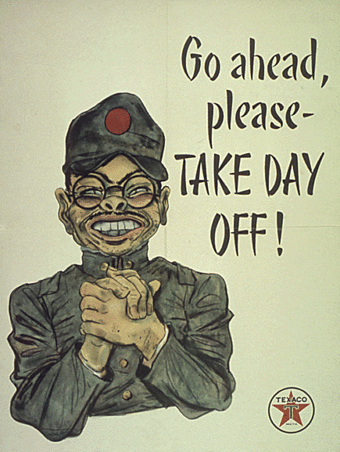
Propaganda
An example of Anti-Japanese propaganda, depicting a racist caricature of a Japanese soldier saying “go ahead, please—TAKE DAY OFF!”
The Power Elite is a 1956 book by sociologist C. Wright Mills, in which Mills calls attention to the interwoven interests of the leaders of the military, corporate, and political elements of society and suggests that the ordinary citizen is a relatively powerless subject of manipulation by those entities.
According to Mills, the eponymous “power elite” are those that occupy the dominant positions, in the dominant institutions (military, economic and political) of a dominant country, and their decisions (or lack of decisions) have enormous consequences, not only for the U.S. population but, “the underlying populations of the world.”
These two models—the propaganda and the “power elite” conceptualization—evidence how mass media can be used to reinforce the powerful’s positions of power and interests. For example:
- During the Gulf War (1990), the media’s failure to report on Saddam Hussein’s peace offers guided the public to look more favorably on the U.S. government’s actions.
- During the Iraq invasion (2003), the media’s failure to report on the legality of the war, despite overwhelming public opinion in favor of only invading Iraq with UN authorization, minimized public awareness and outcry over that illegality. According to the liberal watchdog group Fairness and Accuracy In Reporting, there was a disproportionate focus on pro-war sources while total anti-war sources only made up 10% of the media (with only 3% of US sources being anti-war).
- With regard to global warming, the media (in the interest of those who make a tremendous amount of money from fossil fuels) gives near equal balance to people who deny climate change, despite only “about one percent” of climate scientists taking this view. This allows the “debate” to continue, when in reality there is firm scientific consensus, in turn allowing those corporations to continue profiting off human behavior that in reality harms the environment.
21.3.4: The Stages of Social Movements
Social movements typically follow a process by which they emerge, coalesce, and bureaucratize, leading to their success or failure.
Learning Objective
Discuss the process and purpose of social movements, defined by Blumer, Mauss and Tilly
Key Points
- Social movements are a major vehicle for ordinary people’s participation in public politics.
- Social movements have a life cycle: they are created, they grow, they achieve successes or failures and eventually, they dissolve and cease to exist.
- Blumer, Mauss, and Tilly described how social movements follow a process by which they emerge, coalesce, and bureaucratize, leading to their success or failure.
- After bureaucratization occurs, a movement can either succeed, fail, have its leaders become co-opted, have its members be repressed by a larger group (e.g. government), or become accepted into the mainstream.
- While a social movement can take a number of different paths, whether or not a movement will ultimately decline varies from movement to movement. Moreover, movement success can often be difficult to define as the goals of a movement may change.
Key Terms
- Charles Tilly
-
(1929 – 2008) An American sociologist, political scientist and historian who wrote about the relationship between politics and society.
- Sidney Tarrow
-
(1938-present) a professor of political science and sociology, known for his research in the areas of comparative politics, social movements, political parties, collective actions and political sociology.
- cooptation
-
A co-opting, or a commandeering, appropriation.
Charles Tilly defines social movements as a series of contentious performances, displays and campaigns by which ordinary people make collective claims on others. For Tilly, social movements are a major vehicle for ordinary people’s participation in public politics. Sidney Tarrow defines a social movement as collective challenges [to elites, authorities, other groups or cultural codes] by people with common purposes and solidarity in sustained interactions with elites, opponents and authorities. He specifically distinguishes social movements from political parties and advocacy groups. The term “social movements” was introduced in 1848 by the German Sociologist Lorenz von Stein in his book Socialist and Communist Movements since the Third French Revolution (1848).
Social movements are not eternal. They have a life cycle: they are created, they grow, they achieve successes or failures and, eventually, they dissolve and cease to exist.
Blumer, Mauss, and Tilly have described the different stages that social movements often pass through (see ). Firstly, movements emerge for a variety of reasons (and there are a number of different sociological theories that address these reasons). They then coalesce and develop a sense of coherence in terms of membership, goals and ideals. In the next stage, movements generally become bureaucratized by establishing their own set of rules and procedures. At this point, social movements can then take any number of paths, ranging from success to failure, the cooptation of leaders, repression by larger groups (e.g., government), or even the establishment of a movement within the mainstream.

Stages of Social Movements
This graph depicts the various stages a social movement can undergo in the course of its development.
Frame analysis, and specifically frame transformation, helps explain why social movements occur in a certain way. The concept dates back to Erving Goffman, and it discuss how new values, new meanings and understandings are required in order to understand and support social movements or changes. In other words, people must transform the way they understand a particular social movement to make it fit with conventional lifestyles and rituals.
Whether or not these paths will result in movement decline varies from movement to movement. In fact, one of the difficulties in studying social movements is that movement success is often ill-defined because the goals of a movement can change. For instance, MoveOn.org, a website founded in the late 1990s, was originally developed to encourage national politicians to move past the Clinton impeachment proceedings. Since that time, the group has developed into a major player in national politics in the U.S. and transformed into a Political Action Committee (PAC). In this instance, the movement may or may not have attained its original goal—encouraging the censure of Clinton and moving on to more pressing issues—but the goals of the movement have changed. This makes the actual stages the movement has passed through difficult to discern.
21.3.5: Relative Deprivation Approach
Social scientists have cited ‘relative deprivation’ as a potential cause of social movements and deviance.
Learning Objective
Discuss the concepts of relative and absolute deprivation as they relate to social movements
Key Points
- Relative deprivation is the experience of being deprived of something to which one believes to be entitled. It refers to the discontent people feel when they compare their positions to others and realize that they have less of what they believe themselves to be entitled than those around them.
- Some scholars of social movements explain their rise by citing grievances of people who feel deprived of what they perceive as values to which they are entitled. Similarly, individuals engage in deviant behaviors when their means do not match their goals.
- Feelings of deprivation are relative, as they come from a comparison to social norms that are not absolute and usually differ from time and place.
- Critics of this theory have pointed out that this theory fails to explain why some people who feel discontent fail to take action and join social movements.
Key Terms
- deprivation
-
The act of depriving, dispossessing, or bereaving; the act of deposing or divesting of some dignity.
- relative
-
Connected to or depending on something else; not absolute; comparative.
Example
- In 1905 cars were a luxury, hence an individual unable to afford one would not feel or be viewed as deprived. In 2010, when cars are common in most societies, an individual unable to afford one is much more likely to feel deprived.
Relative deprivation is the experience of being deprived of something to which one feels to be entitled. It refers to the discontent that people feel when they compare their positions to those around them and realize that they have less of that which they believe themselves to be entitled. Social scientists, particularly political scientists and sociologists, have cited ‘relative deprivation’ (especially temporal relative deprivation) as a potential cause of social movements and deviance. In extreme situations, it can lead to political violence such as rioting, terrorism, civil wars and other instances of social deviance such as crime.
Some scholars explain the rise of social movements by citing the grievances of people who feel that they have been deprived of values to which they are entitled. Similarly, individuals engage in deviant behaviors when their means do not match their goals.
Feelings of deprivation are relative, as they come from a comparison to social norms that are not absolute and usually differ from time and place. This differentiates relative deprivation from objective deprivation (also known as absolute deprivation or absolute poverty), a condition that applies to all underprivileged people. This leads to an important conclusion: while the objective deprivation (poverty) in the world may change over time, relative deprivation will not, as long as social inequality persists and some humans are better off than others. Relative deprivation may be temporal; that is, it can be experienced by people that experience expansion of rights or wealth, followed by stagnation or reversal of those gains. Such phenomena are also known as unfulfilled rising expectations.
Some sociologists—for instance, Karl Polanyi—have argued that relative differences in economic wealth are more important than absolute deprivation, and that this is a more significant determinate of human quality of life. This debate has important consequences for social policy, particularly on whether poverty can be eliminated simply by raising total wealth or whether egalitarian measures are also needed. A specific form of relative deprivation is relative poverty. A measure of relative poverty defines poverty as being below some relative poverty line, such as households who earn less than 20% of the median income. Notice that if everyone’s real income in an economy increases, but the income distribution stays the same, the number of people living in relative poverty will not change.
Critics of this theory have pointed out that this theory fails to explain why some people who feel discontent fail to take action and join social movements. Counter-arguments include that some people are prone to conflict-avoidance, are short-term-oriented, or that imminent life difficulties may arise since there is no guarantee that life-improvement will result from social action.

Cars as luxury
In 1905 cars were a luxury, hence an individual unable to afford one would not feel or be viewed as deprived.
21.3.6: Resource Mobilization Approach
The resource-mobilization approach is a theory that seeks to explain the emergence of social movements.
Learning Objective
Use the resource-mobilization theory to explain some of the successful social movements in history, such as the Civil Rights Movement
Key Points
- The resource-mobilization theory asserts that social movements form when people who share grievances are able to mobilize resources and take action.
- This theory places resources at the center of both the emergence and success of social movements.
- In this case, resources include knowledge, money, media, labor, solidarity, legitimacy, and internal and external support from a powerful elite.
- The centrality of resources to the success of social movements explains why some discontented people are able to form movements while others are not.
- This theory has a number of underlying assumptions regarding movement membership, movement organization and broader societal factors that influence movement formation and development.
- This theory has been criticized for placing too much emphasis on resources, particularly financial resources, as the success of some movements depends more on the time and labor of members rather than on money.
Key Terms
- opportunity structures
-
Exogenous factors which limit or empower collective actors (social movements).
- grievance
-
A complaint or annoyance; also a formal complaint.
- resource
-
Something that one uses to achieve an objective, e.g. raw materials or personnel.
Resource-Mobilization Theory emphasizes the importance of resources in social movement development and success. Resources are understood here to include: knowledge, money, media, labor, solidarity, legitimacy, and internal and external support from a power elite. The theory argues that social movements develop when individuals with grievances are able to mobilize sufficient resources to take action. The emphasis on resources explains why some discontented/deprived individuals are able to organize while others are not. Resource mobilization theory also divides social movements according to their position among other social movements. This helps sociologists understand them in relation to other social movements; for example, how much influence does one theory or movement have on another?
Some of the assumptions of the theory include:
- there will always be grounds for protest in modern, politically pluralistic societies because there is constant discontent (i.e., grievances or deprivation); this de-emphasizes the importance of these factors as it makes them ubiquitous
- actors are rational and they are able to weigh the costs and benefits from movement participation
- members are recruited through networks; commitment is maintained by building a collective identity and continuing to nurture interpersonal relationships
- movement organization is contingent upon the aggregation of resources
- social movement organizations require resources and continuity of leadership
- social movement entrepreneurs and protest organizations are the catalysts which transform collective discontent into social movements; social movement organizations form the backbone of social movements
- the form of the resources shapes the activities of the movement (e.g., access to a TV station will result in the extensive use TV media)
- movements develop in contingent opportunity structures, which are external factors that may either limit or bolster the movement, that influence their efforts to mobilize. Examples of opportunity structures may include elements, such as the influence of the state, a movement’s access to political institutions, etc. As each movement’s response to the opportunity structures depends on the movement’s organization and resources, there is no clear pattern of movement development nor are specific movement techniques or methods universal.
Critics of this theory argue that there is too much of an emphasis on resources, especially financial resources. Some movements are effective without an influx of money and are more dependent upon the movement of members for time and labor (e.g., the civil rights movement in the US).

Aberle’s Four Types of Social Movements
Resource-Mobilization Theory emphasizes the importance of resources in social movement development and success.
21.3.7: Gender and Social Movements
The feminist movement refers to a series of campaigns on issues pertaining to women, such as reproductive rights and women’s suffrage.
Learning Objective
Illustrate how the various waves of the feminist movement helped advance women in terms of social status and equality
Key Points
- The feminist movement is divided into three distinct waves, beginning in the nineteenth century and continuing through the late twentieth century.
- First-wave feminism is a period of feminist activity during the nineteenth and early twentieth centuries in the UK, USA, Canada, and the Netherlands that focused primarily on women’s suffrage.
- Second-wave feminism is a period of feminist activity from the early 1960s through the later 1980s during which time women tied cultural inequalities with political inequalities as a part of their cause.
- Beginning in the early 1990s, third-wave feminism was largely a response to the perceived failures of the second wave feminism.
- The formation of the United Nations and the work it has done regarding advancing women’s rights in a variety of contexts and places has added a global dimension to the feminist cause.
Key Terms
- feminism
-
a social theory or political movement arguing that legal and social restrictions on females must be removed in order to bring about equality of both sexes in all aspects of public and private life
- First Wave Feminism
-
First-wave feminism refers to a period of feminist activity during the 19th and early twentieth century in the United Kingdom, Canada, the Netherlands and the United States. It focused on de jure (officially mandated) inequalities, primarily on gaining women’s suffrage (the right to vote).
- Second-Wave Feminism
-
Second-wave feminism is a period of feminist activity. In the United States it began during the early 1960s and lasted through the late 1990s. It was a worldwide movement that was strong in Europe and parts of Asia, such as Turkey and Israel, where it began in the 1980s, and it began at other times in other countries.
- third-wave feminism
-
Third-wave feminism is a term identified with several diverse strains of feminist activity and study, whose exact boundaries in the historiography of feminism are a subject of debate, but are often marked as beginning in the 1980s and continuing to the present. The movement arose as a response to the perceived failures of and backlash against initiatives and movements created by Second-Wave feminism during the 1960s to 1980s, and the realization that women are of “many colors, ethnicities, nationalities, religions and cultural backgrounds. “
The feminist movement refers to a series of campaigns for reforms on issues such as reproductive rights, domestic violence, maternity leave, equal pay, women’s suffrage, sexual harassment and sexual violence. The movement’s priorities vary among nations and communities and range from opposition to female genital mutilation in one country or to the glass ceiling (the barrier that prevents minorities and women from advancing in corporate hierarchies) in another.
First-wave feminism refers to a period of feminist activity during the 19th and early twentieth century in the United Kingdom, Canada, the Netherlands and the United States. It focused on de jure (officially mandated) inequalities, primarily on gaining women’s suffrage (the right to vote).
Second-wave feminism refers to a period of feminist activity beginning in the early 1960s and through the late 1980s. Second Wave Feminism has existed continuously since then, and continues to coexist with what some people call Third Wave Feminism. Second wave feminism saw cultural and political inequalities as inextricably linked. The movement encouraged women to understand aspects of their personal lives as deeply politicized, and reflective of a sexist structure of power. If first-wavers focused on absolute rights such as suffrage, second-wavers were largely concerned with other issues of equality, such as the end to discrimination.
Finally, the third-wave of feminism began in the early 1990s. The movement arose as responses to what young women thought of as perceived failures of the second-wave. It was also a response to the backlash against initiatives and movements created by the second-wave. Third-wave feminism seeks to challenge or avoid what it deems the second wave’s “essentialist ” definitions of femininity , which (according to them) over-emphasized the experiences of upper middle class white women. A post-structuralist interpretation of gender and sexuality is central to much of the third wave’s ideology. Third wave feminists often focus on “micropolitics,” and challenged the second wave’s paradigm as to what is, or is not, good for females.
Global Feminism
Immediately after WWII, a new global dimension was added to the feminist cause through the formation of the United Nations (UN). In 1946 the UN established a Commission on the Status of Women. In 1948 the UN issued its Universal Declaration of Human Rights which protects “the equal rights of men and women”, and addressed both equality and equity issues. Since 1975 the UN has held a series of world conferences on women’s issues, starting with the World Conference of the International Women’s Year in Mexico City, heralding the United Nations Decade for Women (1975–1985). These have brought women together from all over the world and provided considerable opportunities for advancing women’s rights, but also illustrated the deep divisions in attempting to apply principles universally, in successive conferences in Copenhagen (1980) and Nairobi (1985). However by 1985 some convergence was appearing. These divisions among feminists included: First World vs. Third World; the relationship between gender oppression and oppression based on class, race and nationality; defining core common elements of feminism vs. specific political elements; defining feminism, homosexuality, female circumcision, birth and population control; the gulf between researchers and the grass roots; and the extent to which political issues were women’s issues. Emerging from Nairobi was a realization that feminism is not monolithic but “constitutes the political expression of the concerns and interests of women from different regions, classes, nationalities, and ethnic backgrounds. There is and must be a diversity of feminisms, responsive to the different needs and concerns of women, and defined by them for themselves. This diversity builds on a common opposition to gender oppression and hierarchy which, however, is only the first step in articulating and acting upon a political agenda. ” The fourth conference was held in Beijing in 1995. At this conference a the Beijing Platform for Action was signed. This included a commitment to achieve ” gender equality and the empowerment of women”. The most important strategy to achieve this was considered to be “gender mainstreaming ” which incorporates both equity and equality, that is that both women and men should “experience equal conditions for realizing their full human rights, and have the opportunity to contribute and benefit from national, political, economic, social and cultural development. “
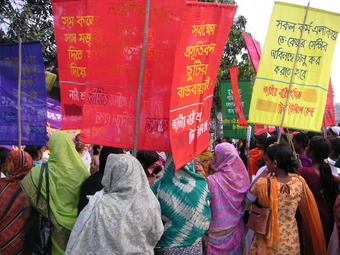
International Women’s Day Rally
International Women’s Day rally in Dhaka, Bangladesh, organized by the National Women Workers Trade Union Centre on 8 March 2005.
21.3.8: New Social Movements
New social movements focus on issues related to human rights, rather than on materialistic concerns, such as economic development.
Learning Objective
Evaluate the significance of new social movements (NSMs), which are more concerned with social and cultural issues, and the implications NSMs have on modern-day society
Key Points
- New social movements (NSMs) are described by a theory regarding social movements which posits that the advent of the post-industrial economy resulted in a new wave of social movements distinct from those social movements arising during the industrial economy.
- In these new social movements, more importance is attached to social and cultural concerns, rather than economic or political considerations.
- Actors in NSMs are from a new middle class, instead of from the lower classes, as was typical of social movements of the industrial economy.
- NSMs consist of informal, loosely organized social networks of supporters rather than members and tend to be locally-based.
- NSMs act as a platform for collective action in civil society or in the cultural domain, rather than as an instrumental tool for the state. As such, new movements are often considered to be anti-authoritarian.
- NSMs are normally centered on a single issue, or a limited range of issues which are related to a broader theme, such as the environment.
- Critiques of NSM theory include the fact that non-materialistic movements existed in the industrial-era and materialistic movements persist in the post-industrial economy; while there are few traits that are specific to new social movements, differences between old and new movements have already been explained by theories preceding NSM; and the NSM does not take into account right-wing movements.
Key Terms
- new middle class
-
The American middle class, at least those living the lifestyle, has become known around the world for conspicuous consumption. To this day, the professional middle class in the United States holds the world record for having the largest homes, most appliances, and most automobiles.
- materialistic
-
Being overly concerned with material possessions and wealth.
- human rights
-
The basic rights and freedoms that all humans should be guaranteed, such as the right to life and liberty, freedom of thought and expression, and equality before the law.
New Social Movements
The term new social movements (NSMs) is a theory of social movements that attempts to explain the plethora of new movements that have come up in various western societies roughly since the mid-1960s (i.e. in a post-industrial economy), which are claimed to depart significantly from the conventional social movement paradigm .

Aberle’s Four Types of Social Movements
The term new social movements (NSMs) is a theory of social movements that attempts to explain the plethora of new movements that have come up in various western societies roughly since the mid-1960s (i.e. in a post-industrial economy), which are claimed to depart significantly from the conventional social movement paradigm.
There are two central claims of the NSM theory. Firstly, the rise of the post-industrial economy is responsible for a new wave of social movement. Secondly, these movements are significantly different from previous social movements of the industrial economy. The primary difference is in their goals, as the new movements focus not on issues of materialistic qualities such as economic well-being, but on issues related to human rights (such as gay rights or pacifism).
Characteristics
The most noticeable feature of new social movements is that they are primarily social and cultural and only secondarily, if at all, political. Departing from the worker’s movement, which was central to the political aim of gaining access to citizenship and representation for the working class, new social movements concentrate on bringing about social mobilization through cultural innovations, the development of new lifestyles, and the transformation of identities. It is clearly elaborated by Habermas that new social movements are the “new politics” which is about quality of life, individual self-realization, and human rights; whereas the “old politics” focused on economic, political, and military security. The concept of new politics can be exemplified in gay liberation, the focus of which transcends the political issue of gay rights to address the need for a social and cultural acceptance of homosexuality. Hence, new social movements are understood as “new,” because they are first and foremost social, unlike older movements which mostly have an economic basis.
New social movements also emphasize the role of post-material values in contemporary and post-industrial society, as opposed to conflicts over material resources. According to Melucci, one of the leading new social movement theorists, these movements arise not from relations of production and distribution of resources, but within the sphere of reproduction and the life world. Consequently, the concern has shifted from the production of economic resources as a means of survival or for reproduction to cultural production of social relations, symbols, and identities. In other words, the contemporary social movements reject the materialistic orientation of consumerism in capitalist societies by questioning the modern idea that links the pursuit of happiness and success closely to growth, progress, and increased productivity and by instead promoting alternative values and understandings in relation to the social world. As an example, the environmental movement that has appeared since the late 1960s throughout the world, with its strong points in the United States and Northern Europe, has significantly brought about a “dramatic reversal” in the ways we consider the relationship between economy, society, and nature.
Further, new social movements are located in civil society or the cultural sphere as a major arena for collective action rather than instrumental action in the state, which Claus Offe characterizes as “bypass[ing] the state. ” Moreover, since new social movements are not normally concerned with directly challenging the state, they are regarded as anti-authoritarian and as resisting incorporation at the institutional level. They tend to focus on a single issue, or a limited range of issues connected to a single broad theme, such as peace or the environment. New social movements concentrate on the grassroots level with the aim to represent the interests of marginal or excluded groups. Therefore, new collective actions are locally based, centered on small social groups and loosely held together by personal or informational networks such as radios, newspapers, and posters. This “local- and issue-centered” characteristic implies that new movements do not necessarily require a strong ideology or agreement to meet their objectives.
Additionally, if old social movements, namely the worker’s movement, presupposed a working class base and ideology, the new social movements are presumed to draw from a different social class base, i.e., “the new class. ” This is a complex contemporary class structure that Claus Offe identifies as “threefold” in its composition: the new middle class, elements of the old middle class, and peripheral groups outside the labor market. As stated by Offe, the new middle class has evolved in association with the old one in the new social movements because of its high levels of education and its access to information and resources. The groups of people that are marginal in the labor market, such as students, housewives, and the unemployed participate in the collective actions as a consequence of their higher levels of free time, their position of being at the receiving end of bureaucratic control, and their inability to be fully engaged in society specifically in terms of employment and consumption.
Chapter 20: Sexuality
20.1: Socialization and Human Sexuality
20.1.1: Socialization and Human Sexuality
Expression of sexual desire involves behaviors learned through socialization (i.e., from society), especially from religion, law, and the media.
Learning Objective
Examine the various ways in which a person is sexually socialized, specifically through religion, law, and the media
Key Points
- With regard to sexuality, socialization in the U.S. and Western countries most notably adheres to heteronormativity, or the marking of heterosexual unions as normal and homosexual unions as socially abnormal and deviant.
- Religion, the law, and the media are three primary agents of socialization that teach people how to behave sexually.
- There is extreme variation in sexual expression across historical periods and cultures. This indicates that there are no universal sexual norms.
- In the current Western moment, heteronormative norms are privileged, meaning that heterosexual expressions of sexuality are more accepted than homosexual expressions. However, sexuality is not thought of in the same way across space and time; rather different cultures and different historical moments think of sexuality in entirely different ways.
Key Terms
- sodomy laws
-
Sodomy laws in the United States, which outlawed a variety of sexual acts, were historically universal. While they often targeted sexual acts between persons of the same sex, many statutes employed definitions broad enough to outlaw certain sexual acts between persons of different sexes as well, sometimes even acts between married persons.
- pornography
-
The explicit depiction of sexual subject matter; a display of material of an erotic nature.
- heteronormativity
-
The view that all human beings are either male or female, both in sex and in gender, and that sexual and romantic thoughts and relations are normal only when between people of different sexes.
One learns from society how to express one’s sexuality. As such, sexual expression is part of socialization, the lifelong process of inheriting and disseminating norms, customs, and ideologies and providing an individual with the skills and habits necessary for participating within one’s own society. Socialization necessarily implies the inculcation of norms, or behaviors that society marks as valued as opposed to those marked as deviant.
In regards to sexuality, socialization in the U.S. and Western countries most notably adheres to heteronormativity, or the marking of heterosexual unions as normal and homosexual unions as socially abnormal and deviant. While homosexual unions are the types of unions most commonly marked in opposition to normative heterosexual unions, heteronormativity marks any type of non-heterosexual sexual activity as deviant, as heterosexual sexual acts are considered the norm.
There is extreme variation in sexual expression across historical periods and cultures. This indicates that there are no universal sexual norms. Rather, an individual is taught sexual norms of their particular cultural and historical moment through socialization. At the current moment in Western societies, sexuality is evaluated along a continuum of heterosexuality and homosexuality, with heterosexuality as the privileged mode of sexual expression. Obviously, this is a basic schematic; it does not capture all of the existing ways in which people behave sexually, but it is the basic rubric by which sexual behaviors are evaluated.
In contrast, the Ancient Greeks categorized sexuality not in terms of homosexuality and heterosexuality, but in terms of active and passive sexual subjects. What was salient for the Ancient Greeks was whether one took an active or passive sexual position, whether one was the penetrator or was penetrated. In this sense, biological gender was obviously relevant, but not in the same way as evaluating homo- or heterosexual orientation. Men could be either active or passive, but women could only be passive. It is misleading to say that homosexuality was tolerated in Ancient Greece; rather, the Ancient Greeks conceived of sexuality in completely different ways than the current Western norm.
So how is it that one becomes socialized into certain sexual behaviors and proclivities? The rest of this section seeks to explore how socializing agents impress sexual norms into their members by looking at three primary agents of socialization: religion, the law, and the media.
Given that most religions seek to instruct their followers on the proper and holy ways in which to live life, it follows that most religions seek to offer guidance on the proper ways to sexually comport oneself. For example, many evangelical Christians value abstinence and believe that men and women should wait until marriage to engage in sexual activity. The Catholic Church asserts that homosexuality is unholy. Leaders of the Jewish faith promote sexual activity between married couples to reinforce the marital bond and produce children. Like most of the other denominations of monotheistic religions, Islam encourages sexual activity so long as it is practiced by married partners. This is not to say, of course, that all adherents to a particular faith stringently follow the faith’s guidelines, but rather that individuals growing up within a particular religion are instructed on how to behave sexually.
The legal system is another mechanism through which individuals are instructed on proper sexual conduct. The laws within a particular jurisdiction simultaneously reflect and create social norms regarding sexuality. For example, based on American law, Americans are socialized to believe that prostitution and rape are improper forms of sexual behavior. The interactions of homosexual sexual acts and their (il)legality provides an opportunity to see how the law both mirrors and molds American understandings of sexual norms. Sodomy laws, or laws prohibiting particular sexual acts between two consenting partners such as anal sex between two men, were on the books in most American states for decades.
The media is one final example of a cultural program through which individuals encounter normative discourses of sexuality. Individuals are socialized to replicate the sexual behaviors that they see on television, in movies, and in books. These representations are typically heteronormative. Pornography presents another way in which individuals are socialized towards particular sexual practices through the media. Over 70% of men ages 18–34 who use the Internet view at least one pornographic website a month. Follow-up studies show that many of these individuals—in addition to female pornography viewers—attempt to incorporate the actions they witness in pornography into their own sex lives.

Heterosexual couple
Heterosexuality is a social norm.
20.1.2: Sexual Behavior: Kinsey’s Study
Alfred Kinsey produced the Kinsey Report, the largest documentation of sexuality in the United States at the time of its publication.
Learning Objective
Analyze the impact of Kinsey’s study of sexuality related to how it changed the public’s perception of sexuality and how people are sexually socialized
Key Points
- Kinsey developed the Kinsey Scale, which was a numerical ranking of sexual behavior on a scale of complete heterosexuality to complete homosexuality.
- Kinsey’s open discussion of sexuality in the 1950s contributed to the sexual revolution of the following decade, in which social standards that limited sex to heterosexual marriage were loosened.
- The Kinsey Report is frequently invoked to support the common estimate of one in ten Americans being a homosexual.
Key Terms
- sexual revolution
-
A period in which attitudes towards sexual behavior undergo a substantial change, usually in the direction of increased liberality.
- sexology
-
The study of sex and sexuality.
Background
Dr. Alfred Kinsey was an American biologist who is considered to be the founder of sexology, or the scientific study of human sexuality, including human sexual interests, behavior, and function. Kinsey trained as a biologist and entomologist at Harvard and obtained a teaching post at Indiana University. There, he became interested in human sexuality. In 1935, Kinsey delivered a lecture to a faculty discussion group where he attacked the “widespread ignorance of sexual structure and physiology” and advanced the notion that delayed sexual experience, or waiting to engage in sexual activity until marriage, was psychologically harmful. This lecture sparked intensive research that resulted in the Kinsey Report. The report refers to two different book publications based on his research of human sexuality: Sexual Behavior in the Human Male (1948) and Sexual Behavior in the Human Female (1953). The books were widely read and Kinsey became a media star.
The Kinsey Report was the most extensive analysis of human sexuality conducted to its day. Data was gathered primarily by means of subjective interviews, conducted according to a structured questionnaire memorized by the experimenters. Significantly, the Kinsey research team went out and conducted the interviews themselves, rather than relying upon pre-collected data. What resulted was the largest collection of statistical information about adult sexuality in the United States.
The Kinsey Scale
A large section of the Kinsey Report was devoted to the idea of sexual orientation. The Kinsey Report is frequently invoked to support the common estimate of one in ten Americans being a homosexual. However, Kinsey disapproved of using terms like homosexual or heterosexual, as he firmly believed that sexuality is prone to change over time and that sexual behavior must be understood both as physical contact as well as purely psychological phenomena, such as desire, attraction, and fantasy. Instead of using the homosexual/heterosexual categorization, Kinsey developed the Kinsey Scale system. This system attempts to describe a person’s sexual history or episodes of sexual activity at a given point in time, rather than assigning an individual an overarching and permanent sexual orientation.
The scale ranked sexual behavior from zero to six, with zero being completely heterosexual and six being completely homosexual. As one can see, Kinsey rejected the idea of a permanent status of sexual orientation and instead chose to rely on a rating relating to a particular moment in one’s life, indicating that sexuality changes over time. Nevertheless, Kinsey’s Scale is effectively a segmented version of the hetero/homosexual binary, not allowing for other interpretations of sexuality. Kinsey’s associates actually added an additional category, X, to represent asexuals, or people who experience no sexual desire. In this way, Kinsey’s report is of its particular cultural and historical moment, in that it conceives of American sexuality as only occurring along this binary. According to Kinsey, 11.6% of white males aged 20 to 35 were given a rating of three for this period in their lives, meaning that they were equally heterosexual and homosexual. Kinsey further found that 7% of single females aged 20 to 35 and 4% of previously married females were given a rating of three for this period of their lives. The report also states that nearly 46% of the male interview subjects had “reacted” sexually to persons of both sexes in the course of their adult lives, and 37% had at least one homosexual experience.
Sexuality Within Marriage
The Kinsey study also gave statistics on sexuality within marriage that had never before been reported. According to Kinsey, the average frequency of marital sex reported by women in their late teens was 2.8 times per week, 2.2 times per week for women by the age of 30, and once per week by women by the age of 50. Kinsey estimated that approximately half of all married males had some extramarital experience at some point in their married lives. Among Kinsey’s sample, 26% of females had extramarital sex by their forties. Kinsey found that between 10 and 16% of married females aged 26 to 50 were engaged in extramarital sex.
Critical Response
Kinsey’s report was wildly successful. The two books together sold over 750,000 copies and were translated into thirteen languages. They may be considered some of the most successful and influential scientific literature of the twentieth century. The reports are associated with a significant change in public perceptions of sexuality. A mere decade after the reports were published, the first oral contraceptive was introduced and the sexual revolution began. The sexual revolution was a social movement from the 1960s to the 1980s that increased acceptance of sex outside of marriage.

The Kinsey Institute for Research in Sex, Gender, and Reproduction
The photo shows Morrison Hall at Indiana University, home of the Kinsey Institute.
20.1.3: Sexual Behavior Since Kinsey
The Kinsey Report helped spark the sexual revolution, in which social regulations regarding sexual activity were loosened.
Learning Objective
Summarize the impact of the Kinsey Report and the sexual revolution of the 1960s on American sexuality
Key Points
- The Kinsey Report was the largest study of norms in American sexuality to its time, conducted by Kr. Alfred Kinsey.
- The development of oral contraception also contributed to the loosening of social regulations on sexuality.
- The sexual revolution was a social movement in which social rules of sexuality became more lax.
- The Kinsey scale is a numeric scaling of individuals along a continuum of complete heterosexuality to complete homosexuality.
Key Terms
- sexual revolution
-
A period in which attitudes towards sexual behavior undergo a substantial change, usually in the direction of increased liberality.
- oral contraception
-
Medications taken by mouth for the purpose of birth control.
- Kinsey Report
-
The Kinsey reports are two books on human sexual behavior, Sexual Behavior in the Human Male (1948) and Sexual Behavior in the Human Female (1953), by Dr. Alfred Kinsey, Wardell Pomeroy and others, and published by Saunders. Kinsey was a zoologist at Indiana University and the founder of the Kinsey Institute for Research in Sex, Gender and Reproduction (more widely known as the Kinsey Institute).
The publication of the Kinsey Report, the findings of norms in American sexuality by Dr. Alfred Kinsey, in the early 1950s contributed to the sparking of the sexual revolution, or the loosening of sexual mores demanding sex between heterosexual married partners that occurred in the 1960s. While other sexualities were still stigmatized in most post-Kinsey environments, the sexual revolution was marked by popular acceptance of premarital sex. Studies have shown that between 1965 and 1975, the number of women who had had sexual intercourse prior to marriage showed a marked increase. The social and political climate of the 1960s was a unique one in which traditional values were often challenged loudly by a very vocal minority.
Kinsey’s 1950s study of sexuality contributed to the sexual revolution of the 1960s in two ways. First, prior to the Kinsey Report, no one had interviewed and published such an exhaustive and comprehensive analysis of Americans’ sexual desires and practices. Kinsey’s report reachd the conclusion that few Americans are completely heterosexual in desire or practice as indicated by the Kinsey Scale, or a numeric scaling of individuals along a continuum from complete heterosexuality to complete homosexuality. Though the Kinsey Report was published in the popular press, it was a scientific study conducted by a biologist at an academic institution. Popular readers of the Kinsey Report imbued the findings with a sense of scientific authority and professed faith in their accuracy. While other sexual orientations and acts were still marked as non-normative, society began to accept that other sexualities existed. The Kinsey Report was one step towards non-heterosexual orientations and behaviors becoming accepted by society as normal. Second, one cannot underestimate the significance of the mere publication of the Kinsey Report, independent of its findings. Prior to its publication, sexuality was considered uncouth to include in conversation. Kinsey’s publication initiated a national environment more tolerant to conversations about sexuality, which in and of itself loosened the grip of normalized, marital heterosexual relations.
Another scientific product had a profound impact on the development of the sexual revolution: the development of oral contraception. “The pill” provided many women a more affordable way to avoid pregnancy. Before the pill, there was a lack of affordable and safe options for contraception, rendering unwanted pregnancy a serious risk of premarital sexual activity. In 1960, the Food and Drug Administration licensed the drug, enabling its legal sale. However, many states still outlawed the use of contraceptives in order to reflect and enforce an ethic in which sexual activity was only acceptable for reproduction. The pill became an even more favored and socially acceptable means of birth control in 1965 when the Supreme Court decided the case of Griswold v. Connecticut. In its opinion, the Supreme Court held that the government could not dictate the use of contraception by married couples because such action would be a violation of the right to marital privacy implied in the Bill of Rights. The ruling furthered access to birth control and contributed to a post-Kinsey sexual environment in which society increasingly accepted premarital sex.

The Pill
The landmark Supreme Court case Griswold v. Connecticut affirmed women’s right to use birth control.
20.1.4: Sexual Orientation
Sexual orientation refers to enduring emotional, romantic and sexual attraction to the opposite sex, the same sex, both, or neither.
Learning Objective
Explain the development of sexual orientation (heterosexual, homosexual, bisexual or asexual) in terms of both static and fluid sexuality
Key Points
- The varying forms of these attractions are generally divided into the following categories: heterosexuality, homosexuality, bisexuality and asexuality.
- In place of these categories, some prefer to think of “queer” sexual orientations; a broader term that refers to any non-heterosexual form of sexuality. The heterosexual/homosexual binary is a continuum of complete heterosexuality to complete homosexuality, with bisexuality in the middle.
- Heteronormativity is the assumption that heterosexual orientations are normal to the exclusion of other sexual orientations.
- Sexual identity is an individual’s conception of their own sexuality.
- The primary debate in conversations about sexual orientation is whether sexual orientation is static or fluid, whether one is born with an immutable sexual orientation, or whether one develops sexual orientation.
- Sexual reorientation therapies seek to “convert” homosexuals into heterosexuals.
- Sexual reorientation therapies seek to convert “homosexuals” into “heterosexuals. “
Key Terms
- heterosexual/homosexual binary
-
Classification of sexuality on a continuum from heterosexuality to homosexuality with bisexuality falling in the middle
- asexuality
-
Asexuality, in its broadest sense, is the lack of sexual attraction to others or the lack of interest in sex. It may also be considered a lack of a sexual orientation.
- heteronormativity
-
The view that all human beings are either male or female, both in sex and in gender, and that sexual and romantic thoughts and relations are normal only when between people of different sexes.
Sexual Orientation
Sexual orientation describes an enduring pattern of attraction—emotional, romantic, sexual, or some combination of these—to the opposite sex, the same sex, both, or neither. The varying forms of these attractions are generally divided into the following categories:
- heterosexuality, or attraction to members of the opposite biological sex
- homosexuality, or attraction to members of the same biological sex
- bisexuality, or attraction to members of both biological sexes
- asexuality, or attraction to neither biological sex.
Some individuals have tried to trouble these categories of sexual orientation by not describing themselves as hetero-, homo-, bi-, or asexual and preferring the umbrella term “queer. ” Part of the opposition to the gender binary is that it creates heteronormative assumptions that mark heterosexuality as normal and homosexuality deviant merely because it is the opposite of heterosexuality.
Significantly, sexual orientation does not only refer to one’s sexual practices, but also includes a psychological component, like the direction of an individual’s erotic desire. Sexual identity and sexual behavior are closely related to sexual orientation, but they are distinguishable. Sexual identity refers to an individual’s conception of their own sexuality, while sexual behavior limits one’s understanding of sexuality to behaviors performed. People may or may not express their sexual orientation in their behaviors.
Development of Sexual Orientation
The primary tension in conversations about sexual orientation addresses whether sexual orientation is static or fluid, whether one is born with an immutable sexual orientation, or whether one develops sexual orientation. Each interpretation of sexuality manages our understanding of what sexual orientation means in different ways, particularly when combined with political debates about homosexuality. Organizations that subscribe to the static interpretation of sexual orientation fall on both sides of the political divide. Some organizations are socially and politically conservative, advancing the view that sexuality, left untreated, is static. These organizations tend to pathologize non-heterosexual orientations, or conceive of them as an illness that must be corrected through medical or therapeutic means. Some of these institutions offer sexual reorientation therapies in which individuals who are attracted to members of the opposite sex but do not want to have those attractions can try to become solely attracted to members of the opposite biological sex. Many of these programs are religiously motivated; 79% of men who said that they had changed their sexual orientation said that they had done so for religious reasons, while 93% indicated that religion was “extremely” or “very” important to them.
Sexual Reorientation
A significant amount of professional and academic doubt exists about the efficacy of these reorientation programs. No major mental health professional organization has sanctioned efforts to change sexual orientation and virtually all of them have adopted policy statements cautioning the profession. These include the American Psychiatric Association, the American Psychological Association, the American Counseling Association, the National Association of Social Workers in the USA, and the Royal College of Psychiatrists. According to the American Psychological Association and the Royal College of Psychiatrists’ Gay and Lesbian Mental Health Special Interest Group, there is no sound scientific evidence that sexual orientation can be changed.
Though they obviously disagree with the conceit that homosexuality needs to be treated, many major gay rights advocacy groups mirror the underlying assumption that homosexuality is a static sexual orientation. The idea that sexual orientation is not a choice, but that rather one is born with an assigned orientation, is pervasive in popular conceptions of sexual orientation. This idea runs up against studies that demonstrate how widely sexual orientation varies in light of cultural and historical circumstances, indicating that one’s environment and cultural context play significant roles in determining one’s sexual orientation.
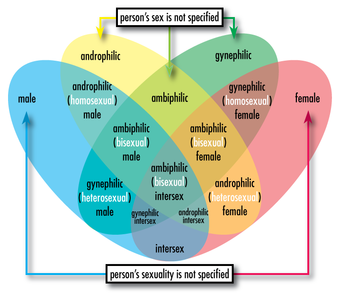
Sex and Sexuality
Venn diagram depicting the relationships between assigned sex and sexual orientation. Androphilia and gynephilia are preferred terms for some populations, because homosexual and heterosexual assign a sex to the person being described.
20.1.5: Homophobia
Homophobia is the range of negative attitudes and feelings towards homosexuality or people who are perceived to be homosexual.
Learning Objective
Describe the phenomenon of homophobia (both institutional and informal) and the implications it has for LGBTQ individuals in modern-day America
Key Points
- Homophobia is expressed through prejudice and discrimination, which can either be institutional or informal.
- The phrase LGBTQ refers to the community of lesbian, gay, bisexual, transgender, and queer individuals.
- Institutional discrimination involves the state and the law, while informal discrimination refers to social controls and prejudices.
- In the United States, social disapproval of homosexuality is not evenly distributed throughout society. That being said, it is more or less pronounced according to age, ethnicity, geographic location, race, sex, social class, education, political identification, and religious status.
- Civil unions are ceremonies that grant same-sex couples in some states legal equality, even if not by the name of “marriage. “
Key Terms
- informal discrimination
-
discrimination that involves social pressures against LBGTQ behaviors and identities
- institutional discrimination
-
discrimination that involves the state by becoming embedded in state institutions and practices
- Holocaust
-
the mass murder of Jews and other persecuted groups by the Nazi regime during World War II
Homophobia is a range of negative attitudes and feelings towards homosexuality or people perceived as homosexual . Homophobia is observable in critical and hostile behavior like discrimination and violence. Much like racism or sexism, homophobia involves the targeting of a specific population of individuals with certain traits. Homophobia, or the fear of lesbian, gay, bisexual, transgender, and queer (LGBTQ) individuals, is often the impetus for discrimination, which can be expressed through either institutional or informal means. Institutional discrimination involves the state apparatus. If homophobic discrimination is institutional, it means either that non-heterosexual sex acts are criminalized or that LGBTQ individuals are denied the same legal rights as heterosexuals. Informal discrimination is not necessarily sanctioned by the state, but involves social pressures against LGBTQ individuals, behaviors, and identities.

Homophobic Protests in the United States
Frequently, homophobia is prompted by religious beliefs.
In the United States, the social disapproval of homosexuality is not evenly distributed throughout society. That being said, it is more or less pronounced according to age, ethnicity, geographic location, race, sex, social class, education, political identification, and religious status. Republicans are far more likely than Democrats to have negative attitudes about people who are LGBTQ. Likewise, people who consider themselves to be religious are more likely than secular individuals to hold negative views about LGBTQ people.
Historical Institutional Homophobia: Holocaust
On many occasions in Western nations in the twentieth century, LGBTQ individuals have been stigmatized because of homophobia. One notorious example of homophobia and extreme discrimination was the persecution of LGBTQ individuals by the Nazis during the Holocaust. After the rise of Adolf Hitler, homosexuals were one of the many groups targeted by the Nazi Party and became victims of the Holocaust. Beginning in 1933, gay organizations were banned, scholarly books about homosexuality were burned, and homosexuals within the Nazi Party itself were murdered. Between 1933 and 1945, an estimated 100,000 men were arrested as homosexuals, of whom some 50,000 were officially sentenced to imprisonment. Most of these German men served time in regular prisons, but an estimated 5,000 to 15,000 were forced to serve their time in concentration camps. Like Jews and the disabled, Hitler labeled homosexuals as defective and systematically persecuted them.
Current Institutional Persecution of Homosexuals
Today, homosexuality is still punishable by death in some countries around the world. Uganda, for example, criminalizes non-heterosexual sex acts and most Ugandans consider non-heterosexuality to be taboo. In October, 2009, a member of the Ugandan Parliament introduced the Uganda Anti-Homosexuality Bill to broaden the criminalization of same-sex relationships and apply the death penalty to repeat offenders. Under the statues of the bill, individuals convicted of a single act of non-heterosexual sex would receive life imprisonment. Additionally, individuals or companies promoting LGBTQ rights would be nationally penalized. The bill also created a public policing policy under which Ugandan citizens would be required to report any homosexual activity within 24 hours or face a maximum penalty of three years in prison. Additionally, if Ugandan citizens were found to be engaging in same-sex sexual or romantic activities outside the country, Uganda would request extradition.
Homophobia and the United States
Although non-heterosexual sex acts are legal in the United States, LGTBQ people still face institutional discrimination because they are not afforded the same rights as heterosexual couples. Most evidently, same-sex couples are not allowed to wed in most states. Gay marriage has become a sensitive political issue over the past decade, partially due to the fact that the federal government and state governments have different laws about gay marriage. The federal government does not recognize gay marriage, but individual states can choose to recognize it. In 1996, the federal government passed the Defense of Marriage Act. According to this act, the federal government cannot recognize gay marriages, and a state that does not recognize gay marriage does not have to accept the marriage license given to a same-sex couple in a different state that does recognize same-sex marriages. As part of this debate about the legality and morality of gay marriage, 41 states have explicitly banned same-sex marriages, 12 by statute and 29 through amendments to the state constitutions.
Informal Homophobia
Prejudices do not have to be institutionalized to be harmful. Many instances of homophobia and discrimination occur by informal means. Homophobia can occurs when heterosexual individuals feel anxiety about being perceived as gay by others. This phenomenon is most commonly experienced by adolescent boys. The taunting of boys seen as eccentric, many of whom are usually not gay, is said to be endemic in rural and suburban American schools. At times, this abuse can lead taunted individuals to take dangerous risks in efforts to prove a normative masculinity. Adolescents in the United States often use phrases like “that’s so gay” in a pejorative sense.

Same-Sex Marriage in the United States (2008)
Laws regarding same-sex marriage vary by state in the U.S. The federal government cannot recognize gay marriage, and individual states can choose whether or not they will recognize the practice.
20.1.6: The Movement for Gay and Lesbian Civil Rights
The LGBT rights movement refers to the efforts of LGBT advocates to improve their legal and social status.
Learning Objective
Analyze the efforts of the LGBT rights movement to achieve equal rights and opportunities for homosexual, bisexual, and transgendered individuals
Key Points
- Though some states have equal rights laws, many gay and lesbian couples are still denied the same marriage rights as heterosexual couples and cannot file joint taxes, cannot share custody of children, cannot have hospital visitation rights, and inheritance.
- The first organizations in the U.S. that worked to improve LGBT issues were known as homophile organizations, such as the Mattachine Society and the Daughters of Bilitis.
- Sodomy laws are laws against any sexual contact other than heterosexual intercourse.
- The Stonewall Riots were riots in New York City in 1969 that is frequently thought of as the start of the movement by LGBT people to decriminalize homosexuality.
- In 1986, the U.S. Supreme Court found that states could criminalize homosexuality in Bowers v. Hardwick.
- In 2003, the U.S. Supreme Court ruled in Lawrence v. Texas that anti-sodomy laws violated an individual’s right to privacy. Currently, many LGBT organizations are working to achieve the right for same-sex couples to marry.
- In 2003, the U.S. Supreme Court ruled in Lawrence v. Texas that anti-sodomy laws violated an individual’s right to privacy. Currently, many LGBT organizations are working to achieve the right of same-sex couples to marry.
Key Terms
- same-sex civil unions
-
also referred to as a civil partnership; a legally recognized form of partnership similar to marriage. Beginning with Denmark in 1989, civil unions under one name or another have been established by law in several, mostly developed, countries in order to provide same-sex couples rights, benefits, and responsibilities similar (in some countries, identical) to opposite-sex civil marriage.
- Defense of Marriage Act
-
(DOMA); a United States federal law that defines marriage as the legal union of one man and one woman.
The LGBT Rights Movement refers to the attempts of lesbian, gay, bisexual, and transgender advocates to improve the legal and social status of LGBT people. Historically, LGBT people have faced prejudice and discrimination. Since the mid-1900s, individuals and organizations have worked to overcome prejudice against LGBT people.
The first organizations in the U.S. that worked to improve the standing of LGBT people were known as homophile organizations. Homophile organizations were clubs of gay men and lesbian women who sought equality for gays and lesbians. These clubs served as social spaces in which gay men and lesbian women could meet other homosexuals with whom they could form romantic and sexual relationships. Moreover, they were early sites of political action on behalf of gays and lesbians. Homophile organizations such as the Mattachine Society and the Daughters of Bilitis lobbied politicians and business owners to create gay friendly establishments. The efforts of these types of clubs led to a growth in the number of gay-friendly bars and social clubs, making it easier for homosexual individuals to find other homosexuals to associate with. Homophile organizations, however, did not lead to any large-scale demonstrations or protests, and did not result in widespread legal or social changes for LGBT people.
Prior to the 1970s, most states in the United States had laws against sodomy, generally defined as any sexual contact other than heterosexual intercourse. Thus, homosexuality was essentially illegal. The surge in the number of gay-friendly bars in the 1950s led to police crackdowns against establishments that were frequented by gays and lesbians in the 1950s and 1960s. One such crackdown was the raid on the Stonewall Inn, a bar in Greenwich Village, New York City that was frequented by gay men, drag queens, and male transvestites. When police raided the bar in June 1969, the customers resisted arrest. Neighborhood residents joined in the resistance, resulting in several nights of rioting. The Stonewall Riots are often cited as the first major protest by LGBT people against the criminalization of homosexuality. The riots gained much media attention and served as visible evidence that there was a large population of homosexual people that could be organized into a politically active group.
After Stonewall, large organizations of LGBT advocates arose to challenge discrimination against LGBT people . For example, leaders organized the first Gay Pride march to commemorate the one year anniversary of the Stonewall Riots and to loudly declare their desire for equality. First and foremost on the gay rights platform was the need to overturn laws that made homosexuality illegal. Throughout the 1970s, activists in many states succeeded in having state legislatures overturn laws banning homosexuality. This coincided with a period in which sexual mores were generally liberalized in the U.S. Nonetheless, by the mid-1980s many states still outlawed homosexuality. It was not until 2003 that the Supreme Court decided that states could not criminalize homosexuality.

Anti-sodomy laws in the United States
This map depicts when anti-sodomy laws that criminalized non-heterosexual sex were overturned by state in the United States.
An issue that has been central to the LGBT rights movement since the late 1980s is same-sex marriage. At the 1987 National March on Washington for Lesbian and Gay Rights, recognition of lesbian and gay relationships was a primary demand made by demonstrators. Indeed, many protestors participated in a mass wedding in front of the Internal Revenue Service (IRS) to highlight the ways in which U.S. tax code benefits married heterosexual couples. Because they were denied the right to marry, gay and lesbian couples could not file taxes jointly, often could not share custody of children, and lacked hospital visitation rights and rights of inheritance, among other benefits of marriage.
In response to same sex couples’ attempts to gain state marriage licenses, the U.S. Congress passed the Defense of Marriage Act (DOMA) in 1996. DOMA defined marriage as between one man and one woman in federal law, meaning that the federal government would not confer benefits to same-sex couples granted marriage licenses by states. It additionally stated that states did not need to recognize same-sex marriages granted by other states. Nonetheless, by the early 2000s, many states began to consider legalizing same-sex marriage. The first to do so was Massachusetts in 2004. Since then, Connecticut, Iowa, New Hampshire, New York, and Vermont have followed suit. Other states have passed laws allowing for same-sex civil unions. Civil unions provide the legal benefits of marriage to same-sex couples, but not the title of marriage. At present, thirty-one states have passed constitutional bans on same-sex marriage, defining marriage within their state as between a man and a woman. Court cases challenging the legality of these bans are currently underway, as are legal challenges to the constitutionality of DOMA. Challenges to bans on same-sex marriage contend that laws prohibiting same-sex marriage are discriminatory.
20.1.7: Social Context and Sexual Behavior
Social context influences sexual behavior; sexuality is expressed and understood through socialized processes.
Learning Objective
Discuss the various ways people can express sexual desire, in both emotional and physical terms
Key Points
- Sexual behavior refers to the manner in which humans experience and express their sexuality.
- Individuals are taught to use social cues to interpret sexual intent. This is most obviously demonstrated in behaviors associated with flirtation.
- Human sexual activity has sociological elements. Social context is therefore essential when one considers potentially sexual behavior.
Key Terms
- flirtation
-
Playing at courtship; coquetry.
- context
-
The surroundings, circumstances, environment, background, or settings that determine, specify, or clarify the meaning of an event or other occurrence.
- socialization
-
Socialization is the process of transferring norms, values, beliefs, and behaviors to future group members.
Sexual behavior refers to the manner in which humans experience and express their sexuality. People engage in a variety of sexual acts from time to time, and for a wide variety of reasons. Sexual activity normally results in sexual arousal and physiological changes in the aroused person, some of which are pronounced while others are more subtle. Sexual activity also includes conduct and activities which are intended to arouse the sexual interest of another, such as strategies to find or attract partners (mating and display behavior), and personal interactions between individuals, such as flirting and foreplay.
Human sexual activity has sociological, cognitive, emotional, behavioral and biological elements, including physiological processes such as the reproductive mechanism, the sex drive and pathology; sexual intercourse and sexual behavior in all its forms; and personal bonding and shared emotions during sexual activity.
Socialization and Sexual Behavior
Since sexuality is expressed through means learned by socialization, social context is bound to influence sexual behavior. Socialization is the lifelong process of inheriting and disseminating norms, customs, and ideologies and providing an individual with the skills and habits necessary for participating within one’s own society. Socialization necessarily implies the inculcation of norms, or behaviors that society marks as valued. Because socialization teaches members of a society how to behave, behaviors that are not specifically taught as normalized and socially acceptable are marked as deviant.
Understanding Sexual Behavior
Individuals are taught to use social cues to interpret sexual intent. This is most obviously demonstrated in behaviors associated with flirtation. Flirting is a playful activity involving verbal communication and body language by one person toward another, used to sometimes indicate an interest in a deeper relationship with the other. In some social contexts, a hug could demonstrate platonic friendship, as in the case of two coworkers hugging upon hearing the news that their project was successfully received . In other contexts, the hug could be interpreted as sexual interest. Thus, social context is essential when one considers potentially sexual behavior.

An Embrace: Context Matters
Russian President Boris Yeltsin (right) and President Mintimer Shaimiyev (left) of Tatarstan congratulate each other on a treaty signed between Russia and Tatarstan on the delimitation of powers between them. In a different context, the same gesture could have very different connotations.
Socialization and Normalized Sexual Behavior
Because sexual behavior is influenced by socialization, what is deemed “normal” can vary widely across cultures. In some cultures, sexual activity is considered acceptable only within marriage, although premarital and extramarital sex are also common. Some sexual activities are illegal either universally or in some countries, and some are considered against the norms of a society. For example, sexual activity with a person below some age of consent and sexual assault in general are criminal offenses in most jurisdictions.
Chapter 19: Health and Illness
19.1: The Experience of Illness
19.1.1: The Experience of Illness
Illness, sometimes considered another word for disease, refers to a state of poor health.
Learning Objective
Examine the impact of illness in America and the prevalence of diagnosed illness among the population
Key Points
- Some scholars have maintained a distinction between illness and disease by describing illness as a patient’s subjective perception of an objectively defined disease.
- Epidemiology is the scientific study of factors affecting the health and illness of individuals and population.
- Behavioral medicine is an interdisciplinary field of medicine concerned with the development and integration of psychosocial, behavioral, and biomedical knowledge relevant to health and illness.
- The rise of scientific medicine in the past two centuries has altered or replaced many historic health practices.
- Mental illness is a broad generic label for a category of illnesses that may include affective or emotional instability, behavioral dysregulation, and/or cognitive dysfunction or impairment.
Key Terms
- epidemiology
-
The branch of a science dealing with the spread and control of diseases, computer viruses, concepts, etc. throughout populations or systems.
- behavioral medicine
-
Behavioral medicine is an interdisciplinary field of medicine concerned with the development and integration of psychosocial, behavioral and biomedical knowledge relevant to health and illness.
- scientific medicine
-
The rise of scientific medicine in the past two centuries has altered or replaced many historic health practices.
Example
- There are different types of illness within human society. Mental illness contains a diverse factors that contribute to the health of the mind. This may be associated with particular regions or functions of the brain or the rest of the nervous system, often in a social context. The recognition and understanding of mental health conditions have changed over time and across cultures. There are still variations in definition, assessment, and classification, although standard guideline criteria are widely used.
Introduction to Illness
Illness, sometimes considered another word for disease, is a state of poor health. Some scholars have maintained a distinction by describing illness as a patient’s subjective perception of an objectively defined disease. Conditions of the body or mind that cause pain, dysfunction, or distress can be deemed an illness. Sometimes the term is used broadly to include injuries, disabilities, syndromes, infections, symptoms, deviant behaviors, and atypical variations of structure and function. In other contexts these may be considered distinguishable categories.
Epidemiology
Epidemiology is the scientific study of factors affecting the health and illness of individuals and populations; it serves as the foundation and logic for interventions made in the interest of public health and preventive medicine. Behavioral medicine is an interdisciplinary field of medicine concerned with the development and integration of psychosocial, behavioral, and biomedical knowledge relevant to health and illness. According to evolutionary medicine, much illness is not directly caused by an infection or body dysfunction, but is instead a response created by the body. Fever, for example, is not caused directly by bacteria or viruses but by the body raising its normal temperature, which some people believe inhibits the growth of the infectious organism. Evolutionary medicine calls this set of responses “sickness behavior. “
All human societies have beliefs that provide explanations for, and responses to, childbirth, death, and disease. Throughout the world, illness has often been attributed to witchcraft, demons, or the will of the gods—ideas that retain some power within certain cultures and communities. However, the rise of scientific medicine in the past two centuries has altered or replaced many historic health practices.
Mental illness is a broad category of illnesses that may include affective or emotional instability, behavioral dysregulation, and/or cognitive dysfunction or impairment. Specific illnesses known as mental illnesses include major depression, generalized anxiety disorder, schizophrenia, and attention deficit hyperactivity disorder, to name a few.
Statistics show that more and more people are being diagnosed with mental disorders. The National Institute for Mental Health reports that over 40 million adults are diagnosed with an anxiety disorder in a given year, accounting for 18 percent of the population. Other disorders that are prevalent are ADHD (4 percent), mood disorders (9.5 percent) and and autism (1 percent, but quickly rising).
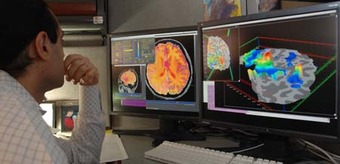
Researcher Test
A researcher studying a part of the human body in search for illness.
19.1.2: Gender and Health
Disparities in health services play out based on different systems of stratification, such as gender.
Learning Objective
Examine the role gender plays in health care services, particularly for women
Key Points
- The World Health Organization defines gender as the result of socially constructed ideas about the behavior, actions, and roles a particular sex performs.
- Gender, and particularly the role of women, is widely recognized as vitally important to international development issues.
- Women’s dual responsibilities as carers and income earners leaves them suffering from time poverty, and thus unable to access health and education services.
- The Gender-related Development Index (GDI), developed by the United Nations, aims to show the inequalities between men and women in the following areas: long and healthy life, knowledge, and a decent standard of living.
- The Gender-related Development Index (GDI), developed by the United Nations, aims to show the inequalities between men and women in the following areas: long and healthy life, knowledge, and a decent standard of living.
Key Terms
- World Health Organization
-
The World Health Organization (WHO) is a specialized agency of the United Nations (UN) that is concerned with international public health. It was established on April 7, 1948, with headquarters in Geneva, Switzerland, and is a member of the United Nations Development Group.
- gender stratification
-
There are a number of ways in which health disparities play out based on different systems of stratification. Researchers also find health disparities based on gender stratification.
- international development
-
International development or global development is a concept that lacks a universally accepted definition, but it is most used in a holistic and multi-disciplinary context of human development—the development of greater quality of life for humans. It therefore encompasses foreign aid, governance, healthcare, education, poverty reduction, gender equality, disaster preparedness, infrastructure, economics, human rights, environment and issues associated with these.
Examples
- One study found that women are less likely than men to be recommended for knee replacement surgery, even when they have the same symptoms. While it was unclear what role the sex of the recommending physicians played, the authors of this study encouraged women to challenge their doctors in order to get care equivalent to men.
- Studies demonstrate the positive impact of girls’ education on child and maternal health, fertility rates, poverty reduction and economic growth. Educated mothers are more likely to send their children to school.
The Role of Gender in Health
Gender is a range of characteristics used to distinguish between males and females, particularly in the cases of men and women and the masculine and feminine attributes assigned to them. Depending on the context, the discriminating characteristics vary, from sex to social role to gender identity. The World Health Organization defines gender as the result of socially constructed ideas about the behavior, actions, and roles a particular sex performs. Assigning gender involves taking into account the physiological and biological attributes assigned by nature followed by socially constructed conduct. The social label of being classified into one or the other sex is obligatory to the medical stamp on the birth certificate.
There are a number of ways in which health disparities play out based on different systems of stratification. Researchers also find health disparities based on gender stratification. One study found that women are less likely than men to be recommended for knee replacement surgery, even when they have the same symptoms. While it was unclear what role the sex of the recommending physicians played, the authors of this study encouraged women to challenge their doctors in order to get care equivalent to men.
Gender, and particularly the role of women, is widely recognized as vitally important to international development issues. This often means a focus on gender-equality, ensuring participation, but includes an understanding of the different roles and expectations of the genders within the community. As recognized by the United Nations, women’s dual responsibilities as carers and income earners leaves them suffering from time poverty, and thus unable to access health and education services. The Gender-related Development Index (GDI), developed by the United Nations, aims to show the inequalities between men and women in the following areas: long and healthy life, knowledge, and a decent standard of living.

Immunization for Babies
Immunizations from various diseases have improved health worldwide.
19.1.3: Race and Health
Health disparities refer to gaps in the quality of health and healthcare across racial and ethnic groups.
Learning Objective
Discuss the health disparities in the United States based on race and the implications for racial minorities
Key Points
- Race and health research, often done in the United States, has found both current and historical racial differences in the frequency, treatments, and availability of treatments for several diseases.
- In multiracial societies such as the United States, racial groups differ greatly in regard to social and cultural factors such as socioeconomic status, healthcare, diet, and education.
- There is a controversy regarding race as a method for classifying humans. The continued use of racial categories has been criticized.
- Apart from the general controversy regarding race, some argue that the continued use of racial categories in health care, and as risk factors, could result in increased stereotyping and discrimination in society and health services.
Key Terms
- Health disparities
-
Health equity refers to the study of differences in the quality of health and health care across different populations.
- multiracial societies
-
In multiracial societies such as the United States, racial groups differ greatly in regard to social and cultural factors, such as socioeconomic status, healthcare, diet, and education.
- life expectancy
-
The amount of time one is expected to live.
Example
- Health disparities based on race also exist. Similar to the difference in life expectancy found between the rich and the poor, affluent white women live 14 years longer in the U.S. (81.1 years) than poor black men (66.9 years).
The Role of Race in Health
Health disparities refer to gaps in the quality of health and healthcare across racial and ethnic groups. Race and health research, often done in the United States, has found both current and historical racial differences in the frequency, treatments, and availability of treatments for several diseases. This can add up to significant group differences in variables such as life expectancy. Many explanations for such differences have been argued, including socioeconomic factors, lifestyle, social environment, and access to preventive health-care services, among other environmental differences.
In multiracial societies such as the United States, racial groups differ greatly in regard to social and cultural factors such as socioeconomic status, healthcare, diet, and education. There is also the presence of racism which some see as a very important explaining factor. Some argue that for many diseases racial differences would disappear if all environmental factors could be controlled for. Race-based medicine is the term for medicines that are targeted at specific ethnic clusters, which are shown to have a propensity for a certain disorder. Critics are concerned that the trend of research on race specific pharmaceutical treatments will result in inequitable access to pharmaceutical innovation, and smaller minority groups may be ignored.
Health disparities based on race also exist. Similar to the difference in life expectancy found between the rich and the poor, affluent white women live 14 years longer in the U.S. (81.1 years) than poor black men (66.9 years). There is also evidence that blacks receive less aggressive medical care than whites, similar to what happens with women compared to men. Black men describe their visits to doctors as stressful, and report that physicians do not provide them with adequate information to implement the recommendations they are given.
Another contributor to the overall worse health of blacks is the incident of HIV/AIDS; the rate of new AIDS cases is ten times higher among blacks than whites, and blacks are 20 times as likely to have HIV/AIDS as are whites. Health disparities are well documented in minority populations such as African Americans, Native Americans, Asian Americans, and Latinos. When compared to European Americans, these minority groups have higher incidence of chronic diseases, higher mortality, and poorer health outcomes. Minorities also have higher rates of cardiovascular disease, HIV/AIDS, and infant mortality than whites. American ethnic groups can exhibit substantial average differences in disease incidence, disease severity, disease progression, and response to treatment.
Infant mortality is another place where racial disparities are quite evident. In fact, infant mortality rates are 14 of every 1000 births for black, non-Hispanics compared to 6 of every 1000 births for whites. Another disparity is access to health care and insurance. In California, more than half (59 percent) of Hispanics go without health care. Also, almost 25 percent of Latinos do not have health insurance, as opposed to 10 percent of Whites.
There is a controversy regarding race as a method for classifying humans. The continued use of racial categories has been criticized. Apart from the general controversy regarding race, some argue that the continued use of racial categories in health care, and as risk factors, could result in increased stereotyping and discrimination in society and health services. There is general agreement that a goal of health-related genetics should be to move past the weak surrogate relationships of racial health disparity and get to the root causes of health and disease. This includes research which strives to analyze human genetic variation in smaller groups across the world.

Percentage Without Insurance, Based on Race
Age-sex adjusted percent of persons of all ages without health insurance coverage, by race/ethnicity, United States, 2004
19.1.4: Social Class and Health
Social class has a significant impact on one’s physical health, ability to receive adequate medical care and nutrition, and life expectancy.
Learning Objective
Discuss the role social class plays in access to adequate health care and health inequality
Key Points
- While gender and race play significant factors in explaining healthcare inequality in the United States, socioeconomic status is the greatest determining factor in an individual’s level of access to healthcare.
- Social determinants of health are the economic and social conditions, and their distribution among the population, that influence individual and group differences in health status.
- They are risk factors found in one’s living and working conditions (such as the distribution of income, wealth, influence, and power), rather than individual factors (such as behavioral risk factors or genetics) that influence the risk for a disease, injury, or vulnerability to disease or injury.
- Social determinants of health are the economic and social conditions, and their distribution among the population, that influence individual and group differences in health status.
- Health inequality is the term used in a number of countries to refer to those instances whereby the health of two demographic groups (not necessarily ethnic or racial groups) differs despite comparative access to health care services.
Key Terms
- health inequality
-
The unequal distribution of environmental health hazards and access to health services between demographic groups, including social classes.
- social determinants of health
-
The economic and social conditions that influence individual and group differences in health status.
Example
- From the differences in socioeconomic and environmental characteristics of different ethnic and racial groups. For instance, American Africans and Hispanics tend to live in poorer neighborhoods that are near to industrial areas and are older than new suburban subdivisions. Industrial pollutants and lead-paint, common in older homes, can both lead to increased incidents of disease.
The Role of Social Class in Health
A person’s social class has a significant impact on their physical health, their ability to receive adequate medical care and nutrition, and their life expectancy. While gender and race play significant factors in explaining healthcare inequality in the United States, socioeconomic status is the greatest determining factor in an individual’s level of access to healthcare.
Individuals of lower socioeconomic status in the United States experience a wide array of health problems as a result of their economic status. They are unable to use health care as often, and when they do it is of lower quality, even though they generally tend to experience a much higher rate of health issues. Furthermore, individuals of lower socioeconomic status have less education and often perform jobs without significant health and benefits plans, whereas individuals of higher standing are more likely to have jobs that provide medical insurance. Consequently, they have higher rates of infant mortality, cancer, cardiovascular disease, and disabling physical injuries.
Social determinants of health are the economic and social conditions, and their distribution among the population, that influence individual and group differences in health status. They are risk factors found in one’s living and working conditions (such as the distribution of income, wealth, influence, and power), rather than individual factors (such as behavioral risk factors or genetics) that influence the risk for a disease, injury, or vulnerability to disease or injury. According to some viewpoints, these distributions of social determinants are shaped by public policies that reflect the influence of prevailing political ideologies of those governing a jurisdiction.
Health inequality is the term used in a number of countries to refer to those instances whereby the health of two demographic groups (not necessarily ethnic or racial groups) differs despite comparative access to health care services. Such examples include higher rates of morbidity and mortality for those in lower occupational classes than those in higher occupational classes, and the increased likelihood of those from ethnic minorities being diagnosed with a mental health disorder.
19.1.5: Education and Health
Health literacy is an individual’s ability to read, understand and use healthcare information to make decisions about treatment.
Learning Objective
Demonstrate the impact of health literacy on access to and understanding of health care issues, especially for certain social groups
Key Points
- Health literacy is of continued and increasing concern for health professionals, as it is a primary factor behind health disparities.
- While problems with health literacy are not limited to minority groups, the problem can be more pronounced in these groups than in whites due to socioeconomic and educational factors.
- Reading level, numeracy level, language barriers, cultural appropriateness, format and style, sentence structure, use of illustrations, scope of intervention, and numerous other factors will affect how easily health information is understood and followed.
- The mismatch between a clinician’s level of communication and a patient’s ability to understand can lead to medication errors and adverse medical outcomes.
- Health care professionals (doctors, nurses, public health workers) can also have poor health literacy skills, such as a reduced ability to clearly explain health issues to patients and the public.
- The eHealth literacy model is also referred to as the Lily model. This model includes basic literacy, computer literacy, information literacy, media literacy, science literacy, and health literacy.
Key Terms
- the eHealth literacy model
-
The eHealth literacy model is also referred to as the Lily model, which incorporates the following literacies, each of which are instrumental to the overall understanding and measurement of eHealth literacy: basic literacy, computer literacy, information literacy, media literacy, science literacy, health literacy.
- language barrier
-
A figurative phrase for the difficulties faced when people who have no language in common attempt to communicate with each other.
- Health literacy
-
Health literacy is an individual’s ability to read, understand and use healthcare information to make decisions and follow instructions for treatment.
Example
- A review of 119 studies suggested that successful work site health-promotion programs have attributes such as: assessing employees’ health needs and tailoring programs to meet those needs; attaining high participation rates; promoting self care; targeting several health issues simultaneously; and offering different types of activities (e.g., group sessions as well as print materials).
Health literacy is an individual’s ability to read, understand, and use healthcare information to make decisions and follow instructions for treatment. Health literacy is of continued and increasing concern for health professionals, as it is a primary factor behind health disparities. While problems with health literacy are not limited to minority groups, the problem can be more pronounced in these groups than in whites due to socioeconomic and educational factors.
There are many factors that determine the health literacy level of health education materials or other health interventions. Reading level, numeracy level, language barriers, cultural appropriateness, format and style, sentence structure, use of illustrations, scope of intervention, and numerous other factors will affect how easily health information is understood and followed. The mismatch between a clinician’s level of communication and a patient’s ability to understand can lead to medication errors and adverse medical outcomes. The lack of health literacy affects all segments of the population, although it is disproportionate in certain demographic groups, such as the elderly, ethnic minorities, recent immigrants and persons with low general literacy. Health literacy skills are not only a problem in the public. Health care professionals (doctors, nurses, public health workers) can also have poor health literacy skills, such as a reduced ability to clearly explain health issues to patients and the public.
Due to the increasing influence of the internet for information-seeking and health information distribution purposes, eHealth literacy has become an important topic of research in recent years. The eHealth literacy model is also referred to as the Lily model, which incorporates the following literacies, each of which are instrumental to the overall understanding and measurement of eHealth literacy: basic literacy, computer literacy, information literacy, media literacy, science literacy, health literacy.
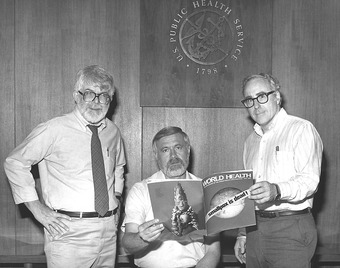
Directors of Global Smallpox Eradication Program
Three former directors of the Global Smallpox Eradication Program read the news that smallpox had been globally eradicated in 1980.
19.1.6: Women in Medicine
Historically and in many parts of the world, women’s participation in the profession of medicine has been significantly restricted.
Learning Objective
Analyze the role women play in the medical field and how gender parity affects women’s choices when it comes to medicine
Key Points
- Women’s informal practice of medicine in the role of caregivers and in the allied health professions has been widespread.
- The practice of medicine remains disproportionately male overall. In industrialized nations, the recent parity in gender of medical students has not yet trickled into parity in practice.
- Most countries now guarantee equal access by women to medical education. However, not all ensure equal employment opportunities, and gender parity has yet to be achieved within the medical specialties around the world.
Key Term
- parity
-
Equality; comparability of strength or intensity.
Example
- In the 21st century, women continue to dominate in nursing. In 2000, 94.6% of registered nurses in the United States were women.
The Role of Women in Medicine
Historically and in many parts of the world, women’s participation in medicine (as physicians, for instance) has been significantly restricted, although women’s informal practice of medicine in the role of caregivers and in the allied health professions has been widespread. Most countries of the world now guarantee equal access by women to medical education, although not all ensure equal employment opportunities. Gender parity has yet to be achieved within the medical specialties around the world.
At the beginning of the twenty-first century in industrialized nations, women have made significant gains, but have yet to achieve parity throughout the medical profession. Women’s participation in medical professions was limited by law and practice during the decades while medicine was professionalizing. However, women kept practicing medicine in the allied health fields (nursing, midwifery), making significant gains in medical education and medical work during the 19th and 20th centuries. Women continue to dominate nursing in the 20th century. In 2000, 94.6% of registered nurses in the United States were women.
The practice of medicine remains disproportionately male overall. In some industrialized nations, women have achieved parity in medical school. Since 2003, women have formed the majority of the U.S. medical student body. However, they have yet to achieve parity in practice. In many developing nations, neither medical school nor practice approach gender parity. Moreover, there are skews within the medical profession. For example, some medical specialties like surgery are significantly male-dominated, while other specialties are or becoming significantly female-dominated.
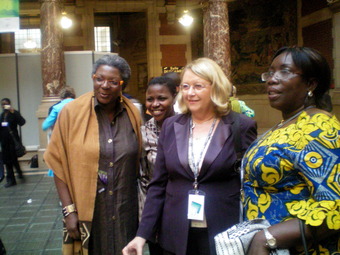
Monique Frize, née Aubry (born 1942) is a Canadian academic and biomedical engineer known for her expertise in medical instrumentation and decision-support systems
At the beginning of the 21st century, women in industrialized nations have made significant gains, but have yet to achieve parity throughout the medical profession. In some industrialized countries, women have achieved parity in medical school. Women have formed the majority of the United States medical student body since 2003. In 2007-2008, women accounted for 49% of medical school applicants and 48.3% of those accepted. According to the American Association of Medical Colleges (AAMC) 48.3% (16,838) of medical degrees awarded in the US in 2009-10 were earned by women, an increase from 26.8% in 1982-3.
19.2: Sociological Perspectives on Health and Illness
19.2.1: The Functionalist Perspective
In the functionalist model, Parsons argued that illness is a form of deviance that disturbs the social function of a society.
Learning Objective
Discuss the functionalist perspective on illness in society, specifically the role the sick play in a specific society and how that role affects others
Key Points
- Functionalism addresses society as a whole in terms of the function of its constituent elements (namely norms, customs, traditions, and institutions), much like the interacting organs within the human body.
- Prominent functionalist theorists include Auguste Comte, Herbert Spencer, Talcott Parsons, Kingsley Davis and Wilbert E. Moore, Robert Merton, and Gabriel Almond and Bingham Powell.
- Functionalism is a framework that sees society as a complex system whose parts work together to promote solidarity and stability.
- Functionalists argue that a sick individual is not a productive member of society; therefore this deviance needs to be policed. This is the role of the medical profession.
- Structural functionalism reached the peak of its influence in the 1940s and 1950s, and by the 1960s was in rapid decline, replaced by conflict-oriented approaches in Europe and more recently by structuralism.
Key Terms
- structuralism
-
A theory of sociology that views elements of society as part of a cohesive, self-supporting structure.
- deviance
-
Actions or behaviors that violate formal and informal cultural norms, such as laws or the norm that discourages public nose-picking.
Example
- Alzheimer’s disease is considered to affect most of the elderly population. In their Sick Role, people with this disease are not at fault for their sickness and are remove from responsibility of their social roles and need to be taken care of in the daily basis.
Structural functionalism, or simply functionalism, is a framework for building theory that sees society as a complex system whose parts work together to promote solidarity and stability. This approach looks at society through a macro-level orientation, which is a broad focus on the social structures that shape society as a whole. This approach looks at both social structure and social functions. Prominent functionalist theorists include Auguste Comte, Herbert Spencer , Talcott Parsons, Kingsley Davis and Wilbert E. Moore, Robert Merton, and Gabriel Almond and Bingham Powell.
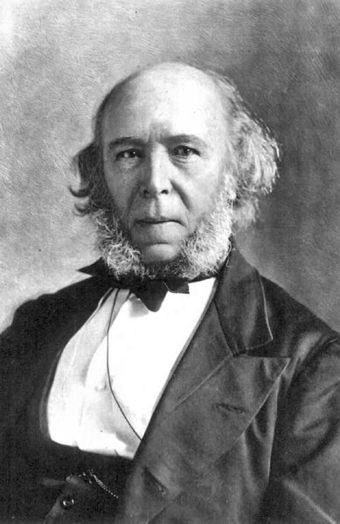
Herbert Spencer
Herbert Spencer was a prominent functionalist sociologist, who likened the functioning parts of society as organs within a body.
Functionalism addresses society as a whole in terms of the function of its constituent elements; namely norms, customs, traditions, and institutions. A common analogy, popularized by Herbert Spencer, presents these parts of society as “organs” that work toward the proper functioning of the “body” as a whole. For Talcott Parsons (1902–1979), an American sociologist, “structural-functionalism” came to describe a particular stage in the methodological development of social science, rather than a specific school of thought.
The Sick Role
Sick role is a term used in medical sociology regarding sickness and the rights and obligations of the affected. It is a concept created by the American sociologist Talcott Parsons in 1951. Parsons was a functionalist sociologist who argued that being sick means that the sufferer enters a role of “sanctioned deviance”. This is because, from a functionalist perspective, a sick individual is not a productive member of society. Therefore this deviance needs to be policed, which is the role of the medical profession.
In the functionalist model, Parsons argued that the best way to understand illness sociologically is to view it as a form of deviance that disturbs the social function of the society. The general idea is that the individual who has fallen ill is not only physically sick, but now adheres to the specifically patterned social role of being sick. “Being Sick” is not simply a “condition”; it contains within itself customary rights and obligations based on the social norms that surround it.
The theory outlined two rights of a sick person and two obligations. The sick person’s rights are twofold: the first one is being exempt from normal social roles; the second one is not being responsible for their condition. Conversely, the sick person’s obligations included trying to get well and cooperating with the medical professionals. Parsons concluded that there are three versions of the sick role: conditional, unconditional legitimate, and illegitimate (a condition stigmatized by others).
Critics of the Functionalist Perspective
Critics of Parsons and the functionalist perspective point to different flaws they see with his argument. The model assumes that the individual voluntarily accepts the sick role. It also assumes that the individual may not comply with expectations of the sick role, may not give up social obligations, may resist dependency, and may avoid the public sick role if their illness is stigmatized. The model also blames the sick, where “rights” do not always apply.
Structural functionalism reached the peak of its influence in the 1940s and 1950s, and by the 1960s was in rapid decline. By the 1980s, its place was taken in Europe by more conflict-oriented approaches, and more recently by “structuralism”. While some of the critical approaches also gained popularity in the United States, the mainstream of the discipline has instead shifted to a myriad of empirically-oriented middle-range theories with no overarching theoretical orientation. To most sociologists, functionalism is now obsolete.
19.2.2: The Conflict Perspective
Conflict theory argues that the economic and political structures of a society create social divisions, inequalities, and conflicts.
Learning Objective
Examine the differing views on conflict theory from various sociologists, such as Karl Marx and C. Wright Mills
Key Points
- Conflict theories are perspectives in social science that emphasize the social, political, or material inequality of a social group.
- Of the classical founders of social science, conflict theory is most commonly associated with Karl Marx, who posited that capitalism would inevitably produce internal tensions leading to its own destruction.
- Marx advocated for the rejection of false consciousness (explanations of social problems as the shortcomings of individuals rather than the flaws of society) and the claiming of class consciousness (workers’ recognition of themselves as a class unified in opposition to the capitalist system).
- The Polish-Austrian sociologist Ludwig Gumplowicz and the American sociologist Lester F. Ward approached conflict from a comprehensive anthropological and evolutionary point-of-view.
- C. Wright Mills has been called the founder of modern conflict theory. In Mills’s view, social structures are created through conflict between people with differing interests and resources.
- Conflict theory is most often associated with Marxism, but may also be associated with other perspectives such as critical theory, feminist theory, postmodern theory, queer theory, and race-conflict theory.
Key Terms
- functionalism
-
Structural functionalism, or simply functionalism, is a framework for building theory that sees society as a complex system whose parts work together to promote solidarity and stability.
- military-industrial complex
-
The armed forces of a nation together with the industries that supply their weapons and materiel.
- capitalism
-
A socio-economic system based on private property rights, including the private ownership of resources or capital, with economic decisions made largely through the operation of a market unregulated by the state.
Example
- In the United States people within the upper and middle class have access to private and full healthcare coverage whereas, for the most part, most of the Americans have no healthcare. According to the US Census Bureau, in 2007, 45.7 million people in the U.S. (15.3% of the population) were without health insurance for at least part of the year. This number was down slightly from the previous year, with nearly 3 million more people receiving government coverage and a slightly lower percentage covered under private plans than the year previous. There is a class conflict and within access to healthcare.
Conflict theories are perspectives in social science that emphasize the social, political, or material inequality of a social group, that critique the broad socio-political system, or that otherwise detract from structural functionalism and ideological conservatism. Sociologists in the tradition of conflict theory argue that the economic and political structures of a society create social divisions, classes, hierarchies, antagonisms and conflicts that produce and reproduce inequalities. Certain conflict theories set out to highlight the ideological aspects inherent in traditional thought. While many of these perspectives hold parallels, conflict theory does not refer to a unified school of thought, and should not be confused with, for instance, peace and conflict studies.
Of the classical founders of social science, conflict theory is most commonly associated with Karl Marx (1818–1883) . Based on a dialectical materialist account of history, Marxism posited that capitalism, like previous socioeconomic systems, would inevitably produce internal tensions leading to its own destruction. Marx ushered in radical change, advocating proletarian revolution and freedom from the ruling classes. At the same time, Karl Marx was aware that most of the people living in capitalist societies did not see how the system shaped the entire operation of society. Just like how we see private property, or the right to pass that property onto our children as natural, many of members in capitalistic societies see the rich as having earned their wealth through hard work and education, while seeing the poor as lacking in skill and initiative. Marx rejected this type of thinking and termed it false consciousness, which involves explanations of social problems as the shortcomings of individuals rather than the flaws of society. Marx wanted to replace this kind of thinking with something Engels termed class consciousness, which is when workers recognize themselves as a class unified in opposition to capitalists and ultimately to the capitalist system itself. In general, Marx wanted the working class to rise up against the capitalists and overthrow the capitalist system .
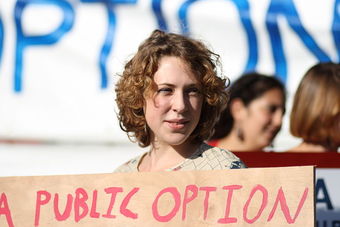
Healthcare reform supporter
Karl Marx wanted to replace false consciousness with class consciousness, in which the working class would rise up against the capitalist system.
Two early conflict theorists were the Polish-Austrian sociologist and political theorist Ludwig Gumplowicz (1838–1909) and the American sociologist and paleontologist Lester F. Ward (1841–1913). Although Ward and Gumplowicz developed their theories independently, they had much in common and approached conflict from a comprehensive anthropological and evolutionary point-of-view as opposed to Marx’s rather exclusive focus on economic factors.
C. Wright Mills has been called the founder of modern conflict theory. In Mills’s view, social structures are created through conflict between people with differing interests and resources. Individuals and resources, in turn, are influenced by these structures and by the “unequal distribution of power and resources in the society. ” Mills argued that the interests of the power elite of American society (for example, the military-industrial complex) were opposed to those of the people. He theorized that the policies of the power elite would result in the “increased escalation of conflict, production of weapons of mass destruction, and possibly the annihilation of the human race. “
Conflict theory is most commonly associated with Marxism, but as a reaction to functionalism and the positivist method, it may also be associated with a number of other perspectives, including critical theory, feminist theory, postmodern theory, post-structural theory, postcolonial theory, queer theory, world systems theory, and race-conflict theory.
19.2.3: The Interactionist Perspective
According to theorists working in the symbolic interactionist perspective, health and illness are socially constructed.
Learning Objective
Explain and give examples of social constructions of health according to the symbolic interactionist perspective
Key Points
- Symbolic interactionist researchers investigate how people create meaning during social interaction, how they present and construct the self, and how they define situations of co-presence with others.
- Constructivist grounded theory emphasizes the development of an interactive relationship and mutual construction of knowledge between researcher and participants.
- Medicalization of deviance refers to the process that changes “bad” behavior into “sick” behavior.
- Demedicalization refers to the process when “sick” behavior is normalized again.
Key Terms
- symbolic interactionist
-
Symbolic interactionist researchers investigate how people create meaning during social interaction, how they present and construct the self, and how they define situations of co-presence with others.
- medicalization of deviance
-
The medicalization of deviance refers to the process that changes “bad” behavior into “sick” behavior.
- demedicalization
-
Demedicalization refers to the process when “sick” behavior is normalized again.
Example
- An example of medicalization is illustrated by the history of how our society views alcohol and alcoholism. During the 19th century, people who drank too much were considered bad, lazy people. They were called drunks, and it was not uncommon for them to be arrested or run out of a town.
According to theorists working in the symbolic interactionist perspective, health and illness are socially constructed. Symbolic interactionist researchers investigate how people create meaning during social interaction, how they present and construct the self (or “identity”), and how they define situations of co-presence with others. One of the perspective’s central ideas is that people act as they do because of how they define situations.
Constructivist grounded theory emphasizes the development of an interactive relationship and mutual construction of knowledge between researcher and participants. Symbolic interactionists believe that objects have meaning only through people’s interactions with them in the environment, that the meanings people have for things develops through social interaction and that those meanings are handled and modified by a constant and ongoing interpretive process by individuals.
An example of the social construction of health the the Rate of Perceived Exertion, or RPE. This scale measures the intensity of a person’s workout on a scale of 0 to 10. This scale was developed by Gunnar Borg, and it is used by medical professionals to assess a person’s health in a variety of ways.
In essence, interactionists focus on the specific meanings and causes people attribute to illness. The term “medicalization” of deviance” refers to the process that changes “bad” behavior into “sick” behavior. A related process is “demedicalization”, in which “sick” behavior is normalized again. Medicalization and demedicalization affect who responds to the patient, how people respond to the patient, and how people view the personal responsibility of the patient.
An example of medicalization is illustrated by the history of how our society views alcohol and alcoholism. During the 19th century, people who drank too much were considered “bad, lazy people. ” They were called drunks, and it was not uncommon for them to be arrested or run out of a town. Drunks were not treated in a sympathetic way because, at that time, it was thought that it was their own fault that they could not stop drinking . During the latter half of the 20th century, however, people who drank too much were increasingly defined as people with a disease or a genetic predisposition to addiction. With alcoholism defined as a disease and not a personal choice, alcoholics came to be viewed with more compassion and understanding. Thus, “badness” was transformed into “sickness”.
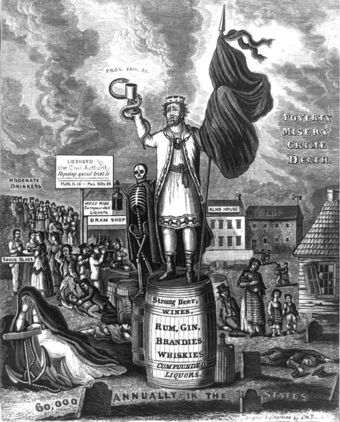
Alcoholism
In this engraving from the 19th century, “King Alcohol” is shown with a skeleton on a barrel of alcohol. The words “poverty,” “misery,” “crime,” and “death” hang in the air behind him.
While interactionism does acknowledge the subjective nature of diagnosis, it is important to remember who benefits the most when a behavior becomes defined as illness. Pharmaceutical companies make billions of dollars treating illnesses such as fatigue, insomnia, and hyperactivity that may not actually be illnesses in need of treatment, but opportunities for companies to make more money.
19.2.4: The Labeling Approach
The labeling approach to health and illness claims that mental illness is manifested solely as a result of societal influence.
Learning Objective
Analyze the pros and cons of labeling theory, especially the implications it has for the “mentally ill” and HIV/AIDS patients
Key Points
- Developed by sociologists during the 1960s, labeling theory holds that deviance is not inherent to an act. The theory focuses on the tendency of majorities to negatively label minorities or those seen as deviant from standard cultural norms.
- The social construction of deviant behavior plays an important role in the labeling process that occurs in society.
- Labeling theory was first applied to the term “mentally ill” in 1966 when Thomas J. Scheff published Being Mentally Ill. Scheff challenged common perceptions of mental illness by claiming that mental illness is manifested solely as a result of societal influence.
- Hard labeling refers to those who argue that mental illness does not exist. They note the slight deviance from the norms of society that cause people to believe in mental illness.
- Soft labeling refers to people who believe that mental illnesses do, in fact, exist. Unlike the supporters of hard labeling, soft labeling supporters believe that mental illnesses are not entirely socially constructed.
Key Terms
- deviance
-
Actions or behaviors that violate formal and informal cultural norms, such as laws or the norm that discourages public nose-picking.
- social construction
-
A concept or practice that is the construct (or artifact) of a particular group, meaning that the concept or practice is understood differently by various groups and institutions.
- self-fulfilling prophecy
-
a prediction that, by being voiced, causes itself to come true
Example
- The label of “mentally ill” may help a person seek help, for example psychotherapy or medication. Labels, while they can be stigmatizing, can also lead those who bear them down the road to proper treatment and recovery.
Labeling Theory on Health and Illness
Labeling theory is closely related to social-construction and symbolic-interaction analysis. Developed by sociologists during the 1960s, labeling theory holds that deviance is not inherent to an act. The theory focuses on the tendency of majorities to negatively label minorities or those seen as deviant from standard cultural norms. The theory is concerned with how the self-identity and behavior of individuals may be determined or influenced by the terms used to describe or classify them. It is associated with the concepts of self-fulfilling prophecy and stereotyping .
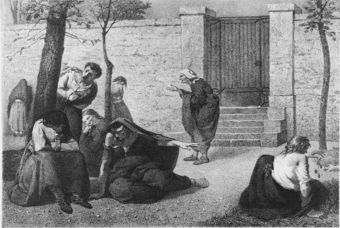
1857 Lithograph by Armand Gautier
Shows personifications of dementia, megalomania, acute mania, melancholia, idiocy, hallucination, erotic mania and paralysis in the gardens of the Hospice de la Salpêtrière. A mental disorder or mental illness is a psychological pattern, potentially reflected in behavior, that is generally associated with distress or disability, and which is not considered part of normal development of a person’s culture.
The social construction of deviant behavior plays an important role in the labeling process that occurs in society. This process involves not only the labeling of criminally deviant behavior—behavior that does not fit socially constructed norms—but also labeling that reflects stereotyped or stigmatized behavior of the “mentally ill.” Hard labeling refers to those who argue that mental illness does not exist; it is merely deviance from the norms of society that cause people to believe in mental illness. Mental illnesses are socially constructed illnesses and psychotic disorders do not exist. Soft labeling refers to people who believe that mental illnesses do, in fact, exist, and are not entirely socially constructed.
Labeling theory was first applied to the term “mentally ill” in 1966 when Thomas J. Scheff published Being Mentally Ill. Scheff challenged common perceptions of mental illness by claiming that mental illness is manifested solely as a result of societal influence. He argued that society views certain actions as deviant. In order to come to terms with and understand these actions, society often places the label of mental illness on those who exhibit them. Certain expectations are placed on these individuals and, over time, they unconsciously change their behavior to fulfill them. Criteria for different mental illnesses, he believed, are not consistently fulfilled by those who are diagnosed with them because all of these people suffer from the same disorder. Criteria are simply fulfilled because the “mentally ill” believe they are supposed to act a certain way—over time, they come to do so.
Another issue involving labeling was the rise of HIV/AIDS cases among gay men in the 1980s. HIV/AIDS was labeled a disease of the homosexual and further pushed people into believing homosexuality was deviant. Even today, some people believe contracting HIV/AIDS is punishment for deviant and inappropriate sexual behaviors.
Labels, while they can be stigmatizing, can also lead those who bear them down the road to proper treatment and recovery. The label of “mentally ill” may help a person seek help, such as psychotherapy or medication. If one believes that being “mentally ill” is more than just believing one should fulfill a set of diagnostic criteria, then one would probably also agree that there are some who are labeled “mentally ill” who need help. It has been claimed that this could not happen if society did not have a way to categorize them, although there are actually plenty of approaches to these phenomena that don’t use categorical classifications and diagnostic terms (for example, spectrum or continuum models). Here, people vary along different dimensions, and everyone falls at different points on each dimension.
19.3: Social Epidemiology and Health
19.3.1: Social Epidemiology and Health
Social epidemiology studies the social distribution and social determinants of health.
Learning Objective
Discuss epidemiolgy and its impact on American health care, as well as its beginnings based on Durkheim’s work on suicide
Key Points
- Epidemiology is the study (or the science of the study) of the patterns, causes, and effects of health and disease conditions in defined populations.
- Social epidemiology is defined as “the branch of epidemiology that studies the social distribution and social determinants of health”; or in other words, “both specific features of, and pathways by which, societal conditions affect health”.
- Social epidemiologists generally use social concepts in order to explain patterns of health in the population.
- The roots of social epidemiology go back to the work of Emile Durkheim on suicide, where he explored the differing suicide rates between Protestants and Catholics.
- Use of multilevel models (also known as hierarchical and mixed effects models) involves focusing on both individual-level measures and emergent social properties that have no correlation at the individual level.
Key Terms
- Emile Durkheim
-
David Émile Durkheim (April 15, 1858 – November 15, 1917) was a French sociologist. He formally established the academic discipline and, with Karl Marx and Max Weber, is commonly cited as the principal architect of modern social science and father of sociology.
- Social epidemiology
-
Social epidemiology is defined as “the branch of epidemiology that studies the social distribution and social determinants of health,” that is, “both specific features of, and pathways by which, societal conditions affect health. “
- Multilevel Models
-
Multilevel models are statistical models of parameters that vary at more than one level. These models can be seen as generalizations of linear models (in particular, linear regression), although they can also extend to non-linear models.
Example
- A social epidemiological study can be conducted when a sociologist in the field identifies a cancer cluster around a particular area. Social epidemiologists can help understand the original causes of the cancer cluster by collecting information about the affected people while working with other medical professionals. In this way, the epidemiological study can help point out the health hazard variables that are affecting the cancer cluster.
Epidemiology
Epidemiology is the study (or the science of the study) of the patterns, causes, and effects of health and disease conditions in defined populations. It is the cornerstone of public health, and informs policy decisions and evidence-based medicine by identifying risk factors for disease and targets for preventive medicine. Epidemiologists help with study design, collection and statistical analysis of data, and interpretation and dissemination of results (including peer review and occasional systematic review). Epidemiology has helped develop methodology used in clinical research, public health studies and, to a lesser extent, basic research in the biological sciences.
Major areas of epidemiological study include disease etiology, outbreak investigation, disease surveillance and screening, biomonitoring, and comparisons of treatment effects such as in clinical trials. Epidemiologists rely on other scientific disciplines like biology to better understand disease processes, statistics to make efficient use of the data and draw appropriate conclusions, social sciences to better understand proximate and distal causes, and engineering for exposure assessment.
Social Epidemiology
Social epidemiology is defined as “the branch of epidemiology that studies the social distribution and social determinants of health”; or in other words, “both specific features of, and pathways by which, societal conditions affect health” (Krieger, 2001). The roots of social epidemiology go back Emile Durkheim’s work on suicide .
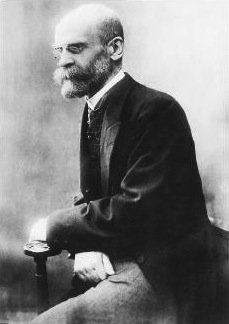
Émile Durkheim
Durkheim formally established the academic discipline and, with Karl Marx and Max Weber, is commonly cited as the principal architect of modern social science and father of sociology.
In Suicide (1897), Durkheim explores the differing suicide rates between Protestants and Catholics, arguing that stronger social control among Catholics results in lower suicide rates. According to Durkheim, Catholic society has normal levels of integration while Protestant society has low levels. Overall, Durkheim treated suicide as a social fact, explaining variations in its rate on a macro level, considering society-scale phenomena such as a lack of connections between people (group attachment) and a lack of regulations of behavior, rather than the feelings and motivations of individuals. Despite its limitations, Durkheim’s work on suicide has influenced proponents of control theory, and is often mentioned as a classic sociological study. The book pioneered modern social research and served to distinguish social science from psychology and political philosophy.
Social epidemiology may focus on individual-level measures, or on emergent social properties that have no correlation at the individual level. Simultaneous analysis at both levels may even be warranted. Use of such multilevel models is also known as hierarchical and mixed effects models. Social epidemiology overlaps with fields in the social sciences, such as medical anthropology, medical sociology, and medical geography. However, these fields often use health and disease in order to explain specifically social phenomenon (such as the growth of lay health advocacy movements), while social epidemiologists generally use social concepts in order to explain patterns of health in the population.
19.4: Health Care in the U.S.
19.4.1: Health Care in the U.S.
Healthcare in the United States is provided by separate legal entities, often private facilities with governmental insurance for citizens.
Learning Objective
Outline the problems with American health care, primarily due to privatization
Key Points
- Healthcare facilities are largely owned and operated by the private sector.
- The United States is alone among developed nations with the notable absence of a universal healthcare system.
- Publicly-funded insurance is provided to the public through programs, such as Medicare, Medicaid, TRICARE, the Children’s Health Insurance Program, and the Veterans Health Administration.
- Active debate about healthcare reform in the United States concerns questions of a right to healthcare, access, fairness, efficiency, cost, choice, value, and quality.
- Many of the uninsured are the working poor or are unemployed. Although some are healthy and choose to go without it, others have been rejected by insurance companies and are considered “uninsurable”.
Key Terms
- private insurance
-
Private insurance refers to health insurance provided by a non-governmental organization, usually a privately owned or publicly traded corporation.
- the Children’s Health Insurance Program
-
The Children’s Health Insurance Program (CHIP) is a program administered by the United States Department of Health and Human Services that provides matching funds to states for health insurance to families with children. The program was designed to cover uninsured children in families with incomes that are modest but too high to qualify for Medicaid.
- TRICARE
-
is a health care program of the United States Department of Defense Military Health System. TRICARE provides civilian health benefits for military personnel, military retirees, and their dependents, including some members of the Reserve Component.
Examples
- Most Americans under age 65 (59.3%) receive their health insurance coverage through an employer (which includes both private, as well as civilian public-sector employers) under group coverage, although this percentage is declining.
- Most Americans under age 65 (59.3%) receive their health insurance coverage through an employer (which includes both private as well as civilian public-sector employers) under group coverage, although this percentage is declining.
Healthcare in the United States is provided by many separate legal entities. Healthcare facilities are largely owned and operated by the private sector. Health insurance is now primarily provided by the government in the public sector, with 60-65% of healthcare provision and spending coming from programs, such as Medicare, Medicaid, TRICARE, the Children’s Health Insurance Program, and the Veterans Health Administration.
The United States is alone among developed nations with the notable absence of a universal healthcare system. Current estimates put U.S. healthcare spending at approximately 16% of GDP, second highest to East Timor (Timor-Leste) among all United Nations member nations. The U.S. system is primarily one of private insurance, with governmental insurance provided for citizens on the healthcare fringe. Insurance is provided by large-risk bearing corporate entities, which organize healthcare delivery by negotiating pricing and services with provider (physicians and hospitals) organizations. Most Americans under age 65 (59.3%) receive their health insurance coverage through an employer (which includes both private, as well as civilian public-sector employers) under group coverage, although this percentage is declining.
Debates about Healthcare in the United States
Active debate about healthcare reform in the United States concerns questions of a right to health care, access, fairness, efficiency, cost, choice, value, and quality. Some have argued that the system does not deliver equivalent value for the money spent. The United States pays twice as much, yet lags behind other wealthy nations in such measures as infant mortality and life expectancy. Currently, the United States has a higher infant mortality rate than most of the world’s industrialized nations. Around 84.7% of Americans have some form of health insurance; either through their employer or the employer of their spouse or parent (59.3%), purchased individually (8.9%), or provided by government programs (27.8%; there is some overlap in these figures).
Furthermore, the number of persons without health insurance coverage in the United States is one of the primary concerns raised by advocates of healthcare reform. According to the United States Census Bureau, in 2009, there were 50.7 million people in the United States (16.7% of the population) who were without health insurance. Some Americans who do not qualify for government-provided health insurance are not provided health insurance by an employer, and are unable to afford, cannot qualify for, or choose not to purchase private health insurance. Many of the uninsured are the working poor or are unemployed. Although some are healthy and choose to go without it, others have been rejected by insurance companies and are considered “uninsurable. “

U.S. Uninsured in 2007, by income.
This image shows the income distribution of Americans who did not have health insurance coverage in 2007. The data comes from the U.S. Census Bureau’s Current Population Survey in 2008 and the 2009 Annual Social and Economic Supplements–-available here (page 21).
19.4.2: Physicians, Nurses, and Patients
The interactions between physicians, nurses, and patients are central to healthcare.
Learning Objective
Evaluate the importance of positive interactions between physicians, nurses and patients, in terms of satisfaction with health care services
Key Points
- Physicians in the United States include both physicians trained by medical education in the United States, and physicians that are international medical graduates who have progressed through the necessary steps to acquire a medical license to practice in a state.
- Patient’s satisfaction is favored by a good doctor-patient relationship.
- Nursing is a healthcare profession focused on the care of individuals, families, and communities so they may attain, maintain, or recover optimal health and quality of life.
Key Terms
- medical education
-
Medical education is education related to the practice of being a medical practitioner, either the initial training to become a doctor (i.e., medical school and internship), additional training thereafter (e.g., residency and fellowship), or Physician Assistant education.
- doctor-patient relationship
-
The doctor-patient relationship is central to the practice of healthcare and is essential for the delivery of high-quality health care in the diagnosis and treatment of disease.
- patient’s satisfaction
-
Patients’ satisfaction with an encounter with health care service is mainly dependent on the duration and efficiency of care, and how empathetic and communicable the health care providers are.
Example
- The patient is most often ill or injured and in need of treatment by a physician, advanced practice registered nurse, or other health care provider.
Physicians
A physician is a health care provider who practices the profession of medicine, which is concerned with promoting, maintaining or restoring human health through the study, diagnosis, and treatment of disease, injury and other physical and mental impairments. They may focus their practice on certain disease categories, types of patients, or methods of treatment; such physicians are known as specialist medical practitioners. They may also assume responsibility for the provision of continuing comprehensive medical care to individuals, families and communities; these physicians are known as general practitioners.
Medical practice properly requires both a detailed knowledge of the academic disciplines (such as anatomy and physiology) underlying diseases and their treatment, and also a decent competence in its applied practice. Physicians in the United States include both physicians trained by medical education in the United States, and physicians that are international medical graduates who have progressed through the necessary steps to acquire a medical license to practice in a state. The U.S. physicians are an important part of the health care in the United States. Currently, the American College of Physicians uses the term physician to describe all medical practitioners holding a professional medical degree.
Nurses
Nursing is a healthcare profession focused on the care of individuals, families, and communities so they may attain, maintain, or recover optimal health and quality of life. There are a number of educational paths to becoming a professional nurse, which vary greatly worldwide, but all involve extensive study of nursing theory and practice, and training in clinical skills. Nursing Science is a field of knowledge based on the contributions of nursing scientists through peer-reviewed scholarly journals and evidenced-based practice. Nurses care for individuals of all ages and cultural backgrounds, who are healthy and ill, in a holistic manner based on the individual’s physical, emotional, psychological, intellectual, social, and spiritual needs. The profession combines physical science, social science, nursing theory, and technology in caring for those individuals.
Patients
A patient is any recipient of health care services. The patient is most often ill or injured and in need of treatment by a physician, advanced practice registered nurse, or other health care provider. Patients’ satisfaction with an encounter with health care service is mainly dependent on the duration and efficiency of care, and how empathetic and communicable the health care providers are. It is favored by a good doctor-patient relationship. Also, patients that are well informed of the necessary procedures in a clinical encounter, and the time it is expected to take, are generally more satisfied even if there is a longer waiting time.

A Doctor Performs a Cataract Surgery
A local doctor performs a cataract surgery on a patient at Zamboanga Medical Center during the U.S. Military Sealift Command (MSC) hospital ship, USNS Mercy (T-AH 19) visit to the city on a scheduled humanitarian visit.
19.4.3: Alternatives to Traditional Health Care
Alternative medicine is any practice claiming to heal “that does not fall within the realm of conventional medicine.”
Learning Objective
Break down the various types of alternative medicine and how they fit into the health care system
Key Points
- Alternative medicine is frequently grouped with complementary medicine or integrative medicine, which, in general, refers to the same interventions when used in conjunction with mainstream techniques, under the umbrella term complementary and alternative medicine, or CAM.
- Whole medical systems cut across more than one of the other groups; examples include traditional Chinese medicine, naturopathy, homeopathy, and Ayurveda.
- Mind-body medicine takes a holistic approach to health that explores the interconnection between the mind, body, and spirit.
- Biology-based practices use substances found in nature such as herbs, foods, vitamins, and other natural substances.
- Manipulative and body-based practices feature manipulation or movement of body parts, such as is done in chiropractic and osteopathic manipulation.
- Integrative medicine is the combination of the practices and methods of alternative/complementary medicine with conventional medicine.
Key Terms
- integrative medicine
-
Integrative medicine is the combination of the practices and methods of alternative/complementary medicine with conventional medicine. It may include preventive medicine and patient-centered medicine.
- manipulative and body-based practices
-
Manipulative and body-based practices feature manipulation or movement of body parts, such as is done in chiropractic and osteopathic manipulation.
- mind-body medicine
-
Mind-body medicine takes a holistic approach to health that explores the interconnection between the mind, body, and spirit.
Example
- Whole medical systems cut across more than one of the other groups; examples include traditional Chinese medicine, naturopathy, homeopathy, and Ayurveda. Mind-body medicine takes a holistic approach to health that explores the interconnection between the mind, body, and spirit.
Non-Conventional and Conventional Medicine
Alternative medicine methods are diverse in their foundations and methodologies, and they may be based on historical or cultural traditions, rather than on scientific evidence. Methods may incorporate or base themselves on traditional medicine, folk knowledge, spiritual beliefs, or newly conceived approaches to healing. Alternative medicine is frequently grouped with complementary medicine or integrative medicine, which, in general, refers to the same interventions when used in conjunction with mainstream techniques, under the umbrella term complementary and alternative medicine, or CAM.
There is no clear and consistent definition for either alternative or complementary medicine. In Western culture, it is often defined as any healing practice “that does not fall within the realm of conventional medicine,” or “that which has not been shown consistently to be effective. ” There is a debate among medical researchers over whether any therapy may be properly classified as “alternative medicine. ” Some claim that there is only medicine that has been adequately tested and that which has not. They feel that healthcare practices should be classified based solely on scientific evidence.
The U.S. National Center for Complementary and Alternative Medicine (NCCAM) has developed one of the most widely used classification systems for the branches of complementary and alternative medicine. It classifies complementary and alternative therapies into five major groups, which have some overlap. Whole medical systems cut across more than one of the other groups; examples include traditional Chinese medicine, naturopathy, homeopathy, and Ayurveda. Mind-body medicine takes a holistic approach to health that explores the interconnection between the mind, body, and spirit. Biology-based practices use substances found in nature, such as herbs, foods, vitamins, and other natural substances. Manipulative and body-based practices feature manipulation or movement of body parts, such as is done in chiropractic and osteopathic manipulation.
Integrative medicine is the combination of the practices and methods of alternative/complementary medicine with conventional medicine. It may include preventive medicine and patient-centered medicine. It may also include practices not normally referred to as medicine, such as using prayer, meditation, socializing, and recreation as therapies. Its academic proponents sometimes recommend misleading patients by using known placebo treatments in order to achieve a placebo effect.

Medicinal Herbs
Medicinal herbs in a traditional Spanish market
19.4.4: The Role of Government
Publicly funded health care is a form of healthcare financing designed to meet the cost of healthcare needs from a publicly managed fund.
Learning Objective
Analyze the role of the government in the provision of health care
Key Points
- Most developed countries, with the exception of the United States, have partially or fully, publicly funded health systems.
- Publicly funded healthcare systems are usually financed in one of two ways: through taxation or via compulsory national health insurance.
- In compulsory insurance models, healthcare is financed from some combination of employees’ salary deductions, employers’ contributions, and possibly additional state funds. Insurance may cover other benefits, as well as health.
- When taxation is the primary means of financing healthcare, all eligible people receive the same level of cover regardless of their financial circumstances or risk factors.
- Most western industrial countries have a system of social insurance based on the principle of social solidarity covers eligible people from bearing the direct burden of most healthcare expenditure, funded by taxation during their working life.
- A range of measures, such as better payment methods, has improved the microeconomic incentives facing healthcare providers.
Key Terms
- Publicly funded health care
-
Publicly funded healthcare is a form of healthcare financing designed to meet the cost of all or most healthcare needs from a publicly managed fund.
- compulsory insurance models
-
In compulsory insurance models, healthcare is financed from some combination of employees’ salary deductions, employers’ contributions, and possibly additional state funds. Insurance may cover other benefits as well as health.
- social solidarity
-
Most western industrial countries have a system of social insurance based on the principle of social solidarity covers eligible people from bearing the direct burden of most healthcare expenditure, funded by taxation during their working life.
Example
- Most developed countries, with the exception of the United States, have partially or fully publicly funded health systems.
Government and Healthcare
Publicly funded health care is a form of healthcare financing designed to meet the cost of all or most healthcare needs from a publicly managed fund. The fund may be a not-for-profit trust, which pays out for health care according to common rules established by the members or by some other democratic form. In some countries, the fund is controlled directly by the government or by an agency of the government for the benefit of the entire population. This distinguishes it from other forms of private medical insurance. In the private model, the rights of access are subject to contractual obligations between an insurer and an insurance company. The latter seeks to make a profit by managing the flow of funds between funders and providers of health care services.
Publicly funded healthcare systems are usually financed in one of two ways: through taxation or via compulsory national health insurance. In compulsory insurance models, healthcare is financed from some combination of employees’ salary deductions, employers’ contributions, and possibly additional state funds. Insurance may cover other benefits as well as health. When taxation is the primary means of financing healthcare, all eligible people receive the same level of cover regardless of their financial circumstances or risk factors.
Most developed countries, with the exception of the United States, have partially or fully publicly funded health systems. Most western industrial countries have a system of social insurance based on the principle of social solidarity covers eligible people from bearing the direct burden of most healthcare expenditure, funded by taxation during their working life. Many OECD countries have implemented reforms to achieve policy goals of ensuring access to healthcare, improving the quality of healthcare and health outcomes, allocating an appropriate level of public sector other resources to healthcare, while at the same time ensuring that services are provided in a cost-efficient and cost-effective manner (microeconomic efficiency). A range of measures, such as better payment methods, has improved the microeconomic incentives facing providers. However, introducing improved incentives through a more competitive environment among providers and insurers has proved difficult.
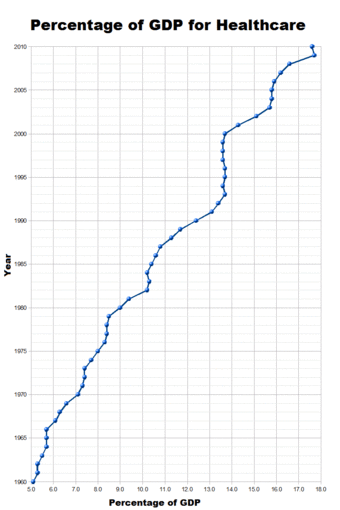
Health Costs USA GDP
Total U.S. healthcare spending from 1960 to 2007 by percent of GDP (gross domestic product)
19.5: Modern Issues in Health Care
19.5.1: Colonialism and the Spread of Diseases
European colonization contributed to the spread of disease worldwide.
Learning Objective
Summarize the impact of European colonialism on the spread of infectious disease and beginnings of disease control
Key Points
- Colonialism is the policy or practice of acquiring full or partial political control over another country, occupying it with settlers, and exploiting it economically.
- Encounters between explorers and populations in the rest of the world often introduced new diseases, which sometimes caused local epidemics of extraordinary virulence.
- Trade routes and new world conquests devastated indigenous populations, as they were exposed to new pathogens and newly domesticated animals.
- The leading cause of death in Europe and North America in the nineteenth century was tuberculosis.
- In the twentieth century, the world saw the biggest increase in its population in human history due to lessening of the mortality rate in many countries due to medical advances.
- In the 20th century, the world saw the biggest increase in its population in human history due to lessening of the mortality rate in many countries due to medical advances.
Key Terms
- pathogen
-
Any organism or substance, especially a microorganism, capable of causing disease, such as bacteria, viruses, protozoa, or fungi. Microorganisms are not considered to be pathogenic until they have reached a population size that is large enough to cause disease.
- tuberculosis
-
An infectious disease of humans and animals caused by a species of mycobacterium mainly infecting the lungs where it causes tubercles characterized by the expectoration of mucus and sputum, fever, weight loss, and chest pain, and transmitted through inhalation or ingestion of bacteria.
- mortality rate
-
The number of deaths per given unit of population over a given period of time.
Examples
- Trade routes and new world conquests devastated indigenous populations, while being exposed to new pathogens and newly domesticated animals. It is estimated that new virgin soil epidemics (pathogens introduced by Europeans in previously uninfected areas) decimated over “90 percent of the population in Meso-America and the Andes” during the sixteenth century. Furthermore, sexual transmission of disease grew with colonization.
- In the 20th century, the world saw the biggest increase in its population in human history due to lessening of the mortality rate in many countries due to medical advances. The world population has grown from 1.6 billion in 1900 to over 7 billion today.
Colonialism and Health
Colonialism is the policy or practice of acquiring full or partial political control over another country, occupying it with settlers, and exploiting it economically. Historically, this has often involved killing or subjugating the indigenous population. Encounters between explorers and populations in the rest of the world often introduced new diseases, which sometimes caused local epidemics of extraordinary virulence.
European colonization contributed to the spread of disease worldwide. Trade routes and New World conquests devastated indigenous populations, as they were exposed to new pathogens and newly domesticated animals. Colonization in Africa and parts of Asia was not as simple for Europeans as it was in the Americas, because Europeans were subjected to diseases they had no prior exposure to. In response to becoming infected, European military and government officials living in African and Asian colonies were quarantined to safety in areas away from natives, who were believed to be disease carriers, and, thus, “biologically inferior. ” The leading cause of death in Europe and North America in the nineteenth century was tuberculosis.
The European contribution to global pathogen exposure created a “global homogenization of disease,” where no border was left uncrossed in the spread of infectious diseases. The ill health effects are long lasting, especially because the health of Europeans improved while the health of colonized nations worsened. Following the end of colonization, many countries continued to use and attempted to enhance their “inherited” healthcare systems, which consisted of “inadequate,” and “top-heavy” structures based on Western medical models. These same models continued to benefit elites and addressed the “rural poor” once the “needs of the urban elite were attended to. ” Hospitals in metropolitan areas were first priority, followed by small rural clinics that were underfunded, understaffed, and, thus, less effective.
From the beginning of the twentieth century onwards, the elimination or control of disease in tropical countries became a driving force for all colonial powers. The sleeping sickness epidemic in Africa was arrested due to mobile teams systematically screening millions of people at risk. In the twentieth century, the world saw the biggest increase in its population in human history due to lessening of the mortality rate in many countries due to medical advances. The world population has grown from 1.6 billion in 1900 to over 7 billion today.

Florentine Codex smallpox
Aztecs dying of smallpox, (“The Florentine Codex,” 1540–85)
19.5.2: Infectious Diseases Today and in the Developing World
Infectious diseases result from the infection, presence and growth of pathogenic biological agents in an individual host organism.
Learning Objective
Assess the implications of infectious diseases in terms of health care and life expectancy of individuals
Key Points
- Many infectious diseases that killed by the millions were greatly reduced in the 20th century.
- While the number of deaths due to nearly every disease has decreased, deaths due to HIV/AIDS have increased fourfold.
- Infectious pathogens include some viruses, bacteria, fungi, protozoa, multicellular parasites, and aberrant proteins known as prions.
- The top three single agent/disease killers are HIV/AIDS, tuberculosis and malaria.
- Normally not a problem to North Americans, malaria is the infectious disease most deadly to children worldwide. Malaria infects 500 million people per year, killing just fewer than 3 million.
- HIV/AIDS is the world’s leading cause of death; it was introduced as an infectious disease during the 20th century.
Key Term
- pathogen
-
Any organism or substance, especially a microorganism, capable of causing disease, such as bacteria, viruses, protozoa, or fungi. Microorganisms are not considered to be pathogenic until they have reached a population size that is large enough to cause disease.
Example
- Malaria infects 500 million people per year, killing just fewer than 3 million. Malaria is the second leading cause of death in Africa, after HIV/AIDS and is the fifth leading cause of death from infectious diseases worldwide.
Infectious diseases, also known as transmissible diseases or communicable diseases, are clinically evident illnesses resulting from the infection, presence and growth of pathogenic biological agents. Infectious pathogens include some viruses, bacteria, fungi, protozoa, multicellular parasites, and aberrant proteins known as prions. These pathogens are the cause of disease epidemics, in the sense that without the pathogen, no infectious epidemic occurs.
Many infectious diseases that previously killed by the millions were greatly reduced in the 20th century, with the most notable achievement being the eradication of smallpox. Other diseases, such as diphtheria, typhoid fever, tuberculosis and whooping cough were greatly reduced throughout the world due to childhood immunization programs, improved sanitation, and the use of antibiotics. However, some infectious diseases remain a problem today. The top three single agent/disease killers are HIV/AIDS, tuberculosis and malaria.
Malaria
Normally not a problem to North Americans, malaria is the infectious disease most deadly to children worldwide. Said to be one of the world’s oldest diseases, malaria is caused by one of four protozoans within the genus Plasmodium. The blood pulled from the bite of an Anopheles mosquito carries this disease, which infects the human or animal host and resides in red blood cells in order to reproduce. Malaria infects 500 million people per year, killing just fewer than 3 million. It is the second leading cause of death in Africa, after HIV/AIDS, and is the fifth leading cause of death from infectious diseases worldwide.
HIV/AIDS
HIV/AIDS was introduced as an infectious disease during the 20th century and deaths due to HIV have increased fourfold since. The first cases were diagnosed in the United States in the early 1980s. This misunderstood illness was originally thought to only exist among four risk groups, better known as the 4Hs: Homosexuals, Haitians, Hemophiliacs and Heroin users. However, as HIV/AIDS has become a pandemic, it is better understood and is known to not just be isoloated to certain groups of people. There are various modes of HIV transmission which include: male to male sexual contact, injection drug use, and heterosexual contact. In some developing countries where antiretroviral drugs are not affordable or readily accessible, mother-to-child transmission still poses a possible risk of infection.
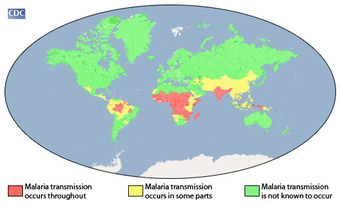
Concentrations of malaria transmission worldwide.
Normally not a problem to North Americans, malaria is the infectious disease most deadly to children worldwide. Said to be one of the world’s oldest diseases, malaria is caused by one of four protozoans within the genus Plasmodium.
19.5.3: HIV and AIDS
HIV/AIDS is a major health problem in many parts of the world.
Learning Objective
Describe the problems associated with HIV/AIDS for many societies, particularly poor countries and ethnic minorities
Key Points
- Acquired immune deficiency syndrome or acquired immunodeficiency syndrome (AIDS) is a disease of the human immune system caused by the human immunodeficiency virus (HIV). The virus and disease are often referred to together as HIV/AIDS.
- The three main transmission routes of HIV are sexual contact, exposure to infected body fluids or tissues, and from mother to fetus during the perinatal period.
- The symptoms of AIDS are primarily the result of conditions that do not normally develop in individuals with healthy immune systems.
- There is currently no publicly available HIV vaccine or cure for HIV or AIDS. The only known methods are based on avoiding exposure to the virus.
Key Terms
- transmission
-
HIV is transmitted by three main routes: sexual contact, exposure to infected body fluids or tissues and from mother to child during pregnancy, delivery or breastfeeding.
- vaccine
-
A substance given to stimulate the body’s production of antibodies providing immunity against a disease, prepared from the agent that causes the disease, or a synthetic substitute.
- perinatal period
-
Of or pertaining to the time around birth.
Example
- The topic of religion and AIDS has become highly controversial in the past 20 years. This is largely due to many prominent religious leaders publicly declaring their opposition to the use of condoms. A report by American health expert Matthew Hanley titled “The Catholic Church and the Global AIDS Crisis” argues that cultural, religion-based changes are needed. These include a re-emphasis on fidelity within marriage and sexual abstinence outside of it.
HIV and AIDS in Health Care
Acquired immune deficiency syndrome or acquired immunodeficiency syndrome (AIDS) is a disease of the human immune system caused by the human immunodeficiency virus (HIV). The illness interferes with the immune system, making people with it much more likely to get infections that do not affect people with working immune systems. This susceptibility gets worse as the disease continues. HIV is transmitted through sexual intercourse, contaminated blood transfusions and hypodermic needles. It can also be transmitted between mother and baby during pregnancy, childbirth and breastfeeding. It can be transmitted by any contact of a mucous membrane or the bloodstream with a bodily fluid that has the virus in it, including blood, semen, vaginal fluid, preseminal fluid, or breast milk.
The virus and disease are often referred to together as HIV/AIDS. The disease is a major health problem in many parts of the world, and is considered a pandemic; a disease outbreak that is not only present over a large area but is actively spreading. In 2009, the World Health Organization (WHO) estimated that there are 33.4 million people worldwide with HIV/AIDS; 2.7 million new HIV infections are reported per year along with two million annual deaths due to AIDS. The three main transmission routes of HIV are sexual contact, exposure to infected body fluids or tissues, and from mother to fetus during the perinatal period. It is possible to find HIV in saliva, tears and urine of infected individuals, but there are no recorded cases of infection by these secretions. Anti-retroviral treatment of infected patients also significantly reduces their ability to transmit HIV to others. This treatment reduces the amount of virus in bodily fluids to undetectable levels
People with AIDS also have an increased risk of developing various cancers like Kaposi’s sarcoma, cervical cancer and cancers of the immune system known as lymphomas. In addition, people with AIDS often have systemic symptoms of infection like fevers, sweats (particularly at night), swollen glands, chills, weakness, and weight loss. The opportunistic infections AIDS patients develop depend in part on the prevalence of these infections in the patient’s geographic area. Symptoms of AIDS are primarily the result of conditions that do not normally develop in individuals with healthy immune systems. Most of these conditions are opportunistic infections caused by bacteria, viruses, fungi and parasites normally controlled by the elements of the immune system that HIV damages. These infections affect nearly every organ system.
Many people are unaware that they are infected with HIV. Less than 1% of the sexually active urban population in Africa has been tested; this proportion is even lower in rural populations. Furthermore, only 0.5% of pregnant women attending urban health facilities are counseled, tested or receive their test results. Again, this proportion is even lower in rural health facilities. Therefore, donor blood and blood products used in medicine and medical research are screened for HIV.
There is currently no publicly available HIV vaccine or cure for HIV or AIDS. The only known methods are based on avoiding exposure to the virus or, failing that, an antiretroviral treatment given directly after a highly significant exposure. This treatment is called post-exposure prophylaxis (PEP). PEP has a very demanding four-week schedule of dosage. It also has very unpleasant side effects, including diarrhea, malaise, nausea and fatigue.
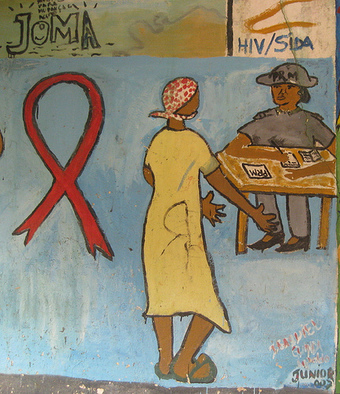
AIDS awareness in Chimoio
AIDS awareness painting on a wall in Chimoio town, Mozambique.
19.5.4: Health Insurance
Health insurance is insurance against the risk of incurring personal medical expenses.
Learning Objective
Discuss the use of both private and public health insurance and the implications for society’s overall health
Key Points
- Two types of health insurance have developed in modern society: private health insurance and publicly funded health insurance.
- A premium is the amount a policy-holder or his sponsor must pay to a health plan in order to purchase health coverage.
- A deductible is the amount that the insured must pay out-of-pocket before the health insurer pays its share.
- Co-payment is the amount that an insured person must pay out of pocket before a health insurer pays for a particular visit or service.
- An explanation of benefits is a document that may be sent by an insurer to a patient. This document explains what was covered for a medical service, and how payment amounts and patient responsibility amounts were determined.
- The premium is the amount the policy-holder or his sponsor pays to the health plan to purchase health coverage.
- The deductible is the amount that the insured must pay out-of-pocket before the health insurer pays its share.
- Co-payment is the amount that the insured person must pay out of pocket before the health insurer pays for a particular visit or service.
- Explanation of benefits is a document that may be sent by an insurer to a patient explaining what was covered for a medical service, and how payment amount and patient responsibility amount were determined.
- The medical model of medicine science focuses on the eradication of illness through diagnosis and effective treatment.
- The social model of medicine science focuses on changes that can be made in society and in people’s own lifestyles to make the population healthier.
Key Terms
- premium
-
The premium is the amount a policy-holder or his sponsor must pay to a health plan to purchase health coverage.
- deductible
-
A deductible is the amount that the insured must pay out-of-pocket before the health insurer pays its share.
- co-payment
-
A co-payment is the amount that the insured person must pay out of pocket before the health insurer pays for a particular visit or service.
Example
- In 2001, the United States government spent $4,887 per person on health care. That is more than double the rate of any other G8 country, except Japan, which spends close to $2,627 per capita annually. Considering the fact that private insurers are supposed to cover the majority of health care costs in the U.S., it is somewhat surprising that the United States spends a greater fraction of its national budget on health than Canada, Germany, France, or Japan. One explanation for the higher health care costs in the U.S. is the billing approach. In the U.S., many doctors work on a fee-for-service basis, which means they earn more if they do more tests or are consulted more frequently. In contrast, doctors who are salaried have no financial incentive to perform unnecessary tests. This was the explanation given for the wide disparity in Medicare spending for patients in the last two years of their lives at top teaching hospitals. For example, per patient costs at UCLA was $93,000, but only $53,000 at the Mayo Clinic. When doctors are salaried, they are not inclined to perform unnecessary tests to increase their income. Doctors using fee-for-service approaches do have that financial incentive. The quality of care and patient life expectancy did not differ between these two hospitals, despite the substantial difference in costs.
Health insurance is insurance against the risk of incurring personal medical expenses. By estimating the overall risk of health care that a target group will require, an insurer can develop a routine finance structure, such as a monthly premium or payroll tax, to ensure that money is available to pay for the health care benefits specified in an insurance agreement. These benefits are administered by a central organization, like a government agency, private business, or non-profit organization.
Types of Health Insurance: Public Vs. Private
Two types of health insurance exist in modern society, private health insurance and publicly funded health insurance. Private insurance, based on free market principles, refers to health insurance provided by a non-governmental organization, usually a privately owned or publicly traded corporation. Among developed nations, the United States is the only country in which private insurance is the primary source of healthcare.
In contrast to this private method, in public insurance, health care is paid wholly or mostly by public funds. This type of health care is the most common and popular in almost every developed and developing nation in the world, except the United States. The majority of developed nations have publicly funded health systems that cover a majority of the population.
Understanding Health Insurance Terms
Some of the essential terms associated with health insurance are premiums, deductibles, co-payments, and explanations of benefits. A premium is the amount a policy-holder or his sponsor (e.g. an employer) must pay to a health plan to purchase health coverage. A deductible is the amount that an insured individual must pay out-of-pocket before the health insurer pays its share. For example, policyholders might have to pay a $500 deductible per year, before the health insurer covers any health care costs. A co-payment is the amount that an insured person must pay out of pocket before the health insurer pays for a particular visit or service. For example, an insured person might pay a $45 co-payment for a doctor’s visit, or to obtain a prescription. A co-payment must be made each time a particular service is obtained. Lastly, an explanation of benefits is a document that may be sent by an insurer to a patient. This document explains what the insurer will cover, in terms of medical services. It also explains how payment amounts and patient responsibility amounts have been determined.
Healthcare and Modern Medicine
Healthcare improves as a result of advancements in medical science. Modern medicine approaches health care from two angles. The first, the medical model, focuses on the eradication of illness through diagnosis and effective treatment. The second, the social model, focuses on changes that can be made in society and in people’s lifestyles to make the population healthier. This second method typically focuses on preventative care. Modern, scientific medicine has proven uniquely effective at treating and preventing disease. It is increasingly widespread and more widely accepted than other forms of medicine. Modern medicine is notably secular, and indifferent to ideas of the supernatural or the spiritual. Instead, it concentrates on the body and society to determine the causes and cures of health issues. Modern, scientific medicine is the most effective contributor to the health of humans in the world today.

In less than 10 Years, AMERICA will Spend $1 of Every $5 Dollars on Health care
Across the country, American workers, their families, and small businesses are struggling with rising health care costs and policies that put quality, affordable care out of reach. A new report by the Centers for Medicare and Medicaid Services (CMS), published in the magazine Health Affairs, estimates that spending on health care grew to 17.3 percent of the U.S. economy – a record and the largest one-year jump since 1960.
19.5.5: Preventing Illness
Preventive medicine, or preventive care, refers to measures taken to prevent diseases, rather than curing them or treating their symptoms.
Learning Objective
Explain the purpose of preventive medicine and how insurance companies can influence the types of preventive medicine chosen
Key Points
- Preventive care may include examinations and screening tests tailored to an individual’s age, health, and family history.
- Preventive medicine or preventive care refers to measures taken to prevent diseases rather than curing them or treating their symptoms.
- Professionals involved in the public health aspect of this practice may be involved in entomology, pest control, and public health inspections.
- Intrauterine devices (IUD) are highly effective and highly cost effective contraceptives, however where universal health care is not available the initial cost may be a barrier.
Key Terms
- intrauterine device
-
A contraceptive device consisting of a spiral or similar shape of plastic or metal inserted through the vagina into the uterus in order to prevent the implantation of a fertilized egg.
- public health
-
The science and practice of community hygiene; it includes preventive medicine, health education, sanitation and environmental safety.
- preventive medicine
-
Preventive medicine refers to measures taken to prevent diseases rather than curing them or treating their symptoms.
Example
- Many vaccines are prophylactic vaccines. Polio vaccine, smallpox vaccine, measles vaccine, mumps vaccine and others have greatly reduced many childhood diseases. HPV vaccines prevent certain cancers, and the influenza vaccine prevents influenza.
Preventive medicine, or preventive care, refers to measures taken to prevent diseases, rather than curing them or treating their symptoms. The term contrasts in method with curative and palliative medicine, and in scope with public health methods, which work at the level of population health rather than individual health. Simple examples of preventive medicine include hand washing, breastfeeding, and immunizations. Preventive care may include examinations and screening tests tailored to an individual’s age, health, and family history. For example, a person with a family history of certain cancers or other diseases would begin screening at an earlier age and/or more frequently than those with no such family history.
Professionals involved in the public health aspect of this practice may be involved in entomology, pest control, and public health inspections. Public health inspections can include recreational waters, swimming pools, beaches, food preparation and serving, and industrial hygiene inspections and surveys.
Since preventive medicine deals with healthy individuals or populations, the costs and potential harms from interventions need even more careful examination than in treatment. For an intervention to be applied widely it generally needs to be affordable and highly cost effective. For instance, intrauterine devices (IUD) are highly effective and highly cost effective contraceptives, however where universal health care is not available the initial cost may be a barrier. Preventive solutions may be less profitable and therefore less attractive to makers and marketers of pharmaceuticals and medical devices. Birth control pills, which are taken every day and may take in a thousand dollars over ten years, may generate more profits than an IUD, which despite a huge initial markup only generates a few hundred dollars over the same period.
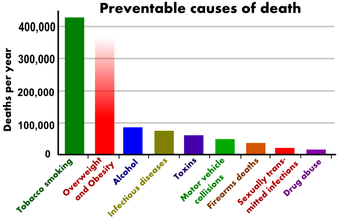
Leading Preventable Causes of Death in the United States.
This data is outdated and was in fact significantly revised in subsequent reports of the leading causes of deaths, especially for obesity-related diseases.
Chapter 18: Aging
18.1: The Aging Population
18.1.1: Aging
Aging is the process of people growing older.
Key Points
- Population aging is a demographic phenomenon which involves the rise in the median age of a country or region.
- Traditionally, the extended family was primarly responsible for taking care of the elderly, a fact which is no longer the case in many societies.
- Today, the state and various charitable organizations are largely responsible for providing care for the elderly.
- In the U.S., two major problems associated with an aging population are the pension crisis and the strain on the healthcare system, particularly Medicare.
Key Terms
- Growing Old
-
In the 1961 book Growing Old, Cumming and Henry formulated the disengagement theory of aging. It was the first theory of aging that social scientists developed.
- disengagement theory
-
The disengagement theory of aging states that “aging is an inevitable, mutual withdrawal or disengagement, resulting in decreased interaction between the aging person and others in the social system he belongs to.”
Aging
As people grow older, they become less self-sufficient in terms of taking care of their own finances, health, and general day-to-day needs and obligations. For example, most societies have a generally accepted age of retirement (based on both societal norms as well as a country’s tax laws and pension rules) after which point an individual ceases to engage in employment. The rest of society typically assumes some level of responsibility in ensuring that the elderly are cared for. The elderly can receive care from a variety of different sources, including their families, the state, the private sector, and charitable institutions. Nevertheless, even in societies that have a strong system in place to provide for the aged, an aging population poses a significant financial and economic burden . In the U.S. specifically, the pension system and the healthcare sector are two important examples of this problem.
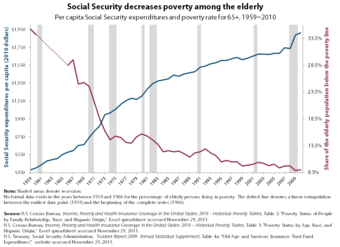
Does Social Security Decrease Poverty among the Elderly?
The blue line represents social security expenditure in 2010 dollars, while the red line indicates the percentage of the population aged 65 and over who are at or below the poverty line. As the graph shows, the amount of social security expenditure is correlated with a drop in the number of elderly people at or below the poverty line.
History of Elderly Care
Traditionally, the extended family would look after the older generation. While this role is still attributed to the family in many parts of the world, particularly in non-Western nations, the modern family has evolved in such a way that care for the aged is now provided for by the state and various charitable organizations. Some of the main reasons why elders are less likely to be taken care of exclusively by their families include the decreasing size of families, the increased longevity of the elderly, the geographic dispersion of families, and the fact that women have become more educated and commonly work outside the home. While this trend is widespread in Europe and North America, there is growing evidence of it in many parts of Asia, too. The various forms that elderly care services can take include assisted living, adult day care, long-term care, nursing homes, hospice care, and in-home care. The different institutions can further be classified as medical (skilled) care and non-medical (social) care.
Several countries today are facing an aging population, where the median age of the population has increased and a larger portion of the population is considered to be older. Two primary reasons for this are increased life expectancy and lower birth rates. Currently, the majority of the countries facing this demographic phenomenon consists of advanced economies, such as Japan and many parts of Europe. However, it is predicted that the greatest future impact will occur in Asia.
Advantages of an Older Population
There may be some economic advantages to having an older population. For example, since older people have higher accumulated savings per head than younger individuals do, a large aged population can result in lower interest rates as well as a lower rate of inflation. However, for the most part, a substantial aged population leads to a lot of financial pressure on both the public and private sectors.
Disadvantages of an Older Population
One of the problems that may arise from a large segment of society being aged is a pension crisis. In the U.S., it is probably going to become increasingly difficult to pay corporate, federal, and state pensions, because the number of workers relative to retirees is shrinking. In order to improve the sustainability of the pension system, a few measures can be undertaken. For example, the worker-retiree ratio can be rectified by increasing the retirement age or by changing employment and immigration policies. Alternatively, it may be possible to reduce the amount owed to retirees. Finally, it may become necessary to expand resources to fund pensions through increased contributions or higher taxes. Trying to implement any of these solutions will likely result in some level of controversy and public debate.
Another significant source of problems related to an older population resides in the healthcare sector. In 1965, Congress created Medicare under the Social Security Act in order to provide health insurance to U.S. citizens over the age of 65, regardless of their income and medical history. Aside from premiums paid by Medicare enrollees along with the fund source itself, Medicare is financed by revenue levied on employers and workers through the Federal Insurance Contributions Act and the Self-Employment Contributions Act. However, due to rising enrollment as the population ages and a decreasing ratio of workers to enrollers, Medicare is facing financial difficulties. While the Patient Protection and Affordable Care Act is supposed to address many issues confronting the healthcare sector today, the rising cost of healthcare remains a national problem, as patients are paying more in order to receive the same care as before.
18.1.2: Composition of the Older Population
The elderly proportion of the population is growing around the world, but it is greater in developed countries.
Learning Objective
Examine the sociological factors that allow people to live longer lives in industrialized versus non-industrialized nations, such as better access to health care
Key Points
- All over the world, people are living longer. Population experts estimate that more than 50 million Americans, or 17 percent of the population, will be 65 or older in 2020.
- Biological markers for old age (such as wrinkles, grey hair, memory loss, etc.) exist, but old age can also be defined by when an individual begins to fill certain social roles, such as becoming a grandparent or retiring.
- There is a disparity between industrialized and non-industrialized nations; people live longer in industrialized countries.
- The population of people aged 65 and older has been growing at a faster rate than the total population. While women still live longer than men, the gender gap among seniors is narrowing.
- There appear to be regional divides in the demographic breakdown of senior citizens.
Key Terms
- centenarian
-
Being at least 100 years old.
- United States Census
-
The United States Census provides more specific information about the make up of older Americans. According to the census, there has been rapid growth amongst the elderly segment of the population in recent years.
The number of individuals living into old age is growing worldwide. While the trend of an aging population is obvious, it can be difficult to assess because the definition of “old age” depends entirely on the cultural norms of a given society. Biological markers for old age (such as wrinkles, grey hair, memory loss, etc.) exist, but old age can also be defined by when an individual begins to fill certain social roles, such as becoming a grandparent or retiring. All of these factors vary by culture.
Statistics on Age
Nevertheless, the fact is that people are living longer and are therefore more prone to encounter issues associated with old age. In industrialized nations, life expectancy has increased consistently over the last decades. In the United States, the proportion of people aged 65 or older increased from 4 percent in 1900 to about 12 percent in 2000. In 1900, only about 3 million Americans were 65 or older, out of a total population of 76 million Americans. By 2000, the number of senior citizens had increased to 35 million out of 280 million Americans. Population experts estimate that more than 50 million Americans, or 17 percent of the population, will be 65 or older in 2020. The number of older Americans has spiked in recent years due to the age of baby boomers—the generation that was born in the twenty years following World War II. As soldiers returned from war, families began to grow. This generation is now beginning to enter their older years.
The United States Census provides more specific information about the make up of older Americans. According to the census, there has been rapid growth among the elderly segment of the population in recent years. The population of people aged 65 and older grew at a faster rate than the total population. While women still live longer than men, the gender gap among seniors is narrowing. Further, there appear to be regional divides in the demographic breakdown of senior citizens. The South had the largest number of people aged 65 and up, while the Northeast had the largest percentage of people aged 65 and up. In 2010, 53,364 centenarians, or people over the age of 100, lived in the United States, a 5.8 percent increase from the number of centenarians in 2000. This means that 1 out of every 5,786 Americans is over the age of 100.
While the trend of an older population appears worldwide, people in industrialized nations are older than people in non-industrialized nations. While people in almost all countries are living longer than prior generations, people in industrialized nations still live longer than people in non-industrialized nations. According to the Population Research Bureau, the average life expectancy in Africa is 53, in North America is 78, in Latin America is 73, in Asia is 68, in Europe is 75, and in Oceania is 75. Some of this difference can be attributed to disparities in health care—easier access to pervasive biotechnology in industrialized nations means that people live longer. Other factors include poverty and a generally more strenuous lifestyle, which can cause health problems and a lower life expectancy.
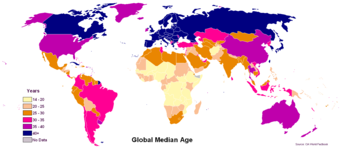
Global Median Age
Average age by country
18.1.3: Gender Differences in Aging
Aging to sex ratios show women living longer than men, but this gap has been quickly narrowing since 1990.
Learning Objective
Analyze the gender gap that exists leading to women generally living longer than men
Key Points
- Women tend to live longer than men, and the ratio of women to men is high among the elderly.
- The percentage of men aged 65 and up grew faster than the percentage of women aged 65 and up, according to the 2010 census.
- The longevity of women relative to men is likely due to their better cardiovascular health, the fact that they are less likely to engage in risky behavior, and the fact that traditionally, physical labor is more frequently performed by men.
Key Term
- centenarian
-
Being at least 100 years old.
Women tend to live longer than men in almost every country. In Japan, men generally live to about 79, whereas women live to 83. However, in the United States, that gender gap is beginning to close. The percentage of men aged 65 and up grew faster than the percentage of women aged 65 and up, according to the 2010 census. For example, the number of men aged 85 to 94 grew 46.5% between 2000 and 2010, but the number of women in that age group grew only 22.9%.
However, for the very oldest members of the population, the gender gap still holds true. The United States Census reports that of the 53,364 centenarians, or people over the age of 100, 82.8% are women and only 17.2% are male. In other words, out of the entire American population, 1 out of every 3,551 females is a centenarian while only 1 out or 16,566 males is a centenarian. Thus, even though the gender gap is narrowing, women are still expected to live longer than men .
A Comparison of Genders
This graph illustrates the differences in life expectancy at birth for males and females in the United States, from 1950 to 2050.
These figures could be due, in part, to the sex ratio. The sex ratio is the ratio of men to women in a given society or country. The current sex ratio for the world is 986 females to 1000 males. In the United States, the ratio is 105 males to every 100 females. However, men tend to live riskier lives, are more prone to heart disease and cancer, and women are therefore likely to live longer than men. In fact, cancer deaths among men are 200 per 100,000 cases, whereas women are only 150 per 100,000 (from the National Cancer Institute).
Why women live longer than men is not perfectly understood. Several factors contribute to the overall trend. For example, men statistically engage in more behaviors that put their lives at risk than women, which reduces their life expectancy. Men are also more “successful” when attempting suicide, which also brings down their life expectancy. Another factor that may contribute to the greater life expectancy of women is the different types of jobs men and women tend to have during their lifetimes, with men more frequently doing physical labor that could wear the body down or increase the odds of injury. Other biological factors likely play a role, including greater cardiovascular health among women.
18.1.4: Aging and Race
Individuals with different racial backgrounds tend to have different experiences with old age.
Learning Objective
Examine the racial implications of aging, particularly for minority groups
Key Points
- Minority populations are more likely to experience elder abuse from relatives and caretakers.
- Minority populations are also more likely to experience health problems associated with old age.
- Many of the medical differences between different racial groups are better explained by differences in socioeconomic status rather than race.
Key Terms
- social determinants of health
-
The economic and social conditions that influence individual and group differences in health status.
- elder abuse
-
Elder abuse is a general term used to describe certain types of harm to older adults.
Individuals of different racial backgrounds experience aging—and the health issues associated with it—differently . Before turning to the medical concerns that accompany aging, one should note that elders of different racial backgrounds also experience different frequencies of elder abuse. Elder abuse is a general term to describe certain types of harm that are inflicted upon older adults. The most common form of elder abuse is neglect or improper care for vulnerable seniors. Unfortunately, this is usually inflicted by people whom the elder trusts and who are responsible for caring for the elder, such as family members or caretakers at elder homes. Research indicates that black senior citizens are more likely to be abused than white citizens.

Aging and its Trials
Are the problems the elderly face a result of their age, or are their other, more influential, factors involved, such as race?
Further, medical concerns present differently for white seniors and minority seniors. Black and Hispanic seniors are more likely to encounter cardiac problems earlier than white seniors. However, these outcome disparities are not usually the result of biological determinants of health, which means that minority populations are not biologically less healthy than white populations. Rather, the disparity in medical outcomes is more likely attributed to social determinants of health, which are socioeconomic conditions that bear on health.
For example, black and Hispanic populations are more likely to encounter financial hardship and therefore eat less healthy food, which potentially leads to health problems. In addition, individuals from a poorer socioeconomic background are less likely to have had access to healthcare throughout their whole lives. This lack of access ultimately leads to medical concerns in old age. Thus, while one can make generalizations about elder health by comparing racial categories, these differences are frequently caused by differences in socioeconomic status rather than race.
18.1.5: Aging and Wealth
In order to assist the elderly with their living and healthcare costs, the U.S. government established assistance programs like Medicare.
Learning Objective
Examine the programs made available to the elderly to assist with quality of life, such as Social Security and Medicare, and the looming crises with these particular programs
Key Points
- American seniors face serious financial troubles due to the fact that they are no longer earning an income, but face increased expenses as a result of diminishing health.
- Social Security and Medicare are federal programs designed to help seniors, though both programs face financial difficulties themselves.
- The Patient Protection and Affordable Care Act, also known as Obamacare, would help cut down seniors’ expenses by lowering healthcare costs and increasing public services.
Key Terms
- baby boomer generation
-
The baby boomer generation, or those born during the spike in births in the twenty years following World War II, is starting to reach senior citizenship, and will soon pull from the public funds of Social Security and Medicare.
- Obamacare
-
a colloquial term for the Patient Protection and Affordable Care Act of 2010 which expands health care coverage for Americans
- Patient Protection and Affordable Care Act
-
an American law passed in 2010 that expands health care coverage
Managing the Aging Population
The elderly have financial difficulties primarily because they are too old to hold a job, and thus have no regular income, yet they incur large medical expenses as a result of diminishing health. However, due to the improvement in medical technology, more seniors are living longer and more fulfilling lives, yet still struggle financially. Because of this trend of impoverishment, the United States has enacted social policies designed to help the elderly manage their financial woes. Major policy efforts include Social Security, a social welfare program that taxes the current working sector to give money to individuals in retirement, and Medicare, a federal program that subsidizes medical costs for seniors. Prior to the introduction of Social Security, the elderly were the poorest age group in the United States. With the introduction of Social Security, poverty rates of the elderly in the United States have dropped dramatically. Between 1960 and 1995, the official poverty rate of those aged 65 and above fell from 35 percent to 10 percent, according to the National Bureau of Economic Research. However, due to a lack of funds, that number is beginning to increase once again.
Social Security
Social Security is designed to redistribute wealth temporarily in order to help seniors finance their lives after retirement. In this program, the current workforce is taxed, the results of which flow into a special fund designated for Social Security. Payments are then made from this fund to retirees. This is not, however, simple redistribution. The workforce that is currently contributing to the fund will then retrieve payments once they retire. Thus, Social Security has features of both a redistribution system and a savings account.
Medicare
In addition to Social Security, the other primary social support for the American elderly is Medicare. Medicare is a social insurance program that provides health care for American citizens over the age of 65. Medicare subsidizes hospital visits, doctors’ appointments, and prescription drugs. Created in 1965, Medicare was intended to address the fact that seniors spend more on healthcare than any other segment of the population, despite having the least income. Recent studies have confirmed that Medicare enrollees typically have lower incomes and more healthcare expenses than the average American. In 2006, the average household income of Medicare enrollees was $22,600, far less than the median American income of $48, 201. In 2008, 16% of Medicare enrollees were living below the poverty line, compared to 13% of the general population. Further complicating things, the typical senior household has only $66,900 in savings, yet the average American male needs $124,000 to cover healthcare during retirement, and the average American female needs $152,000.
Because Medicare enrollees are, by definition, senior citizens, their healthcare costs also far higher than average. About 87% of Medicare enrollees have at least one chronic condition and close to half have three or more. Thirty percent of enrollees visit the emergency room in any given year, and 21% have an inpatient stay. Roughly 66% of seniors require some form of long-term care over their lifetimes, and 18% live in a nursing home for at least one year. These disparities demonstrate the complicated problems most senior citizens encounter as they age.
Looming Crises with Medicare and Social Security
Social Security could soon be in crisis if current trends to not change. Right now, more money is being garnished through taxing the current workforce than is being paid out to retirees. However, this will soon change. If the laws governing Social Security are not changed by 2017, the program will begin paying out more funds than it receives. Medicare faces even more dire financial problems than Social Security. Like Social Security, Medicare gains revenue through taxation, but by 2009, Medicare was expending more than it was earning, and its Trust Fund had already been tapped to access emergency funds. The Trust Fund for Medicare will be exhausted by 2017, at which point, the federal government will only be able to cover about 80% of the costs of medical treatment for its senior citizens, which is around 48 million Americans.
Part of the reason both Social Security and Medicare face looming crises is the rising population of seniors. The baby boomer generation, those born in the 20 years following World War II, is starting to reach senior citizenship and pull from these public funds. At the same time, the working population in the United States has decreased. Thus, Social Security and Medicare are both being called upon to support greater numbers of senior citizens while having fewer workers to tax in order to gain revenue. The respective conditions of Social Security and Medicare contributed significantly to the discussion surrounding the Patient Protection and Affordable Care Act, passed by President Barack Obama in 2010. The act, commonly referred to as Obamacare, provides a public insurance option through the government to help drive down insurance costs. By lowering healthcare costs and requiring insurance, the government hopes to better address the needs of the nation’s elderly. However, the constitutionality of the Act is currently being debated by the U.S. Supreme Court and the Act could be overturned. Regardless of what the Supreme Court decides, American seniors face serious financial troubles, compounded by their healthcare needs.
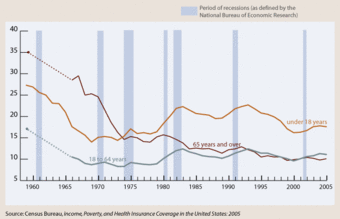
Poverty by Age
This figure shows the relationship between poverty and age.
18.1.6: Global Aging
Global aging differs depending on the access to economic and social resources; thus, industrialized countries tend to have older populations.
Learning Objective
Discuss the impact of an aging population on the economy, for example, in terms of health care costs
Key Points
- People are living longer than ever before across the world.
- However, on average, people in industrialized nations live longer than people in non-industrialized nations. This is largely due to poorer health in non-industrialized countries, and fatalities associated with HIV/AIDS.
- Difference in lifespan is also attributed to better access of healthcare in different industrialized and non-industrialized nations.
- The economic effects of an aging population are considerable.
Key Terms
- biotechnology
-
The use of living organisms (especially microorganisms) in industrial, agricultural, medical and other technological applications
- HIV/AIDS
-
An infectious disease, caused by HIV, that causes the gradual degeneration of the body’s immune system.
Example
- The Chinese government’s strict control over family size, particularly its one-child policy for urban families, has resulted in a significant decrease in the country’s population growth rate. China can expect to confront an aging population in the foreseeable future if this trend, among others, persists.
All over the world, people are living longer than ever before. However, while the trend of a growing older population appears world over, people in industrialized nations are older than people in non-industrialized nations. According to the Population Research Bureau, the average life expectancy in Africa is 53, in North America is 78, in Latin America is 73, in Asia is 68, in Europe is 75, and in Oceania is 75. Worldwide, about 8% of the total global population is over the age of 65, while about 12% of Americans are over the age of 65.
Some of this difference can be attributed to disparities in health care. Easier access to pervasive biotechnology in industrialized nations means that people live longer. Unfortunately, in some countries HIV/AIDS has ravaged the population to the point where the average life expectancy drops. Most of these countries have lower levels of development and industrialization.
The economic effects of an aging population are considerable. Older people have higher accumulated savings per head than younger people, but spend less on consumer goods. Depending on the age ranges at which the changes occur, an aging population may thus result in lower interest rates and the economic benefits of lower inflation. Some economists see advantages in such changes, notably the opportunity to progress automation and technological development without causing unemployment. They emphasize a shift from GDP to personal well-being.
However population aging also increases some categories of expenditure, including some from public finances. The largest area of expenditure in many countries is now health care, the cost of which is likely to increase dramatically as populations age. This would present governments with hard choices between higher taxes, including a possible reweighing of tax from earnings to consumption, and a reduced government role in providing health care.
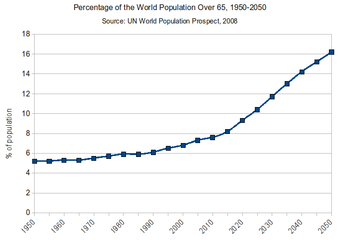
Percentage of the World Population Over 65
1950-2050
18.2: A Global Perspective on Aging
18.2.1: The Social Construction of Aging
The social construction of aging entails the creation of social norms and symbols that encapsulates the aging process.
Learning Objective
Discuss the cultural treatment of aging in the U.S. versus Japan, employing Goffman’s argument in ”The Presentation of Self in Everyday Life”
Key Points
- Age is socially constructed because notions of age vary around the world.
- Different cultures fix age with different meanings and different values.
- Eastern cultures tend to highly value age and wisdom, while Western cultures tend to highly value youth.
- In Western societies, people take pains to appear younger than their biological age. These measures follow Erving Goffman’s ideas of self-presentation in that people are trying to get others in society to perceive them as young.
Key Term
- social construction
-
A concept or practice that is the construct (or artifact) of a particular group, meaning that the concept or practice is understood differently by various groups and institutions.
Example
- Representations of aging in the social life are determined by different social interactions like getting senior discounts. Society has predetermined who is socially able to obtain those discounts based on their age range. Senior citizens are considered old in most cases by the rest of the population in the United States.
Aging as a Social Construction
While aging itself is a biological process, what it means to be “young” or “old” is socially constructed. This means that there is no inherent cultural meaning to the biological process of aging. Rather, cultures imbue youth and age with meanings. Aging is perceived differently around the world, demonstrating its social construction.
Frequently, the average life expectancy in a given region bears on what age counts as “old.” For example, in the United States, where the average life expectancy is over 78 years, people are not considered “old” until they are in their sixties or seventies. However, in Chad the average life expectancy is less than 49 years. People in their thirties or forties are therefore already middle-aged or “old.” These variations in people’s perceptions of who should or should not be considered elderly indicates indicates that notions of youth and age are culturally constructed. There is thus no such thing as a universal age for being considered old .

Is this Incongruous?
Given the socially constructed nature of age, there are certain behaviors that people typically associate with certain age groups as being “appropriate” or “acceptable. ” Is this old woman challenging any conventional perceptions about how women of a certain age should behave?
Cultural Treatment of Aging
Cultures treat their elderly differently and place different values on old age. Many Eastern societies associate old age with wisdom, so they value old age much more than their Western counterparts. In Japan, adult children are expected to care for their aging parents in ways different than in the United States. Sixty five percent of Japanese elders live with their children and very few live in nursing homes. Japanese cultural norms suggest that caring for one’s parents by putting them in an assisted living home is tantamount to neglect. When unable to care for themselves, parents should ideally move in with their children. The Japanese celebration of old age is further illustrated by the existence of Respect for the Aged Day, which is a national holiday to celebrate elderly citizens.
Japanese perceptions of elders diverge markedly from public perceptions of old age in the United States. Western societies tend to place an increased value on youth such that many people take extreme measures to appear young. The desire to look younger than one’s biological years is frequently the impetus for cosmetic surgeries that can hide the physical effects of aging. These surgical practices, combined with the huge expenditures on makeup and clothing in younger fashions, incorporate a Goffmanian understanding of social presentation.
Erving Goffman was a sociologist writing in the mid-twentieth century. His most famous work, The Presentation of Self in Everyday Life (1959) argued that whenever individuals come into contact with other people, they will attempt to control or guide the impression that others might have of them by intentionally comporting themselves in different ways. Individuals thus take sometimes drastic action to control the appearance of their age so that others can perceive them to be younger. Significantly, these social interactions occur in a social milieu that values youth. In this light, people try to appear younger to increase their sense of social value. Of course, interactions involving the perception of age must then vary by culture, as different cultures ascribe the notion of age with different values.
18.2.2: Industrialization and the Graying of the Globe
Industrialization has contributed to the growth of the older age population due to the technological advances that have come with it.
Learning Objective
Produce a short debate which shows the pros and cons of industrialization
Key Points
- Industrialized nations are those that meet certain measures of economic growth and security, while non-industrialized nations are those that do not meet those measures.
- Industrialization increases life expectancy by creating better conditions, better government social supports, and better access to healthcare.
- There is currently a disparity in life expectancy between industrialized nations and non-industrialized nations.
Key Terms
- Industrial Revolution
-
The major technological, socioeconomic, and cultural change in the late 18th and early 19th century, resulting from the replacement of an economy based on manual labor to one dominated by industry and machine manufacturing.
- industrialized countries
-
Industrialized countries are defined by measures of economic growth and security. Most commonly, the criteria for evaluating the degree of development is to look at the gross domestic product (GDP), the per capita income, the level of industrialization, the amount of widespread infrastructure, and the general standard of living.
- infant mortality rate
-
In the field of public health, the infant mortality rate is a commonly used statistical measure that is defined as the ratio of infant deaths to live births.
Example
- As Malaysia has a life-expectancy of close to 76 years and a declining birth rate, the Malaysian Trade Union Congress (MTUC) is encouraging a Minimum Retirement Age Bill in Congress. Since an aging population presents a financial burden, making workers work longer would allow them to be taxed longer. Other countries in the region, including Singapore, Laos, Thailand, and the Philippines already have a retirement age to address these same issues.
Across the globe, industrialization increases the average life span of people. Industrialization is the process of social and economic change that transforms a community from an agrarian society into an industrial one. It is a part of a wider modernization process, where social change and economic development are closely related with technological innovation. The United Kingdom began an Industrial Revolution in the mid-eighteenth century due to the availability of land, labor, and investment capital.
Most Western countries industrialized by the nineteenth century but the Industrial Revolution is still occurring around the world. One schematic by which one can divide the world is between industrialized and non-industrialized countries. Industrialized countries are defined by measures of economic growth and security. Most commonly, the criteria for evaluating the degree of development is to look at the gross domestic product (GDP), the per capita income, the level of industrialization, the amount of widespread infrastructure, and the general standard of living. Countries that score poorly on these scales are considered to be non-industrialized, though it should be noted that non-industrialized countries are undergoing the process of industrialization.
All over the world, people are living longer than ever before. However, while the trend of a growing older population appears the world over, people in industrialized nations are older than people in non-industrialized nations. Thus, while people in all countries are living longer than prior generations, people in industrialized nations live longer than people in non-industrialized nations. According to the Population Research Bureau, the average life expectancy in Africa is 53, in North America is 78, in Latin America is 73, in Asia is 68, in Europe is 75, and in Oceania is 75. Worldwide, about 8% of the total global population is over the age of 65, while about 12% of Americans are over the age of 65.
How can one explain this disparity? Industrialization brings money into an economy. With this influx of capital, countries are able to develop more robust social supports to assist a population. Further, development can create jobs, enabling people to better fend for themselves. Food and healthcare are more widely available. Better living conditions and healthcare both limit the infant mortality rate, which is the percentage of children who die before turning one year old, and extend the average life expectancy. Both of these trends encourage the growth of an older population.

Industrialized Nations
2011
18.2.3: The Graying of America
The graying of America has contributed to the higher concentration of the elderly in certain areas of the United States.
Learning Objective
Summarize how the situation in Pittsburgh illustrates the economic tensions produced by an aging population
Key Points
- About 12% of Americans are over the age of 65. The elderly are concentrated in the Midwest and the South.
- The higher concentration of older people in certain places has economic ramifications. These areas are called upon to support a population that has a greater need for social services, such as healthcare.
- As the aging population rises in Pittsburgh, industries such as healthcare have replaced the steel industry due to the shift to a more elderly population in that area.
Key Term
- pension
-
A gratuity paid regularly as a benefit due to a person in consideration of past services; notably to one retired from service, on account of retirement age, disability or similar cause; especially a regular stipend paid by a government to retired public officers, disabled soldiers; sometimes passed on to the heirs, or even specifically for them, as to the families of soldiers killed in service.
According to the United States Census, about 12% of the American population is over the age of 65. However, the elderly are not evenly distributed throughout the United States . There are higher concentrations of the elderly in the Midwest and in the South, particularly in Florida. The high concentration of elderly in Florida is partially attributable to the fact that many retirees move to Florida for the good weather. In contrast, few elderly people move to the Midwest. Instead, the high concentration of elderly people in the Midwest is due to the fact that the young are moving out of there.

Percentage of the Population Aged 65+ in the United States
This is a map of the USA reflecting the percentage of the population over age 65 by census district based on Census 2000 data.
The city of Pittsburgh offers an intriguing case study of the effects of an aging population on a city. Since 2008, more people die annually in Pittsburgh than are born. Further, many members of the younger generation are moving away from Pittsburgh in an effort to find work. As such, Pittsburgh is both experiencing population decline and the aging of its existing population. This poses an economic conundrum in that the population is increasingly reliant on public services for assistance, such as healthcare, but there is a smaller workforce that can be taxed to support the demand. Additionally, changing demographics have influenced the comparative prominence of different economic sectors in Pittsburgh. Healthcare has replaced steel as Pittsburgh’s largest industry. This case study demonstrates how shifting population demographics can seriously impact an urban area’s economy.
While the effects of an increasingly aging population on society are complex, there is a specific concern about the impact on healthcare demand. Older people generally incur more health-related costs than do younger people, and in the workplace can also cost more in worker’s compensation and pension liabilities.
18.3: The Functionalist Perspective on Aging
18.3.1: Disengagement Theory
The disengagement theory of aging claims that it is natural and acceptable for older adults to withdraw from society and personal relationships as they age.
Learning Objective
Analyze the nine postulates of growing old and the impact at each stage for the elderly in society
Key Points
- Disengagement theory claims that it is natural and acceptable for older adults to withdraw from society and personal relationships as they age.
- Disengagement theory was the first theory of aging developed by social scientists.
- The theory was developed by Elaine Cumming and Warren Earl Henry in their 1961 book “Growing Old. ” Subsequently, the theory has been largely debunked.
Key Terms
- Robert J. Havighurst
-
Robert James Havighurst (June 5, 1900 in De Pere, Wisconsin – January 31, 1991 in Richmond, Indiana) was a professor, physicist, educator, and aging expert.
- activity theory
-
Activity theory claims that staying mentally and physically active preserves older adults happier.
- disengagement theory
-
The disengagement theory of aging claims that it is natural and acceptable for older adults to withdraw from society and personal relationships as they age.
The disengagement theory of aging claims that it is natural and acceptable for older adults to withdraw from society and personal relationships as they age. The theory further suggests that society responds to the elder’s disengagement with a sort of mutual recognition that the elder will soon pass and society must prepare to function in their absence. As such, the theory argues that it is natural and acceptable for older adults to withdraw from society.
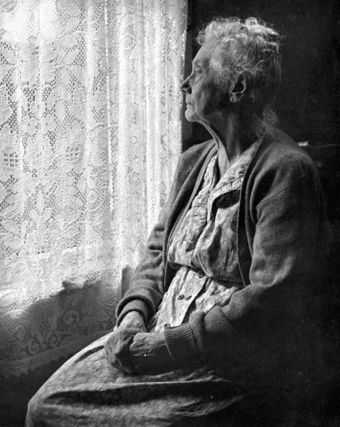
Elderly Woman
Disengagement theory suggests that adults become increasingly withdrawn as they get older.
The Postulates of Growing Old
Disengagement theory was the first theory of aging developed by social scientists. It was originally formulated by Elaine Cumming and Warren Earl Henry in their 1961 book Growing Old. In Growing Old, Cumming and Henry develop a logical argument for why older adults would naturally disengage from society. They formulate their argument along nine postulates to explain why it is rational for individuals who know that death is approaching and who have seen friends of their age pass to begin to anticipate their own deaths and disengage.
The postulates are as follows:
- Postulate one: Everyone expects death, and one’s abilities will likely deteriorate over time. As a result, every person will lose ties to others in his or her society.
- Postulate two: Because individual interactions between people strengthen norms, an individual who has fewer varieties of interactions has greater freedom from the norms imposed by interaction. Consequently, this form of disengagement becomes a circular or self-perpetuating process.
- Postulate three: Because men have a centrally instrumental role in America, and women a socioemotional one, disengagement differs between men and women.
- Postulate four: The individual’s life is punctuated by ego changes. For example, aging, a form of ego change, causes knowledge and skill to deteriorate. However, success in an industrialized society demands certain knowledge and skill. To satisfy these demands, age-grading ensures that the young possess sufficient knowledge and skill to assume authority and that the old retire before they lose their skills. This kind of disengagement is affected by the individual, prompted by either ego changes or the organization, which is bound to organizational imperatives, or both.
- Postulate five: When both the individual and society are ready for disengagement, complete disengagement results. When neither is ready, continuing engagement results. When the individual is ready and society is not, a disjunction between the expectations of the individual and of the members of this social systems results, but engagement usually continues. When society is ready and the individual is not, the result of the disjunction is usually disengagement.
- Postulate six: Man’s central role is work, and woman’s is marriage and family. If individuals abandon their central roles, they drastically lose social life space, and so suffer crisis and demoralization unless they assume the different roles required by the disengaged state.
- Postulate seven: Readiness for disengagement occurs if the individual is aware of the shortness of life and scarcity of time, the individual perceives his or her life space decreasing, and the individual loses ego energy. Each level of society grants individuals permission to disengage because of the following: requirements of the rational-legal occupational system in an affluent society; the nature of the nuclear family; and the differential death rate.
- Postulate eight: Fewer interactions and disengagement from central roles lead to the relationships in the remaining roles changing. In turn, relational rewards become more diverse, and vertical solidarities are transformed to horizontal ones.
- Postulate nine: Disengagement theory is independent of culture, but the form it takes is bound by culture.
Disengagement theory, suffering from a lack of empirical support, has largely been dismissed by social scientists and gerontologists.

Sunday Morning Stroll in Piazza del Popolo
The process of aging is greatly facilitated when older people pursue hobbies and relationships, and generally lead a more active lifestyle.
18.3.2: Activity Theory
Activity theory proposes that successful aging occurs when older adults stay active and maintain social interactions.
Learning Objective
Compare the activity model and disengagement model of aging, in terms of activity level and level of life satisfaction
Key Points
- The activity theory of aging proposes that older adults are happiest when they stay active and maintain social interactions.
- The theory was developed by Robert J. Havighurst as a response to the disengagement theory of aging.
- The disengagement model suggests that it is natural for the elderly to disengage from society as they realize that they are ever nearer to death.
Key Terms
- Robert J. Havighurst
-
Robert James Havighurst (June 5, 1900 in De Pere, Wisconsin – January 31, 1991 in Richmond, Indiana) was a professor, physicist, educator, and aging expert.
- activity theory
-
Activity theory proposes that successful aging occurs when older adults stay active and maintain social interactions.
- disengagement theory
-
The disengagement theory of aging states that “aging is an inevitable, mutual withdrawal or disengagement, resulting in decreased interaction between the aging person and others in the social system he belongs to.”
The activity theory of aging proposes that older adults are happiest when they stay active and maintain social interactions. These activities, especially when meaningful, help the elderly to replace lost life roles after retirement and, therefore, resist the social pressures that limit an older person’s world. The theory assumes a positive relationship between activity and life satisfaction. Activity theory reflects the functionalist perspective that the equilibrium, that an individual develops in middle age, should be maintained in later years. The theory predicts that older adults that face role loss will substitute former roles with other alternatives.
The theory was developed by gerontologist, or, scholar of aging, Robert J. Havighurst in 1961, and was originally conceived as a response to the recently published disengagement theory of aging. The disengagement model suggests that it is natural for the elderly to disengage from society as they realize that they are ever nearer to death. However, withdrawing from their central societal roles—working, marriage, raising a family—means they drastically lose social life space and so suffer crisis and demoralization.
Havighurst’s activity theory is at deliberate odds with what some perceive as the pessimism of disengagement theory. However, critics of activity theory state that it overlooks inequalities in health and economics that hinders the ability for older people to engage in such activities. Also, some older adults do not desire to engage in new challenges.
Five decades of gerontological research, however, suggest that the activity model is more accurate than the disengagement model . Not only is activity beneficial for the community, but it engages older adults (both physically and mentally) and allows them to socialize with others. This increases feelings of self-worth and pleasure, which are important for happiness and longevity.
18.3.3: Continuity Theory
The continuity theory proposes that older adults maintain the same activities, behaviors, personalities, and relationships of the past.
Learning Objective
Examine the pros and cons of the continuity theory of aging, specifically in terms of how it neglects to consider social institutions or chronically ill adults
Key Points
- Internal structures of continuity remain constant over a lifetime and include elements, such as personality traits, ideas, and beliefs. It helps people make future decisions by providing them with a stable foundation in the past.
- External structures of continuity help maintain a stable self-concept and lifestyle and include relationships and social roles.
- George L. Maddox and Robert Atchley are most closely associated with the continuity theory.
- The theory is criticized for including a distinction between normal and pathological aging that does not take into account older adults with chronic diseases. The theory is also criticized for not considering the influence of social institutions on the aging of individuals.
Key Terms
- Continuity Theory
-
The continuity theory of normal aging states that older adults will usually maintain the same activities, behaviors, personality traits, and relationships as they did in their earlier years of life.
- External Structures
-
(of an individual) consist of relationships and social roles, and support the maintenance of a stable self-concept and lifestyle.
- Internal Structures
-
(of an individual) remain relatively constant throughout a person’s lifetime and includes elements such as personality traits, ideas, and beliefs.
The continuity theory of normal aging states that older adults will usually maintain the same activities, behaviors, personality traits, and relationships as they did in their earlier years of life . The theory considers the internal structures and external structures of continuity to describe how people adapt to their circumstances and set their goals.

The Internal and External Structures of Continuity
Older adults hold on to many of the beliefs, practices, and relationships they had in the past as they continue to age.
The internal structure of an individual – for instance, an individual’s personality traits – remains relatively constant throughout a person’s lifetime. Other internal aspects such as beliefs can remain relatively constant as well, though are also subject to change. This internal structure facilitates future decision-making by providing the individual with a strong internal foundation of the past. The external structure of an individual consists of relationships and social roles, and it supports the maintenance of a stable self-concept and lifestyle.
George L. Maddox and Robert Atchley are most closely associated with the continuity theory. Maddox provided an empirical description of the continuity theory in 1968 in a chapter of the book Middle Age and Aging: A Reader in Social Psychology called “Persistence of Lifestyle among the Elderly: A Longitudinal Study of Patterns of Social Activity in Relation to Life Satisfaction. ” In 1971, Atchley formally proposed the theory in his article “Retirement and Leisure Participation: Continuity or Crisis? ” He continued to expound upon the theory over the years, explaining the development of internal and external structures in 1989 and publishing a book in 1999 called Continuity and Adaptation in Aging: Creating Positive Experiences.
The theory is criticized primarily for its definition of normal aging. The theory distinguishes between normal aging and pathological aging, so it neglects older adults who suffer from chronic illness. The theory also fails to explain how social institutions impact individuals and the way they age.
18.4: The Conflict Perspective on Aging
18.4.1: Social Security Legislation
Social security refers to legislation enacted by a government to promote the welfare of its population.
Learning Objective
Discuss the development of Social Security to benefit elderly Americans, and the implications for the future of Social Security if it remains the same
Key Points
- The provision of social security by a government to its citizens is included in Article 22 of the Universal Declaration of Human Rights.
- What a particular government does to promote its citizens’ welfare varies widely by country. Many European nations, such as France, have broad social security programs designed to help families, the impoverished, and the elderly.
- In the United States, social security refers to the social insurance program funded through payroll taxes that helps Americans save for retirement.
- Social security is largely credited with significantly reducing poverty rates among the elderly. However, the structure of the social security system has put the entire program into serious financial distress.
Key Terms
- Social Security
-
A system whereby the state either through general or specific taxation provides various benefits to help ensure the well-being of its citizens.
- New Deal
-
The New Deal was a series of economic programs implemented in the United States between 1933 and 1936. They involved presidential executive orders or laws passed by Congress during the first term of President Franklin D. Roosevelt.
- Social Security Act
-
The Social Security Act, now codified as 42 U.S.C. ch.7, was a legislative act which created the social security system in the United States.
Social security refers to legislation enacted by a government to promote the welfare of its population. Most countries establish some set of basic provisions considered necessary for survival, enabling programs such as funding for poverty-stricken elderly people who cannot afford their own healthcare or providing food for families that are too poor to purchase their own. Cultures have different standards for what governments should provide to citizens who cannot provide for themselves and different standards for what is considered necessary for survival.
Social Security in France
European nations generally have more robust programs to assist needy citizens than the United States. France’s social security programs provide a good point of comparison for the American context. France’s social security program is divided into four branches for four different types of support: support for the ill, support for people who have sustained accidents at work, support for families, and support for the elderly. These institutions are collectively referred to as Sécurité sociale, or la sécu. Some in America have derided France’s social security system as socialist. It is true that the government provides more for its citizens than the United States, but most French citizens simply expect these provisions as a part of a government’s obligations to its citizens.
Social Security in the United States
Social security in the United States refers to the federal Old-Age, Survivors, and Disability Insurance (OASDI) program. OASDI was established under the original Social Security Act, passed in 1935. Since then, multiple amendments have been added to the legislation, but all of them address the government’s obligation to elderly individuals who have entered retirement. Social security is a social insurance program that is funded primarily through payroll taxes, or taxes taken out of an employee’s pay each pay period. Tax deposits are formally entrusted to funds that maintain the money and distribute allowances to qualifying elders. The population to whom social security programs are addressed demonstrates how anomalous the meaning of social security is in the United States. La sécu and other social security programs provide welfare benefits for all of a country’s residents while social security in the United States assists the nation’s elderly citizens.
Prior to 1935 and the passage of the Social Security Act, social security did not exist in the United States. Bear in mind that the passage of the Social Security Act occurred in the heart of the Great Depression, which was the most serious economic downturn ever experienced in the United States. The stock market crash of 1929 sparked the depression and destroyed the value of most Americans’ retirement savings.
The Social Security Act was drafted during President Franklin Delano Roosevelt’s administration as part of his response to the damage caused by the crash . The social welfare programs of the New Deal were the first time the federal government in the United States took action to provide assistance for the elderly. The Social Security Act itself was an attempt to limit what were seen as the dangers of modern American life in the Depression era, including old age, unemployment, and poverty, especially for widows and fatherless children .
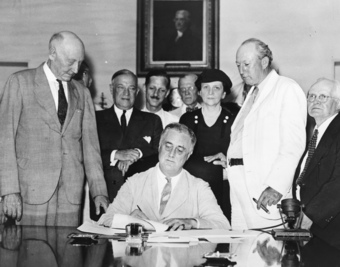
FDR Signs the Social Security Act
President Roosevelt signs the Social Security Act, at approximately 3:30 pm EST on August 14, 1935. Standing with Roosevelt are Rep. Robert Doughton (D-NC); unknown person in shadow; Sen. Robert Wagner (D-NY); Rep. John Dingell (D-MI); unknown man in bowtie; the Secretary of Labor, Frances Perkins; Sen. Pat Harrison (D-MS); and Rep. David Lewis (D-MD).
Social security grew rapidly and is one of the largest government spending initiatives in the United States today. In 1937, OASDI had 53,236 beneficiaries and cost the federal government $1,278,000. In 2008, it had 50,898, 244 beneficiaries and cost the federal government $615,344,000,000. It is largely credited with significantly reducing poverty rates among the elderly. But how does social security work? Social security was designed to redistribute wealth temporarily to help seniors finance their lives post-retirement. The current workforce is taxed, the results of which flow into a special fund designed for social security. Payments are then made to retirees. This is not, however, simple redistribution, as the current workforce contributing to the fund will then retrieve payments once they retire. Thus, it is a cross between a redistribution system and a savings account.
However, the structure of the social security system has put the entire program into serious financial distress. Currently, more money is being taken in by the fund through taxing the current workforce than is being paid out to retirees. However, this will soon change. If the laws governing social security are not changed by 2017, social security will pay out more funds than it takes in. According to analyses of the program, for about twenty years after 2017, the Social Security Trust Fund, or the amount of money that went into a special fund when there was a surplus in revenue, will make up the difference in payments. However, by 2037, the Social Security Trust Fund reserves will be exhausted and payments to beneficiaries will drop to about 75% of what they would have otherwise received.
18.4.2: Intergenerational Conflict
Intergenerational conflict refers to the conflict between older and younger generations as they compete for jobs and resources.
Learning Objective
Discuss the conflict perspective of aging in terms of the generational divide and competition for employment and resources (which equal power)
Key Points
- According to the conflict perspective of aging, generations are competing over jobs.
- The inequities in resource distribution reflect larger disparities in power between generations.
- Whichever generation happens to be middle-aged at any given point in time is the most powerful compared to the old and the young.
- Members of the powerful generation act as gatekeepers for the distribution of resources and powers to be in line with their own interests. Power is therefore maintained by the middle-class, perpetuating their monopoly on resources.
- This perspective of aging derives from larger sociological conflict theory.
Key Terms
- conflict theory
-
A social science perspective that holds that stratification is dysfunctional and harmful in society, with inequality perpetuated because it benefits the rich and powerful at the expense of the poor.
- conflict perspective of aging
-
According to the conflict perspective of aging, generations are competing over jobs. The theory developed in 1980s as unemployment rose dramatically.
Intergenerational conflict plays a key role in the conflict perspective of aging. This social theory suggests that conflict between older and younger generations occurs as they compete for resources and jobs . The conflict perspective of aging is a strand of general sociological conflict theory, which is the theory that sees conflict as a normal aspect of social life rather than as an abnormal occurrence.

At the Intersection of Generation: Conflict or Cooperation?
According to conflict theory, generations of people are in competition with one another for power and resources. Could this occur even at the micro-level?
Conflict theory has three main premises: first, that society is comprised of different groups that compete for resources; second, that despite social attempts to portray a sense of cooperation, a continual power struggle exists between social groups as they pursue their own divergent and competing interests; third, social groups will use resources to their own advantage in pursuit of their own goals, even if it means taking advantage of another group of people.
The conflict perspective of aging thus emphasizes competition between generations. According to the conflict perspective of aging, generations are competing over jobs. The theory developed in 1980s as unemployment rose dramatically. As jobs became increasingly scarce, younger and older generations both felt pressure to compete over available resources, enabling competition between the generational divide. As such, the economic climate of the era in which the theory developed influenced the content of the theory itself.
The conflict perspective of aging is not solely about resource acquisition. Rather, resources stand for power. This perspective on aging maintains that whichever generation happens to be middle-aged at any given point in time is the most powerful compared to the old and the young. Members of the powerful generation act as gatekeepers and orchestrate the distribution of resources and powers to be in line with their own interests, often at the exclusion of the needs of other individuals and generations. Power is therefore maintained by the middle-class, perpetuating their monopoly on resources. This tension, and subsequent competition, is precisely what is addressed by the conflict perspective of aging.
18.5: The Symbolic-Interactionist Perspective on Aging
18.5.1: The Symbolic Interactionist Perspective
The symbolic interactionist perspective posits that age is socially constructed and determined by symbols resembling social interactions.
Learning Objective
Argue that the perception of aging is better either in the United States or in Japan, using Goffman’s theory of social presentation
Key Points
- The notion of age is socially constructed, meaning that it has no universal value. Rather, various cultures ascribe aging with different meanings and values.
- In The Presentation of Self in Everyday Life, Erving Goffman argued that people try to control or guide the impression they create on other people by comporting themselves in specific ways.
- The desire to look younger than one’s biological years is frequently the impetus for cosmetic surgeries that can hide the physical effects of aging. These surgical practices suggest a Goffmanian understanding of social presentation.
- Social value is highly dependent on context and culture. Many Eastern societies associate old age with wisdom and value old age much more than their Western counterparts.
Key Terms
- socially constructed
-
The social construction of age means that there is no inherent cultural meaning to the biological process of aging.
- Erving Goffman
-
Erving Goffman (June 11, 1922 – November 19, 1982) was a Canadian-born sociologist and writer. The 73rd president of American Sociological Association, Goffman’s greatest contribution to social theory was his study of symbolic interaction in the form of dramaturgical analysis. This began with his 1959 book, The Presentation of Self in Everyday Life.
Example
- While in Japan, the elderly hold an esteemed position in society, which is evident from the fact that they celebrate Respect for the Aged Day, in the United States youth is often more highly valued.
The Symbolic Interactionist Perspective and Aging
According to the Symbolic Interactionist Perspective, old age, and aging, are socially constructed and determined by symbols that resemble aging in social interactions. While aging itself is a biological process, the Symbolic Interactionist Perspective posits that the meaning behind being “young” or “old” is socially constructed. This means that there is no inherent cultural meaning attached to the biological process of aging. Rather, cultures imbue youth and age with particular meanings. Given the socially constructed nature of age, there are certain behaviors that people typically associate with certain age groups as being “appropriate” or “acceptable” .

Is this Incongruous?
Given the socially constructed nature of age, there are certain behaviors that people typically associate with certain age groups as being “appropriate” or “acceptable. ” Is this old woman challenging any conventional perceptions about how women of a certain age should behave?
Aging is perceived differently around the world, demonstrating its social construction. Frequently, the average life expectancy in a given region impacts what age counts as “old.” For example, in the United States, where the average life expectancy is over 78 years, one isn’t considered “old” until he or she is in their sixties or seventies. However, in Chad, the average life expectancy is less than 49 years, and people in their thirties or forties are therefore already considered middle-aged or “old.” These variations in people’s perceptions indicate that notions of youth and age are culturally constructed, and that there is no such thing as a universal age at which point one becomes old.
Japanese Perceptions of Aging
In addition to defining terms differently, cultures treat their elderly differently and place different values on age. Many Eastern societies associate old age with wisdom and value old age much more than their Western counterparts. In Japan, adult children are expected to care for their aging parents in different ways than in the United States. 65% of Japanese elders live with their children, and very few live in nursing homes. In Japan, if a youth was to put an aging parent in an assisted living home, the behavior would be considered tantamount to neglect. Cultural norms suggest that parents should move in with their children when they are unable to care for themselves. The Japanese celebration of old age is further illustrated by the existence of Respect for the Aged Day, a national holiday to celebrate elderly citizens.
Western Perceptions of Aging
Japanese perceptions of elders diverge markedly from public perceptions of old age in the United States. Western societies tend to place such an increased value on youth that many people take extreme measures to appear young. A desire to look younger is frequently the impetus for cosmetic surgeries that can hide the physical effects of aging. These surgical practices, combined with huge expenditures on makeup and clothing, suggest a Goffmanianunderstanding of social presentation. Erving Goffman was a sociologist writing in the mid-twentieth century. His most famous work, The Presentation of Self in Everyday Life (1959), argued that whenever individuals come into contact with other people, they will attempt to control or guide the impression that others might have of them by intentionally comporting themselves in different ways. Thus, individuals take sometimes drastic action to control the appearance of their age so that others will perceive them as younger. Significantly, these social interactions occur in a social milieu that values youth. In this light, people try to appear younger to increase their sense of social value.
18.6: Challenges of Aging
18.6.1: Social Isolation
Social isolation is common in elderly populations and refers to a complete or near-complete lack of contact with other people.
Learning Objective
Examine the implications of social isolation and how elderly adults are a susceptible population to the effects
Key Points
- As their health deteriorates and friends and spouses die, elders are at an increased risk for social isolation.
- Social isolation is distinct from loneliness, the latter often being considered to be the subjective counterpart of the former.
- Late life depression is the onset of depression for the first time in a person over sixty years of age.
- Consequences of social isolation can be dangerous, particularly for individuals already predisposed to health problems. Studies have demonstrated that seniors who are socially isolated seniors are less likely to take advantage of health and social services
Key Terms
- social isolation
-
Social isolation refers to a complete or near-complete lack of contact with society. It is usually involuntary, making it distinct from isolating tendencies or actions taken by an individual who is seeking to distance himself from society.
- late life depression
-
Late life depression is the onset of depression for the first time in a person over sixty years of age.
- loneliness
-
The condition of being lonely; solitude; seclusion.
Human beings, by nature, are social creatures. Throughout the socialization process, we become accustomed to living in groups and interacting with others. Individuals in every society, however, at times must cope with social isolation, which is defined as a complete or near-complete lack of contact with others in society. Social isolation is usually involuntary, making it distinct from the isolating tendencies some individuals may have that lead them to purposefully distance themselves from others.
Social isolation is also distinct from loneliness. Loneliness is a subjective experience associated with a temporary lack of contact with other humans. Social isolation, by contrast, can be objectively measured in terms of a person’s social contacts and relationships.
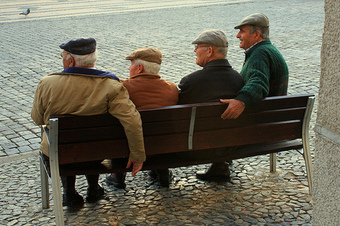
Friends
Maintaining friendships and building relationships is an important aspect of old age that wards off social isolation.
Any individual from any segment of society may be socially isolated, but senior citizens are especially susceptible to the risk factors that may trigger social isolation. These include living alone, family violence, loss of a spouse, aging-related cognitive impairments and disabilities, and transport issues. Consequences of social isolation can be dangerous, particularly for individuals already predisposed to health problems. Studies have demonstrated that seniors who are socially isolated seniors are less likely to take advantage of health and social services. This indicates a circularity of social isolation and health: individuals who are already marginalized are not pushed toward healthcare and individuals with quickly deteriorating health are more likely to be socially isolated. Extended social isolation can contribute tolate life depression, which is a major depressive episode occurring for the first time in an individual over sixty years of age.
Social isolation is a larger problem for elders now than in the past, due to the decreasing size of families in Western countries. In the past, elders were not at increased risk for social isolation because they would move in with their children. Now, many elders are moved into elder homes with less frequent contact with their children. However, many elder homes and retirement facilities are working to combat social isolation by increasing programming for their residents.
18.6.2: Prejudice
Ageism is the discrimination of groups because of their age, and applies especially to the elderly.
Learning Objective
Examine the concept of ageism and the impact of stereotypes for elderly adults
Key Points
- Elders frequently encounter prejudice as others assume stereotypes about them to be true.
- The idea of ageism was developed by gerontologist Robert Neil Butler.
- Prejudices most frequently surface in the course of medical treatment and in the workplace.
Key Terms
- term limit
-
A legal restriction that limits the number of terms a person may serve in a particular elected office.
- ageism
-
The treating of a person or people differently from others based on assumptions or stereotypes relating to their age.
Example
- Ageist attitudes typically depict older adults to be infirm, sedentary and generally incapable of leading an active and exciting lifestyle. Mickey Hart, one of the two drummers of the iconic rock band, the Grateful Dead, is one of many examples that contradicts this image of “older people. ” At age 68, Hart continues to perform and tour the country and, as of 2006, became a part of a new band known as the “Rhythm Devils. “
Ageism
Ageism is the stereotyping and discrimination against individuals or groups because of their age. Ageism can be applied to discrimination against any age group, such as discrimination against teenagers, but this section will focus on ageist discrimination against seniors. The term was coined in reference to discriminatory practices against the elderly by gerontologist Robert Neil Butler. He coined the term by intentionally mirroring it after other forms of discrimination, such as sexism or racism.
Stereotypes of the Elderly
Many people are prejudiced against seniors, beginning with the common stereotypes of older adults . Old people are frequently assumed to be in poor physical or mental health and lack psychological agility. It is a common presumption that, as people age, they become more inflexible and conservative in their opinions. Older adults are frequently presumed to be poor drivers. In fact, studies have demonstrated that older drivers, up until the age of about 75, are actually safer drivers than young drivers. Unfortunately, elder patients are frequently discriminated against in the course of medical treatment due to stereotypes based on their age. Studies have demonstrated that elder patients are less likely to have their medical care explained to them, partially because physicians assume that they are unable to understand medical complexities.

Age is just a Number
This man clearly defies ageist perceptions of older people as being physically infirm and weak.
Elderly Prejudice in the Workplace
Older adults commonly encounter prejudice in the workplace. It is frequently assumed that an elderly person is mentally inept and incompetent. Employment discrimination, or the presence of discrimination against a targeted group in the workplace, manifests in two different ways vis-à-vis elderly workers. Individuals who began working for a company in their younger years can be pushed out as they age. This process refers to company management redirecting clients away from the older employees and toward the younger employees.
Alternatively, companies may not hire older employees to begin with. Joanna Lahey, a professor at the Bush School of Government and Public Service at Texas A&M University, has found that firms are 40% more likely to give a hiring interview to a younger candidate than to an older candidate. This suggests that firms are more interested in hiring younger employees than older employees. The government has tried to combat age discrimination through laws such as the federal Age Discrimination in Employment Act of 1967 which forbids employers from discriminating against employees over the age of forty. This goes against the age stratification theory of society, which states the unequal distribution of wealth, power and privileges among people at different stages in the life course. According to age stratification theory, younger and older people should be a disadvantages due to their position in life, whereas middle-age people would be at at advantage.
Aging and its impact on the workforce is also an issue for certain sectors of government. The issue has been highlighted as it pertains to the United States Supreme Court. Justices at the Supreme Court are given lifetime appointments, meaning that they do not have to retire or step down from the bench until they choose to or until their deaths. However, as in any other workplace, the potential senility of aging Supreme Court justices has been hotly debated.
Former Chief Justice William Rehnquist, for example, was appointed to the Supreme Court in 1986 and served until his death in 2005. He was only weeks shy of his eighty-first birthday when he died and had been in declining health for the last few years of his life. Treatment for anaplastic throat cancer forced him to miss many arguments in the year before his death. Rehnquist’s death reignited a political debate about instating term limits for Supreme Court justices in place of lifetime appointments, such that a justice would be forced to retire after a certain number of years. There are many political and legal reasons supporting both sides of the debate, but assumptions about the declining health of older justices, many of whom serve on the court into their seventies, play a prominent role in the discussion.
18.6.3: Elder Abuse
Elder abuse is the use of physical or mental harm against people of an older age.
Learning Objective
Analyze the various types of elder abuse and the implications each has for an elderly person’s quality of life
Key Points
- Elder abuse is an umbrella term that refers to all types of abuses against older adults perpetrated by trusted individuals upon whom these elderly people typically depend.
- Domestic elder abuse is committed by an elder’s family or friends, while institutional elder abuse is committed by employees at facilities and institutions designated to take care of elders.
- Grooming occurs when friends or neighbors build relationships of trust with elders in order to gain control of their finances.
Key Terms
- grooming
-
Grooming occurs when friends or neighbors build relationships of trust with elders in order to gain control of their finances.
- domestic elder abuse
-
Domestic elder abuse is committed by an elder’s family or friends.
- institutional elder abuse
-
Institutional elder abuse is committed by workers at residential facilities for elders, such as nursing homes.
Elder abuse is an umbrella term that refers to harm done to older adults. Typically, the harm is committed through intentional or neglectful acts by a caregiver or “trusted” individual that cause physical or emotional harm. A significant factor that distinguishes elder abuse from other types of harmful behavior involves the commission of harms where there is an expectation of trust extending from the older person to his abuser .

Elder Abuse
Imagine if the people elders depended on the most, such as these community transport service workers, were to breach that trust and abuse them.
Types of Elder Abuse
Elder abuse is illegal; special protections have been established to protect elders who are dependent upon others. However, because elder abuse is such a wide-reaching term, it can be difficult for different jurisdictions to define the term for legal usage. The main types of elder abuse include physical abuse, emotional abuse, financial abuse, sexual abuse, and neglect. Physical abuse of elders includes the hitting, punching, slapping, burning, pushing, kicking, restraining, or false imprisonment of elders. Additionally, giving an elder excessive or improper medication qualifies as physical abuse.
Emotional abuse includes shouting, swearing, frightening, or humiliating an elder. Financial abuse is the illegal or unauthorized use of a person’s property, money, pension, or will. Sexual abuse for elders is when an elder is forced to take part in any sexual activity, including participating in conversations of an unwanted sexual nature. Elders with dementia may not be able to consent to any sexual activity whatsoever. Neglect includes depriving an elder of food, heat, clothing, or essential medication. Deprivation may be active or passive, occurring intentionally or from a lack of knowledge. Elder abuse is further subdivided into domestic elder abuse and institutional elder abuse. Domestic elder abuses are committed by family and friends of an older person; institutional elder abuse is committed by workers at residential facilities for elders, such as nursing homes.
Grooming
Regardless of whether the perpetrator is a family member, friend, or institutional caretaker for an older person, a central theme throughout all of these different types of abuses is the relationship of dependency of elders with those who care for them. Serious offenses can be committed by abusive groomers through grooming an older person by befriending him or her in order to build trusting relationships that can then be exploited. Older people living with no adult children nearby are particularly vulnerable to grooming by neighbors and friends who might seek to gain control of their estates. Unfortunately, the nature of dependency inherent to elder abuse can make cases of elder abuse especially difficult to prosecute. For example, an elder might not believe that someone close to him is taking his money or might be persuaded to report that he wanted it as such, when this wasn’t the case. Elders are a particularly vulnerable population because they are dependent upon others and may even be senile, which makes it easier for them to be manipulated.
Consequences of Elder Abuse
Elder abuse can have serious consequences. Elder abuse can destroy a victim’s quality of life by limiting his functional abilities, increasing dependency, increasing his sense of helplessness, increasing stress, worsening his psychological decline, inducing dementia, and risking malnutrition or overmedication. Elder abuse can even result in death.
Of course, the horrible consequences listed above can arise directly from the physical abuse of a victim. Additionally, while an elder may be too senile to comprehend the abusive relationship, stress can seep through his lack of comprehension and perpetuate and even exacerbate preexisting health problems. The risk of death for elder abuse victims is three times higher than for non-victims.
18.6.4: Health Problems
Although health problems rise when one comes into older age, social effects also exacerbate of medical ailments by the elderly.
Learning Objective
Discuss the health issues associated with aging, such as heart disease, cancer and neuropsychological disorders
Key Points
- As we age, we experience health problems with greater frequency.
- Cardiovascular problems, cancer, and dementia are common problems for the elderly.
- Geriatrics is a field of medicine that concentrates on treating the medical problems of older adults.
- An elderly person’s social environment has serious consequences on the type of care received and the effect it has on the individual’s health.
Key Terms
- geriatrics
-
The branch of medicine that focuses on health promotion and the prevention and treatment of disease and disability in later life. The term itself can be distinguished from gerontology, which is the study of the aging process itself.
- arteriosclerosis
-
Hardening, narrowing or loss of elasticity in arteries or blood vessels.
- dementia
-
A progressive decline in cognitive function due to damage or disease in the brain—beyond what might be expected from normal aging. Areas particularly affected include memory, attention, judgement, language and problem solving.
As we age, we face more and more health problems. According to the Centers for Disease Control and Prevention, the leading causes of death for Americans are heart disease and cancer. Statistically, heart disease and cancer account for the most American deaths by far. In 2009, heart disease claimed 599,413 lives and cancer was responsible for 567, 628 deaths. Of course, these numbers include all ill individuals, not just the elderly.
Heart Disease
Because of the prevalence of heart disease and cancer among the elderly, many American hospitals have developed programs to treat seniors with these particular afflictions. Geriatrics is the field of medicine that specializes in treating older adults. Cardiogeriatrics refers to the branch of healthcare that treats heart disease in older adults. Heart disease is common in seniors because as one ages, one’s heart muscle begins to weaken and change in adverse ways. As the heart ages, one can develop arteriosclerosis, or the stiffening of arteries due to the accumulation of fatty buildup, or plaque, along the walls of the arteriesm, restricting blood circulation. Arteriosclerosis is common to older adults that contributes to congestive heart failure. This is the condition defined by the inability of the heart to provide adequate blood flow to the body.
Congestive heart failure is common, costly, disabling, and potentially deadly. In developed countries, around 2% of adults suffer from heart failure. Risk rises with age. In developed countries, 6–10% of adults over the age of 65 suffer from congestive heart failure. Congestive heart failure increases the risk that one will experience a myocardial infarction, or heart attack.
In a heart attack, blood supply to the heart is interrupted, causing damage to the heart muscle. When blood flow is stopped from going to the brain, usually due to a blood clot, one suffers from a stroke. Americans have more than 700,000 strokes every year, making it the third leading cause of death in the United States after heart disease and cancer. Nearly 75 percent of strokes occur in people over the age of 65, and the risk of having a stroke more than doubles during each decade between the ages of 55 and 85.
Cancer
Other than cardiovascular diseases, cancer is the most common, serious illness faced by the elderly. While anyone can develop cancer, the risk of getting certain cancers increases with age. Breast, colorectal, prostate, pancreatic, lung, bladder, and stomach cancers are especially linked to aging. Cancer can be even more difficult to treat in the elderly than in younger patients because treatment can be stressful on the body. Treating cancer involves some combination of radiation, chemotherapy, or surgery, all of which are more stressful on an aged body than a younger body. Recognition of the stress that treatment may have on an older body limits the options available for treatment.
Neuropsychological Disorders
Older adults are also more susceptible to certain neuropsychological disorders, such as dementia and Alzheimer’s disease, that are virtually unseen in younger populations. Dementia is a serious loss of global cognitive ability in a previously unimpaired person—beyond what might be expected from normal aging. It may be static—the result of a unique brain injury—or progressive—resulting in long-term decline due to damage or disease in the body. Dementia is not a single disease, but rather a syndrome that is associated with a variety of different diseases, such as Alzheimer’s. Symptoms of Alzheimer’s include confusion, irritability, aggression, mood swings, difficulty with language, and memory loss. Most often, Alzheimer’s disease is diagnosed in people over the age of 65. In 2006, there were 26.6 million sufferers worldwide. One in eight Americans over the age of 65 suffers from Alzheimer’s and that number is set to rise in future years as the average lifespan continues to rise.
Obviously, aging presents serious concerns about health. A person’s body is more likely to encounter disease as he or she ages. Frequently, preexisting medical ailments are exacerbated by social determinants of health. Social determinants of health are the extra-biological factors that influence how individuals experience their own health. For example, congestive heart failure does not necessarily kill someone. However, the patient with congestive heart failure is most likely going to be put on a complicated medication regime. Congestive heart failure combined with dementia—or even normal forgetfulness associated with aging—makes adhering to a strict regimen difficult for many older adults. The elderly are frequently dependent on younger adults for assistance. The types of care to which the elderly have access can have serious medical consequences.

Studying Alzheimer’s Disease in the Argonne National Laboratory
Mark Davidson (left), University of Florida, and Joanna Collingwood, Keele University, scrutinize a sample of Alzheimer’s brain tissue.
Chapter 17: Population and Urbanization
17.1: Population Dynamics
17.1.1: Fertility
There are a number of different ways, taking different factors into account, to measure fertility rate.
Learning Objective
Examine the impact of fertility rates on society and the various ways fertility is computed and discussed
Key Points
- There are a number of different approaches to measuring fertility rate—such as crude birth rate (CBR), general fertility rate (GFR), child-woman ratio (CWR), total fertility rate (TFR), gross reproduction rate (GRR), and net reproduction rate (NRR).
- Fertility rates are influenced by a number of factors, including intentional measures such as contraception and major social events.
- Demographers have posited a demographic-economic paradox, in which fertility rates decline as countries become more economically developed.
- Almost universally, higher levels of educational attainment correspond to lower fertility rates.
Key Terms
- fecundity
-
Ability to produce offspring.
- contraception
-
The use of a device or procedure to prevent conception as a result of sexual activity.
- fertility
-
The birthrate of a population; the number of live births per 1000 people per year.
Example
- Replacement level refers to the fertility rate needed to maintain a stable population size. Imagine that you have a fish tank with four fish, and that every year, one fish dies. In order to meet the replacement level, one new fish would have to be born every year to maintain a population of four fish over time. If three of the original fish were female and capable of laying an egg, they would have to exhibit a fertility rate of .33 to reach replacement level.
In demography, fertility refers to the actual production of offspring, rather than the physical capability to produce, which is called fecundity. To estimate how quickly a population is growing, demographers must know how frequently people are added to the population by being born, so they measure fertility. There are a number of different approaches to measuring fertility rate—such as crude birth rate (CBR), general fertility rate (GFR), child-woman ratio (CWR), total fertility rate (TFR), gross reproduction rate (GRR), and net reproduction rate (NRR).
Period Measures
Crude birth rate (CBR) is the number of live births in a given year per 1,000 people alive at the middle of that year. General fertility rate (GFR) is the number of births in a year divided by the number of women of childbearing age (usually 15 to 49 years old, or sometimes 15 to 44 years old), times 1000. It focuses on potential mothers only, and takes the age distribution into account. Child-Woman Ratio (CWR) is the ratio of the number of children under 5 to the number of women 15-49, times 1000.
Cohort Measures
Age-specific fertility rate (ASFR) is the number of births in a year to women in a 5-year age group, divided by the number of all women in that age group, times 1000. The usual age groups are 10-14, 15-19, 20-24, etc.
Total fertility rate (TFR) is the total number of children a woman would bear during her lifetime if she were to experience the prevailing age-specific fertility rates of women and survive until the end of her reproductive life . TFR equals the sum for all age groups of 5 times each ASFR rate. The TFR is a synthetic rate, not based on the fertility of any real group of women since this would involve waiting until they had completed childbearing. The TFR represents the average number of children a woman would have were she to fast-forward through all her childbearing years in a single year, under all the age-specific fertility rates for that year.

Total Fertility Rate
This map shows countries coded by total fertility rates, with 0-1 children at the bottom of the spectrum and 7-8 at the top. A number of factors, such as development index and religious tradition, contribute to variations in fertility rates.
The TFR (or TPFR—total period fertility rate) is a better index of fertility than the crude birth rate because it is independent of the age structure of the population, but it is a poorer estimate of actual completed family size than the total cohort fertility rate. In particular, the TFR does not necessarily predict how many children young women now will eventually have, as their fertility rates in years to come may change from those of older women now.
Gross reproduction rate (GRR) is the number of girl babies who would be born to a woman completing her reproductive life at current age-specific fertility rates. It assumes that all of the baby girls will grow up and live to at least age 50. Like the TFR, the GRR ignores life expectancy. It assumes that all women will survive at least until the end of their reproductive lives.
Net reproduction rate (NRR) starts with the GRR and adds the realistic assumption that some of the women will die before age 59; therefore they will not be alive to bear some of the potential babies that were counted in the GRR. NRR is always lower than GRR, but in countries where mortality is very low, almost all the baby girls grow up to be potential mothers, and the NRR is practically the same as GRR.
Factors Impacting Fertility
Human fertility depends on a long list of factors, including physical health and nutrition, sexual behavior, culture, instinct, endocrinology, timing, economics, way of life, and emotions. Fertility rates vary among countries and cultures because these factors vary. Demographers study the factors that affect fertility in order to better understand fertility patterns and their variance. Three of the major categories they study are physical health and nutrition, sexual behavior and human fertility, and political issues regarding childbirth and childrearing.
Population Control
The birth rate is an issue of concern for many governments and policymakers. Some, including those of Italy and Malaysia, seek to increase the national birth rate using pronatal measures such as financial incentives to new mothers. Conversely, other countries have policies to reduce the birth rate, such as China’s former one-child policy.
In some places, government policies have been focused on reducing birth rates by improving women’s sexual and reproductive health and rights. Typically, high birth rates have been associated with health impairments and low life expectancy, low living standards, low status of women, and low levels of education. There are claims that as countries go through economic development and social change, birth rate declines. Indeed, demographers consistently find that one of the strongest predictors of fertility rates is women’s educational attainment. Almost universally, higher levels of educational attainment correspond to lower fertility rates.
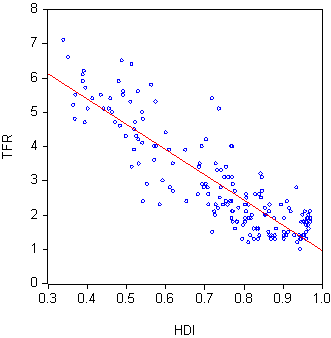
Fertility Rate and Human Development Index
Fertility has been found to correlate to human development index, with more developed countries having lower fertility rates than less developed ones.
17.1.2: Mortality
Mortality rate measures the number of deaths in a population over a given period of time.
Learning Objective
Explain the various ways mortality is calculated, such as the crude death rate, infant mortality rate and life expectancy
Key Points
- Like fertility, mortality rate can be measured in a number of ways.
- Specific measures of mortality include the crude death rate, the infant mortality rate, and life expectancy.
- Infant mortality rates measure the annual number of deaths of chldren less than 1 year old per thousand live births.
- Life expectancy measures the number of years that an individual at a given age can expect to live, given present mortality rates.
- Different causes of death become more or less prevalent as countries become more economically developed, and death rates vary between countries.
- Different causes of death become more or less prevalent as countries become more economically developed, and death rates vary between countries.
Key Terms
- crude death rate
-
the total number of deaths per year per 1000 people
- life table
-
In actuarial science and demography, a life table is a table which shows, for each age, what the probability is that a person of that age will die before his or her next birthday (“probability of death”).
- Causes of death
-
The causes of death tend to vary between countries. For example, mortality due to malnutrition tends to be much higher in developing countries, whereas in developed countries, people are more likely to die of age-related diseases.
Examples
- If you have a tank of one thousand goldfish and 100 die in the first year, they exhibit a mortality rate, or crude death rate, of 100 deaths/1000 members of the population, or 10%.
- Men and women may have different life expectancies, so mortality rates can vary with the gender distribution of a population. Thus, for example, the number of deaths per 1000 people can be higher for developed nations than in less-developed countries, despite life expectancy being higher in developed countries due to standards of health being better.
Mortality rate is a measure of the number of deaths (in general, or due to a specific cause) in a particular population, scaled to the size of that population, per unit of time. Mortality rate is typically expressed in units of deaths per 1,000 individuals per year; thus, a mortality rate of 9.5 (out of 1,000) in a population of 1,000 would mean 9.5 deaths per year in that entire population, or 0.95% out of the total. This measure is also called the crude death rate. As of July 2009 the crude death rate for the whole world is about 8.37 per 1000 per year according to the current CIA World Factbook.
Just as demographers measure fertility in different ways, they also measure mortality in various ways. Some of the more common demographic measures of mortality include the crude death rate (the annual number of deaths per 1000 people), the infant mortality rate, or the annual number of deaths of children less than 1 year old per thousand live births, and life expectancy, which measures the number of years that an individual at a given age can expect to live, given present mortality rates.
Like fertility, mortality also depends on the age and gender distribution of a population. Older people are more likely to die, so countries with a higher proportion of old people may also have a higher mortality rate. Similarly, men and women may have different life expectancies; therefore, mortality rates can vary with the gender distribution of a population. Thus, for example, the number of deaths per 1000 people can be higher for developed nations than in less-developed countries, despite life expectancy being higher in developed countries due to better standards of health. This happens because developed countries typically have a completely different population age distribution, with a much higher proportion of older people, due to both lower recent birth rates and lower mortality rates.
To more accurately estimate mortality rates, demographers calculate age and gender specific mortality rates. These rates are compiled in a life table, which shows the mortality rate separate for each age group and gender. A life table is necessary to give a good estimate of life expectancy.
Like fertility, mortality rates vary between countries, especially between developing and developed countries. Overall, developing countries tend to have higher mortality rates, higher infant mortality rates, and lower life expectancies. The causes of death also tend to vary between countries. For example, mortality due to malnutrition tends to be much higher in developing countries, whereas in developed countries, people are more likely to die of age-related diseases.
Sociologists have theorized that one of the best predictors of longevity, or a high life expectancy, is education, even when other factors are controlled, people with more education tend to live longer. A few additional years of schooling statistically corresponds to several additional years of life expectancy and vastly improved health in old age. The mechanism through which this works is not the schooling itself, but rather schooling’s influence on other health-related behaviors. Education tends to lower the likelihood of smoking and engaging in unhealthy and high risk behaviors. Education also increases the probability of engaging in healthy behaviors, like exercise.
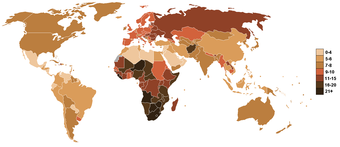
Crude Death Rate by Country
The crude death rate is a measure of how many people per 1000 members of a population die each year. It varies between countries based on various economic, social, and environmental factors.
17.1.3: Migration
Migration is the movement by people from one place to another.
Learning Objective
Discuss the types of migration in society and the various theories that explain migration
Key Points
- Migration is the physical movement by people from one place to another; it may be over long distances, such as from one country to another, and can occur as individuals, family units, or large groups.
- Lee’s laws divide factors causing migrations into two groups of factors: push and pull factors. Push factors are things that are unfavorable about the area that an immigrant is coming from; pull factors are things that attract the immigrant to the new location.
- Types of migration include seasonal migration, urbanization, suburbanization, and forced migration.
- International migration is known as immigration.
- Sociologists use multiple theories to explain migration based on economic and social factors.
Key Terms
- immigration
-
The passing or coming of a person into a country for the purpose of permanent residence.
- emigration
-
The movement of a person or persons out of a country or national region, for the purpose of permanent relocation of residence.
- Seasonal migration
-
Movement from one place to another generally associated with agriculture and tourism; seasonal agricultural migrants follow crop cycles, moving from place to place to plant or harvest crops.
Example
- An example of internal migration that is motivated by both social and economic factors is the trend among young, well-educated Americans to move to large cities after college or graduate school. This migration pattern, which abandoned cities refer to as “the brain drain,” occurs as young graduates seek high-paying jobs and powerful social networks.
Human Migration
Migration is the physical movement by people from one place to another; it may be over long distances, such as from one country to another, and can occur as individuals, family units, or large groups. When referring to international movement, migration is generally called immigration.
Lee’s laws divide factors causing migrations into two groups of factors: push and pull factors. Push factors are things that are unfavorable about the area that an immigrant is coming from; pull factors are things that attract the immigrant to the new location.Historically, migration has been nomadic, meaning people sustained movement from place to place over their lifetimes. Although only a few nomadic people have retained this lifestyle in modern times, migration continues as both involuntary migration (such as the slave trade, human trafficking, and ethnic cleansing) and voluntary migration within a region, country, or beyond. Specific types of migrants can include colonizers (who forcefully enter into a country or territory), refugees (who are forced to flee their country), and temporary migrants (who travel to a new place temporarily, such as business travelers, tourists, or seasonal farm workers).
Along with fertility and mortality, migration is one of three major variables studied by demographers to measure population change.
Types of Migration
Seasonal migration is generally associated with agriculture and tourism. Seasonal agricultural migrants follow crop cycles, moving from place to place to plant or harvest crops. Some countries, including the United States, allow special permits for seasonal agricultural workers to temporarily work in the country without granting full citizenship rights. Seasonal tourists seek out certain natural amenities, like snow-capped mountains for skiing and winter sports or desert sunshine for a break from oppressive winters.
Urbanization refers to migration from rural to urban areas. Since the 1970s, urbanization has become more common in developing countries, where industrialization has made agriculture more efficient and has increased the demand for urban labor. Previously, massive urbanization also took place in developed countries; beginning in Britain in the late eighteenth century, millions of agricultural workers left the countryside and moved to the cities.
Industrialization also sparked transnational labor migration that has further swelled urban populations. In the early twentieth century, transnational labor migration reached a peak of three million migrants per year. During this period, emigration rates were especially high in Italy, Norway, Ireland and the Guangdong region of China.
In the United States, industrialization also led to considerable internal migration (or human migration within a nation) of African Americans from the rural South to the urban North. From 1910-1970, approximately seven million African Americans migrated north to escape both poor economic opportunities and considerable political and social prejudice in the South. They settled in the industrial cities of the Northeast, Midwest, and West, where relatively well-paid jobs were available. This phenomenon came to be known in the United States as the Great Migration.
In many developed countries, urbanization has slowed and the population has begun to move out of cities — in some cases back to rural areas, but most frequently, to newly-built suburbs. The movement from cities to surrounding suburbs is called suburbanization and represents yet another form of internal migration.
Yet another kind of migration, forced migration refers to the coerced movement of a person or persons away from their home or home region. It has been a means of social control under authoritarian regimes, taking the form of ethnic cleansing, slave trades, human trafficking, and forced displacement.
Theories of Migration
According to neoclassical economic theory, labor migration is motivated primarily by wage differences between two geographic locations. These differences can usually be explained by differences in the supply of and demand for labor. Areas with a shortage of labor but an excess of capital will have a high relative wage, whereas areas with a high labor supply and a dearth of capital will have a low relative wage. Following neoclassical principles, migrants tend to move from low-wage areas to high-wage areas where their labor is in higher demand.
The new economics of labor migration theory criticizes neoclassical economic theory for its narrow focus on individual decisions. According to the new economics theory, migration flows and patterns cannot be explained solely at the level of individual workers and their economic incentives. Instead, wider social entities must be considered as well. One such social entity is the household. Migrants may choose to move in order to reduce the social and economic risk that a household experiences as a result of having insufficient income. The household, in this case, needs extra capital, which can be attained by family members who participate in migrant labor abroad and send money back home as remittances. These remittances can also have a broader effect on the economy of the receiving country as a whole as they bring in capital.
World systems theory looks at migration from a global perspective.It explains that interaction between different societies can be an important factor in social change within societies. Trade with one country, which causes economic decline in another, may create incentives to migrate to a country with a more vibrant economy. It can be argued that even after decolonization, the economic dependence of former colonies still remains.
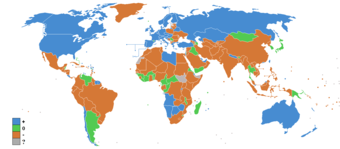
Net Migration Rates by Country
Social, economic, and environmental conditions (such as unemployment, drought, or conflict) can drive large numbers of people to migrate across national borders, as shown by this map. Positive migration rates are indicated in blue; negative migration rates in orange; stable in green; and no data in gray.
17.2: Population Growth
17.2.1: Implications of Different Rates of Growth
Different rates of growth can lead to overpopulation or underpopulation, both of which have potential consequences.
Learning Objective
Discuss the implications both overpopulation and underpopulation can have for society
Key Points
- When the fertility rate is at the replacement level, a population will remain stable, neither growing nor shrinking.
- Fertility rates above the replacement level will cause the population to grow; fertility rates below the replacement level will cause the population to shrink.
- Overpopulation is judged relative to carrying capacity and can have deleterious effects. When the population is too large for the available resources, famine, energy shortages, war, and disease can result.
- Recently, in some countries, sub-replacement fertility rates have led to underpopulation. This can lead to economic decline, the aging of the population, and poverty.
Key Terms
- fertility rate
-
The average number of children that would be born to a woman over her lifetime if she followed the current average pattern of fertility among a given group of women and survived through her reproductive years; used as an indicator of strength of population growth.
- Replacement level
-
Regarding fertility, refers to the number of children that a woman must have in order to replace the existing population.
- gross domestic product
-
(GDP) The market value of all officially recognized final goods and services produced within a country in a year; often used as an indicator of a country’s material standard of living.
- carrying capacity
-
The number of individuals of a particular species that an environment can support.
Examples
- Urban areas in developing countries, such as Mumbai, India, have developed massive slums as population growth has exceeded the amount of available land and housing.
- In countries such as Italy, slow population decline has worried policymakers as GDP growth depends upon a large, skilled labor pool and a strong consumer market.
Fertility rates refer to the rates of birth per 1,000 women of reproductive age in a given population. When the fertility rate is at the replacement level, a population will remain stable, neither growing nor shrinking. However, when the fertility rate deviates from the replacement level, the size of the population will change. Fertility rates above the replacement level will cause the population to grow; fertility rates below the replacement level will cause the population to shrink.
The population reached 6 billion people around 1999, and increased to around 7 billion by 2012. However, in some countries the birth rate is falling while the death rate is not, leading to a decline in the population growth rate. The population growth rate has been decreasing in higher income countries; however the number of people added to the global population each year continues to increase due to increasing growth rates in lower income countries.
Overpopulation
High fertility rates lead to population growth, which, under certain circumstances, can cause a condition known as “overpopulation. ” Overpopulation is not a function of the number or density of individuals, but rather the number of individuals compared to the resources they need to survive. In other words, it is a ratio: population to resources. Humans are not unique in their capacity for overpopulation; in general terms, overpopulation indicates a scenario in which the population of a living species exceeds the carrying capacity of its ecological niche.
When estimating whether an area is overpopulated, resources to be taken into account include clean water, food, shelter, arable land, and various social services (such as jobs, money, education, fuel, electricity, medicine, proper sewage and garbage management, and transportation).
Overpopulation can have deleterious effects. When population outstrips available resources, calamity can result, including famine, shortages of energy sources and other natural resources, rapid and uncontrolled spread of communicable diseases in dense populations, and war over scarce resources, such as land. Dense populations may also settle available land and crowd out other land uses, such as agriculture.
Different rates of growth
Presently, every year the world’s human population grows by approximately 80 million. However, that population growth is not distributed evenly across all countries. Most population growth comes from developing countries, where birthrates remain high. Meanwhile, about half the world lives in nations with sub-replacement fertility. In some of these countries, the population has actually begun to shrink (e.g., Russia). All of the nations of East Asia – with the exceptions of Mongolia, the Philippines, and Laos – have fertility rates below replacement level. Russia and Eastern Europe are dramatically below replacement fertility. Western Europe also is below replacement. In the Middle East Iran, Tunisia, Algeria, Turkey, and Lebanon are below replacement. Some countries still have growing populations due to high rates of immigration, but have native fertility rates below replacement: Canada, Australia, and New Zealand are similar to Western Europe, while the United States is just barely below replacement with about 2.0 births per woman.
A new fear for many governments, particularly those in countries with very low fertility rates, is that a declining population will lead to underpopulation and will reduce the gross domestic product (GDP) and economic growth of the country, as population growth is often a driving force of economic expansion. To combat extremely low fertility rates, some of these governments have introduced pro-family policies that include incentives, such as payments to parents for having children and extensive parental leave for parents.

Slums in Mumbai
Rapid population growth in Indian cities has resulted in vast slums as populations have exceeded available land and housing.
17.2.2: Three Demographic Variables
The basics of demographic population growth depend on the rate of natural increase (births versus deaths) and net migration.
Learning Objective
Explain how population growth is calculated
Key Points
- Demography is the statistical study of human populations. It encompasses the study of the size, structure, and distribution of these populations, and spatial and/or temporal changes in them in response to birth, migration, aging, and death.
- Population change depends on the rate of natural increase and net migration.
- Natural increase is calculated by the fertility rate minus the mortality rate.
- Net migration depends on in-migration and out-migration.
Key Terms
- mortality rate
-
The number of deaths per given unit of population over a given period of time.
- demography
-
The study of human populations and how they change.
- Net migration
-
The difference of immigrants and emigrants of an area in a period of time, divided (usually) per 1,000 inhabitants (considered on midterm population). A positive value represents more people entering the country than leaving it, while a negative value mean more people leaving than entering it.
- Natural increase
-
Population growth that depends on the fertility rate and the mortality rate.
Example
- The United States illustrates how the rate of natural increase and net migration combine to create population change—the fertility rate in the U.S. is at almost exactly replacement level, but migration into the country is high enough to lead to population growth.
Demography is the statistical study of human populations. It can be a very general science that can be applied to any kind of dynamic living population, or one that changes over time or space. It encompasses the study of the size, structure, and distribution of these populations, and spatial and/or temporal changes in them in response to birth, migration, aging, and death.
Human population growth depends on the rate of natural increase, or the fertility rate minus the mortality rate, and net migration. The basics of demography can be reduced to this formula:
(Births – Deaths) +/- ((In-Migration) – (Out Migration)) = Population Change.
As this equation shows, population change depends on three variables: (1) the natural increase changes seen in birth rates, (2) the natural decrease changes seen in death rates, and (3) the changes seen in migration. Changes in population size can be predicted based on changes in fertility, mortality, and migration rates.
Natural increase refers to the increase in population not due to migration, and it can be calculated with the fertility rate and the mortality rate. Net migration is the mathematical difference between those migrating into a country and those migrating out of a country.
This basic equation can be applied to populations and subpopulations. For example, the population size of ethnic groups or nationalities within a given society or country is subject to the same sources of change as the national population. However, when dealing with ethnic groups, “net migration” might have to be subdivided into physical migration and ethnic re-identification (assimilation). Individuals who change their ethnic self-labels or whose ethnic classification in government statistics changes over time may be thought of as migrating or moving from one population subcategory to another. More generally, while the basic demographic equation holds true by definition, the recording and counting of events (births, deaths, immigration, emigration) and the enumeration of the total population size are subject to error. Allowance needs to be made for error in the underlying statistics when any accounting of population size or change is made.

US Fertility Rate
The US fertility rate has leveled off at about 2.0, which is nearly equal to the replacement level. This means that population growth in the US is due to inward migration, rather than a high birthrate.
17.2.3: Problems in Forecasting Population Growth
Population growth is difficult to predict because unforeseen events can alter birth rates, death rates, migration, or resource limitations.
Learning Objective
Explain the various ways sociologist try to estimate the rate of population growth, such as through fertility, birth and death rates
Key Points
- Population forecasts try to estimate the rate of population growth. However, unpredictable factors can change fertility rates, mortality rates, or migration rates, which can cause difficulty in forecasting.
- Certain government policies are making it easier and more socially acceptable to use contraception and abortion methods. Likewise, some countries are instituting pro-natalist policies to encourage fertility.
- Malthusian catastrophe refers to a scenario where overpopulation would compromise global food security, leading to mass starvation.
- In the future, food production be increased by innovations such as genetically modified crops, more efficiently employing agricultural technology, and aquaculture. This would raise the limit on the number of people the world can support.
Key Terms
- forecast
-
An estimation of a future condition.
- Birth rates
-
The birth rate is typically the rate of births in a population over time. The rate of births in a population is calculated in several ways: live births from a universal registration system for births, deaths, and marriages; population counts from a census, and estimation through specialized demographic techniques.
- Green Revolution
-
Green Revolution refers to a series of research, development, and technology transfer initiatives, occurring between the 1940s and the late 1970s, that increased agriculture production around the world, beginning most markedly in the late 1960s
Examples
- The Green Revolution is an example of rapidly changing technology that lowered worldwide death rates, thus throwing off estimates of population change.
- Worldwide, nearly 40% of pregnancies are unintended (some 80 million unintended pregnancies each year). An estimated 350 million women in the poorest countries of the world either did not want their last child, do not want another child or want to space their pregnancies, but they lack access to information, affordable means and services to determine the size and spacing of their families.
Forecasts try to estimate the rate of population growth, but this is understandably difficult to predict. For example, the UN has issued multiple projections of future world population, based on different assumptions. From 2000 to 2005, the UN consistently revised these projections downward, until the 2006 revision, issued on March 14, 2007, revised the 2050 mid-range estimate upwards by 273 million. The UN now estimates that, by 2050, world population will reach 9 billion people. However, this forecast, like all population forecasts, is subject to change.
Population growth is difficult to predict because unforeseen events can alter birth rates, death rates, migration, or the resource limits on population growth. Birth rates may decline faster than predicted due to increased access to contraception, later ages of marriage, the growing desire of many women in such settings to seek careers outside of child rearing and domestic work, and the decreased economic “utility” of children in industrialized settings. Countries may also choose to undertake mitigation measures to reduce population growth. For example, in China, the government has put policies in place that regulate the number of children allowed to each couple. Other societies have already begun to implement social marketing strategies in order to educate the public on overpopulation effects. Certain government policies are making it easier and more socially acceptable to use contraception and abortion methods.
Such policies could have a significant effect on global fertility rates. Worldwide, nearly 40% of pregnancies are unintended (some 80 million unintended pregnancies each year). An estimated 350 million women in the poorest countries of the world either did not want their last child, do not want another child or want to space their pregnancies, but they lack access to information, affordable means and services to determine the size and spacing of their families. In the United States, in 2001, almost half of pregnancies were unintended. Fertility rates could be significantly reduced by providing education about overpopulation, family planning, and birth control methods, and by making birth-control devices like male/female condoms, pills, and intrauterine devices easily available. At the same time, other countries may roll back access to contraception, as has happened recently in Afghanistan. Or they may implement pro-natalist policies, like those seen in much of Europe where governments are concerned with sub-replacement fertility. Any of these changes could affect fertility rates and therefore alter forecasts of population growth.
At the same time, other factors could affect mortality rates, which would also alter population forecasts. Death rates could fall unexpectedly due to advances in medicine or innovations that stretch resources so population can continue to grow past what seemed like intractable resource limits. For example, in the mid-20th century, the Green Revolution in agriculture dramatically increased available food by spreading farming technology like fertilizer and increasing efficiency in agriculture. In the future, production might be increased by innovations such as genetically modified crops, more efficiently employing agricultural technology, and aquaculture.
At the same time, death rates can also increase unexpectedly due to disease, wars, and other mass catastrophes. According to some scenarios, disasters triggered by the growing population’s demand for scarce resources will eventually lead to a sudden population crash, or even a Malthusian catastrophe, where overpopulation would compromise global food security and lead to mass starvation .

The Green Revolution
The Green Revolution was a period of rapid technological innovation in agricultural, which made food resources more widely available than expected and thus reduced the global mortality rate. This type of unanticipated change can reduce the accuracy of population forecasts.
17.2.4: Malthus’ Theory of Population Growth
Malthus believed that if a population is allowed to grow unchecked, people will begin to starve and will go to war over increasingly scarce resources.
Learning Objective
Discuss Malthus’s controversial theory on population growth, in terms of the concept of “moral restraint”
Key Points
- Thomas Malthus warned that without any checks, population would theoretically grow at an exponential rate, rapidly exceeding its ability to produce resources to support itself.
- Malthus argued that an exponentially growing population will self-correct through war, famine, and disease.
- Malthus cautioned that in order to avoid catastrophe such as famine and war, people should enact deliberate population control, such as birth control and celibacy.
- Malthusian catastrophes refer to naturally occurring checks on population growth such as famine, disease, or war.
- These Malthusian catastrophes have not taken place on a global scale due to progress in agricultural technology. However, many argue that future pressures on food production, combined with threats such as global warming, make overpopulation a still more serious threat in the future.
Key Terms
- Malthusian catastrophes
-
Malthusian catastrophes are naturally occurring checks on population growth such as famine, disease, or war.
- exponential growth
-
The growth in the value of a quantity, in which the rate of growth is proportional to the instantaneous value of the quantity; for example, when the value has doubled, the rate of increase will also have doubled. The rate may be positive or negative.
- carrying capacity
-
The number of individuals of a particular species that an environment can support.
Example
- Advocates of Malthusian theory point to epidemics that diminished urban populations after early periods of urbanization as evidence that Mathus’ predictions were correct. For example, from 1918-1922, an estimated 75,000,000 people worldwide are thought to have died from an influenza epidemic. Malthusians would cite this as a natural check on populations that were outpacing natural resource availability.
Early in the 19th century, the English scholar Reverend Thomas Malthus published “An Essay on the Principle of Population.” He wrote that overpopulation was the root of many problems industrial European society suffered from—poverty, malnutrition, and disease could all be attributed to overpopulation. According to Malthus, this was a mathematical inevitability. Malthus observed that, while resources tended to grow arithmetically, populations exhibit exponential growth. Thus, if left unrestricted, human populations would continue to grow until they would become too large to be supported by the food grown on available agricultural land. In other words, humans would outpace their local carrying capacity, the capacity of ecosystems or societies to support the local population.
As a solution, Malthus urged “moral restraint. ” That is, he declared that people must practice abstinence before marriage, forced sterilization where necessary, and institute criminal punishments for so-called unprepared parents who had more children than they could support. Even in his time, this solution was controversial.
According to Malthus, the only alternative to moral restraint was certain disaster: if allowed to grow unchecked, population would outstrip available resources, resulting in what came to be known as Malthusian catastrophes: naturally occurring checks on population growth such as famine, disease, or war.
Over the two hundred years following Malthus’s projections, famine has overtaken numerous individual regions. Proponents of this theory, Neo-Malthusians, state that these famines were examples of Malthusian catastrophes. On a global scale, however, food production has grown faster than population due to transformational advances in agricultural technology. It has often been argued that future pressures on food production, combined with threats to other aspects of the earth’s habitat such as global warming, make overpopulation a still more serious threat in the future.

Overpopulated Urban Slums
Malthusians would cite epidemics and starvation in overpopulated urban slums, like this one in Cairo, as natural checks on growing populations that have exceeded the carrying capacities of their local environments.
17.2.5: Demographic Transition Theory
Demographic transition theory outlines five stages of change in birth and death rates to predict the growth of populations.
Learning Objective
Break down the demographic transition model/theory into five recognizable stages based on how countries reach industrialization
Key Points
- Demographic transition theory suggests that populations grow along a predictable five-stage model.
- In stage 1, pre-industrial society, death rates and birth rates are high and roughly in balance, and population growth is typically very slow and constrained by the available food supply.
- In stage 2, that of a developing country, the death rates drop rapidly due to improvements in food supply and sanitation, which increase life spans and reduce disease.
- In stage 3, birth rates fall due to access to contraception, increases in wages, urbanization, increase in the status and education of women, and increase in investment in education. Population growth begins to level off.
- In stage 4, birth rates and death rates are both low. The large group born during stage two ages and creates an economic burden on the shrinking working population.
- In stage 5 (only some theorists acknowledge this stage—others recognize only four), fertility rates transition to either below-replacement or above-replacement.
Key Term
- demographic transition theory
-
Describes four stages of population growth, following patterns that connect birth and death rates with stages of industrial development.
Whether you believe that we are headed for environmental disaster and the end of human existence as we know it, or you think people will always adapt to changing circumstances, we can see clear patterns in population growth. Societies develop along a predictable continuum as they evolve from unindustrialized to postindustrial. Demographic transition theory (Caldwell and Caldwell 2006) suggests that future population growth will develop along a predictable four- or five-stage model.
Stage 1
In stage one, pre-industrial society, death rates and birth rates are high and roughly in balance. An example of this stage is the United States in the 1800s. All human populations are believed to have had this balance until the late 18th century, when this balance ended in Western Europe. In fact, growth rates were less than 0.05% at least since the Agricultural Revolution over 10,000 years ago.
Population growth is typically very slow in this stage, because the society is constrained by the available food supply; therefore, unless the society develops new technologies to increase food production (e.g. discovers new sources of food or achieves higher crop yields), any fluctuations in birth rates are soon matched by death rates.
Stage 2
In stage two, that of a developing country, the death rates drop rapidly due to improvements in food supply and sanitation, which increase life spans and reduce disease. Afghanistan is currently in this stage.
The improvements specific to food supply typically include selective breeding and crop rotation and farming techniques. Other improvements generally include access to technology, basic healthcare, and education. For example, numerous improvements in public health reduce mortality, especially childhood mortality. Prior to the mid-20th century, these improvements in public health were primarily in the areas of food handling, water supply, sewage, and personal hygiene. Another variable often cited is the increase in female literacy combined with public health education programs which emerged in the late 19th and early 20th centuries.
In Europe, the death rate decline started in the late 18th century in northwestern Europe and spread to the south and east over approximately the next 100 years. Without a corresponding fall in birth rates this produces an imbalance, and the countries in this stage experience a large increase in population.
Stage 3
In stage three, birth rates fall. Mexico’s population is at this stage. Birth rates decrease due to various fertility factors such as access to contraception, increases in wages, urbanization, a reduction in subsistence agriculture, an increase in the status and education of women, a reduction in the value of children’s work, an increase in parental investment in the education of children and other social changes. Population growth begins to level off. The birth rate decline in developed countries started in the late 19th century in northern Europe.
While improvements in contraception do play a role in birth rate decline, it should be noted that contraceptives were not generally available nor widely used in the 19th century and as a result likely did not play a significant role in the decline then.
It is important to note that birth rate decline is caused also by a transition in values; not just because of the availability of contraceptives.
Stage 4
During stage four there are both low birth rates and low death rates. Birth rates may drop to well below replacement level as has happened in countries like Germany, Italy, and Japan, leading to a shrinking population, a threat to many industries that rely on population growth. Sweden is considered to currently be in Stage 4.
As the large group born during stage two ages, it creates an economic burden on the shrinking working population. Death rates may remain consistently low or increase slightly due to increases in lifestyle diseases due to low exercise levels and high obesity and an aging population in developed countries.
By the late 20th century, birth rates and death rates in developed countries leveled off at lower rates.
Stage 5 (Debated)
Some scholars delineate a separate fifth stage of below-replacement fertility levels. Others hypothesize a different stage five involving an increase in fertility.
The United Nations Population Fund (2008) categorizes nations as high-fertility, intermediate-fertility, or low-fertility. The United Nations (UN) anticipates the population growth will triple between 2011 and 2100 in high-fertility countries, which are currently concentrated in sub-Saharan Africa.
For countries with intermediate fertility rates (the United States, India, and Mexico all fall into this category), growth is expected to be about 26 percent. And low-fertility countries like China, Australia, and most of Europe will actually see population declines of approximately 20 percent.
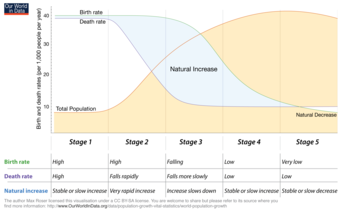
Demographic Transition Overview
Conclusions
As with all models, this is an idealized picture of population change in these countries. The model is a generalization that applies to these countries as a group and may not accurately describe all individual cases. The extent to which it applies to less-developed societies today remains to be seen. Many countries such as China, Brazil and Thailand have passed through the Demographic Transition Model (DTM) very quickly due to fast social and economic change. Some countries, particularly African countries, appear to be stalled in the second stage due to stagnant development and the effect of AIDS.
17.3: Urbanization and the Development of Cities
17.3.1: The Earliest Cities
Early cities arose in a number of regions, and are thought to have developed for reasons of agricultural productivity and economic scale.
Learning Objective
Summarize the various beginnings of cities, from centers of agriculture to areas of protection, and the factors they need to be successful
Key Points
- The very first cities were founded in Mesopotamia after the Neolithic Revolution, around 7500 BCE.
- Agriculture is believed to be a pre-requisite for cities, which help preserve surplus production and create economies of scale.
- Cities reduced transport costs for goods, people, and ideas by bringing them all together in one spot.
Key Terms
- urbanism
-
the study of cities, their geographic, economic, political, social, and cultural environment
- Neolithic Revolution
-
The Neolithic Revolution or Neolithic Demographic Transition, sometimes called the Agricultural Revolution, was the world’s first historically verifiable revolution in agriculture.
- Old World
-
The known world before the discovery of the Americas.
Examples
- Rome is a well-known example of an ancient city that served political and commercial functions, as well as acting as a cultural and social center.
- Many early cities were surrounded by patrolled walls, demonstrating the importance of protection in urban centers of early civilizations.
Early cities developed in a number of regions, from Mesopotamia to Asia to the Americas. The very first cities were founded in Mesopotamia after the Neolithic Revolution, around 7500 BCE. Mesopotamian cities included Eridu, Uruk, and Ur. Early cities also arose in the Indus Valley and ancient China. Among the early Old World cities, one of the largest was Mohenjo-daro, located in the Indus Valley (present-day Pakistan); it existed from about 2600 BCE, and had a population of 50,000 or more. In the ancient Americas, the earliest cities were built in the Andes and Mesoamerica, and flourished between the 30th century BCE and the 18th century BCE.
Ancient cities were notable for their geographical diversity, as well as their diversity in form and function. Theories that attempt to explain ancient urbanism by a single factor, such as economic benefit, fail to capture the range of variation documented by archaeologists. Excavations at early urban sites show that some cities were sparsely populated political capitals, others were trade centers, and still other cities had a primarily religious focus. Some cities had large dense populations, whereas others carried out urban activities in the realms of politics or religion without having large associated populations. Some ancient cities grew to be powerful capital cities and centers of commerce and industry, situated at the centers of growing ancient empires. Examples include Alexandria and Antioch of the Hellenistic civilization, Carthage, and ancient Rome and its eastern successor, Constantinople (later Istanbul).
The Formation of Cities
Why did cities form in the first place? There is insufficient evidence to assert what conditions gave rise to the first cities, but some theorists have speculated on what they consider pre-conditions and basic mechanisms that could explain the rise of cities. Agriculture is believed to be a pre-requisite for cities, which help preserve surplus production and create economies of scale. The conventional view holds that cities first formed after the Neolithic Revolution, with the spread of agriculture. The advent of farming encouraged hunter-gatherers to abandon nomadic lifestyles and settle near others who lived by agricultural production. Agriculture yielded more food, which made denser human populations possible, thereby supporting city development. Farming led to dense, settled populations, and food surpluses that required storage and could facilitate trade. These conditions seem to be important prerequisites for city life. Many theorists hypothesize that agriculture preceded the development of cities and led to their growth.
A good environment and strong social organization are two necessities for the formation of a successful city. A good environment includes clean water and a favorable climate for growing crops and agriculture. A strong sense of social organization helps a newly formed city work together in times of need, and it allows people to develop various functions to assist in the future development of the city (for example, farmer or merchant). Without these two common features, as well as advanced agricultural technology, a newly formed city is not likely to succeed.
Cities may have held other advantages, too. For example, cities reduced transport costs for goods, people, and ideas by bringing them all together in one spot. By reducing these transaction costs, cities contributed to worker productivity. Finally, cities likely performed the essential function of providing protection for people and the valuable things they were beginning to accumulate. Some theorists hypothesize that people may have come together to form cities as a form of protection against marauding barbarian armies.
17.3.2: Preindustrial Cities
Preindustrial cities had important political and economic functions and evolved to become well-defined political units.
Learning Objective
Examine the growth of preindustrial cities as political units, as well as how trade routes allowed certain cities to expand and grow
Key Points
- Preindustrial cities were political units, like today’s states. They offered freedom from rural obligations to lord and community.
- In the early modern era, larger capital cities benefited from new trade routes and grew even larger.
- While the city-states, or poleis, of the Mediterranean and Baltic Sea languished from the 16th century, Europe’s larger capitals benefited from the growth of commerce following the emergence of an Atlantic trade.
Key Terms
- Preindustrial cities
-
While ancient cities may have arisen organically as trading centers, preindustrial cities evolved to become well defined political units.
- rural obligations
-
For people during the medieval era, cities offered a newfound freedom from rural obligations. City residence brought freedom from customary rural obligations to lord and community.
- lord
-
A titled nobleman or aristocrat
Example
- London is an example of a city that was well established in the preindustrial era as a political and economic center.
Cities as Political Centers
While ancient cities may have arisen organically as trading centers, preindustrial cities evolved to become well defined political units, like today’s states. During the European Middle Ages, a town was as much a political entity as a collection of houses. However, particular political forms varied. In continental Europe, some cities had their own legislatures. In the Holy Roman Empire, some cities had no other lord than the emperor. In Italy, medieval communes had a state-like power. In exceptional cases like Venice, Genoa, or Lübeck, cities themselves became powerful states, sometimes taking surrounding areas under their control or establishing extensive maritime empires. Similar phenomena existed elsewhere, as in the case of Sakai, which enjoyed a considerable autonomy in late medieval Japan.
For people during the medieval era, cities offered a newfound freedom from rural obligations. City residence brought freedom from customary rural obligations to lord and community (hence the German saying, “Stadtluft macht frei,” which means “City air makes you free”). Often, cities were governed by their own laws, separate from the rule of lords of the surrounding area.
Trade Routes
Not all cities grew to become major urban centers. Those that did often benefited from trade routes—in the early modern era, larger capital cities benefited from new trade routes and grew even larger. While the city-states, or poleis, of the Mediterranean and Baltic Sea languished from the 16th century, Europe’s larger capitals benefited from the growth of commerce following the emergence of an Atlantic trade. By the early 19th century, London had become the largest city in the world with a population of over a million, while Paris rivaled the well-developed regional capital cities of Baghdad, Beijing, Istanbul, and Kyoto. But most towns remained far smaller places—in 1500 only about two dozen places in the world contained more than 100,000 inhabitants. As late as 1700 there were fewer than 40, a figure which would rise thereafter to 300 in 1900. A small city of the early modern period might have contained as few as 10,000 inhabitants.
17.3.3: Industrial Cities
During the industrial era, cities grew rapidly and became centers of population growth and production.
Learning Objective
Discuss the problems urbanization created for newly formed cities
Key Points
- Rapid growth brought urban problems, and industrial-era cities were rife with dangers to health and safety.
- Poor sanitation and communicable diseases were among the greatest causes of death among urban working class populations.
- In the 19th century, better sanitation led to improved health conditions.
Key Terms
- industrial cities
-
Rapid growth brought urban problems, and industrial-era cities were rife with dangers to health and safety. Quickly expanding industrial cities could be quite deadly, full of contaminated water and air, and communicable diseases.
- industrial era
-
During the industrial era, cities grew rapidly and became centers of population and production.
Example
- Upton Sinclair’s The Jungle chronicles the dangerous living conditions endured by immigrant factory workers in the early-1900s, a period of rapid urbanization in the U.S. The book’s protagonist immigrates from Eastern Europe to Chicago in search of employment and eventual prosperity, but instead finds dangerous assembly lines, unsanitary water, and cramped tenement buildings.
During the industrial era, cities grew rapidly and became centers of population and production. The growth of modern industry from the late 18th century onward led to massive urbanization and the rise of new, great cities, first in Europe, and then in other regions, as new opportunities brought huge numbers of migrants from rural communities into urban areas. In 1800, only 3% of the world’s population lived in cities. Since the industrial era, that figure, as of the beginning of the 21st century, has risen to nearly 50%. The United States provides a good example of how this process unfolded; from 1860 to 1910, the invention of railroads reduced transportation costs and large manufacturing centers began to emerge in the United States, allowing migration from rural to urban areas.
Rapid growth brought urban problems, and industrial-era cities were rife with dangers to health and safety. Rapidly expanding industrial cities could be quite deadly, and were often full of contaminated water and air, and communicable diseases. Living conditions during the Industrial Revolution varied from the splendor of the homes of the wealthy to the squalor of the workers. Poor people lived in very small houses in cramped streets. These homes often shared toilet facilities, had open sewers, and were prone to epidemics exacerbated by persistent dampness. Disease often spread through contaminated water supplies.
In the 19th century, health conditions improved with better sanitation, but urban people, especially small children, continued to die from diseases spreading through the cramped living conditions. Tuberculosis (spread in congested dwellings), lung diseases from mines, cholera from polluted water, and typhoid were all common. The greatest killer in the cities was tuberculosis (TB). Archival health records show that as many as 40% of working class deaths in cities were caused by tuberculosis.

Slum in Glasgow, 1871
An example of slum life in an industrial city.
17.3.4: The Structure of Cities
Urban structure is the arrangement of land use, explained using different models.
Learning Objective
Analyze, using human ecology theory, the similarities and differences between the various urban structure models, such as grid model, sectoral model and concentric ring model, among others
Key Points
- In the grid model of cities, land is divided by streets that run at right angles to each other, forming a grid. This model promotes development.
- The concentric ring model describes the city as an ecosystem in which residents sort themselves into a series of rings based on class and occupation. This model’s general applicability has been challenged.
- Urban structure can also describe the location of the central business district, industrial parks, or urban open spaces.
- The sectoral model says the city develops in wedge-shaped sectors instead of rings: certain areas of a city are more attractive for various activities, which flourish and expand outward in a wedge.
- The multiple nuclei model assumes that car ownership granted people more mobility and led the the development of specialized regional centers within cities.
- The irregular pattern model was developed to better explain urban structure in the Third World. It attempts to model the lack of planning or construction found in many rapidly built Third World cities.
Key Terms
- Human Ecology
-
Human ecology described the city as analogous to an ecosystem, with natural processes of adaptation and assimilation.
- urban open space
-
In land use planning, urban open space is open space areas for parks, green spaces, and other open areas.
- central business district
-
The central area of a city in which a concentration of certain retail and business activities takes place, especially in older cities with rail transportation.
Examples
- Washington, D.C. is an example of a city that was planned in a classic European style, with streets radiating off of a central point. Midtown Manhattan, by contrast, employs a more modern grid pattern to create easily navigable and divisible blocks.
- Areas with dispersed, rural populations have few major cities, since the small populations do not have a great demand for goods and services. For example, Cheyenne, Wyoming is an extremely small urban center compared to Chicago, Illinois. This dispersion of cities illustrates central place theory.
Urban Structure Models
Grid
In grid models, land is divided by streets intersect at right angles, forming a grid. Grid plans are more common in North American cities than in Europe, where older cities tend to be build on streets that radiate out from a central square or structure of cultural significance. Grid plans facilitate development because developers can subdivide and auction off large parcels of land. The geometry yields regular lots that maximize use and minimize boundary disputes. However, grids can be dangerous because long, straight roads allow faster automobile traffic. In the 1960s, urban planners moved away from grids and began planning suburban developments with dead ends and cul-de-sacs.
Concentric Ring Model
The concentric ring model was postulated in 1924 by sociologist Ernest Burgess, based on his observations of Chicago . It draws on human ecology theories, which compared the city to an ecosystem, with processes of adaptation and assimilation. Urban residents naturally sort themselves into appropriate rings, or ecological niches, depending on class and cultural assimilation. The innermost ring represents the central business district (CBD), called Zone A. . It is surrounded by a zone of transition (B), which contains industry and poorer-quality housing. The third ring (C) contains housing for the working-class—the zone of independent workers’ homes. The fourth ring (D) has newer and larger houses occupied by the middle-class. The outermost ring (E), or commuter’s zone, is residential suburbs.

Toronto’s Central Business District
Skyscrapers populate Toronto’s central business district

Concentric Zone Model
The Concentric Ring Model described the city as a series of concentric rings, each home to a different group and social function.
This model’s general applicability has been challenged. It describes an American geography in which the inner city is poor while suburbs are wealthy—elsewhere, the converse is the norm. In new, western U.S. cities such as Los Angeles, advances in transportation and communication have blurred these “zones. ” Further, the model fails to account for topographical and physical features of the landscape. Even in Chicago, the concentric rings were semi-circles, interrupted by Lake Michigan.
Sectoral
In 1939, the economist Homer Hoyt adapted the concentric ring model by proposing that cities develop in wedge-shaped sectors instead of rings. Certain areas of a city are more attractive for various activities, whether by chance or geographic/environmental reasons. As these activities flourish and expand outward, they form wedges, becoming city sectors . Like the concentric ring model, Hoyt’s sectoral model has been criticized for ignoring physical features and new transportation patterns that restrict or direct growth.

Hoyt’s Sectoral Model of Urban Growth
In Hoyt’s model, cities grow in wedge-shaped sectors radiating from the center.
Multiple Nuclei
The multiple nuclei model was developed in 1945 to explain city formation after the spread of the automobile. People have greater movement due to increased car ownership, allowing for the specialization of regional centers. A city contains more than one center around which activities revolve. Some activities are attracted to particular nodes while others try to avoid them. For example, a university node may attract well-educated residents, pizzerias, and bookstores, whereas an airport may attract hotels and warehouses. Incompatible activities will avoid clustering in the same area.
Irregular Pattern
The irregular pattern model was developed to explain urban structure in the Third World. It attempts to model the lack of planning found in many rapidly built Third World cities. This model includes blocks with no fixed order; urban structure is not related to an urban center or CBD.
Alternate Uses of “Urban Structure”
Urban structure can also refer to urban spatial structure; the arrangement of public and private space in cities and the degree of connectivity and accessibility. In this context, urban structure is concerned with the arrangement of the CBD, industrial and residential areas, and open space.
A city’s central business district (CBD), or downtown, is the commercial and often geographic heart of a city. In North America, this is referred to as “downtown” or “city center. ” The downtown area is often home to the financial district, but usually also contains entertainment and retail. CBDs usually have very small resident populations, but populations are increasing as younger professional and business workers move into city center apartments.
An industrial park is an area zoned and planned for the purpose of industrial development. They are intended to attract business by concentrating dedicated infrastructure to reduce the per-business expenses. They also set aside industrial uses from urban areas to reduce the environmental and social impact of industrial uses and to provide a distinct zone of environmental controls specific to industrial needs.
Urban open spaces provide citizens with recreational, ecological, aesthetic value. They can range from highly maintained environments to natural landscapes. Commonly open to public access, they may be privately owned. Urban open spaces offer a reprieve from the urban environment and can add ecological value, making citizens more aware of their natural surroundings and providing nature to promote biodiversity. Open spaces offer aesthetic value for citizens who enjoy nature, cultural value by providing space for concerts or art shows, and functional value—for example, by helping to control runoff and prevent flooding.
17.3.5: The Process of Urbanization
Urbanization is the process of a population shift from rural areas to cities, often motivated by economic factors.
Learning Objective
Analyze the proces of urbanization and its effects on economics and the environment in society
Key Points
- Urbanization may be driven by local and global economic and social changes, and is generally a product of modernization and industrialization.
- Urbanization has economic and environmental effects. Economically, urbanization drives up prices, especially real estate, which can force original residents to move to less-desirable neighborhoods.
- Environmentally, cities cause “heat islands”, where less vegetation and open soil raise city temperatures by 2 to 10 degrees Fahrenheit.
- Recently in developed countries, sociologists have observed suburbanization and counterurbanization, or movement away from cities, which may be driven by transportation infrastructure, or social factors like racism.
Key Terms
- counterurbanization
-
A demographic and social process whereby people move from urban areas to rural areas.
- urbanization
-
The physical growth of urban areas as a result of rural migration and even suburban concentration into cities.
- rural flight
-
A term used to describe the migratory patterns of peoples from rural areas into urban areas.
- suburbanization
-
A term used to describe the growth of areas on the fringes of major cities; one of the many causes of the increase in urban sprawl.
- gentrification
-
A shift in an urban community toward wealthier residents and/or businesses and increasing property values; often resulting in poorer residents being displaced by wealthier newcomers.
Examples
- Mexico City has undergone rapid urbanization according to the pattern seen in many developing countries. Mexico has rapidly changed from a primarily agricultural country to one with significant industry, including industrialized agriculture. Consequently, huge numbers of rural dwellers migrated to Mexico City, making it an extremely densely populated city of nearly 9 million.
- Chicago is an example of a U.S. city that has seen vast suburbanization as middle and upper class residents move to nearby suburbs. The population living within city limits is under 3 million, but the population of the “metro area,” which includes suburbs, is over 9 million.
Urbanization and rural flight
Urbanization is the process of a population shift from rural areas to cities. During the last century, global populations have urbanized rapidly:
- 13% of people lived in urban environments in the year 1900
- 29% of people lived in urban environments in the year 1950
One projection suggests that, by 2030, the proportion of people living in cities may reach 60%.
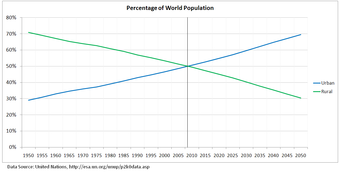
Rural and Urban World Population
Over time, the world’s population has become less rural and more urban.
Urbanization tends to correlate positively with industrialization. With the promise of greater employment opportunities that come from industrialization, people from rural areas will go to cities in pursuit of greater economic rewards.
Another term for urbanization is “rural flight. ” In modern times, this flight often occurs in a region following the industrialization of agriculture—when fewer people are needed to bring the same amount of agricultural output to market—and related agricultural services and industries are consolidated. These factors negatively affect the economy of small- and middle-sized farms and strongly reduce the size of the rural labor market. Rural flight is exacerbated when the population decline leads to the loss of rural services (such as business enterprises and schools), which leads to greater loss of population as people leave to seek those features.
As more and more people leave villages and farms to live in cities, urban growth results. The rapid growth of cities like Chicago in the late nineteenth century and Mumbai a century later can be attributed largely to rural-urban migration. This kind of growth is especially commonplace in developing countries.
Urbanization occurs naturally from individual and corporate efforts to reduce time and expense in commuting, while improving opportunities for jobs, education, housing, entertainment, and transportation. Living in cities permits individuals and families to take advantage of the opportunities of proximity, diversity, and marketplace competition. Due to their high populations, urban areas can also have more diverse social communities than rural areas, allowing others to find people like them.
Economic and Environmental Effects of Urbanization
Urbanization has significant economic and environmental effects on cities and surrounding areas. As city populations grow, they increase the demand for goods and services of all kinds, pushing up prices of these goods and services, as well as the price of land. As land prices rise, the local working class may be priced out of the real estate market and pushed into less desirable neighborhoods – a process known as gentrification.
Growing cities also alter the environment. For example, urbanization can create urban “heat islands,” which are formed when industrial and urban areas replace and reduce the amount of land covered by vegetation or open soil. In rural areas, the ground helps regulate temperatures by using a large part of the incoming solar energy to evaporate water in vegetation and soil. This evaporation, in turn, has a cooling effect. However in cities, where less vegetation and exposed soil exists, the majority of the sun’s energy is absorbed by urban structures and asphalt. During the day, cities experience higher surface temperatures because urban surfaces produce less evaporative cooling. Additional city heat is given off by vehicles and factories, as well as industrial and domestic heating and cooling units. Together, these effects can raise city temperatures by 2 to 10 degrees Fahrenheit (or 1 to 6 degrees Celsius).
Suburbanization and Counterurbanization
Recently in developed countries, sociologists have observed suburbanization and counterurbanization, or movement away from cities. These patterns may be driven by transportation infrastructure, or social factors like racism. In developed countries, people are able to move out of cities while still maintaining many of the advantages of city life (for instance, improved communications and means of transportation). In fact, counterurbanization appears most common among the middle and upper classes who can afford to buy their own homes.
Race also plays a role in American suburbanization. During World War I, the massive migration of African Americans from the South resulted in an even greater residential shift toward suburban areas. The cities became seen as dangerous, crime-infested areas, while the suburbs were seen as safe places to live and raise a family, leading to a social trend known in some parts of the world as “white flight. ” Some social scientists suggest that the historical processes of suburbanization and decentralization are instances of white privilege that have contributed to contemporary patterns of environmental racism.
In the United States, suburbanization began in earnest after World War II, when soldiers returned from war and received generous government support to finance new homes. Suburbs, which are residential areas on the outskirts of a city, were less crowded and had a lower cost of living than cities. Suburbs grew dramatically in the 1950s when the U.S. interstate highway system was built, and automobiles became affordable for middle class families. Around 1990, another trend emerged known as counterurbanization, or “exurbanization”. The wealthiest individuals began living in nice housing far in rural areas (as opposed to forms).
Suburbanization may be a new urban form.Rather than densely populated centers, cities may become more spread out, composed of many interconnected smaller towns. Interestingly, the modern U.S. experience has gone from a largely rural country, to a highly urban country, to a country with significant suburban populations.
17.3.6: U.S. Urban Patterns
The U.S. Census Bureau classifies areas as urban or rural based on population size and density.
Learning Objective
Discuss the different ways governments and society define the term “urban”
Key Points
- Different agencies and individuals define urban in different ways, but the U.S. Census Bureau’s definitions are considered standard.
- The U.S. Census Bureau defines “urban areas” as areas with a population density of at least 1,000 people per square mile and at least 2,500 total people.
- As of December, 2010, about 82% of the population of the United States lived within the boundaries of urbanized area.
Key Term
- population density
-
The average number of people who live on each square mile (or kilometer) of land.
Example
- Boise, Idaho is an example of an urban area that is officially defined as urban by U.S. Census Bureau criteria, but in many ways differs from larger, more recognizable cities like New York and Los Angeles. Small cities like Boise are defined by having at least 1,000 people per square mile and over 2,500 people overall. Usually, this type of population center is associated with a cluster of industrial and cultural enterprises.
Different international, national, and local agencies may define “urban” in various ways. For example, city governments often use political boundaries to delineate what counts as a city. Other definitions may consider total population size or population density. Different definitions may also set various thresholds, so that in some cases, a town of just 2,500 may count as an urban city, whereas in other contexts, a city may be defined as having at least 50,000 people. Other agencies may define “urban” based on land use: places count as urban if they are built up with residential neighborhoods, industrial sites, railroad yards, cemeteries, airports, golf courses, and similar areas. Using this sort of definition, in 1997, the U.S. Department of Agriculture tallied over 98,000,000 acres of “urban” land.
In spite of these competing definitions, in the United States “urban” is officially defined following guidelines set by the U.S. Census Bureau. The Census Bureau defines “urban areas” as areas with a population density of at least 1,000 people per square mile and at least 2,500 total people. Urban areas are delineated without regard to political boundaries. Because this definition does not consider political boundaries, it is often used as a more accurate gauge of the size of a city than the number of people who live within the city limits. Often, these two numbers are not the same. For example, the city of Greenville, South Carolina has a city population under 60,000 and an urbanized area population of over 300,000, while Greensboro, North Carolina has a city population over 200,000 and an urbanized area population of around 270,000. That means that Greenville is actually “larger” for some intents and purposes, but not for others, such as taxation, local elections, etc.
As of December, 2010, about 82% of the population of the United States lived within the boundaries of urbanized area. Combined, these areas occupy about 2% of the land area of the United States. The majority of urbanized area residents are suburbanites; core central city residents make up about 30% of the urbanized area population (about 60 million out of 210 million). In the United States, the largest urban area is New York City, with over 8 million people within the city limits and over 19 million in the urban area. The next five largest urban areas in the United States are Los Angeles, Chicago, Washington, D.C., Philadelphia, and Boston.

American urban areas by size
This map shows major urban areas in America.
17.3.7: The Rural Rebound
During the 1970s and again in the 1990s, the rural population rebounded in what appeared to be a reversal of urbanization.
Learning Objective
Explain the rural rebound and how it contributes to the suburbanization of society
Key Points
- Much of the “rural” rebound was driven by suburbanization, which is the movement of people from cities to surrounding suburbs, ex-urbs, or edge cities.
- Suburbanization may be driven by white flight.
- Counterurbanization refers, broadly, to movement away from the city, which may include urban-to-rural migration and suburbanization.
- Counterurbanization has created shrinking cities and attempts to better control urban growth.
Key Terms
- white flight
-
The large-scale migration of whites of various European ancestries, from racially mixed urban regions to more racially homogeneous suburban areas.
- ex-urbs
-
The expression exurb (for “extra-urban”) was coined by Auguste Comte Spectorsky in his 1955 book The Exurbanites to describe the ring of prosperous communities beyond the suburbs that are commuter towns for an urban area.
- counterurbanization
-
Counterurbanisation is a demographic and social process whereby people move from urban areas to rural areas.
Example
- Population trends in Boston, Massachusetts show the modern process of suburbanization. Since the 1950s, many middle and upper class individuals have moved to nearby suburbs to escape crime and urban decay. Since the 1990s, however, a new trend among middle and upper class residents is to move to New Hampshire. While the trend is not hugely widespread, it is clearly motivated by attempts to avoid high tax rates and urban crowding, and is enabled only by modern communications and transportation technology. It is thus a new, modern form of suburbanization.
The rural rebound refers to the movement away from cities to rural and suburban areas. Urbanization tends to occur along with modernization, yet in the most developed countries many cities are now beginning to lose population. In the United States in the 1970s, demographers observed that the rural population was actually growing faster than urban populations, a phenomenon they labeled the “rural rebound. ” This trend reversed in the 1980s, due in part to a recession that hit farmers particularly hard. But again in the 1990s, rural populations appeared to be gaining at the expense of cities. Indeed, in the last 50 years, about 370 cities worldwide with more than 100,000 residents have undergone population losses of more than 10%, and more than 25% of the depopulating cities are in the United States.
Rather than moving to rural areas, most participants in the so-called the rural rebound migrated into new, rapidly growing suburbs. The rural rebound, then, may be more evidence of the importance of suburbanization as a new urban form in the most developed countries.
Suburbanization
Suburbanization is a general term that refers to the movement of people from cities to surrounding areas. However, the suburbanization that took place after 1970 was different from the suburbanization that had occurred earlier, after World War II. In this more recent wave of suburbanization, people moved beyond the nearby suburbs to farther-away towns. Sociologists have invented several new categories to describe these new types of suburban towns; two of the most notable are ex-urbs and edge cities.
The expression exurb (for “extra-urban”) refers to a ring of prosperous communities beyond a city’s suburbs. Often, these communities are commuter towns or bedroom communities. Commuter towns are primarily residential; most of the residents commute to jobs in the city. They are sometimes called bedroom communities because residents spend their days away in the cities and only come home to sleep. In general, commuter towns have little commercial or industrial activity of their own, though they may contain some retail centers to serve the daily needs of residents. Although most exurbs are commuter towns, most commuter towns are not exurban.
Exurbs vary in wealth and education level. In the United States, exurban areas typically have much higher college education levels than closer-in suburbs, though this is not necessarily the case in other countries. They typically have average incomes much higher than nearby rural counties, reflecting the urban wages of their residents. Although some exurbs are quite wealthy even compared to nearer suburbs or the city itself, others have higher poverty levels than suburbs nearer the city. This may happen especially where commuter towns form because workers in a region cannot afford to live where they work and must seek residency in another town with a lower cost of living. For example, during the “dot com” bubble of the late twentieth century, housing prices in California cities skyrocketed, spawning exurban growth in adjacent counties.
White Flight
Sociologists have posited many explanations for counterurbanization, but one of the most debated is whether suburbanization is driven by white flight. The term white flight was coined in the mid-twentieth century to describe suburbanization and the large-scale migration of whites of various European ancestries, from racially mixed urban regions to more racially homogeneous suburban regions. During the first half of the twentieth century, discriminatory housing policies often prevented blacks from moving to suburbs; banks and federal policy made it difficult for blacks to get the mortgages they needed to buy houses, and communities used restrictive housing covenants to exclude minorities.
White flight during this period contributed to urban decay, a process whereby a city, or part of a city, falls into disrepair and decrepitude. Symptoms of urban decay include depopulation, abandoned buildings, high unemployment, crime, and a desolate, inhospitable landscape. White flight contributed to the draining of cities’ tax bases when middle-class people left, exacerbating urban decay caused in part by the loss of industrial and manufacturing jobs as they moved into rural areas or overseas where labor was cheaper.
More recently, the concept has been extended to newer forms of suburbanization, including migration from urban to rural areas and to exurbs. In a similar vein, some demographers have described the rural rebound, and the newest waves of suburbanization, as a form of ethnic balkanization, in which different ethnic groups (not only whites) sort themselves into racially homogeneous communities. These phenomena, however, are not so clearly driven by the restrictive policies, laws, and practices that drove the white flight of the first half of the century.

A Suburban Neighborhood
Suburban neighborhoods often feature large, manicured lawns.
17.3.8: Models of Urban Growth
Models of urban growth try to balance the advantages and disadvantages of cities’ large sizes.
Learning Objective
Summarize the various theories of urban growth and the implications each theory has for today’s society
Key Points
- The growth machine theory of urban growth says urban growth is driven by a coalition of interest groups who all benefit from continuous growth and expansion. Thus, the growth of cities is a social phenomenon.
- Urban sprawl results when cities grow uncontrolled, expanding into rural land and making walking, public transit, or bicycling impractical.
- Critics of urban life often focus on urban decay, which may be self-perpetuating, according to the broken windows theory.
- Urban renewal attempts to counter urban decay and restore growth.
- The New Urbanism and smart growth movements both challenge the value of urban growth and expansion, and they try to improve urban life by keeping it on a human scale.
Key Terms
- New Urbanism
-
New Urbanism is an urban design movement that promotes walkable neighborhoods that contain a range of housing and job types.
- urban renewal
-
Urban renewal refers to programs of land redevelopment in areas of moderate- to high-density urban land use.
- smart growth
-
Smart growth programs draw urban growth boundaries to keep urban development dense and compact.
Example
- Harlem, New York is an example of a neighborhood with a long history of urban growth and decay. Around the 1920s, Harlem was associated with the Harlem Renaissance, a period of concentrated artistic and cultural innovation and rising standards of living that might now be considered an era of urban renewal. Since that period, the neighborhood experienced urban decay and became a hotbed of crime and poverty. In recent years, various organizations have sought to renew the neighborhood by encouraging the development of new residences and businesses.
Cities are dynamic places—they grow, shrink, and change. Sociologists have developed different theories for thinking about how urban populations change.
Growth Machine Theory
The growth machine theory of urban growth says urban growth is driven by a coalition of interest groups who all benefit from continuous growth and expansion. First articulated by Molotch in 1976, growth machine theory took the dominant convention of studying urban land use and turned it on its head.
The field of urban sociology had been dominated by the idea that cities were basically containers for human action, in which actors competed among themselves for the most strategic parcels of land, and the real estate market reflected the state of that competition. Growth machine theory reversed the course of urban theory by pointing out that land parcels were not empty fields awaiting human action, but were associated with specific interests—commercial, sentimental, and psychological. In other words, city residents were not simply competing for parcels of land; they were also trying to fulfill their particular interests and achieve specific goals. In particular, cities are shaped by the real estate interests of people whose properties gain value when cities grow. These actors make up what Molotch termed “the local growth machine. “
Urban Sprawl
Whether explained by older theories of natural processes or by growth machine theory, the fact of urban growth is undeniable: throughout the twentieth century, cities have grown rapidly. In some cases, that growth has been poorly controlled, resulting in a phenomenon known as urban sprawl. Urban sprawl entails the growth of a city into low-density and auto-dependent rural land, high segregation of land use (e.g., retail sections placed far from residential areas, often in large shopping malls or retail complexes), and design features that encourage car dependency.
Urban sprawl’s segregated land use means that the places where people live, work, shop, and relax are far from one another, which usually makes walking, public transit, or bicycling impractical. As a result, residents must use an automobile. Urban sprawl tends to include low population density: single family homes on large lots instead of apartment buildings, single story or low-rise buildings instead of high-rises, extensive lawns and surface parking lots, and so on.
Critics of urban sprawl argue that it creates an inhospitable urban environment and that it encroaches on rural land, potentially driving up land prices and displacing farmers or other rural residents. Urban sprawl is also associated with negative environmental and public health effects, many of which are related to automobile dependence: increases in personal transportation costs, air pollution and reliance on fossil fuel, increases in traffic accidents, delays in emergency medical services response times, and decreases in land and water quantity and quality.
Urban Decay
Some have suggested that urban sprawl is driven by consumer preference; people prefer to live in lower density, quieter, more private communities that they perceive as safer and more relaxed than urban neighborhoods. Such preferences echo a common strain of criticism of urban life, which tends to focus on urban decay. According to these critics, urban decay is caused by the excessive density and crowding of cities, and it drives out residents, creating the conditions for urban sprawl.
BROKEN WINDOWS
An alternative theory suggests that density does not cause crime, and crime does not cause people to leave the city; when people leave, city neighborhoods are abandoned and neglected, resulting in crime and decay. This theory, known as the “broken windows theory,” argues that small indicators of neglect, such as broken windows and unkempt lawns, promote a feeling that an area is in a state of decay. Anticipating decay, people likewise fail to maintain their own properties.
RESPONSES TO DECAY
Cities have responded to urban decay and urban sprawl by launching urban renewal programs. Two specific types of urban renewal programs—New Urbanism and smart growth—attempt to make cities more pleasant and livable.
Smart growth programs draw urban growth boundaries to keep urban development dense and compact. In addition to increasing the density of cities, urban growth boundaries can protect the surrounding farmland and wild areas. Smart growth programs often incorporate transit-oriented development goals to encourage effective public transit systems and make bicyclers and pedestrians more comfortable.
New Urbanism is an urban design movement that promotes walkable neighborhoods with a range of housing options and job types. As an approach to urban planning, it encompasses principles such as traditional neighborhood design and transit-oriented development. A neighborhood designed along New Urbanist principles would have a discernible center (such as a square or a green) with a transit stop nearby. Most homes would be within a five-minute walk of the center and would provide a variety of housing options, including houses, row houses, and apartments to encourage the mixing of younger and older people, singles and families, and poor and wealthy.

Urban sprawl
Chicago, seen by air, shows urban sprawl

Broken windows
Broken windows in Detroit signal urban decay
17.4: Urban Life
17.4.1: Sociological Perspectives on Urban Life
Urban sociology is the study of social life and interactions in urban areas, using methods ranging from statistical analysis to ethnography.
Learning Objective
Explain urbanization in terms of functionalism and what the Chicago School understood to be some of the causes of urban social problems at that time
Key Points
- Georg Simmel is widely considered to be the father of urban sociology, as he pioneered studies of the interrelation of space and social interaction.
- Urban sociology attempts to account for the interrelation of subcultures in urban areas, as well as the internal structures of segments of society.
- Like biological systems, urban subgroups are dependent on one another for healthy functioning and are also dynamic—that is, they flourish and decline based on political, economic, and social tides.
Key Terms
- subculture
-
A portion of a culture distinguished from the larger society around it by its customs or other features.
- alienation
-
Emotional isolation or dissociation.
Example
- Nels Anderson’s 1923 study of “The Hobo” sought to explain the internal structure of hobo communities in Chicago. This is one of the earliest examples of a subcultural study that explained the organization of urban subgroups as opposed to strictly highlighting the disorganization that accompanied urbanization.
Urban sociology is the sociological study of life and human interaction in metropolitan areas. It is a well-established subfield of sociology that seeks to study the structures, processes, changes and problems of urban areas and to subsequently provide input for planning and policymaking. In other words, it is the sociological study of cities and their role in the development of society. Like most areas of sociology, urban sociologists use statistical analysis, observation or ethnography, social theory, interviews, and other methods to study a range of topics, including migration, economic and demographic trends, as well as things like poverty, race relations, crime, sexuality, and many other phenomena that surface in dynamic cities.
After the Industrial Revolution sociologists such as Max Weber and Georg Simmel began to focus on the accelerating process of urbanization and the effects it had on feelings of social alienation and anonymity. Notably, Georg Simmel is widely considered to be the father of urban sociology for his contributions to the field in in works such as The Metropolis and Mental Life, published in 1903.
The Chicago School
The Chicago School of Sociology is widely credited with institutionalizing urban sociology as a disciplinary sub-field through pioneering studies of urban spaces and social interactions . This group of sociologists studied the built urban environment in Chicago through the early twentieth century and they have left a lasting impact on the field, as subsequent researchers adopted qualitative methods such as ethnography and land-use mapping to theorize urban phenomena. The Chicago School combined sociological and anthropological theories to understand the interrelation of urban structures and micro-interactions in cities. The Chicago School sought to provide subjective meaning to how humans interact under structural, cultural and social conditions.
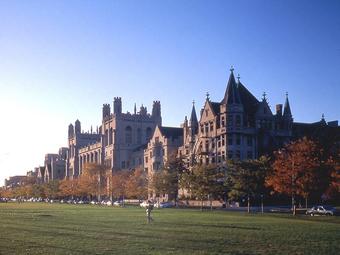
The Chicago School of Sociology
The Chicago School of Sociology, developed at the University of Chicago, is credited with developing modern urban sociology as researchers worked to elucidate patterns of urban life.
Scholars of the Chicago School originally focused around one integral question: How did an increase in urbanism during the time of the Industrial Revolution contribute to the magnification of then-contemporary social problems? Sociologists centered in Chicago due to its “tabula rasa” state (people’s minds before they receive impressions gained from experience), having expanded from a small town of 10,000 in 1860 to a urban metropolis of two million in the next half decade. Along with this expansion came many of the era’s emerging social problems, ranging from issues of homelessness and poor living conditions to the low-wage and long-hour work periods that many European immigrants faced upon arrival in the city. Furthermore, unlike many other metropolitan areas, Chicago did not expand outward at the edges as predicted by early expansionist theorists, but instead reformatted the space available in a concentric ring pattern. As with many modern cities the business district that occupied the city center was surrounded by slums and blighted neighborhoods, which were further surrounded by working class homes and the early forms of the modern suburbs. Urban theorists suggested that these spatially-defined regions helped to solidify and isolate class relations within the modern city, moving the middle class away from the urban core and into the privatized environment of the outer suburbs.
Due to the high concentration of first-generation immigrant families in the inner city of Chicago during the early twentieth century, many prominent early studies in urban sociology focused around the effects of carrying culture roles and norms into new and developing environments. Political participation and the rise in inter-community organizations were also highly followed in this period, with many metropolitan areas adopting census techniques that allowed for information to be stored and easily accessible by participating institutions such as the University of Chicago. Sociologists Park, Burgess and McKenzie, professors at the University of Chicago and three of the earliest proponents of urban sociology, developed subcultural theories, which helped to explain the role of local institutions in the formation of ties. Subcultural theories popularized the idea that segments of society, such as gangs and homeless populations, had internal systems of value and order. This theory was in contrast to the prevailing belief that urbanization produced only social disorganization and alienation.
Urban Ecology
Urban ecology refers to an idea that emerged out of the Chicago School that likens urban organization to biological organisms. Urban ecology has remained an influential theory in both urban sociology and urban anthropology over time. The theory is essentially an extended metaphor that helps to explain how conflicting subgroups exist in shared urban spaces and systems. Like biological systems, urban subgroups are dependent on one another for healthy functioning and are also dynamic—that is, they flourish and decline based on political, economic, and social tides. Relating this to functionalist theory, one can look at immigration and emigration trends. As people enter and leave a country, they are dependent upon one another, as well as the new culture, to assimilate and enter into a new society. Immigrants become emigrants and vice-versa; in this way, the chain of life continues in terms of societal relations.
17.4.2: Social Interaction in Urban Areas
Social scientists have focused on social interactions in urban areas because cities bring together many cultural strands.
Learning Objective
Design a research question using one of the four central approaches to the anthropological study of cities
Key Points
- Urban areas impact individuals’ relationships with one another. Economic problems and power dynamics are intensified in small spatial areas in which resources are scarce due to dense populations.
- Social scientists seek to understand how metropolitan social dynamics are distinct from those in other contexts.
- German sociologist Georg Simmel was a founding father of this sociological subfield. He gave a speech that analyzed the effects of urbanity on the mind of the individual, arguing that urban life irreversibly transforms one’s mind.
- Social scientists ask two sets of questions about social life in urban areas. The first set asks how social interactions are shaped by urban environments, and the other asks more pointed questions about how the architecture and physical space of a city influence social interactions.
Key Terms
- urban ecology model
-
In the urban ecology model, the social scientist considers how individuals interact with others in their urban community.
- sociology of architecture
-
Sociology of architecture is a term that describes the sociological study of either the built environment or the role and occupation of architects in modern societies.
- sociology of space
-
The sociology of space is a sub-discipline of sociology that is concerned with the spatiality of society. It examines the constitution of spaces through action, as well as the dependence of action on spatial structures.
Examples
- Urban social structure differs in significant ways from rural life, which in turn affects the form of social interactions. For example, on a daily basis an urban dweller is likely to come into contact with numerous strangers, if only in passing. By contrast, rural dwellers may come into contact with only people who look familiar. Contact with the hypothetical person that Georg Simmel calls “the stranger” changes the way urban dwellers think about intimacy, personal space, and casual interactions. To be concrete, an urban dweller may be suspicious of passersby, while a rural dweller may greet them.
- Urban social structure differs in significant ways from rural life, which in turn affects the form of social interactions. For example, on a daily basis an urban dweller is likely to come into contact with numerous strangers, if only in passing. By contrast, rural dwellers may come into contact with only people who look familiar. Contact with the hypothetical person that Georg Simmel calls “the stranger” changes the way urban dwellers think about intimacy, personal space, and casual interactions. To be concrete, an urban dweller may be suspicious of passersby, while a rural dweller may greet them.
Around half of the world’s population currently lives in an urban area, and the United Nations World Urbanization Prospects Report suggests that 60% of the world’s population will live in an urban area by the year 2030. As such, social scientists have paid increasing attention to the particular types of social dynamics that develop in urban environments.
Social scientists have focused on social interactions in urban areas because cities have the unique capacity to bring together many cultural strands. Economic problems and power dynamics are intensified in small spatial areas in which resources are scarce due to dense populations. Further, cities operate as zones of confluence for economic relationships and other types of diversity as new ideas, people, and goods are constantly flowing through urban areas. As a result, the people there have to respond to new influences, often bringing dominant strains of culture to the fore. What does a particular group of people value? What can they tolerate? What do they revolt against? All of these questions play out in cities.
Urban anthropology is an anthropological subfield primarily concerned with urbanization, poverty, and the consequences of neoliberalism, or the contemporary political movement that advocates economic liberalization, free trade, free movement, and open markets. There are four central approaches to an anthropological study of cities. The first is an urban ecology model in which the social scientist considers how individuals interact with others in their urban community. Second, one could focus on power and knowledge, specifically how these elements are combined in the development of urban structures. Third, one can study how localities relate to communities beyond their bounds, such as an analysis of the relationship between the local and the global. Finally, one can consider how political economy, or the study of production, law, and distribution, is essential to a city’s infrastructure and the consequences of this interdependence. These questions have been closely examined in urban contexts in the past fifty years.
Despite the relatively recent ascent of urban sociology, sociologists have long studied the sociological implications of space. Georg Simmel, a German sociologist from the turn of the twentieth century, famously considered the social impact of urban environments in The Metropolis and Mental Life. Published in 1903, this work was originally given as one of a series of lectures on all aspects of city life by experts in various fields, ranging from science to religion to art. Simmel was originally asked to lecture on the role of intellectual life in Berlin, but he effectively reversed the topic in order to analyze the effects of urbanity on the mind of the individual. Simmel argues that urban life irreversibly transforms one’s mind. Simmel does not say that these changes are negative, but writes that structural forces on socialization are particularly strong in an urban milieu.
Social scientists thus ask two sets of questions about social life in urban areas. The first set asks how social interactions are shaped by urban environments and how social interactions in urban environments are distinct from social interactions in other contexts. These are the types of questions asked by Simmel and urban anthropologists. The other strand of analysis asks more pointed questions about how the architecture and physical space of a city influence social interactions. This second set of questions is taken up by urban planners, architects, and, in the social sciences, by individuals who study the sociology of architecture and the sociology of space. Clearly, questions about social interactions in urban areas cluster loosely and are quite broad. However, it is clear that social dynamics are influenced by urbanity and sociologists intentionally study this field in broad terms to understand the multifaceted ways in which urban life influences society.
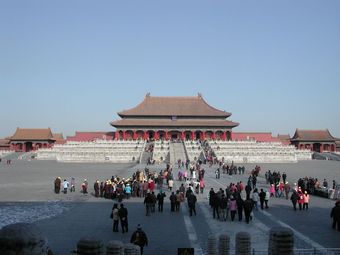
Urban Social Life
In cities, such as Beijing, people are exposed to large populations of unfamiliar faces, including transient visitors. This changes one’s orientation to the urban community.
17.4.3: Urban Neighborhoods
Neighborhoods are small units of social organization within a larger social area, such as a city or town.
Learning Objective
Name three classic qualities of a neighborhood
Key Points
- Neighborhoods have historically existed in every large urban area.
- Neighborhood action tends to quickly produce visible results, particularly when compared to larger social units. Because neighborhood action involves interaction with others, such actions create stronger social ties among those inhabiting the area.
- Neighbors socialize one another through significant numbers of face-to-face interactions.
- The tendency of members of a neighborhood to share voting patterns and other views is called the neighborhood effect.
- In Canada and the United States, neighborhoods are often given official or semi-official status through neighborhood associations, neighborhood watches, or block watches.
Key Terms
- Social ties
-
Because neighborhood action involves others, such actions create stronger social ties amongst those inhabiting the area.
- neighborhood effect
-
Individuals in neighborhoods tend to vote similarly.
- neighborhood
-
A division of a municipality or region, formally or informally divided
Example
- Greenwich Village is an example of a famous neighborhood in New York City known broadly for countercultural and artistic activities. People likely move to Greenwich Village because they hold values that are in line with its reputation, but once they move there socialization among neighbors likely increasing the strength and specificity of their shared views through the neighborhood effect. One might move to Greenwich Village due to an in social justice and then develop a particular interest in economic fair trade, for example.
A neighborhood is a geographically localized community within a larger city, town, or suburb. Neighborhoods are often social communities with considerable face-to-face interactions among members. While neighborhoods have expanded with industrialization and the development of even larger urban areas, neighborhoods have always existed. Archaeologists have demonstrated through excavations that pre-industrial urban areas contained neighborhoods. As is true in the present day, neighborhoods were historically generated by social interaction among people living near one another. They are extremely localized social units only a step above a household and not directly under government control. In this sense, neighborhoods are usually informal, rather than pre-planned by government agencies. In some pre-industrial urban traditions, basic municipal functions, such as protection, social regulation of births and marriages, cleaning, and upkeep were handled informally by neighborhoods rather than by urban governments. As is still commonly the case, neighborhoods in pre-industrial cities often had some degree of social specialization or differentiation. Ethnic neighborhoods were important in past cities and remain common in cities today.
Sociologists are interested in neighborhoods as small, localized social, economic, and political units. Neighborhoods are close to universal, as most people in urbanized areas would consider themselves to be living in one. Neighborhood action tends to quickly produce visible results, particularly when compared to larger social units. Because neighborhood action involves frequent interaction with others, such actions create stronger social ties among those inhabiting the area.
In Canada and the United States, neighborhoods are often given official or semi-official status through neighborhood associations, neighborhood watches, or block watches. These may regulate such domestic matters as lawn care and fence height and provide other social services such as block parties, neighborhood parks, and community security.
Though neighborhoods are less strictly regulated by government officials, this is not to say that neighborhoods lack political power. Indeed, sociologists and political scientists have found that individuals in neighborhoods tend to vote similarly in what is referred to as the neighborhood effect. The voting preference of a neighborhood tends to be formed by consensus, where people tend to vote with the general trend the neighborhood. Of course, this is not to imply pure causation, but rather tha individuals with similar voting preferences choose to live in the same area. Socialization within neighborhoods is quite significant, particularly when this form of socialization involves significant face-to-face interactions with one’s neighbors.

Neighborhood Watch
Neighborhood watches are one form of semi-formal neighborhood associations that contribute to the regulation of crime in an area that is not an independent political unit. Neighborhood watch associations function under citywide police and have no legal authority as crime enforcement officers.
17.4.4: Urban Decline
Urban decline is the process whereby a previously functioning city or neighborhood falls into disrepair.
Learning Objective
Analyze the causes and solutions to urban decline experienced both during the Industrial Revolution and in America today
Key Points
- It is often caused by a decline in the economic opportunities available in a particular city.
- The issues associated with the modern iteration of urban decline began during the Industrial Revolution, when many people moved to cities looking for industrial work, and then fell into poverty with economic changes and deindustrialization.
- Deindustrialization is the process of social and economic change caused by the removal or reduction of industrial capacity in a region that is known for its manufacturing industry.
- New Urbanism seeks to combat the economic and architectural problems associated with urban decline.
- In the United States, early government policies included “urban renewal” and the construction of large-scale housing projects for the poor.
Key Terms
- white flight
-
The large-scale migration of whites of various European ancestries, from racially mixed urban regions to more racially homogeneous suburban areas.
- deindustrialization
-
The loss or deprivation of industrial capacity or strength.
- blight
-
Anything that impedes growth or development, or spoils any other aspect of life.
Example
- San Antonio, Texas is an example of a U.S. city that formally adopted the precepts of New Urbanism in an attempt to eradicate urban decline. After facing economic hardship and seeing the decline of local infrastructure and resources, San Antonia created official districts with self-governing neighborhood associations, and redeveloped urban space to create neighborhood centers.
Urban decline is the process whereby a previously functioning city or neighborhood falls into disrepair and decrepitude. Features of urban decline include deindustrialization, depopulation, economic restructuring, abandoned buildings, high unemployment, fragmented families, political disenfranchisement, crime, and a desolate landscape. Since the 1970s and 1980s, urban decline has been associated with Western cities having experienced institutional restructuring. In many countries outside of the West, urban decline manifests as peripheral slums at the outskirts of cities. In contrast, in North American and British cities, the impoverished areas begin to develop in the city center as individuals relocate their residences to suburban areas outside of the city. This process is frequently called white flight, in reference to the fact that the central urban areas usually remain inhabited by minority populations when white populations leave. Another characteristic of urban decay is blight, the visual, psychological, and physical effects of living daily life among empty lots, abandoned buildings, and condemned houses. Such desolate properties are socially dangerous to the community because they attract criminals and gangs, increasing the volume of crime.
Causes
But what causes urban decay? Though scholars can identify factors that contribute to urban decline, it is notoriously difficult to explain precisely why one urban area slips into decline and another with similar circumstances does not. That being said, urban decline results from some combination of socioeconomic decisions, such as the city’s urban planning decisions, the poverty of the local populace, the construction of urban infrastructure (such as freeways, roads, and other elements of transportation), and the depopulation of peripheral lands by suburbanization.
Historic Causes
In some ways, urban decline is an inevitable result of urbanity itself. Cities tend to grow because of momentary economic booms. These economic successes can either evolve and sustain themselves, or contract. Economic decline tends to lead to urban decline. Given that economic fluctuations have such profound effects on urban development, it makes sense that issues associated with the modern iteration of urban decline began during the Industrial Revolution, the time period in the late eighteenth and early nineteenth century when rural people flocked to cities for employment in manufacturing. Overpopulation in very small spatial areas became a serious issue. While the individuals who worked in manufacturing positions frequently worked and lived in extremely poor conditions, the owners of the mills became rich quickly, bringing a striking influx of economic growth suddenly to cities. However, subsequent economic changes left many newly-grown cities economically vulnerable and marred with employment factors that contribute to urban decline.
Changes in means of transport, from public to private—or specifically from public trains to private motor cars—eliminated some advantages of living and working in the city and enabled suburbanization. Following World War II, political decisions in the U.S. further solidified the already growing trend of suburbanization. Many cities used city taxes to build new infrastructure in remote, racially-restricted suburban towns. Historically in the U.S., the white middle class gradually left the cities for suburban areas because of the perceived higher crime rates and dangers caused by African-American migration to northern cities after World War I; this demonstrates so-called white flight. This trend became more permanent with the construction of the Interstate Highway System under President Dwight D. Eisenhower in the 1960s.
Recent Causes
Deindustrialization, or the process of social and economic change caused by the removal or reduction of industrial capacity in a region that is known for its manufacturing industry, is one of the main recent causes for urban decline in the United States. Deindustrialization is a main culprit in creating the economic conditions that contribute to urban decline by pushing jobs outside of the main urban area. An example of deindustrialization and urban decline in the United States is Detroit. After free-trade agreements were instituted with less developed nations in the 1980s and 1990s, Detroit-based auto manufacturers relocated their production facilities to other areas where wages and working standards (and therefore costs of operation) were lower. Detroit and other industrial towns, such as Cleveland, Pittsburgh, and St. Louis, were once centers of production and associated with high standards of living. Today, they are associated with a high concentration of poverty, unemployment, abandoned buildings and noticeable isolation.
Response
The current response to urban decay has been positive public policy and urban design using the principles of New Urbanism. New Urbanism is an urban design movement that promotes walkable neighborhoods that contain a range of housing and professional options. The movement came about in the U.S. in the 1980s and continues to have impact on urban planning .

Pruitt-Igoe Housing Development Decay
The Pruitt-Igoe housing projects in St. Louis were built under a policy of urban renewal intended to provide affordable housing, but soon turned into a site of urban blight. They have since been demolished and the land is being redeveloped under a policy of New Urbanism.
17.4.5: Homelessness
Homelessness is a social problem, caused by structural inequalities and lack of resources, where certain individuals are at higher risk.
Learning Objective
Explain the various social factors that contribute to homelessness, including categories of high risk people
Key Points
- Those at a higher risk of becoming homeless include veterans, people suffering from substance abuse or mental disorders, and the unemployed.
- Homelessness is a problem intimately associated with urban areas and the resource limitations that exist because of a populous urban environment.
- Social factors also contribute to homelessness, especially economic downturns, deinstitutionalization, and lack of family support.
- As with veterans, many individuals with substance abuse problems and mental disorders have difficulty finding work.
Key Terms
- homelessness
-
The condition of a person or persons living without a regular dwelling. People who are homeless are most often unable to acquire and maintain regular, safe, and adequate housing.
- Medicaid
-
U.S. government system for providing medical assistance to persons unable to afford medical treatments.
- deinstitutionalization
-
The process of abolishing a practice that has been considered a norm.
Example
- After the economic crash of 2008, many families were no longer able to make payments on their mortgages and were evicted from their homes. Oftentimes, these families either stayed for short periods with extended family or lived in their vehicles. While these families do not adhere to the stereotypical images of a homeless person who sleeps on the street, they are homeless under the law and according to most colloquial understandings of the term.
Homeless people are those who lack a regular, adequate residence. Although homeless people stereotypically live on the streets, many may spend some nights in shelters, transitional housing, or cars and makeshift dwellings.
Homelessness is a social problem, due in large part to structural inequality and the maldistribution of resources. However, individual risk factors help explain why certain individuals become homeless instead of others . Those at a higher risk of becoming homeless include veterans, people suffering from substance abuse or mental disorders, and the unemployed.
Risk Factors
Many veterans return from war with insufficient training to successfully navigate the job market or with skills that are not in demand in the civilian world. They may also suffer from chronic physical or psychological conditions sustained in combat that make regular employment difficult. The federal government provides services to help veterans transition to civilian life, but some still struggle and, unable to find a job or to reintegrate, end up homeless.
Individuals with substance abuse problems and mental disorders represent a large number of the homeless. In the United States, 22 percent of the homeless have serious mental illnesses or are physically disabled, and 30 percent have substance abuse problems. Popular perception often blames the victim, suggesting these individuals are at fault for becoming homeless. However, this perspective denies structural elements that contribute to both homelessness and substance abuse.
Although most homeless people are single men, in tough economic times, families are at increased risk of homelessness due to unemployment. When unemployment rates increase, homelessness tends to increase, too. When markets crash, even families that appeared to be middle class may suddenly become homeless. In the United States, 23 percent of homeless people are families with children—the fastest growing segment of the homeless, due largely to the economic collapse in 2008.
Social Causes
Economic downturns are one of many social factors that cause homelessness. Urbanization itself may contribute to the problem. Cities must sustain a large population in a small area, which puts pressure on resources . In the United States, 71 percent of the homeless reside in urban areas.

Street Dwellers in Mumbai
On the outskirts of large developing cities, it may be a fine line between living in a slum or as a homeless person, as neither group generally possesses legal rights to land or a permanent dwelling.
Homeless people who suffer from substance abuse or mental illness often lack access to effective treatment options, a condition exacerbated by deinstitutionalization in the 1960s and 1970s. Prior to the 1960s, individuals with mental illness were frequently committed to long-term institutions, but deinstitutionalization closed these institutions in favor of community-based treatment. Unfortunately, many people released from these institutions had no place to go and wound up homeless.
Family support can provide a buffer against homelessness; those who lack support are at increased risk. Over half of children who “age out” of social systems such as foster care find themselves homeless. Social stigma also contributes to homelessness. Teenagers who become homeless have often run away from home or been thrown out by their parents, frequently because of their sexual orientation. A 2010 study by the Center for American Progress revealed that 20 to 40 percent of homeless youth identify as LGBT.
Solutions
Given its diverse and deeply entrenched causes, homelessness is hard to address. In the past, some purported solutions have been more attentive to the desires of privileged members of society than to the homeless; they have reinforced stigma and criminalized vagrancy in an attempt to sweep the problem under the rug. Rather than stigmatizing or criminalizing homeless individuals, a long-term approach to combat homelessness must focus on meeting the needs of the homeless. The most promising solutions are holistic approaches that combine housing, health care, and education, but such programs are limited. Instead, a policy patchwork provides some housing, some healthcare, and some education, but not a comprehensive plan.
Nonprofit and government programs exist to provide affordable housing, but face funding problems and a history of failure. In the mid-twentieth century, the government attempted to solve the housing crisis by creating massive housing projects with low rents to support the needs of low-income families, but facilities were decrepit, had little security, and eventually became havens for crime—perpetuating, rather than solving, many of the problems faced by low-income individuals. Many of these projects have been destroyed and government housing authorities have focused more on creating mixed-income affordable housing.
Given the large percentage of homeless who suffer from illness, adequate health care is an essential component to ensuring that people stay off of the streets. But in the United States, most people get health insurance through employers, leaving the unemployed with inadequate access to healthcare. Medicaid was established to provide healthcare to the indigent, but Medicaid lacks funding to adequately meet homeless needs.
Education can provide homeless children a way out, but practical barriers, such as residency restrictions, medical record verification, and transportation issues, often keep homeless youth out of school. The McKinney-Vento Act attempts to overcome these barriers by mandating equal opportunity for a free public education for homeless students.

Homeless Seek Shelter
People who are homeless are often forced to sleep under makeshift shelters that offer little protection from the elements and no security.
17.4.6: Alienation
Alienation refers to the distancing of people from each other, from what is important and meaningful to them, or from themselves.
Learning Objective
Compare the theories of economic and social alienation posited by Marx, Simmel, Tönnies, and Durkheim
Key Points
- Alienation has been primarily described in two ways: economic alienation, as articulated by Karl Max, or social alienation, as described by Émile Durkheim with his concept of anomie.
- Both economic and social alienation come to bear in urban environments as cities exacerbate the economic pressures associated with capitalism and create environments in which it is more difficult to attach oneself to a social structure.
- Social alienation was famously described by French sociologist Émile Durkheim in the late nineteenth century with his concept of anomie.
- Anomie describes a lack of social norms, or the breakdown of social bonds between an individual and his community ties, resulting in the fragmentation of social identity.
Key Terms
- alienation
-
Emotional isolation or dissociation.
- capitalism
-
A socio-economic system based on private property rights, including the private ownership of resources or capital, with economic decisions made largely through the operation of a market unregulated by the state.
- anomie
-
Alienation or social instability caused by erosion of standards and values.
Example
- A person who lives in a densely populated Manhattan high-rise apartment building but does not know anyone in the building might experience anomie, or a feeling of detachment and alienation from their social surroundings.
Alienation refers to the estrangement, division, or distancing of people from each other, from what is important and meaningful to them, or from their own sense of self. The term “alienation” has a long and storied history within sociology, most famously with Karl Marx’s use of the phrase in the mid-nineteenth century to describe the distancing of a worker from the product of his labors. This article seeks to trace “alienation” through sociological theory by discussing Marx’s use of the term, applying it to social contexts with Emile Durkheim’s notion of anomie, and finally discussing alienation in a modern context using technological examples.
Karl Marx
Marx most clearly articulates his meaning of alienation in Economic and Philosophic Manuscripts (1844) and The German Ideology (1846). Here, Marx contends that alienation is endemic in any system based on capitalism. Marx argues that in emerging systems of capitalist industrial production, workers inevitably lose control of their lives and their selves by not having any control of their work. As a result, workers never become autonomous, self-realized human beings in any significant sense, except in the ways in which the bourgeoisie wants the worker to be realized. Marx refers to this as being alienated from one’s work, and as such one’s self.
Marx’s criticisms were directed at capitalist structures, not urban areas specifically. However, one cannot completely divorce urbanity and capitalism. Of course, urban areas do not come from capitalism; there have been urban areas throughout history, emerging from many different economic systems. However, capitalist economies do tend to encourage individuals to congregate in urban areas when seeking out industrialized work. Countries’ populations tend to trend more urban the more capitalist the country’s economy. Limitations on resources are exacerbated when there is a large population in a particular area. When there is more stress on limited available resources, one pays more attention to how those resources are distributed, such as by the free market means of capitalism. As such, the issues that arise with the unequal distribution of resources under capitalism’s tenets are exacerbated in urban areas. Further, scholars following Marx more directly applied his theories to urban spaces.
Georg Simmel and Ferdinand Tönnies
Late-eighteenth-century German sociologist Georg Simmel, considered to be one of the founders of urban sociology, wrote The Philosophy of Money, describing how relationships are increasingly mediated by money. Simmel’s colleague, Ferdinand Tönnies, authored Gemeinschaft and Gesellschaft (Community and Society) about the loss of primary relationships, such as familial bonds, in favor of goal-oriented, secondary relationships in capitalist, urban environments.
Tönnies’s work shifted from conceiving of alienation in economic terms to thinking of alienation in social terms. Of course, this transition is not so simple; Marx’s work on economic alienation was fundamentally social in nature. However, many of Marx’s predecessors focused on the social consequences of alienation where Marx emphasized the economic causes for alienation. Thus, the reorientation to social alienation did not represent a break in thinking on alienation, just a shift to new directions.
Émile Durkheim
Social alienation was famously described by French sociologist Émile Durkheim in the late nineteenth century with his concept of anomie. Anomie describes a lack of social norms, or the breakdown of social bonds between an individual and his community ties, resulting in the fragmentation of social identity. According to Durkheim, when one is caught in a normless state in society, one has no parameters to hold on to and, accordingly, cannot situate oneself within that society, and so becomes socially adrift and isolated. Durkeim writes that anomie is common when the surrounding society has undergone significant changes in its economic fortunes, whether for better or for worse, and more generally, when there is a significant discrepancy between the ideological theories and values commonly professed, and what is actually practicable in everyday life. Durkheim was writing at a time of sudden industrialization and mass movement of families from rural areas into urban areas. The sociocultural changes associated with such a move contributed to individuals feeling uncomfortable with their new environments, and feeling as though they could not easily place themselves in a social order .

Urban Anomie
A resident in a high-rise apartment building that may house hundreds or thousands of people may feel social alienation if they do not engage in face-to-face interactions with neighbors, who remain strangers despite close physical proximity.
The general principles outlined by Durkheim in his descriptions of anomie can be seen in any social context, including our own. Current debates about social alienation and anomie pop up in many social critiques of an increasingly technological world. Many popular critics and scholars have wondered if the development of a more robustly technological sociality, through mechanisms such as Facebook and multiplayer online gaming sites, can approximate the same positive consequences of more traditional, face-to-face socialization.

Labor and Alienation
An employee on a car assembly line might feel alienation from the product of his/her labor, as he/she cannot claim credit for the finished product (the car), and perhaps cannot even afford to own the car the assembly line produces.
17.4.7: Community
The term community refers to a group of interacting people, living in some proximity, either in space, time, or relationship.
Learning Objective
Diagram examples of geimeinschaft, gesellschaft, mechanical solidarity, and organic solidarity within your own community or communities, keeping in mind that these concepts cannot always be neatly separated
Key Points
- Members of communities share either proximity or interests.
- In the late nineteenth century, sociologist Ferdinand Tönnies theorized types of social groups by dividing human associations into gemeinschaft (communities) and gesellschaft (societies).
- Geimeinschaft are characterized by community members having shared views of society and close social ties. Gesellschaft are characterized by members having personal interest in being a member of society.
- Sociologist Émile Durkheim theorized community by understanding social solidarity in terms of mechanical solidarity and organic solidarity.
- Mechanical solidarity is the sense of community that comes about when members are relatively homogeneous.
- Organic solidarity comes about when individuals are mutually dependent upon one another.
Key Terms
- Gemeinschaft und Gesellschaft
-
Gemeinschaft und Gesellschaft are sociological categories introduced by the German sociologist Ferdinand Tönnies for two normal types of human association.
- mechanical solidarity
-
It normally operates in “traditional” and small scale societies. In simpler societies (e.g., tribal), solidarity is usually based on kinship ties of familial networks.
- organic solidarity
-
It is social cohesion based upon the dependence individuals have on each other in more advanced societies.
Examples
- The bond between two people who are both lawyers is an example of gemeinschaft, or mechanical solidarity; the two share a community because they have their occupation in common. The bond between a lawyer and a criminal is an example of gesellschaft or organic solidarity; the two exist in the same society in a relationship based on interdependence, as the criminal provides income to the lawyer and the lawyer provides legal services to the criminal.
- The bond between a lawyer and a criminal is an example of gesellschaft or organic solidarity — the two exist in the same society in a relationship based on interdependence, as the criminal provides income to the lawyer and the lawyer provides legal services to the criminal.
The term community refers to a group of interacting people, living in some proximity, either in space, time, or relationship. A community is typically a social unit that is larger than a single household, comprised of individuals that share values and thus create an environment of social cohesion. Members of a community have things in common, be it a shared geographic location or a shared interest. Increasingly, the notion of community is becoming unhinged from geographic location as individuals form more and more developed webs of society online around shared interests and pursuits.
Gemeinschaft and Gesellschaft
German sociologist Ferdinand Tönnies distinguished between two types of human association: gemeinschaft, or community; and gesellschaft, or society. In his 1887 book, aptly titled Gemeinschaft und Gesellschaft, Tönnies argued that gemeinschaft is perceived to be a tighter and more cohesive social entity, due to the presence of a “unity of will.” He added that family and kinship ties were the perfect expressions of gemeinschaft, but that other shared characteristics, such as living in the same place or believing the same things, could also result in the same sense of community that is the fundamental element of gemeinschaft. Gemeinschaften are broadly characterized by a moderate division of labor, strong personal relationships, strong families, and relatively simple social institutions. Governance does not need to be strong to enforce social norms due to a collective sense of loyalty that individuals feel for community, and an internal alignment and identification with the social norms.
Gesellschaft, on the other hand, is a group in which group members are motivated to take part in the group purely for reasons of self-interest. While individuals may come to identify with their societies, the larger association never takes precedence over the individual’s self interest and, as such, these associations lack the same level of shared norms as gemeinschaft. Unlike gemeinschaften, gesellshcaften emphasize secondary relationships rather than familial ties, resulting in an individual feeling less of a bond and less loyalty to society at large. Social cohesion in gesellschaften typically derives more from an elaborate division of labor. Ultimately, Tönnies viewed gemeinschaft and gesellschaft as pure, sociological categories that are not represented in real life. In reality, all associations are a mix of gemeinschaft and gesellschaft.
Mechanical and Organic Solidarity
In 1893, French sociologist Émile Durkheim incorporated the ideas of gemeinschaft and gesellschaft, particularly their influences on their respective divisions of labor, into his theory of social solidarity, published as The Division of Labor in Society. In this work, Durkheim establishes two types of social communities that correlate with types of society. Mechanical solidarity is a type of community in which social cohesion comes from the homogeneity of individuals. People feel connected, as though they are a part of a community, because they are similar. Mechanical solidarity speaks to the moderate division of labor and close resemblance in social norms exhibited by Tönnies’s gemeinschaft.
Durkheim distinguished mechanical solidarity from organic solidarity, or a sense of community developed by the sense of interdependence that arises from specialization of work and complementary skills and interests between people. This mirrors Tönnies’s gesellchaft. Industrialized societies build their senses of community by making people dependent upon one another due to highly specialized divisions of labor. For example, operating under a form of mechanical solidarity, Tina feels like she and Amy belong to the same community because they are both hunters. Under the parameters of organic solidarity, Tina and Amy feel like they belong to the same community because they perform different tasks and help one another. Tina hunts and Amy does not know how, but Amy knows how to build a house and Tina does not. Tina and Amy help each other, each providing a needed service for the other, and thus create a sense of social solidarity—a sense of community.
17.4.8: Noninvolvement and the Diffusion of Responsibility
Diffusion of responsibility is a phenomenon in which a person is less likely to take responsibility for an action when others are present.
Learning Objective
Give examples of the bystander effect, diffusion of responsibility, and anomie in contemporary society
Key Points
- The bystander effect refers to cases where individuals do not offer any means of help to a victim in an emergency situation when they believe that others are present and will assist.
- Alternatively, diffusion of responsibility can also encompass a person’s refusal to take personal responsibility for their own actions, such as the “only following orders” defense used in the Nuremberg Trials.
- Refusal to assume personal responsibility for one’s actions or inaction can result in one feeling alienated from society and feeling useless. These are characteristics of Durkheimian anomie.
- Refusal to assume personal responsibility for one’s actions or inaction can result in one feeling alienated from society and feeling useless, characteristics of Durkheimian anomie.
Key Terms
- anomie
-
Alienation or social instability caused by erosion of standards and values.
- diffusion of responsibility
-
Diffusion of responsibility is a socio-psychological phenomenon whereby a person is less likely to take responsibility for an action (or for inaction) when others are present.
- bystander effect
-
When someone is less likely to help another if other potential helpers are present.
Examples
- Psychological experiments have demonstrated that individuals are unlikely to consider a situation abnormal if there are sufficient bystanders who act as though the situation is conventional. Participants were placed in a classroom with two actors who sat silently by as smoke began to fill the room. In many cases, the participant did not comment on the apparent smoke for long after they took note of it.
- Psychological experiments have demonstrated that individuals are unlikely to consider a situation abnormal if there are sufficient bystanders who act as though the situation is conventional. Participants were placed in a classroom with two actors who sat silently by as smoke began to fill the room. In many cases, the participant did not comment on the apparent smoke for long after they took note of it.
Diffusion of responsibility is a socio-psychological phenomenon whereby a person is less likely to take responsibility for an action (or for inaction) when others are present. In such situations, individuals assume that others have already taken responsibility and therefore they have no moral obligation to do so. Alternatively, individuals might feel as though no one can find them responsible because there is no way to single out their behaviors from the rest of the group. Because they will not be forced to take responsibility, they choose not to do so on their own accord. Diffusion of responsibility tends to occur in groups of people above a critical size and when responsibility is not explicitly assigned. It rarely occurs when the person is alone and diffusion increases in groups of three or more.
Bystander Effect
The bystander effect is another phenomenon that is closely related to diffusion of responsibility. It refers to cases where individuals do not offer any means of help to a victim in an emergency situation when they believe that others are present. The probability of helping victims is inversely related to the number of bystanders; the greater the number of bystanders, the less likely it is that any one of them will help. The mere presence of bystanders greatly decreases intervention because as the number of bystanders increases, any given bystander is less likely to interpret the incident as a problem and less likely to assume responsibility for taking action.
Nuremberg Defense
Diffusion of responsibility also includes positive behaviors, or the commission of actions, when an individual feels that he can pin the consequences of those behaviors on others rather than assume personal responsibility for them. This type of positive diffusion of responsibility constitutes the basis of the Nazi defense in the international Nuremberg Trials. The Nuremberg Trials were a series of military tribunals held by the victorious Allied forces following World War II in which many Nazi leaders were prosecuted for war crimes. The main Nuremberg Trial charged 24 Nazi leaders with participation in a conspiracy for a crime against the peace, planning, initiating, and waging wars of aggression and other crimes against the peace, war crimes, and crimes against humanity. Significantly, while all of the 24 charged were all high up in Nazi leadership, they were not the main Nazi war architects, such as Adolf Hitler, Heinrich Himmler, and Joseph Goebbels, since all three of these men had committed suicide before the trials began. As such, the 24 men charged were all in serious leadership positions, but also received orders from higher-ups. This fact—that the defendants had received orders—became the heart of their defense, as they argued that they were not responsible for the charges because they were “only following orders. “
Urban Contexts
Some have argued that the problems associated with the diffusion of responsibility, particularly the form that manifests as inaction, multiply in urban contexts. When there are more people around, the more likely you are to assume that someone else will do something about the problem rather than fix it yourself. This sense of a lack of individual impact in populous places contributes to the overrepresentation of anomie in urban areas. Anomie was a concept developed by French sociologist Émile Durkheim in his 1897 study Suicide, describing a lack of social norms, or the breakdown of social bonds between an individual and his community ties, resulting in the fragmentation of social identity. According to Durkheim, when one is caught in a normless state in society, one has no parameters to hold on to and, accordingly, cannot situate oneself within that society and becomes socially adrift and isolated. Durkheim writes that anomie is common when the surrounding society has undergone significant changes in its economic fortunes, whether for better or for worse, and more generally, when there is a significant discrepancy between the ideological theories and values commonly professed and what is actually practicable in everyday life. When one feels that he need not take personal responsibility for his actions (or inaction, as it may be) but can instead rely upon the actions of others, one may feel unconnected to society. In this sense, diffusion of responsibility may mean that one feels insignificant and unconnected.

Rio de Janeiro Mugging
Studies have shown that bystanders who observe street crime are unlikely to intervene, often under the belief that others will take responsibility for intervening in the situation.
17.5: Urban Problems and Policy
17.5.1: Suburbanization
Suburbanization is a term used to describe the growth of areas on the fringes of major cities.
Learning Objective
Analyze the various push and pull factors that lead to suburbanization, including the concept of white flight, as well as the impact of suburbanization on urban areas
Key Points
- In the mid-twentieth century United States, suburbanization was caused by federal governmental incentives to encourage suburban growth and a phenomenon dubbed “white flight” where white residents sought to distance themselves from racial minorities in urban areas.
- Push factors are those that push people out of urban areas while pull factors are those that entice individuals to leave urban zones for the suburbs.
- Pull factors are those that attract people to suburbs in particular (like more land or bigger homes).
- White flight refers to the large-scale migration of whites from racially mixed urban regions to more racially homogenous suburban areas.
Key Terms
- white flight
-
The large-scale migration of whites of various European ancestries, from racially mixed urban regions to more racially homogeneous suburban areas.
- Interstate Highway System
-
The Dwight D. Eisenhower National System of Interstate and Defense Highways (commonly known as the Interstate Highway System, Interstate Freeway System or the Interstate) is a network of limited-access roads, including freeways, highways, and expressways, forming part of the National Highway System of the United States.
- Redlining
-
Redlining is the practice of increasing the cost of services such as banking and insurance or denying access to jobs, health care, or even supermarkets to residents in particular areas.
Examples
- St. Louis is an example of a city that fell into urban decline largely as the result of white flight that led to widespread suburbanization. While white flight was concentrated in the post-WWII era, the effects are still present today. The population within St. Louis city limits has a much greater proportion of racial minorities than the suburbs surrounding the city does, and primary business districts have developed in the suburbs rather than in the original city center.
- The traditional suburban cul-de-sac residential design is one pull towards suburban living for many families. Cul-de-sacs are intended to prevent fast-moving traffic and strangers from entering residential neighborhoods, and are thus taken to indicate that suburbs are a safe place for children.
Suburbanization is a term used to describe the growth of areas on the fringes of major cities. Sudden and extreme relocation out of urban areas into the suburbs is one of the many causes of urban sprawl, as suburbs grow to accommodate the increasingly large population. Many residents of suburbs still work within the central urban area, choosing instead to live in the suburbs and commute to work.
Suburbanization is caused by many factors that are typically classified into push and pull factors. Push factors are those that push people out of their original homes in urban areas into suburban areas. Pull factors are those that attract people to suburbs in particular. The main push factors in encouraging suburbanization have to do with individuals feeling tired of city life and the perception that urban areas are overpopulated, over-polluted, and dirty. Further, the mid-twentieth century movement of “white flight” significantly contributed to the rise of suburbs in the United States. The term refers to the large-scale migration of whites from racially mixed urban regions to more racially homogenous suburban areas. White flight began in earnest in the United States following World War II and continues, though in less overt ways, today.
For many of the families that fled the city in favor of the suburbs, the catalyst was the perception of racially diverse urban areas as lower-class and crime-ridden. Real estate law at the time enabled this process, as many minorities were legally excluded from purchasing properties in suburban areas. These racist practices, called redlining, barred African-Americans from pursuing home ownership, even when they could afford it. Suburban expansion was reserved for middle-class white people, facilitated by increasing wages in the postwar economy and by federally guaranteed mortgages that were only available to whites because of redlining. African-Americans and other minorities were relegated to a state of permanent rentership.
The effects of white flight are still seen today. Take, for example, the case of St. Louis, Missouri. St. Louis is a city surrounded by suburbs that are clumped together as the county of St. Louis. St. Louis County developed as whites fled the city for the suburbs. The racial makeup of the city St. Louis and St. Louis County still reflect the racial component of the county’s origins. According to the 2010 United States Census, the city of St. Louis is 49.2 percent African-American, 43.9 percent Caucasian, 3.5 percent Hispanic, 2.9 percent Asian, and 0.3 percent Native American. By comparison, St. Louis County is 70.3 percent Caucasian, 23.3 percent African American, 3.5 percent Asian, 2.5 percent Hispanic, and 0.03 percent Pacific Islander. At the turn of the century, the racial disparities were even more exaggerated.
Pull factors for suburbanization at the turn of the century included more open spaces, the perception of being closer to nature, and lower suburban house prices and property taxes in comparison to cities. Certain infrastructure changes encouraged families to leave urban areas for suburban ones, primarily the development of the Interstate Highway System and insurance policies favoring suburban areas. Following World War II, President Dwight D. Eisenhower launched an initiative to create federal highways to allow for expansion outside of urban areas. Thus, the interstate highway project of the 1950s was developed with suburbanization in mind. Additionally, the government agreed to underwrite mortgages for suburban one-family homes. In effect, the government was encouraging the transfer of the middle-class population out of the inner city and into the suburbs. This movement is thought to have exacerbated urban decline in cities. Insurance companies also fueled the push out of cities and the growth of suburbs, as it redlined many inner-city neighborhoods. This means that insurance companies would refuse to grant mortgage loans to families seeking housing in urban areas and would instead offer lower rates in suburban areas; combined with the federal loans for single-family suburban homes, one sees a joint enterprise between both public and private entities to encourage suburbanization.
The mass movement of families from urban to suburban areas has had a serious economic impact with changes in infrastructure, industry, real estate development costs, fiscal policies, and more. As a result of the mass residential migration out of urban centers, many industries have followed suit. Companies are increasingly looking to build industrial parks in less populated areas, largely to match the desires of employees to work in more spacious areas closer to their suburban homes. “Making it to the suburbs” has become a modern iteration of the American dream. As residential wealth and corporations continue to leave urban zones in favor of suburban areas, the risk of urban decline increases.
17.5.2: Disinvestment and Deindustrialization
Deindustrialization refers to the process of social and economic change ignited by the removal or reduction of industrial activity.
Learning Objective
Examine the four elements of deindustrialization and its impact on society, in terms of economic restructuring and societal crisis
Key Points
- Deindustrialization is primarily caused by offshoring and shifts toward service sector economies.
- Deindustrialization can have serious socioeconomic consequences in urban areas that used to be reliant on the manufacturing industry for jobs.
- The shift to a service sector economy is called economic restructuring.
- Real industrial production rose in the United States in every year from 1983 to 2007. However, the number of American workers in the manufacturing industry has declined steadily from its peak of 31.5 million in 2000.
Key Terms
- Foreign direct investment
-
Foreign direct investment is investment directly into production in a country by a company located in another country, either by buying a company in the target country or by expanding operations of an existing business in that country.
- balance of trade deficit
-
A situation in which a country imports more manufactured products than it exports.
- economic restructuring
-
Economic restructuring refers to the phenomenon of shifting between two types of economies, such as from a manufacturing to service economy or agricultural to manufacturing economy.
Example
- Detroit, Michigan is an example of a U.S. city that, like other northern manufacturing cities in what is now known as the “rust belt,” has undergone rapid deindustrialization. Detroit was once known for automobile manufacturing and was associated with comfortable, middle-class living. After automobile manufacturing was largely moved overseas, Detroit has come to be known for urban decay and an abandoned city center.
Deindustrialization refers to the process of social and economic change ignited by the removal or reduction of industrial activity/capacity in an area that was formerly supported by the manufacturing industry. Deindustrialization is limited to recent historical moments. It is the inverse process of industrialization—the process of social and economic change that began in the eighteenth century, transforming agrarian societies into industrial ones.
Characteristics of Deindustrialization
Deindustrialization is marked by some combination of four elements.
First, a straightforward decline in the output of manufactured goods or in employment in the manufacturing sector may indicate deindustrialization. However, not every simple decline in output or employment of the manufacturing sector necessarily indicates deindustrialization; short-run downturns may be part of the economic cycle and should not be mistaken for long-term deindustrialization.
Second, deindustrialization may be indicated by a shift from manufacturing to the service sector— economic sectors that focus on serving others rather than producing some physical object. Service sector jobs are seen in government, telecommunication, healthcare, banking, education, legal services, tourism, real estate, or consulting. This shift towards service sector employment would result a shrinking manufacturing sector.
Third, deindustrialization can be marked by a balance of trade deficit, or a situation in which a country imports more manufactured products than it exports.
Finally, deindustrialization can be observed when a nation’s balance of trade deficit is so sustained that the country is unable to pay for the necessary imports of materials needed to further produce goods, initiating a downward spiral of economic decline.
Economic Progress
How is it that economies find themselves in situations of deindustrialization? One explanation centers on economic progress. As economies that were once industrial improve their methods through technological innovation, businesses will find ways to increase productivity or product growth while decreasing the amount of resources they need to devote to production. One “resource” that is particularly expensive is labor. With better technology, employers are able to produce at least the same amount of their product with fewer employees. The decline in employment in manufacturing sectors that comes about from this progress can indicate deindustrialization.
Economic Resturcturing
Another explanation focuses on economic restructuring—institutional and governmental encouragement of the development of a more robust service sector, often at the expense of the manufacturing sector. As the service sector has developed, more and more manufacturing plants have shifted their operations overseas in a process called offshoring. American companies are still involved in the financial aspects of the company; the company remains an American property or American financiers invest through foreign direct investment in companies based abroad. In this model, daily operation occurs overseas, including the hiring of foreign workers in the country where the manufacturing operations are now based. Offshoring demonstrates the importance of scale when considering the process of deindustrialization. While moving a company from the United States to India might result in deindustrialization in America, it does nothing to diminish industry globally. Rather, it redistributes industrialization to India. As such, deindustrialization can be seen as a redistribution of industrial capacity and development rather than a simple decline.
Deindustrialization as a Crisis
When one limits one’s view to a national context, deindustrialization is seen as a crisis. The fact that global industrial capacity has merely been redistributed is little comfort when jobs are being lost at home. According to the Organization for Economic Cooperation and Development (OECD), real industrial production rose in the United States in every year from 1983 to 2007. However, people commonly refer to the United States being in caught in a deindustrialization crisis; growth has slowed and more countries have moved their operations overseas. The number of American workers in the manufacturing industry has declined steadily from its peak of 31.5 million in 2000.
The city of Detroit represents the deindustrialization crisis in the American context. After free-trade agreements were instituted with less-developed nations in the 1980s and 1990s, Detroit-based auto manufacturers relocated their production facilities to other countries with lower wages and work standards. This process took a heavy toll on an auto industry, which was already losing jobs due to technological innovations that required less manual labor. Detroit was once a center of production associated with a high-quality, middle-class standard of living. Today, Detroit is associated with a high concentration of poverty, unemployment, noticeable racial isolation, and a deserted urban center. Deindustrialization can have strongly negative effects in urban areas that were formerly heavily reliant upon the manufacturing sector .

The United States Rust Belt
The Rust Belt refers to northern U.S. cities that have undergone rapid deindustrialization, including the loss of manufacturing jobs. On the map, green areas have seen gains in manufacturing jobs while all other areas have experienced losses.
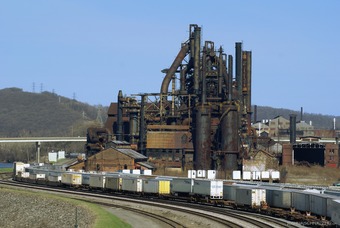
Deindustrialization and Redevelopment
This former Bethlehem Steel Plant in Pennsylvania was demolished after the company went out of business. It has been replaced by a casino.
17.5.3: The Potential of Urban Revitalization
Urban revitalization involves redeveloping blighted urban areas for new uses.
Learning Objective
Examine the postwar development of urban revitalization, specifically related to Title I of the Housing Act of 1949
Key Points
- Urban revitalization has been around since European city planners in the nineteenth century began to consider how to reorganize overpopulated urban areas.
- Title I of the Housing Act of 1949 kick-started the urban renewal program that would reshape American cities.
- Urban renewal can have many positive effects, including better quality housing, reduced sprawl, increased economic competitiveness, improved cultural and social amenities, and improved safety.
- The government has only had mixed success in actually restoring urban areas and has tried to rebrand urban renewal as community redevelopment.
Key Terms
- Housing Act of 1949
-
The American Housing Act of 1949 was a landmark, sweeping expansion of the federal role in mortgage insurance and issuance and the construction of public housing. It was part of Harry Truman’s program of domestic legislation, the Fair Deal.
- eminent domain
-
(US) The right of a government over the lands within its jurisdiction. Usually invoked to compel land owners to sell their property in preparation for a major construction project, such as a freeway.
Example
- The Chicago Housing Authority is transitioning from building high-rise complexes to mid-rise, mixed-income complexes. This shift is part of a large redevelopment plan that seeks to eradicate crime-ridden neighborhoods such as the Cabrini Green Housing Project.
Urban revitalization is hailed by many as a solution to the problems of urban decline by, as the term suggests, revitalizing decaying urban areas. Urban revitalization is closely related to processes of urban renewal, or programs of land redevelopment in areas of moderate- to high-density urban land use. Urban revitalization has been around since European city planners in the nineteenth century began to consider how to reorganize overpopulated urban areas. However, the modern instantiation of urban revitalization is very much a product of the post-World War II economic and social environment. With the influx of money following World War II, the federal government spotlighted American urban areas as the object of renovation.
Most of the postwar development was focused on suburbanization, but urban revitalization was a statutory corollary to suburban development. Title I of the Housing Act of 1949 kick-started the urban renewal program that would reshape American cities. The Act provided federal funding to cities to cover the cost of acquiring declining areas of cities perceived to be slums. According to the act, the federal government paid two-thirds of the cost of acquiring the site, called “the write down,” while the local governments paid for the remaining one-third. Most of the money went towards purchasing the property from the present owners. This process is called “eminent domain,” or the process through which the government acquires private property for the larger public good. The process of eminent domain requires that the government provide due compensation but does not necessarily require the private property owner’s consent. In the post-war era, after acquiring the properties, the government gave much of the land to private developers to construct new urban housing. These federal incentives to revitalize declining urban areas were particularly attractive to cities that were in states of economic decline at the time.
Urban revitalization certainly provides potential for future urban growth, though the story of successes and failures remains mixed so far. Urban renewal can have many positive effects. Replenished housing stock might signify an improvement in quality; urban renewal may increase density and reduce sprawl, and it might have economic benefits that improve the economic competitiveness of the city’s center. It can also improve cultural and social amenities, through the construction of public spaces and community centers, and can improve safety.

Melbourne Docklands Renewal
The Melbourne Docklands were once a vast expanse of unused docks, but they have now been turned into a residential and commercial development.
17.5.4: Urban Gentrification
Gentrification occurs when wealthier people buy or rent property in a low-income or working class neighborhood, displacing residents.
Learning Objective
Discuss the process of gentrification based on three models – demographic, sociocultural and political/economy
Key Points
- While gentrification can bring about higher tax revenues from higher property values, gentrification also dislocates pre-gentrification residents by raising rents beyond their price ranges.
- Gentrification has encountered backlash from the original residents of a community, many of whom organize to fight against the white and wealthy incoming population.
- Several explanations for gentrification exist, including a demographic-ecological model, a sociocultural model, and a political economic model.
Key Terms
- urban pioneers
-
In the 1970s, the first few suburban transplants were called urban pioneers and demonstrated that cities were actually appropriate and viable places to live.
- baby boomer generation
-
The baby boomer generation, or those born during the spike in births in the twenty years following World War II, is starting to reach senior citizenship, and will soon pull from the public funds of Social Security and Medicare.
- gentrification
-
The process of renewal and rebuilding accompanying the influx of middle class or affluent people into deteriorating areas that often displaces earlier usually poorer residents.
Example
- In Gentrification Amid Urban Decline: Strategies for America’s Older Cities, Michael Lang reports on the process and socioeconomic and cultural impact of gentrification in Darien Street in the Bella Vista neighborhood of Philadelphia. A portion of Darien Street is effectively an alleyway because it does not connect to any of the city’s main arteries or thoroughfares and was unpaved for most of its existence. In its early days, this alleyway housed only Italian families. After World War II, the local government launched plans to construct a cross-town highway, so most of the Italian inhabitants of Darien Street moved out; as they moved out, even poorer African-American residents moved in. By the early 1970s, Darien Street houses held very little property value and many homes were abandoned or beyond repair. In 1977, Philadelphia launched a gentrification effort. The first house that was rehabilitated was a corner property that a teacher remodeled and occupied. The next years featured mostly white, middle-class men moving into abandoned houses. Between 1977 and 1979, five of the seven pre-1977 families residing on Darien Street had been pushed out because of increased rents. The remaining two families rented and were expecting to be economically evicted. In five years, from 1977 to 1982, the gentrification of Darien Street replaced the original population, transitioning from seven black households and one white household to two black households and eleven white households. The average rent increased 488%, from $85 to $500 per month. By 1981, a house that had been purchased for $5,000 sold for $35,000. Of the five black households displaced, three found houses within two blocks of their original residence, one left Pennsylvania, and one moved into a public housing project five blocks away. The benefits of Darien Street gentrification included increased property tax revenues and an improved property quality. However, as with all gentrification processes, one must ask whether these improvements outweigh the displacement and economic evictions that they brought about.
Gentrification has gained attention over the last 50 years, as sociologists attempt to explain the influx of middle-class people to cities and neighborhoods and the displacement of lower-class working residents. Gentrification occurs when wealthier people buy or rent property in low-income or working class neighborhoods, driving up property values and rent. While it brings money into blighted urban areas, it often comes at the expense of poorer, pre-gentrification residents who cannot afford increased rents and property taxes .
The first urban pioneers in a gentrifying neighborhood may have lower incomes, but possess the cultural capital (e.g., education) characteristic of suburban residents. They are often socially and professionally dominant while economically marginalized. Partially due to their age and low-incomes, these individuals frequently reside in households with roommates and are more tolerant of the perceived evils of the city, such as crime, poor schools, and insufficient public services. Thus, they are willing to move into marginal neighborhoods. When the number of urban pioneers reaches such a critical mass, it attracts business investment and new amenities such as bars, restaurants, and art galleries. Once the urban pioneers and businesses have taken the financial risk out of the community, risk-averse investors and residents may enter the newly gentrified neighborhood. Renewed business attracts more investment capital and new residents, increasing local property values. Ironically, upon full gentrification, the urban pioneers are frequently evicted as rents and taxes rise, and the young, poor professionals can no longer afford to live in the area.
Gentrification is often resisted by those displaced by rising rents . However, while protests have an economic dimension, claims are usually articulated as a loss of culture or dismay over the homogenization and flattening of a formerly diverse neighborhood: gentrification generally increases the proportion of young, white, middle- to upper-income residents.
Explanations of Gentrification
Demographic
The demographic explanation emphasizes the impact of the baby boomer generation, born after World War II. In the 1970s, this led to a spike in the young adult population, increasing demand for housing. To meet the demand, urban areas had to be “recycled,” or gentrified. The new baby boomer residents departed from the suburban family idea, marrying later and having fewer children; women in the baby boomer generation were the first to enter the workforce in serious numbers. New urban residents were composed of higher, dual-income couples without children, less concerned about space for large families—one of the main draws to the suburbs for their parents. Instead, they were interested in living in cities close to their careers and enjoying the amenities their higher incomes could afford.
Sociocultural
The sociocultural explanation is based on the assumption that values and beliefs influence behavior. It focuses on the changing lifestyles and values of the middle- and upper-classes in the 1970s. At this time, the suburban ideal was falling out of favor; fewer people were moving to suburbs and more were moving back to cities. These first few suburban transplants, or urban pioneers, demonstrated that cities were viable places to live and began developing a type of inner-city chic that was attractive to other baby boomers, which in turn brought an influx of young affluence to inner cities.
Political Economy
Political economic explanations argue new economic or policy incentives contribute to gentrification. In part, the changing political climate of the 1950s and 1960s produced new civil rights legislation, such as anti-discrimination laws in housing and employment and desegregation laws. These policies enabled black families to move out of urban centers and into the suburbs, thus decreasing the availability of suburban land, while integrationist policies encouraged white movement into traditionally black urban areas.
An alternative explanation suggests that developers and government encouraged gentrification with an eye toward profit. Gentrification may be driven by governments hoping to raise property values and increase revenue from taxes. It may be the result of fluctuating relationships between capital investments and the production of urban space. During the two decades following World War II, low rents in the city’s periphery encouraged suburban development; as capital investment moved to suburbs, inner-city property values fell. Developers were able to see that they could purchase the devalued urban land, redevelop the properties, and turn a profit.

Artists move into Williamsburg
In Williamsburg and other parts of Brooklyn, New York, artists have adopted industrial spaces as studios and galleries. This cultural redevelopment is evidence of gentrification.
17.5.5: Shrinking Cities and Counter-Urbanization
Counterurbanization is movement away from cities, including suburbanization, exurbanization, or movement to rural areas.
Learning Objective
Analyze the reasons for suburbanization and counterurbanization, specifically white flight
Key Points
- White flight is one explanation for widespread counterurbanization in the post-WWII era in the U.S. It refers to the movement of middle and upper-class whites to suburbs to avoid living in areas with high proportions of racial minorities.
- Counterurbanization can lead to shrinking cities. Cities with declining populations experience economic strains as infrastructure exceeds the needs of a shrinking population and costs more per capita than during the city’s peak.
- Several approaches have been employed in attempts to address the problems of shrinking cities. Often these approaches aim to increase urban density.
Key Terms
- exurbanization
-
Exurbanization refers to the process in the 1990s when upper class city dwellers moved out of the city, beyond the suburbs, to live in high-end housing in the countryside.
- urban decay
-
Urban decay is a process whereby a city, or part of a city, falls into disrepair and decrepitude.
- white flight
-
The large-scale migration of whites of various European ancestries, from racially mixed urban regions to more racially homogeneous suburban areas.
Examples
- Baltimore, Maryland is an example of a U.S. shrinking city—its population has decreased by over 300,000 since 1950. As a result, the city has faced immense economic strain in recent decades and has seen a sharp rise in crime and poverty.
- Portland, Oregon is an example of a shrinking city that has successfully used policy to reduce the drainage of economic resources to suburbs, by instituting an urban growth boundary that prevents urban sprawl.
Suburbanization and Counterurbanization
Recently, in developed countries, sociologists have observed suburbanization and counterurbanization, or movement away from cities, which may be driven by transportation infrastructure or social factors like racism. In developing countries, urbanization is characterized by large-scale movements of people from the countryside into cities. In developed countries, people are able to move out of cities while maintaining many of the advantages of city life because improved communications and means of transportation. In fact, counterurbanization appears most common among the middle and upper classes who can afford to buy their own homes.
White Flight
Sociologists have posited many explanations for counterurbanization, but one of the most debated known as “white flight. ” The term “white flight” was coined in the mid-twentieth century to describe suburbanization and the large-scale migration of whites of various European ancestries from racially mixed urban regions to more racially homogeneous suburban regions. During the first half of the twentieth century, discriminatory housing policies often prevented blacks from moving to suburbs; banks and federal policy made it difficult for blacks to get the mortgages they needed to buy houses, and communities used restrictive housing covenants to exclude minorities.
White flight during the post-war period contributed to urban decay, a process whereby a city, or part of a city, falls into disrepair and decrepitude. Symptoms of urban decay include depopulation, abandoned buildings, high unemployment, crime, and a desolate, inhospitable landscape. White flight contributed to the draining of cities’ tax bases when middle-class people left. Urban decay was caused in part by the loss of industrial and manufacturing jobs as they moved into rural areas or overseas, where labor was cheaper.
Suburbanization
In the United States, suburbanization began in earnest after World War Two, when soldiers returned from war and received generous government support to finance new homes. These young men were also interested in settling down, buying their own homes, and achieving independence and a less hectic daily life with a more affordable cost of living than they could find in cities. Thus, suburbs were built—smaller cities located on the edges of a larger city, which often include residential neighborhoods for those working in the area. Suburbs grew dramatically in the 1950s when the U.S. Interstate Highway System was built and automobiles became affordable for middle class families.
Exurbanization
Around 1990, another trend emerged, called exurbanization: upper class city dwellers moved out of the city, beyond the suburbs, to live in high-end housing in the countryside. This exurbanization may be a new urban form. Rather than densely populated centers, cities may become more spread out, composed of many interconnected smaller towns. The history of counterurbanization calls into question depictions of urbanization as a one-way process. The modern U.S. experience has followed a circular pattern over the last 150 years, from a largely rural country, to a highly urban country, to a country with significant suburban populations.
Shrinking Cities
Whatever its causes, counterurbanization has had serious effects on cities. As a result of counterurbanization, some cities are now losing population. These shrinking cities may face serious problems as they attempt to maintain infrastructure built for a much larger population. As cities shrink, residents must contribute more per capita to maintain fixed infrastructure costs (e.g., for roads, sewers, and public transportation). Dispersed neighborhoods that characterize shrinking cities are also a major source of fiscal distress. These cities must still provide services like fire protection and trash pickup to fewer and fewer citizens over a larger geographic distance, raising the per capita cost.
Several approaches have been employed in attempts to address these problems. Often these approaches aim to increase urban density. For example, planners may revitalize core areas, like downtown, to make them more attractive to businesses and residents. Other cities have tried setting an urban growth boundary to limit sprawl, which increases density within the boundary. The boundary generally encompasses the city and its surrounding suburbs, requiring the entire area to work together to prevent urban shrinkage. This method is being used successfully in many cities (such as Portland, Oregon) to maximize returns on infrastructure investments.

Baltimore—A Shrinking City
Baltimore, Maryland is an example of a shrinking American city. Its population has decreased by over 300,000 since 1950, leaving infrastructure for a larger population unused.
Chapter 16: Economy
16.1: Economic Systems
16.1.1: The Economy
In the most simple of terms, economies consist of producing goods and exchanging them; they are fundamentally social systems.
Key Points
- Economies can be formal or informal, and economic activity can occur in various economic systems.
- Adam Smith is credited with formalizing capitalism in his 1776 book, The Wealth of Nations.
- Capitalism results from the interaction of commodities, money, labor, means of production, and production by consumers, laborers, and investors. The government avoids significant interference in the economy— the economy relies upon the law of supply and demand.
- Socialism is another type of economic system that seriously reorients the social and political institutions associated with the economy. Socialism and communism emphasize the public ownership of the means of production and public reallocation of wealth.
- An informal economy is economic activity that is neither taxed nor monitored by a government; the terms “under the table” and “off the books” typically refer to this type of economy. Informal economic activity can be found in various economic systems.
- Many European countries have robust socialist parties and policies.
Key Terms
- money
-
A generally accepted means of exchange and measure of value.
- production
-
Production is the act of creating output, a good or service which has value and contributes to the utility of individuals.
- economy
-
The system of production and distribution and consumption. The overall measure of a currency system; as the national economy.
Example
- The United States is an example of a capitalist economy. China and North Korea are examples of communist economies. France is an example of a largely socialist economy.
In the most simple of terms, economies consist of producing goods and exchanging them. Economies can be divided into formal economies and informal economies. A formal economy is the legal economy of a nation-state, as measured by a government’s gross national product (GNP), or the market value of all products and services produced by a country’s companies in a given year. Informal economies are frequently less institutionalized and include all economic practices that are neither taxed nor monitored by a government.
Economies are fundamentally social systems. They require exchanges or transactions; it is impossible for an individual to participate in an economy entirely independent of others. One cannot think of economies as discrete entities; economic systems necessarily interact with social and political systems.
Capitalism
Capitalism is an economic and social system in which capital and non-labor factors of production, or the means of production, are privately controlled; labor, goods, and capital are traded in markets; profits are taken by owners or invested in technologies and industries; and wages are paid to laborers. Though capitalism has developed incrementally since the sixteenth century, Scottish philosopher and economist Adam Smith is largely credited with outlining the theory in its most fully-fledged form in his 1776 tome An Inquiry into the Nature and Causes of the Wealth of Nations .
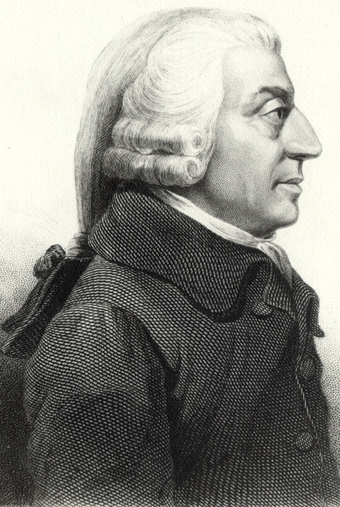
Profile of Adam Smith, by James Tassie, 1787
Author of the Wealth of Nations
The Market
A market is a central space of exchange through which people are able to buy and sell goods and services. In a capitalist economy, the prices of goods and services is mainly controlled through the principles of supply and demand and competition. “Supply and demand” refers to the balancing of the amount of a good or service produced and the amount available for sale . Prices rise when demand exceeds supply and fall when supply exceeds demand. The market coordinates itself through pricing until a new equilibrium price and quantity is reached. Competition arises when many producers are trying to sell the same or similar kinds of products to the same buyers.
The Government
Though the market is encouraged to act on its own, in any capitalist economy, the government is intimately involved in regulating the economy. This can be done through anti-trust laws or minimum wage laws. On a far more basic level, the government allows individuals to own private property and individuals to work where they please. The government generally allows businesses to set wages and prices for products without much interference. The government is responsible for issuing money, supervising public utilities, and enforcing private contracts. Laws protect competition and prohibit unfair business practices. Government agencies regulate the standards of service in many industries, such as airlines and broadcasting, and they finance a wide range of programs. Additionally, the government regulates the flow of capital and uses methods such as interest rates to control factors such as inflation and unemployment. Though the government in capitalist nations largely adheres to the basic principles of economic interference, it largely engages with the economy.
Socialism
Capitalism functions in distinction from socialism, or various theories of economic organization that advocate public or direct worker ownership and administration of the means of production. Socialism calls for public allocation of resources, creating a society characterized by equal access to resources for all individuals with a method of compensation based on the amount of labor expended. Many socialists criticize capitalism for unfairly concentrating power and wealth among a small segment of society that controls capital and derives its wealth through the exploitation of lower classes .
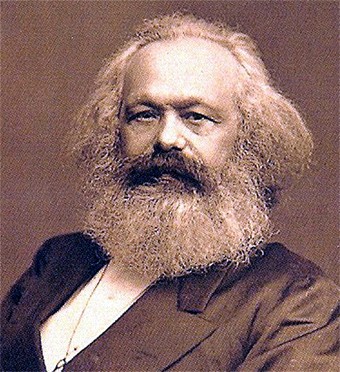
Karl Marx
Religion, Marx held, was a significant hindrance to reason, inherently masking the truth and misguiding followers.
The Informal Economy
An informal economy is economic activity that is neither taxed nor monitored by a government. Although the informal economy is often associated with developing countries, all economic systems contain an informal economy in some proportion. Informal economic activity is a dynamic process which includes many aspects of economic and social theory: exchange, regulation, and enforcement. By its nature, the informal economy is difficult to observe, study, define, and measure. The terms “under the table” and “off the books” typically refer to this type of economy, and there are various examples for this type of economic activity, including the sale and distribution of illegal drugs or unreported payments for house cleaning or baby sitting, among others.
16.1.2: Capitalism
Capitalism is a system that includes private ownership of the means of production, creation of goods for profit, competitive markets, etc.
Learning Objective
Examine the different views on capitalism (economical, political and historical) and the impact of capitalism on democracy
Key Points
- Economists usually focus on the degree that government does not have control over markets (laissez-faire), and on property rights.
- Most political economists emphasize private property, power relations, wage labor, and class and emphasize capitalism as a unique historical formation.
- Market failure occurs when an externality is present and a market will either under-produce a product with a positive externalization or overproduce a product that generates a negative externalization.
- The extension of universal adult male suffrage in 19th century Britain occurred with the development of industrial capitalism, and democracy became widespread at the same time as capitalism, leading many theorists to posit a causal relationship between them—claiming that one affects the other.
Key Terms
- voluntary exchange
-
Voluntary exchange is the act of buyers and sellers freely and willingly engaging in market transactions. Moreover, transactions are made in such a way that both the buyer and the seller are better off after the exchange than before it occurred.
- wage labor
-
The socioeconomic relationship between a worker and an employer, where the worker sells their labor under a formal or informal employment contract.
- externality
-
In economics, an externality, or transaction spillover, is a cost or benefit that is not transmitted through prices and is incurred by a party who was not involved as either a buyer or seller of the goods or services causing the cost or benefit.
Example
- An example of the state’s involvement in capitalist economies is the development of minimum wage laws.
Capitalism is generally considered by scholars to be an economic system that includes private ownership of the means of production, creation of goods or services for profit or income, the accumulation of capital, competitive markets, voluntary exchange, and wage labor. The designation is applied to a variety of historical cases, which vary in time, geography, politics, and culture.
Economists, political economists and historians have taken different perspectives on the analysis of capitalism. Economists usually focus on the degree that government does not have control over markets (laissez-faire economics), and on property rights. Most political economists emphasize private property, power relations, wage labor, class and capitalism’s as a unique historical formation. Capitalism is generally viewed as encouraging economic growth. The differing extents to which different markets are free, as well as the rules defining private property, are a matter of politics and policy, and many states have what are termed mixed economies. A number of political ideologies have emerged in support of various types of capitalism, the most prominent being economic liberalism.
The relationship between the state, its formal mechanisms, and capitalist societies has been debated in many fields of social and political theory, with active discussion since the 19th century. Hernando de Soto is a contemporary economist who has argued that an important characteristic of capitalism is the functioning state protection of property rights in a formal property system where ownership and transactions are clearly recorded.
The relationship between democracy and capitalism is a contentious area in theory and popular political movements. The extension of universal adult male suffrage in 19th century Britain occurred along with the development of industrial capitalism, and democracy became widespread at the same time as capitalism, leading many theorists to posit a causal relationship between them—claiming each affects the other. However, in the 20th century, capitalism also accompanied a variety of political formations quite distinct from liberal democracies, including fascist regimes, absolute monarchies, and single-party states.
16.1.3: The Marxist Critique of Capitalism
Karl Marx saw capitalism as a progressive historical stage that would eventually be followed by socialism.
Learning Objective
Examine Karl Marx’s view on capitalism and the criticisms of the capitalist system
Key Points
- Karl Marx saw capitalism as a progressive historical stage that would eventually stagnate due to internal contradictions and be followed by socialism.
- Marxists define capital as “a social, economic relation” between people (rather than between people and things). In this sense they seek to abolish capital.
- Revolutionary socialists believe that capitalism can only be overcome through revolution.
- Social democrats believe that structural change can come slowly through political reforms to capitalism.
- Marxists define capital as “a social, economic relation” between people (rather than between people and things).
- Normative Marxism advocates a revolutionary overthrow of capitalism that would lead to socialism, before eventually transforming into communism after class antagonisms and the state ceased to exist.
Key Terms
- revolution
-
A political upheaval in a government or nation-state characterized by great change.
- socialism
-
Any of various economic and political philosophies that support social equality, collective decision-making, distribution of income based on contribution and public ownership of productive capital and natural resources, as advocated by socialists.
- progressive
-
Favoring or promoting progress; advanced.
Example
- The Occupy Wall Street movement is an example of how many Americans are dissatisfied with the current capitalist system and seek more equal distribution of opportunity and goods.
Capitalism has been the subject of criticism from many perspectives during its history. Criticisms range from people who disagree with the principles of capitalism in its entirety, to those who disagree with particular outcomes of capitalism. Among those wishing to replace capitalism with a different method of production and social organization, a distinction can be made between those believing that capitalism can only be overcome with revolution (e.g., revolutionary socialism) and those believing that structural change can come slowly through political reforms to capitalism (e.g., classic social democracy).
Karl Marx saw capitalism as a progressive historical stage that would eventually stagnate due to internal contradictions and be followed by socialism. Marxists define capital as “a social, economic relation” between people (rather than between people and things). In this sense they seek to abolish capital. They believe that private ownership of the means of production enriches capitalists (owners of capital) at the expense of workers. In brief, they argue that the owners of the means of production exploit the workforce.
In Karl Marx’s view, the dynamic of capital would eventually impoverish the working class and thereby create the social conditions for a revolution. Private ownership over the means of production and distribution is seen as creating a dependence of non-owning classes on the ruling class, and ultimately as a source of restriction of human freedom.
Marxists have offered various related lines of argument claiming that capitalism is a contradiction-laden system characterized by recurring crises that have a tendency towards increasing severity. They have argued that this tendency of the system to unravel, combined with a socialization process that links workers in a worldwide market, create the objective conditions for revolutionary change. Capitalism is seen as just one stage in the evolution of the economic system.
Normative Marxism advocates for a revolutionary overthrow of capitalism that would lead to socialism, before eventually transforming into communism after class antagonisms and the state cease to exist. Marxism influenced social democratic and labor parties as well as some moderate democratic socialists, who seek change through existing democratic channels instead of revolution, and believe that capitalism should be regulated rather than abolished.
16.1.4: Socialism
Socialism is an economic system in which the means of production are socially owned and used to meet human needs, not to create profits.
Learning Objective
Discuss the various implementations of socialism, from reformism to revolutionary socialism
Key Points
- Socialists critique capitalism, arguing that it creates inequality and limits human potential. Socialists maintain that capitalism derives wealth from a system of labor exploitation and then concentrates wealth and power within a small segment of society that controls the means of production.
- As a political movement, socialism includes a diverse array of political philosophies, ranging from reformism to revolutionary socialism, from a planned economy to market socialism.
- A planned economy is a type of economy consisting of a mixture of public ownership of the means of production and the coordination of production and distribution through state planning.
- Market socialism consists of publicly owned or cooperatively owned enterprises operating in a market economy.
- Socialists argue that socialism would allow for wealth to be distributed based on how much one contributes to society, as opposed to how much capital one owns. A primary goal of socialism is social equality and a distribution of wealth based on one’s contribution to society.
Key Terms
- socialism
-
Any of various economic and political philosophies that support social equality, collective decision-making, distribution of income based on contribution and public ownership of productive capital and natural resources, as advocated by socialists.
- market socialism
-
Market socialism refers to various economic systems where the means of production are either publicly owned or cooperatively owned and operated for a profit in a market economy. The profit generated by the firms would be used to directly remunerate employees or would be the source of public finance or could be distributed among the population through a social dividend.
- planned economy
-
An economic system in which government directly manages supply and demand for goods and services by controlling production, prices, and distribution in accordance with a long-term design and schedule of objectives.
Example
- France is an example of a socialist democracy. In 2012, François Hollande democratically won the presidency on a Socialist Party ticket.
Socialism is an economic system in which the means of production are socially owned and used to meet human needs instead of to create profits. The means of production refers to the tools, technology, buildings, and other materials used to make the goods or services in an economy. Social ownership of the means of production can take many forms. It could refer to cooperative enterprises, common ownership, direct public ownership, or autonomous state enterprises. Social ownership contrasts with capitalist ownership, in which the means of production are used to create a profit. In a socialist economic system, the means of production would instead be used to directly satisfy economic demands and human needs. Accounting would be based on physical quantities or a direct measure of labor-time instead of on profits and expenses.
Although socialism is often associated with Karl Marx , it has evolved to take a variety of forms. As a political movement, socialism includes a diverse array of political philosophies, ranging from reformism to revolutionary socialism, from a planned economy to market socialism. In a planned economy, the means of production are publicly owned and the government is in charge of coordinating and distributing production. By contrast, in market socialism, the means of production may be publicly or cooperatively owned, but they operate in a market economy. That is, market socialism uses the market and monetary prices to allocate and account for the means of production and the products they create. Just like in capitalism, the means of production generate profit; however, that profit would be used to remunerate employees or finance public institutions, not to benefit private owners.
Socialists critique capitalism, arguing that it derives wealth from a system of labor exploitation and then concentrates wealth and power within a small segment of society that controls the means of production. As a result, society is stratified, split into classes according to who owns the means of production and who is forced to sell their labor; as a result, individuals do not all have the same opportunity to maximize their potential. A capitalist society, they argue, does not utilize available technology and resources to their maximum potential in the interests of the public. Instead, it focuses on satisfying market-induced wants as opposed to human needs. Socialists argue that socialism would allow for wealth to be distributed based on how much one contributes to society, as opposed to how much capital one owns. A primary goal of socialism is social equality and a distribution of wealth based on one’s contribution to society, and an economic arrangement that would serve the interests of society as a whole.

Socialism in Europe
Europe has far more socialist democracies than the United States. François Hollande won the French presidency on the Socialist Party ticket in 2012.
16.1.5: The Capitalist Critique of Socialism
Critiques of socialism generally refer to its lack of efficiency and feasibility, as well as the political/social effects of such a system.
Learning Objective
Analyze the various criticisms of socialism
Key Points
- Some critics consider socialism to be a purely theoretical concept that should be criticized on theoretical grounds; others hold that certain historical examples exist, making it possible to criticize on practical grounds.
- Some critics of socialism argue that income sharing reduces individual incentives to work; incomes should be individualized as much as possible.
- Milton Friedman, an economist, argued that socialism—which he defined as state ownership over the means of production—impedes technological progress due to stifled competition.
- The philosopher Friedrich Hayek argued that the road to socialism leads society to totalitarianism.
Key Terms
- libertarian
-
A believer in a political doctrine that emphasizes individual liberty and a lack of governmental regulation and oversight both in matters of the economy (‘free market’) and in personal behavior.
- economic liberals
-
Economic liberalism is the ideological belief in organizing the economy on individualist lines, such that the greatest possible number of economic decisions are made by private individuals and not by collective institutions.
- classical liberals
-
Classical liberals believe in classical liberalism, a political ideology developed in the 19th century that advocates limited government, constitutionalism, rule of law, due process, and individual liberties including freedom of religion, speech, press, assembly, and free markets.
Example
- Milton Friedman supported his assertion that socialism fails by taking a look at the American economy, contending that the weakest areas were those that were state-owned.
Criticism of socialism refers to a critique of socialist models of economic organization, efficiency, and feasibility, as well as the political and social implications of such a system. Some of these criticisms are not directed toward socialism as a system, but directed toward the socialist movement, socialist political parties, or existing socialist states. Some critics consider socialism to be a purely theoretical concept that should be criticized on theoretical grounds; others hold that certain historical examples exist, making it possible to criticize on practical grounds.
Economic liberals, pro-capitalist libertarians, and some classical liberals view private enterprise, private ownership of the means of production, and the market exchange as central to conceptions of freedom and liberty. Milton Friedman, an economist, argued that socialism—which he defined as state ownership over the means of production—impedes technological progress due to stifled competition . He pointed to the U.S. to see where socialism fails, observing that the most technologically backward areas are those where government owns the means of production. Some critics of socialism argue that income sharing reduces individual incentives to work; incomes should be individualized as much as possible. Critics of socialism have argued that in any society where everyone holds equal wealth there can be no material incentive to work because one does not receive rewards for a work well done.
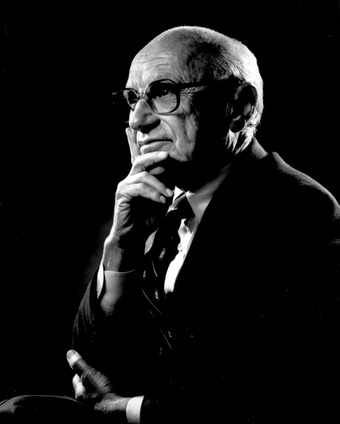
Milton Friedman
Milton Friedman argued against the effects of socialism.
The philosopher Friedrich Hayek argued in his book The Road to Serfdom that the more even distribution of wealth through the nationalization of the means of production advocated by certain socialists cannot be achieved without a loss of political, economic, and human rights. According to Hayek, to achieve control over means of production and distribution of wealth, it is necessary for such socialists to acquire significant powers of coercion. He argued that the road to socialism leads society to totalitarianism, and that fascism and Nazism were the inevitable outcome of socialist trends in Italy and Germany during the preceding period.
Milton Friedman argued that the absence of voluntary economic activity makes it too easy for repressive political leaders to grant themselves coercive powers. Friedman’s view was shared by Friedrich Hayek and John Maynard Keynes, both of whom believed that capitalism is vital for freedom to survive and thrive.
16.1.6: Democratic Socialism
Democratic socialism combines the political philosophy of democracy with the economic philosophy of socialism.
Learning Objective
Discuss democratic socialism and how it differs from other ideas held by the government about the working class
Key Points
- Democratic socialism is contrasted with political movements that resort to authoritarian means to achieve a transition to socialism. It advocates the immediate creation of decentralized economic democracy from the grassroots level.
- Democratic socialists distinguish themselves from Leninists, who believe in an organized revolution instigated and directed by an overarching vanguard party that operates on the basis of democratic centralism.
- Eugene V. Debs, one of the most famous American socialists, led a movement centered around democratic socialism and made five bids for president.
- In Britain, the democratic socialist tradition was represented in particular by William Morris’ Socialist League and, in the 1880s, by the Fabian Society.
- In Britain, the democratic socialist tradition was represented in particular by William Morris’ Socialist League and, in the 1880s, by the Fabian Society.
Key Terms
- democratic socialism
-
A left-wing ideology that aims to introduce democracy into the workforce, i.e. worker cooperatives, and ensure public provision of basic human needs.
- Leninism
-
In Marxist philosophy, Leninism is the body of political theory for the democratic organisation of a revolutionary vanguard party, and the achievement of a direct-democracy dictatorship of the proletariat, as political prelude to the establishment of socialism.
- Fabian Society
-
The Fabian Society is a British socialist organization whose purpose is to advance the principles of democratic socialism via gradualist and reformist, rather than revolutionary, means.
Example
- France is an example of a democratic socialist state. France subscribes to a democratic structure of free elections and the country recently elected a socialist president.
Democratic socialism combines the political philosophy of democracy with the economic philosophy of socialism. The term can refer to a range of political and economic organizational schemes. On one end, democratic socialism may combine a democratic national political system with a national economy based on socialist principles. On the other end, democratic socialism may refer to a system that uses democratic principles to organize workers in a firm or community (for example, in worker cooperatives).
The term is used by socialist movements and organizations to emphasize the democratic character of their political orientation. Democratic socialism contrasts with political movements that resort to authoritarian means to achieve a transition to socialism. Rather than focus on central planning, democratic socialism advocates the immediate creation of decentralized economic democracy from the grassroots level—undertaken by and for the working class itself. Specifically, it is a term used to distinguish between socialists who favor a grassroots-level, spontaneous revolution (referred to as gradualism) from those socialists who favor Leninism (organized revolution instigated and directed by an overarching vanguard party that operates on the basis of democratic centralism).
Historical Examples
The term has also been used by various historians to describe the ideal of economic socialism in an established political democracy. Democratic socialism became a prominent movement at the end of the 19th century. In the United States, Eugene V. Debs, one of the most famous American socialists, led a movement centered around democratic socialism. Debs made five bids for president: once in 1900 as candidate of the Social Democratic Party and then four more times on the ticket of the Socialist Party of America. In Britain, the democratic socialist tradition was represented historically by William Morris’s Socialist League and, in the 1880s, by the Fabian Society.
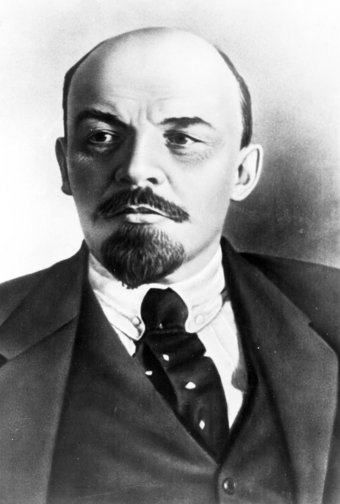
Vladimir Lenin
Leninism is based on the philosophy of Vladimir Lenin, who advocated organized revolution led by a vanguard party.
16.1.7: Informal Economy
The informal economy consists of economic activity that is neither taxed nor regulated by a government.
Learning Objective
Analyze the impact of the informal economy on formal economy, such as the black market or working “under the table”
Key Points
- Informal economies include economic practices that are not included in the calculation of GNP (the market value of all products and services produced by a country’s companies in a given year).
- Participation in the informal economy may result from lack of other options (e.g. people may buy goods on the black market because these goods are unavailable through conventional means). Participation may also be driven by a wish to avoid regulation or taxation.
- The growth of the informal economy is often attributed to changing social or economic environments. For example, with the adoption of more technologically intensive forms of production, many workers have been forced out of formal sector work and into informal employment.
- Growing regulation and taxation may also force people into the informal economy.
- The informal economy accounts for about 15 percent of employment in developed countries such as the United States.
Key Terms
- welfare capitalism
-
Welfare capitalism refers either to the combination of a capitalist economic system with a welfare state or, in the American context, to the practice of businesses providing welfare-like services to employees.
- industrial paternalism
-
Industrial paternalism is a form of welfare capitalism especially common in the United States. It refers to the practice of businesses providing welfare-like services to employees.
- Progressive Era
-
The Progressive Era in the United States was a period of social activism and political reform that flourished from the 1890s to the 1920s.
Example
- Drug dealing, babysitting, unpaid housework, and unreported self-employment are all examples of work in the informal economy.
The informal economy consists of economic activity that is neither taxed nor regulated by a government. This is in contrast to the formal economy; a formal economy includes economic activity that is legal according to national law. Formal economy goods may be taxed and are included in the calculation of a government’s gross national product (GNP), which is the market value of all products and services produced by a country’s companies in a given year. Informal economies are frequently less institutionalized and include all economic practices that are not included in the calculation of GNP. Informal economies therefore include such disparate practices as the drug trade and babysitting—anything that isn’t reported to the government or factored into the nation’s GNP . All economies have informal elements.

Drugs in the Informal Economy
Dealing drugs is an example of participation in the informal economy.
The original use of the term ‘informal sector’ is attributed to the economic development model put forward by W. Arthur Lewis, used to describe employment or livelihood creation and sustainability primarily within the developing world. It was used to describe a type of employment that was viewed as falling outside of the modern industrial sector. Participation in the informal economy may result from lack of other options (e.g. people may buy goods on the black market because these goods are unavailable through conventional means). Participation may also be driven by a wish to avoid regulation or taxation. This may manifest as unreported employment, hidden from the state for tax, social security or labor law purposes, but legal in all other aspects.
The growth of the informal economy is often attributed to changing social or economic environments. For example, with the adoption of more technologically intensive forms of production, many workers have been forced out of formal sector work and into informal employment. Arguably the most influential book on informal economy is Hernando de Soto’s The Other Path. De Soto and his team argue that excessive regulation in the Peruvian (and other Latin American) economies force a large part of the economy into informality and thus prevent economic development. In a widely cited experiment, his team tried to legally register a small garment factory in Lima. This took more than one hundred administrative steps and almost a year of full-time work. Whereas de Soto’s work is popular with policymakers and champions of free market policies, many scholars of the informal economy have criticized it both for methodological flaws and normative bias.
The informal economy accounts for about 15 percent of employment in developed countries such as the United States. By contrast, it makes up 48 percent of non-agricultural employment in North Africa, 51 percent in Latin America, 65 percent in Asia, and 72 percent in sub-Saharan Africa. If agricultural employment is included, the percentages rise—beyond 90 percent in places like India and many sub-Saharan African countries .
16.1.8: Welfare State Capitalism
Welfare capitalism refers to a welfare state in a capitalist economic system or to businesses providing welfare-like services to employees.
Learning Objective
Discuss how welfare capitalism impacts the worker and the business, in terms of costs and benefits for both
Key Points
- In the United States, the mid-twentieth century marked the height of business provisions for employees, including benefits such as more generous retirement packages and health care.
- Not all companies provided good benefits, so workers appealed to government, which imposed minimum labor standards (e.g., the minimum wage) to protect workers.
- Welfare capitalism still operates in the United States, where the government ensures minimum labor standards; some companies continue to offer benefits.
Key Terms
- welfare capitalism
-
Welfare capitalism refers either to the combination of a capitalist economic system with a welfare state or, in the American context, to the practice of businesses providing welfare-like services to employees.
- industrial paternalism
-
Industrial paternalism is a form of welfare capitalism especially common in the United States. It refers to the practice of businesses providing welfare-like services to employees.
- Progressive Era
-
The Progressive Era in the United States was a period of social activism and political reform that flourished from the 1890s to the 1920s.
Example
- Google is an example of a modern company acting under welfare capitalism in that it provides services to its employees.
Welfare capitalism refers either to the combination of a capitalist economic system with a welfare state or, in the American context, to the practice of private businesses providing welfare-like services to employees. In this second form of welfare capitalism, also known as industrial paternalism, companies have a two-fold interest in providing these services. First, the companies act in a paternalistic manner, giving employees what managers think is best for them. Second, the companies recognize that providing workers with some minor benefits can forestall complaints about larger structural issues, such as unsafe conditions and long hours.
Following this logic, in the nineteenth century, some manufacturing companies began offering new benefits for their employees. Companies sponsored sports teams, established social clubs, and provided educational and cultural activities for workers. Some companies even provided housing, such as the boarding houses provided for female employees of textile manufacturers in Lowell, Massachusetts. The mid-twentieth century marked the height of business provisions for employees, including benefits such as more generous retirement packages and health care.
However, even at the peak of this form of welfare capitalism, not all workers enjoyed the same benefits. Business-led welfare capitalism was only common in American industries that employed skilled labor. Not all companies freely choose to provide even minor benefits to workers. As workers became frustrated with meager or nonexistent benefits, they appealed to government for help, giving rise to the first form of welfare capitalism: welfare provisions provided by the state within the context of a capitalist economy. In the United States, workers formed labor unions to gain greater collective bargaining power. In addition to directly challenging businesses, they lobbied the government to enact basic standards of labor. In the United States, the first two decades of the twentieth century—the Progressive Era—saw an increase in the number of protections the government was able to extend to workers. Yet by mid-century, many of these protections had been pushed back through the court system.
Today, the government provides very basic standards by which employers must abide, such as minimum wage standards . Anything above the minimum required by the government is at the employer’s discretion. Recently, companies have begun to invest even more in the perks provided by the business in an effort to satisfy employees. Companies have found that employees make fewer demands and are more productive when they are happier, so companies such as Google have spent millions of dollars making their businesses enjoyable places to work .
16.2: The Transformation of Economic Systems
16.2.1: Preindustrial Societies: The Birth of Inequality
Pre-industrial typically have predominantly agricultural economies and limited production, division of labor, and class variation.
Learning Objective
Discuss the different types of societies and economies that existed during the pre-Industrial age
Key Points
- A hunter-gatherer society is one in which most or all food is obtained from wild plants and animals, in contrast to an agricultural society that relies mainly on domesticated species.
- Feudalism was a set of legal and military customs in medieval Europe that flourished between the ninth and fifteenth centuries, and, broadly defined, was a system for structuring society around relationships derived from the holding of land in exchange for service or labor.
- Manorialism, an essential element of feudal society, was the organizing principle of rural economy that originated in the villa system of the Late Roman Empire.
Key Terms
- feudalism
-
A social system that is based on personal ownership of resources and personal fealty between a suzerain (lord) and a vassal (subject). Defining characteristics of feudalism are direct ownership of resources, personal loyalty, and a hierarchical social structure reinforced by religion.
- manorialism
-
A political, economic, and social system in medieval and early modern Europe; originally a form of serfdom but later a looser system in which land was administered via the local manor.
- pre-industrial society
-
Pre-industrial society refers to specific social attributes and forms of political and cultural organization that were prevalent before the advent of the Industrial Revolution. It is followed by the industrial society.
Example
- Medieval Europe was a pre-industrial feudal society. The economy was based mostly on agricultural production. Instead of producing crops for a market, workers exchanged the crops they grew for access to land, which was owned by a feudal lord. The economy was based on the exchange of labor for land instead of the exchange of wages for labor that is typical in industrial society.
Pre-industrial societies are societies that existed before the Industrial Revolution, which took place in the eighteenth and nineteenth centuries. Some remote societies today may share characteristics with these historical societies, and may, therefore, also be referred to as pre-industrial. In general, pre-industrial societies share certain social attributes and forms of political and cultural organization, including limited production, a predominantly agricultural economy, limited division of labor, limited variation of social class, and parochialism at large. While pre-industrial societies share these characteristics in common, they may otherwise take on very different forms. Two specific forms of pre-industrial society are hunter-gatherer societies and feudal societies.
A hunter-gatherer society is one in which most or all food is obtained by gathering wild plants and hunting wild animals, in contrast to agricultural societies which rely mainly on domesticated species. Hunter-gatherer societies tend to be very mobile, following their food sources. They tend to have relatively non-hierarchical, egalitarian social structures, often including a high degree of gender equality. Full-time leaders, bureaucrats, or artisans are rarely supported by these societies. Hunter-gatherer group membership is often based on kinship and band (or tribe) membership. Following the invention of agriculture, hunter-gatherers in most parts of the world were displaced by farming or pastoral groups who staked out land and settled it, cultivating it or turning it into pasture for livestock. Only a few contemporary societies are classified as hunter-gatherers, and many supplement their foraging activity with farming or raising domesticated animals.
Feudalism was a set of legal and military customs in medieval Europe that flourished between the nineteenth and fifteenth centuries. Broadly speaking, feudalism structured society around relationships based on land ownership. Feudal lords were landowners; in exchange for access to land for living and farming, serfs offered lords their service or labor. This arrangement (land access in exchange for labor) is sometimes called “manorialism,” an organizing principle of rural economy that originated in the villa system of the Late Roman Empire. Manorialism was widely practiced in medieval western and parts of central Europe, until it was slowly replaced by the advent of a money-based market economy and new forms of agrarian contract.

Feudal Manor
This painting from feudal time shows how fields surrounded the feudal manor where the noble who owned the farms lived–a good depiction of how society was oriented around the agricultural economy.
16.2.2: Industrial Societies: The Birth of the Machine
During the Industrial Revolution (roughly 1750 to 1850) changes in technology had a profound effect on social and economic conditions.
Learning Objective
Analyze the shift from manual to machine based labor during the First and Second Industrial Revolutions
Key Points
- The First Industrial Revolution, which began in the 18th century, merged into the Second Industrial Revolution around 1850.
- Great Britain provided the legal and cultural foundations that enabled entrepreneurs to pioneer the Industrial Revolution.
- Starting in the latter part of the 18th century, there began a transition in parts of Great Britain’s previously manual labor and draft-animal-based economy towards machine-based manufacturing.
- The introduction of steam power fuelled primarily by coal, wider utilization of water wheels, and powered machinery—mainly in textile manufacturing—underpinned the dramatic increases in production capacity.
- The effects spread throughout Western Europe and North America during the 19th century, eventually affecting most of the world, a process that continues as industrialization today.
Key Terms
- industrialization
-
A process of social and economic change whereby a human society is transformed from a pre-industrial to an industrial state
- Industrial Revolution
-
The major technological, socioeconomic, and cultural change in the late 18th and early 19th century, resulting from the replacement of an economy based on manual labor to one dominated by industry and machine manufacturing.
- steam power
-
Power derived from water heated into steam, usually converted to motive power by a reciprocating engine or turbine.
Example
- Examples of the technological innovation of the Industrial Revolution include the invention of steam and coal engines. These technologies enabled a reconfiguration of the economic system, as machines were now able to perform functions that previously had to be performed by people.
The Industrial Revolution was a period from 1750 to 1850 where changes in agriculture, manufacturing, mining, transportation, and technology had a profound effect on the social, economic and cultural conditions of the times. It began in the United Kingdom, and then subsequently spread throughout Western Europe, North America, Japan, and eventually the rest of the world. The Industrial Revolution marks a major turning point in history; almost every aspect of daily life was influenced in some way. Most notably, average income and population began to exhibit unprecedented sustained growth. In the two centuries following 1800, the world’s average per capita income increased more than tenfold, while the world’s population increased over sixfold.
The First Industrial Revolution, which began in the 18th century, merged into the Second Industrial Revolution around 1850, when technological and economic progress gained momentum with the development of steam-powered ships, railways, and later in the 19th century with the internal combustion engine and electrical power generation. The period of time covered by the Industrial Revolution varies with different historians. Eric Hobsbawm held that it “broke out” in Britain in the 1780s and was not fully felt until the 1830s or 1840s, while T. S. Ashton held that it occurred roughly between 1760 and 1830.
Great Britain provided the legal and cultural foundations that enabled entrepreneurs to pioneer the Industrial Revolution. Starting in the later part of the 18th century, there began a transition in parts of Great Britain’s previously manual labor and draft-animal-based economy toward machine-based manufacturing. It started with the mechanization of the textile industries, the development of iron-making techniques and the increased use of refined coal. Trade expansion was enabled by the introduction of canals, improved roads and railways. With the transition away from an agricultural-based economy and toward machine-based manufacturing came a great influx of population from the countryside and into the towns and cities, which swelled in population.
The introduction of steam power fuelled primarily by coal, wider utilization of water wheels, and powered machinery—mainly in textile manufacturing —underpinned the dramatic increases in production capacity. The development of all-metal machine tools in the first two decades of the 19th century facilitated the manufacturing of more production machines for manufacturing in other industries. The effects spread throughout Western Europe and North America during the 19th century, eventually affecting most of the world, a process that continues as industrialization today. The impact of this change on society was enormous.

Savery Engine
The Savery Engine, invented in 1698, was one of the first steam engines available commercially. It dramatically changed how the economic system functioned.
16.2.3: Postindustrial Societies: The Birth of the Information Age
In the “Information Age,” individuals can transfer and have instant access to information, leading to a profound economic transformation.
Learning Objective
Examine the impact the Information Age has on the accessibility and breadth of information available to society
Key Points
- The Information Age formed by capitalizing on the computer microminiaturization advances, with a transition spanning from the advent of the personal computer in the late 1970s to the Internet reaching a critical mass in the early 1990s.
- Though the Internet itself has existed since 1969, it was the invention of the World Wide Web in 1989 by British scientist Tim Berners-Lee and its implementation in 1991 that allowed the Internet to truly became a global network.
- In the latter decades of the 20th century, the industrial world has been shifting into a service economy, where an increasing number of people hold jobs as clerks in stores, office workers, teachers, nurses, etc.
Key Terms
- Information Age
-
The current era, characterized by the increasing importance and availability of information (especially by means of computers), as opposed to previous eras (such as the Industrial Age) in which most endeavors related to some physical, man-made process or product.
- the internet
-
A global system of interconnected computer networks that use the standard internet protocol suite (often called TCP/IP, although not all applications use TCP) to serve billions of users worldwide. It is a network of networks that consists of millions of private, public, academic, business, and government networks, of local to global scope, that are linked by a broad array of electronic, wireless, and optical networking technologies.
- service economy
-
Service economy refers to the increased importance of the service sector compared to the manufacturing sector. The service economy in developing countries is mostly concentrated in financial services, hospitality, retail, health, human services, information technology, and education.
Example
- An example of the Information Age is how virtually every individual uses the Internet in some way at their place of work.
The Information Age is a concept that characterizes the current age by the ability of individuals to transfer information freely and have instant access to information that would have been difficult or impossible to access in the past. The idea is linked to the concept of a digital age or digital revolution, as most of this information is instantaneously available online. It carries with it the ramifications of a shift from an industrialized economy to an economy based on the manipulation of information, or an information society.
The Information Age formed by capitalizing on computer microminiaturization advances. The transition spans from the advent of the personal computer in the late 1970s to the Internet reaching a critical mass in the early 1990s, with the public’s adoption of the Internet in the two decades following 1990. The Information Age has allowed rapid global communications and networking to shape modern society due to the fast evolution of technology use in daily life.
Though the Internet itself has existed since 1969, it was the invention of the World Wide Web in 1989 by British scientist Tim Berners-Lee and its implementation in 1991 that allowed the Internet to truly became a global network. Today, the Internet has become the ultimate platform for accelerating the flow of information and is the fastest-growing form of media .

Internet Usage
This graph shows the drastic increase in Internet usage, indicative of the pervasiveness of the Information Age.
Concurrently, during the 1980s and 1990s in the United States, Canada, Australia, New Zealand, and Western Europe, there was a steady trend away from people holding Industrial Age manufacturing jobs. An increasing number of people held jobs as clerks in stores, office workers, teachers, nurses, etc. Many argue that jobs traditionally associated with the middle class (assembly line workers, data processors, foremen, and supervisors) are beginning to disappear, either through outsourcing or automation. Individuals who lose their jobs must either move up, joining a group of “mind workers” (engineers, attorneys, scientists, professors, executives, journalists, consultants, etc.), or settle for low-skill, low-wage service jobs.
16.2.4: Capitalism in a Global Economy
Some thinkers argue that in the last few decades trends associated with globalization have increased the mobility of people and capital.
Learning Objective
Analyze the shift in the job market and increase in international trade due to an increase in globalization
Key Points
- The world economy generally refers to the economy based on the national economies of all of the world’s countries.
- Although international trade has been associated with the development of capitalism for over five hundred years, some thinkers argue that a number of trends associated with globalization have acted to increase the mobility of people and capital since the last quarter of the 20th century.
- The global financial system is the financial system consisting of institutions and regulators that act on the international level, as opposed to those that act on a national or regional level.
- Globalization refers to the increasing global relationships of culture, people, and economic activity.
- The establishment of the WTO in 1995 led to an anti-globalization movement that was primarily concerned with the negative impact of globalization in developing countries.
- Critiques of economic globalization typically look at both the damage to the planet as well as the human costs.
Key Terms
- globalization
-
A common term for processes of international integration arising from increasing human connectivity and interchange of worldviews, products, ideas, and other cultural phenomena. In particular, advances in transportation and telecommunications infrastructure, including the rise of the Internet, represent major driving factors in globalization and precipitate the further interdependence of economic and cultural activities.
- WTO
-
The World Trade Organization (WTO) is an organization that intends to supervise and liberalize international trade. It officially commenced on January 1, 1995 under the Marrakech Agreement, replacing the General Agreement on Tariffs and Trade (GATT), which commenced in 1948. It deals with regulation of trade between participating countries and provides a framework for negotiating and formalizing trade agreements and for resolving disputes.
- global financial system
-
The global financial system is the financial system consisting of institutions and regulators that act on the international level, as opposed to those that act on a national or regional level. The main players are the global institutions, such as International Monetary Fund and Bank for International Settlements, national agencies and government departments, e.g., central banks and finance ministries, private institutions acting on the global scale, e.g., banks and hedge funds, and regional institutions, e.g., the Eurozone.
Example
- Information, goods, ideas, and cultural norms are able to spread more quickly around the world than ever before, largely due to innovations and price drops in the telecommunications industry. For example, these innovations have allowed Coca Cola to spread its goods around the world. This is an example of globalization.
The term “world economy” refers to the economic situation of all of the world’s countries. It is common to limit discussion of world economy exclusively to human economic activity. World economy is typically judged in monetary terms, even in cases in which there is no efficient market to help valuate certain goods or services, or in cases in which a lack of independent research or government cooperation makes establishing figures difficult.
The global financial system is the financial system consisting of institutions and regulators that act on the international level, as opposed to those that act on a national or regional level. The main players are global institutions, such as International Monetary Fund, World Bank, and the Bank for International Settlements; national agencies and government departments (e.g., central banks and finance ministries); private institutions acting on the global scale (e.g., banks, hedge funds), and regional institutions such as the Eurozone.
Although international trade has always existed, some thinkers argue that a number of trends associated with globalization have caused an increase in the mobility of people and capital since the last quarter of the 20th century. Today, these trends have bolstered the argument that capitalism should now be viewed as a true world system, given that all national economies trade with capitalist states and are therefore influenced by capitalist policies.
Globalization refers to the increasing global relationships of culture, people, and economic activity. It is generally used to refer to economic globalization: the global distribution of the production of goods and services, through reduction of barriers to international trade such as tariffs, export fees, and import quotas; and the reduction of restrictions on the movement of capital and on investment. Globalization may contribute to economic growth in developed and developing countries through increased specialization and the principle of comparative advantage.

Globalization
Singapore embraced globalization and became a highly developed country
16.2.5: Global Trade: Inequalities and Conflict
Global trade (exchange across international borders) has increased with better transportation and governments adopting free trade.
Learning Objective
Analyze the impact of global trade on society and industry, ranging from mercantilism to free trade orientation
Key Points
- While international trade has been present throughout much of history, its economic, social, and political importance has been on the rise in recent centuries as free trade has overtaken mercantilism and governments have reduced tariffs and other barriers to trade.
- Traditionally, trade was regulated through bilateral treaties between two nations, but it is increasingly regulated by multilateral agreements and international bodies, such as the World Trade Organization.
- Free trade is on the rise, but most countries maintain some level of protectionism in the form of subsidies or tariffs to protect industries considered essential to national security or national economies (e.g., food and steel production).
- Arguments against free trade criticize the assumptions of economic theories underlying it and its possible social and political effects, including inequality and cultural homogenization.
- In the last few decades, fair trade has been proposed as an alternative to free trade.
- Economic arguments against free trade criticize the assumptions or conclusions of economic theories.
- Sociopolitical arguments against free trade cite social and political effects that economic arguments do not capture.
- An alternative concept to free trade in the last decades has been become fair trade.
Key Terms
- free trade
-
international trade free from government interference, especially trade free from tariffs or duties on imports
- World Trade Organization
-
An international organization designed by its founders to supervise and liberalize international trade.
- protectionism
-
A policy of protecting the domestic producers of a product by imposing tariffs, quotas, or other barriers on imports.
Example
- The United States is party to many trade agreements, but one of the best known is the North America Free Trade Agreement (NAFTA). Like other free trade agreements, NAFTA promotes free trade among members, which include the United States, Canada, and Mexico.
Global trade is the exchange of money, goods, and services across international borders. As transportation has improved, global trade has increased, and businesses have pressured governments to relax restrictions on trade. In most countries, global trade now accounts for many of the goods and services bought or sold, and many companies earn profits from global trade.
For centuries, governments restricted international trade based on the principles of mercantilism, which maintained that countries were all competing to maximize their stores of gold. Accordingly, governments imposed high tariffs to limit imports and promoted exports in order to sell their goods in exchange for more gold. But in the nineteenth century, especially in the United Kingdom, mercantilism gradually gave way to a belief in free trade.
Following a free trade orientation, governments do not discriminate against imports by imposing tariffs or promoting exports with subsides. Since the mid-twentieth century, nations have increasingly reduced tariff barriers and currency restrictions on international trade. But even though many countries have moved toward free trade, other trade barriers remain in place: import quotas, taxes, and diverse means of subsidizing domestic industries can all hinder trade.
As global trade has grown, governments have faced the problem of regulating trade that originates or ends outside their jurisdiction. Traditionally, governments regulated international trade through bilateral treaties that were negotiated between two nations. But as trade has become more global and more complex, trade negotiations have expanded to include more countries. Now, trade is regulated in part by worldwide agreements, such as the General Agreement on Tariffs and Trade (GATT), a multilateral agreement that went into effect in 1948. In 1995, GATT was replaced by the World Trade Organization (WTO), an international body that supervises global trade.
Most countries in the world are members of the WTO, which limits in certain ways but does not eliminate tariffs and other trade barriers. Most countries are also members of regional free trade areas that lower trade barriers among participating countries. Trade agreements are negotiated by independent nations with their own interests and values in mind, which often include values and interests other than maximum global output. As a consequence, some level of protectionism is used by almost every nation, in the form of subsidies or tariffs to protect industries a nation considers essential, such as food and steel production.
Economic arguments against free trade criticize the assumptions or conclusions of economic theories. Critics note that free trade may exacerbate inequality among countries and within them. Free trade may favor developing nations in certain areas, may benefit only the wealthy within countries, may increase offshoring, and may destabilize financial markets. Sociopolitical arguments against free trade cite social and political effects that economic arguments do not capture, such as political stability, national security, human rights, and environmental protection. Critics note that free trade undermines cultural diversity, causes dislocation and pain, and undermines national security. In response, fair trade, or an economic system that emphasizes living wages for the producers of goods, has developed as an alternative to free trade in the last several years.

Fair Trade
Fair trade products are slightly more expensive but certify that the excess cost is passed along to the workers to ensure better living and working conditions.
16.2.6: Microfinancing
Microfinance is usually understood as the provision of financial services to micro-entrepreneurs and small businesses.
Learning Objective
Examine the use of microfinance and microcredit for industry, including the benefits and criticisms
Key Points
- The modern use of the expression “microfinancing” has roots in the 1970s. At this time, organizations such as the Grameen Bank of Bangladesh, led by Muhammad Yunus, were starting to shape the modern microfinance industry.
- Microfinance is a broad category of services, one of which is microcredit. Microcredit is the provision of credit services to poor clients. Although microcredit is only one of the aspects of microfinance, conflation of the two terms is endemic in public discourse.
- An important source of detailed data on selected microfinance institutions is the MicroBanking Bulletin, which is published by Microfinance Information Exchange.
- Most criticisms of microfinance are actually just criticisms of microcredit. Other microfinance services, like savings, remittances, payments, and insurance, are rarely criticized. For example, many have criticized the high interest rates microfinance charges to borrowers.
Key Terms
- microfinance
-
finance that is provided to unemployed or low-income people or groups
- microcredit
-
the practice of making very small loans, especially to poor people to promote self-employment; microlending
- Grameen Bank
-
The Grameen Bank, a microfinance organization and community development bank started in Bangladesh, makes small loans (known as microcredit or “grameencredit) to the impoverished without requiring collateral.
Example
- The Grameen Bank is an example of a microfinance institution. Operating primarily in Bangladesh, Grameen Bank extends loans to groups of people looking to start a local service or manufacturing company.
Microfinance
In microfinance, financial services are provided to micro-entrepreneurs and small businesses, many of whom lack access to banking services because of the high transaction costs associated with serving these types of clients. There are two main mechanisms for delivering microfinance services. Relationship-based banking deals with individual entrepreneurs and individual businesses. In group-based models, several entrepreneurs unite to apply for loans and services as a group.
Microcredit
Microfinance is a broad category of services that includes microcredit. Microcredit is the provision of credit services to poor clients. Although microcredit is only one type of microfinance, conflation of the two terms is endemic in public discourse. Critics often attack microcredit while referring to it indiscriminately as either ‘microcredit’ or ‘microfinance’. Due to the broad range of microfinance services, some argue that it is difficult to objectively assess its impact. Very few studies have tried to assess its full impact, although there have been several studies that examined particular cases.
The History of Microfinance
The history of microfinance dates back to the middle of the 19th century, when Lysander Spooner, a theorist, argued that entrepreneurs and farmers could be raised out of poverty if they were given small credits. Independently of Spooner, around this time, Friedrich Wilhelm Raiffeisen established the first cooperative lending banks to support rural German farmers.
The modern use of the term “microfinancing” dates back to 1970s. At this time, organizations such as the Grameen Bank of Bangladesh, led by Muhammad Yunus, were beginning to shape the modern microfinance industry.
An important source of detailed data on microfinance institutions is the MicroBanking Bulletin, which is published by the Microfinance Information Exchange. At the end of 2009, this organization was tracking 1,084 microfinance initiatives that were serving 74 million borrowers ($38 billion in outstanding loans) and 67 million savers ($23 billion in deposits).
Criticisms of Microfinance
Most criticisms of microfinance are actually just criticisms of microcredit. Other microfinance services, like savings, remittances, payments and insurance, are rarely criticized. For example, many people have criticized the high interest rates microfinance charges to borrowers. In 2006, in a sample of 704 microfinance institutions that voluntarily submitted reports to the MicroBanking Bulletin, the real average portfolio yield was 22.3% annually. That being said, the annual rates charged to clients were higher, because these rates included local inflation and the bad debt expenses of the microfinance institution. Recently, Muhammad Yunus has tried to react to this point. In his latest book, he argues that microfinance institutions should face penalties if they are found to be charging more than 15% above their long-term operating costs.
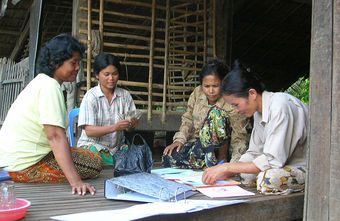
Community-based Savings Bank in Cambodia
This is a photograph of a community-based savings bank in Cambodia. There is a rich variety of financial institutions which serve micro-entrepreneurs and small businesses.
16.2.7: The Changing Face of the Workplace
Industry has become more information driven and less labor intensive, leading to a polarization between high- and low-skilled jobs.
Learning Objective
Examine the impact of the Information Age on the workforce, from automation to polarization
Key Points
- The Information Age has impacted the workforce in several ways. This poses problems for workers in industrial societies, which are still to be solved.
- Jobs traditionally associated with the middle class are beginning to disappear, either through outsourcing or automation.
- Individuals who lose their jobs due to automation or outsourcing must either move up, joining a group of “mind workers,” or settle for low-skill, low-wage service jobs.
- Another way the Information Age has impacted the workforce is that automation and computerization have resulted in higher productivity but that is coupled with net job loss.
- Industry is becoming more information-intensive and less labor and capital-intensive. This trend has important implications for the workforce; workers are becoming increasingly productive as the value of their labor decreases.
Key Terms
- Information Age
-
The current era, characterized by the increasing importance and availability of information (especially by means of computers), as opposed to previous eras (such as the Industrial Age) in which most endeavors related to some physical, man-made process or product.
- mind workers
-
A term for Information Age workers such as engineers, attorneys, scientists, professors, executives, journalists, and consultants.
- automation
-
The act or process of converting the controlling of a machine or device to a more automatic system, such as computer or electronic controls.
The Information Age has impacted the workforce in several ways. First, it has created a situation in which workers who perform easily automated tasks are being forced to find work that is less automated. Secondly, workers are being forced to compete in a global job market. Thirdly, workers are being replaced by computers that can do the job more effectively and faster. This poses problems for workers in industrial societies which are still to be solved. Solutions that involve having the workers work less hours are usually met with high resistance from the workers.
Jobs traditionally associated with the middle class (assembly line workers, data processors, foremen, and supervisors) are beginning to disappear, either through outsourcing or automation. Individuals who lose their jobs must either move up— joining a group of “mind workers” (engineers, attorneys, scientists, professors, executives, journalists, consultants)— or settle for low-skill, low-wage service jobs. The “mind workers” form about 20 percent of the workforce. They are able to compete successfully in the world market and command higher wages. Conversely, production workers and service workers in industrialized nations are unable to compete with workers in developing countries. They either lose their jobs through outsourcing or are forced to accept wage cuts.
There is another way in which the Information Age has impacted the workforce: automation and computerization have resulted in higher productivity . In the United States for example, from Jan 1972 to August 2010, the number of people employed in manufacturing jobs fell from 17,500,000 to 11,500,000 but manufacturing value rose 270 percent. It initially appeared that job loss in the industrial sector might be partially offset by the rapid growth of jobs in the IT sector. However, after the recession of March 2001, the number of jobs in the IT sector dropped sharply and continued to drop until 2003. Even the IT sector is not immune to this problem.

Automation
As industry has become increasingly automated, it has become more cost-effective for companies to use robot labor rather than manpower. Thus, many people lose their jobs to robots.
Industry is becoming more information-intensive and less labor and capital-intensive. This trend has important implications for the workforce; workers are becoming increasingly productive as the value of their labor decreases. However, there are also important implications for capitalism itself. Not only is the value of labor decreased, the value of capital is also diminished. In the classical model, investments in human capital and financial capital are important predictors of the performance of a new venture.
The polarization of jobs into relatively high-skill, high wage jobs and low-skill, low-wage jobs has led to a growing disparity between incomes of the rich and poor. The United States seems to have been more impacted than most countries with income inequality beginning to rise in the late 1970s, and the rate of disparity continuing to rise sharply in the twenty-first century.
16.2.8: Deindustrialization
Deindustrialization occurs when a country or region loses industrial capacity due to relocation or increased efficiency.
Learning Objective
Analyze the impact of deindustrialization on both a global and regional scale, as well as the role technology plays in deindustrialization
Key Points
- The term “deindustrialization crisis” has been used to describe the decline of manufacturing in a number of countries and the flight of jobs away from cities.
- Detroit and the American automobile industry are regarded as the prototypical examples of how deindustrialization can negatively impact an area and population. They are by no means the only examples of this phenomenon.
- In the U.S., the population of the great manufacturing cities of the Midwest and Northeast has declined significantly due to deindustrialization. Manufacturing jobs have been eliminated or relocated to the Southeast and Southwest, where labor is cheaper.
- Due to increasing efficiency and productivity, manufacturing today makes up a smaller share of the U.S. workforce than it has at any time in the past hundred years.
- The population of the great manufacturing cities of the northeast has declined significantly: Detroit, Cleveland, Pittsburgh, St. Louis, and Buffalo, NY, have all lost half their population or more in the past half-century.
- The widespread perception of deindustrialization in the United States is due to shifting patterns in the geography and political geography of production: from the heavily unionized Northeast and Midwest towards the right-to-work states of the Southeast and the high supply of workers willing to accept low wages in the Southwest.
Key Terms
- deindustrialization
-
The loss or deprivation of industrial capacity or strength.
- right-to-work states
-
Right-to-work states have passed laws that prohibit union security agreements, or agreements between labor unions and employers that govern the extent to which an established union can require employees’ membership, payment of union dues, or fees as a condition of employment, either before or after hiring. Right-to-work laws exist in twenty-three U.S. states, mostly in the southern and western United States.
- Detroit
-
the largest city and former capital of Michigan, a major port on the Detroit River, known as the traditional automotive center of the U.S.
Example
- Before the 1980s, Detroit was a center of industrial production and a hot spot of American culture. Residents enjoyed a high standard of living and the city boasted a healthy rate of population growth. But after free-trade agreements were instituted with less developed nations in the 1980s and 1990s, Detroit-based manufacturers relocated their production facilities to countries where wages were lower. At the same time, technological innovation continued to increase the efficiency of manufacturing, which required less and less manual labor. As manufacturing jobs were eliminated, people moved away from the city, and those who stayed behind found themselves with lower paying, harder to find work. Today, Detroit is associated with a high concentration of poverty, unemployment, and noticeable racial isolation.
Deindustrialization
Deindustrialization occurs when a country or region loses industrial capacity, especially heavy industry or manufacturing industry. This process is often attributed to off-shoring, which is itself a consequence of increased global free trade. Deindustrialization is, in a sense, the opposite of industrialization, and, like industrialization, deindustrialization may have far-reaching economic and social consequences. The term “deindustrialization crisis” has been used to describe the decline of manufacturing in a number of countries, including the U.S., which have lost large numbers of urban manufacturing jobs since the 1970s.
American Deindustrialization
The city of Detroit, and the U.S. automobile industry, are regarded as the prototypical examples of deindustrialization’s negative effects, but Detroit is not an isolated example. The population of the United States has nearly doubled since the 1950s, adding approximately 150 million people. However, during this same period (1950–2007), the population of the great American manufacturing cities declined significantly. Detroit, Cleveland, Pittsburgh, St. Louis, and Buffalo have all lost half their population or more in the past half-century. Baltimore lost almost a third of its population, and Philadelphia lost nearly a quarter of its own.
Regional Deindustrialization
In the United States, the deindustrialization of Midwestern and Northeastern cities has occurred in response to shifting patterns in the geography of production. Just as many American companies have moved their manufacturing operations to developing nations, where they can hire workers for far lower wages, so too have manufacturers in the United States relocated from the heavily unionized Northeast and Midwest toward the Southeast and Southwest. In these areas, right-to-work states limit the power of unions to raise wages. Additionally, the high supply of workers forces those workers who are employed to accept low wages.
The Impact of Technology
In order to save costs, manufacturers have done more than merely relocate. They have also eliminated jobs, as technological innovation has reduced the demand for manual labor. Though total industrial employment has been relatively stable over the past forty years, the overall U.S. labor force has increased dramatically, resulting in a massive reduction in the percent of the labor force that is engaged in industry. While 35% of workers were involved in industry in the late 1960s, under 20% are today. Manufacturing is thus less prominent in American life and the American economy now than it has been at any other point for hundreds of years.
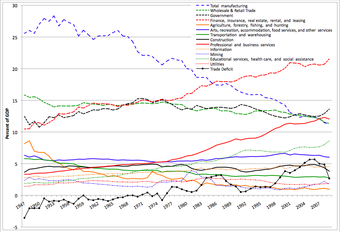
The Decline of the Manufacturing Industry
This graphic shows the decline of the manufacturing industry relative to other industries over the course of the past sixty years.
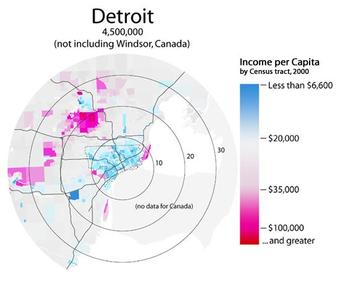
Detroit
This map depicts the economic ramifications of deindustrialization in the Detroit area. The Detroit neighborhoods closest to the city center who were the most dependent upon manufacturing jobs are the most blighted.
16.2.9: Corporations and Corporate Power
Corporations have powerful legal rights, and some have revenues that exceed the revenues of sovereign nations.
Learning Objective
Analyze the structure and function of corporations within society
Key Points
- Despite being unlike natural persons, corporations are recognized by the law to have rights and responsibilities like natural persons. For example, corporations can exercise or be responsible for human rights. They can even be convicted of criminal offenses, such as fraud and manslaughter.
- Multinational corporations are important factors in the processes of globalization. A Transnational Corporation (TNC) differs from a traditional MNC in that it does not identify itself with one national home.
- The rapid rise of multinational corporations has been a topic of concern among intellectuals, activists, and the public who perceive them as threatening basic civil rights like privacy.
- Methods for attracting foreign investment have be criticized as a race to the bottom. They have also been described as a push, by corporations, for greater autonomy.
- Because of their size, multinationals can have a significant impact on government policy, primarily through the threat of market withdrawal.
Key Terms
- corporation
-
A group of individuals, created by law or under authority of law, having a continuous existence independent of the existences of its members, and powers and liabilities distinct from those of its members.
- globalization
-
A common term for processes of international integration arising from increasing human connectivity and interchange of worldviews, products, ideas, and other cultural phenomena. In particular, advances in transportation and telecommunications infrastructure, including the rise of the Internet, represent major driving factors in globalization and precipitate the further interdependence of economic and cultural activities.
- Multinational corporations
-
A multinational corporation (MNC) is a corporate enterprise that manages production or delivers services in more than one country.
Example
- Coca-Cola is an example of a multinational corporation, with interests and markets all around the world.
Corporations
The word corporation is widely used to describe incorporated entities, especially those that have a large number of shareholders. Despite not being natural persons, the law recognizes corporations as having rights and responsibilities like natural persons. Corporations can exercise human rights against real individuals and the state, they can be responsible for human rights violations, and they can even be convicted of criminal offenses, such as fraud and manslaughter. Once incorporated, a corporation has artificial personhood everywhere it operates, until the corporation is dissolved. Often, a corporation is legally a citizen of the state (or other jurisdiction) in which it is incorporated.
Multinational and Transnational Corporations
A multinational corporation (MNC) is a corporation that either manages production or delivers services in more than one country . Some multinational corporations are very large, with revenues that exceed some nation’s national revenues. Multinational corporations can have a powerful influence on both local economies and the world economy. They play an important role in international relations and globalization. A transnational corporation (TNC) differs from a traditional MNC in that it does not identify itself with a single national home. While traditional MNCs are national companies with foreign subsidiaries, TNCs spread out their operations in many countries. This allows them to sustain high levels of local responsiveness.
The rapid rise of multinational corporations has been a topic of concern among intellectuals, activists and laymen, who perceive it as a threat to basic civil rights like privacy. Scholars have pointed out that multinationals have had a long history of interference in the policies of sovereign nation states. Anti-corporate advocates express the commonly held view that corporations answer only to shareholders, and give little consideration to human rights, environmental concerns, or other cultural issues.
Corporations and Governments
Multinational corporations are important factors in the processes of globalization . National and local governments often compete against one another to attract MNC facilities, with the expectation of increased tax revenue, employment, and economic activity. To compete, political entities may offer MNCs incentives such as tax breaks, governmental assistance, subsidies, or lax environmental and labor regulations. Because of their size, multinationals can have a significant impact on government policy, primarily through the threat of market withdrawal. Confrontations between corporations and governments have occurred when governments have tried to force MNCs to make their intellectual property public. This is a state effort to transfer technology to local entrepreneurs.
16.2.10: Ominous Trends in the U.S.
Recently, industry has become more information-intensive, which has led to higher productivity but also higher unemployment and inequality.
Learning Objective
Examine how the Information Age is leading to higher productivity but fewer jobs, which lead to polarization between incomes of the rich and poor
Key Points
- Industry is becoming more information-intensive, less labor-intensive, and less capital-intensive. Jobs traditionally associated with the middle class are beginning to disappear, either through outsourcing or automation.
- Automation and computerization have resulted in higher productivity, but they have also led to higher unemployment and a net job loss.
- Individuals who lose their jobs can respond in several ways. They can either specialize, and join a group of “mind workers,” or settle for low-skill, low-wage service jobs. The resulting polarization has led to a growing disparity between incomes of the rich and poor.
- Jobs traditionally associated with the middle class are beginning to disappear, either through outsourcing or automation.
- Individuals who lose their jobs must either move up, joining a group of “mind workers,” or settle for low-skill, low-wage service jobs.
- There is another way in which the Information Age has impacted the workforce: automation and computerization have resulted in higher productivity coupled with net job loss.
Key Terms
- mind workers
-
A term for Information Age workers such as engineers, attorneys, scientists, professors, executives, journalists, and consultants.
- automation
-
The act or process of converting the controlling of a machine or device to a more automatic system, such as computer or electronic controls.
- Information Age
-
The current era, characterized by the increasing importance and availability of information (especially by means of computers), as opposed to previous eras (such as the Industrial Age) in which most endeavors related to some physical, man-made process or product.
Example
- As technology increases productivity, it tends to reduce the demand for labor, eliminating jobs and creating unemployment. This general tendency can be observed in many sectors of the economy, but one of the most stark examples is agriculture. In the 18th and 19th centuries, most farm labor was done by hand or with the help of draft animals. But in the 20th century, technological advances revolutionized agriculture. New machinery, new varieties of crops, and new chemicals made farmers more productive than ever. A single farmer could farm much more land than before, but this meant that agriculture required far fewer laborers than it had in the past. Many farmers went out of business and moved to cities. Until 1920, more than half the U.S. population had lived in rural areas. Today, less than 2% of the population is employed in farming.
Industry in the Information Age
In general, industry is becoming more information-intensive, less labor-intensive, and less capital-intensive. These trends have led observers to call the modern era the information age. The trend toward an information-based economy has important implications for the workforce. While productivity stands to increase dramatically, unemployment is also rising, and jobs are increasingly polarized into the following two categories: high-skill, high-wage jobs, and low-skill, low-wage jobs. Additionally, for the first time, workers are being forced to compete in a global job market, in which jobs tend to be attracted by countries with lower wages.
The Disappearance of Manufacturing Jobs
As technology advances, workers are becoming increasingly productive, but the value of labor, and the demand for labor, are both decreasing. Workers who perform easily automated tasks are being replaced by technology that can do the work faster, cheaper, and more efficiently. As a result, automation and computerization have led to both higher productivity and a net job loss. In the United States, from January, 1972 to August, 2010, the number of people employed in manufacturing jobs fell from 17,500,000 to 11,500,000. During the same time period, the value of production from manufacturing increased 270%.
In general, jobs that are traditionally associated with the middle class (assembly line workers, data processors, foremen, and supervisors) are beginning to disappear due to automation. They are also disappearing because of outsourcing, which has become more common in an era of global free trade. Production and service workers in industrialized nations are unable to compete with workers in developing countries, who are willing to tolerate much lower wages. As a result, in industrialized nations like the U.S., those working in production have either lost their jobs or been forced to accept wage cuts.
“Mind Workers”
Individuals who lose their jobs can respond in several ways. They can either settle for low-skill, low-wage jobs, or they can move up, joining a group called “mind workers. ” This category includes engineers, attorneys, scientists, professors, executives, journalists, and consultants. Currently, these “mind workers” form about 20% of the workforce. They are able to compete successfully in the world market and command high wages. Increasingly, jobs in countries like the United States are polarized into low-skill, low-wage jobs or the high-skill, high-wage jobs of these “mind workers. ” Because of this polarization, there is a growing disparity between the incomes of the rich and poor. In the United States, income inequality began to rise in the 1970s and has increased even more quickly during the 21st century.
16.2.11: Colonialism, Decolonization, and Neo-Colonialism
After WWII, decolonization ended formal colonialism, but economic inequality has given rise to neocolonialism.
Learning Objective
Explain the concepts of colonialism, decolonization and neocolonialism in terms of society and economic impact
Key Points
- Colonization was motivated by economics. European powers sought to expand their markets and acquire raw materials overseas.
- Decolonization occurred in response to independence movements in colonized territories when European powers determined that the benefits of maintaining colonies was not worth the costs.
- Neocolonialism is the practice of using capitalism, globalization, and cultural forces to control a country in lieu of direct military or political control.
- Neocolonialism is motivated by economics. Countries and corporations seek to achieve favorable economic policies overseas and do so by pinning loans to particular actions on the part of African states.
- The dependency principle refers to the claim that post-colonial states have no choice but to accept Western conditions for loans, because they desperately need the money to support their own domestic policies.
Key Terms
- metropole
-
The parent-state of a colony.
- colony
-
A territory under the immediate political control of a ruling state.
- dependency principle
-
The notion that resources flow from a “periphery” of poor and underdeveloped states to a “core” of wealthy states, enriching the latter at the expense of the former. It is a central contention of the dependency theory that poor states are impoverished and rich ones are enriched by the way poor states are integrated into the “world system. “
Example
- Many accuse the World Trade Organization and the International Monetary Fund of being agents of neocolonialism. Both organizations extend loans to African countries, but do so only if the sovereign African nation-state accepts certain conditions which usually advance democratic and capitalist norms. That most African nations accept the offers and their conditions is an example of the dependency principle.
When speaking of colonialism, most people imagine the European colonization of Africa. Historically, the period of colonization tends to refer to the era from the sixteenth century until the mid-twentieth century, during which ships from Europe were actively seeking out new territories, new peoples, and new markets to acquire. However, colonialism has been practiced throughout history and all over the world. In general, colonialism occurs when people from one territory establish or acquire, maintain, and expand colonies in another territory. In colonialism, the metropole or colonizing power claims sovereignty over the colony.
Often, colonization is driven by a desire for economic expansion. In the sixteenth century, European colonization of Africa contributed significantly to European economic development. European colonization intensified because Europeans had just developed galleons or ships that could navigate more easily all the way to Africa. Easier access to foreign lands encouraged European nobles and merchants to seek out new territories in an effort to acquire raw materials and develop new markets. Extracting raw materials from foreign lands provided the fuel for the Industrial Revolution, and the practice of slavery provided Europeans with a new source of labor power.
At the same time that colonialism benefited European economies, it had devastating consequences for African economies. Colonized territories were forced to depend on colonizers for trade. Local institutions and political structures were dismantled and replaced with ones imposed by colonial powers.
After World War II, colonial systems were dismantled in a process referred to as decolonization. Decolonization refers to the undoing of colonialism, or the claim of a formerly colonized people for independence and self-determination. In part, decolonization was the result of independence movements in colonized territories. In part, it was also the result of an calculated economic decision made by colonial powers. The cost of maintaining colonial empires had begun to exceed their value for the European powers.
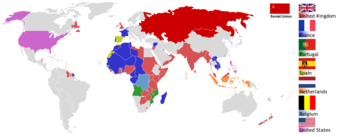
The State of Colonialism, 1945
This map shows the metropoles and their colonies in 1945.
Decolonization has had a significant impact on the economies of the newly formed states. First and foremost, newly independent African states had to develop an economic system. Moreover, even though the former colonies were now formally independent, they were still rather dependent on the West for assistance in developing economic and political structures. Thus, Western corporations still had a significant amount of control over the new states. Newly independent states borrowed money from the West in order to fund their own development, resulting in a new system of debt. For decades, this debt has been politically impossible for many countries to pay off and still exists.
Although decolonization ended formal colonialism, unequal economic relationships between the developed West and newly independent states had set up a system referred to as neocolonialism. Neocolonialism is the practice of using capitalism, globalization, and cultural forces to control a country in lieu of direct military or political control. External forces exert power in Africa in two ways. First, multinational corporations (MNCs), or companies with operations in multiple countries, apply pressure for certain political behaviors to suit their own interests. For example, if an American company wants to farm in Ethiopia, the company can apply pressure on the Ethiopian government to grant them certain conditions in exchange for the investment in the land. This function operates because of the dependency principle. In other words, many African countries are so desperate to bring in revenue to support their domestic agendas that it is in their interests to accept unsavory conditions from foreign companies. In this way, foreign companies exert significant influence over post-colonial states. The combination of the degree of the influence and the dependency principle creates a situation that in many ways mirrors colonialism. Second, foreign countries can exert influence over post-colonial states by only offering loans under certain conditions. This, again, invokes the dependency principle and mirrors colonialism.
16.2.12: Trade Blocs and Common Markets
A trade bloc is an agreement where regional barriers to trade are reduced or eliminated among the participating states.
Key Points
- Trade blocs can be stand-alone agreements between several states, such as the North American Free Trade Agreement (NAFTA) or part of a regional organization, such as the European Union.
- A single market is a type of trade bloc that is composed of a free trade area for goods, with common policies on product regulation, as well as freedom of movement on capital, labor, enterprise, and services.
- A common market is a first stage towards a single market, and may be limited initially to a free trade area with relatively free movement of capital and of services, but not so advanced in reduction of the rest of the trade barriers.
Key Terms
- North American Free Trade Agreement (NAFTA)
-
An agreement signed by the governments of Canada, Mexico, and the United States, creating a trilateral trade bloc in North America. It came into force in 1994.
- Common market
-
A common market is a first stage towards a single market, and may be limited initially to a free trade area with relatively free movement of capital and of services, but not so advanced in reduction of the rest of the trade barriers.
- trade bloc
-
A trade bloc is a type of intergovernmental agreement, often part of a regional intergovernmental organization, where regional barriers to trade, (tariffs and non-tariff barriers) are reduced or eliminated among the participating states.
Example
- The North American Free Trade Agreement (NAFTA) is an example of a formal trade bloc. Canada, the United States, and Mexico grant each other special privileges by not imposing tariffs. Accordingly, the common market of which Canada, the United States, and Mexico are all members facilitates trade among the countries.
A trade bloc is a type of intergovernmental agreement, often part of a regional intergovernmental organization, where regional barriers to trade are reduced or eliminated among the participating states. Trade blocs can be stand-alone agreements between several states, such as the North American Free Trade Agreement (NAFTA) or part of a regional organization, such as the European Union.
A single market is a type of trade bloc that is composed of a free trade area for goods, with common policies on product regulation, as well as freedom of movement on capital, labor, enterprise, and services. According to the principles of capitalism, a single market has many benefits. With full freedom of movement for all the factors of production between the member countries, the factors of production become more efficiently allocated, further increasing productivity. However, entering a trade bloc also strengthens ties between member parties. In so doing, member parties not only share each others’ strengths but also each others’ weaknesses.
Economist Jeffrey J. Scott argues that for a trade bloc to be successful, members must share four common traits: similar levels of per capita national income, geographic proximity, similar or compatible trading regimes, and a political commitment to regional organization. For better or for worse, trade blocs are prevalent. Since 1997, more than 50% of all world commerce was conducted under the auspices of regional trade blocs, such as NAFTA.
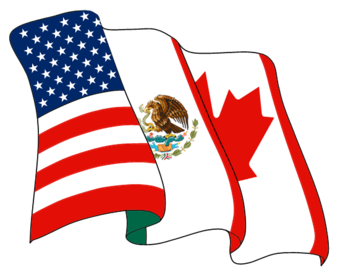
NAFTA
NAFTA is an agreement between the US, Mexico and Canada, as represented by the 3 flags in its logo.
A common market is a first stage towards a single market, and may be limited initially to a free trade area with relatively free movement of capital and of services, but not so advanced in reduction of the rest of the trade barriers.
16.3: Work
16.3.1: The Importance of Paid and Unpaid Work
Although we usually think of work as paid, unpaid work is equally important to the economy.
Learning Objective
Analyze the differences, importance and implications of both paid and unpaid work
Key Points
- An hourly worker is an employee paid an hourly wage for their services, as opposed to a fixed salary. A salary is a form of periodic payment from an employer to an employee, which may be specified in an employment contract.
- Unpaid workers work without pay.
- An internship is a system of on-the-job training for white-collar and professional careers. Although interns are typically college or university students, they can also be high school students or post-graduate adults.
- Unpaid work includes work done by family members to maintain a household. This work is usually done by women, and includes tasks such as cooking, cleaning, and rearing children.
- An internship is a system of on-the-job training for white-collar and professional careers. Although interns are typically college or university students, they can also be high school students or post-graduate adults.
Key Terms
- alienation
-
Emotional isolation or dissociation.
- specialization
-
applying to some specialty or limited object; assigning to a specific use; as, specialized knowledge
- Division of labor
-
A division of labour is the dividing and specializing of cooperative labour into specifically circumscribed tasks and roles.
Examples
- Examples of unpaid workers include members of a family or cooperative; conscripts or forced labor; volunteer workers who work for charity or amusement; students who take intern positions as work experience; or conventional workers who are not paid because their enterprise is short of money.
- An example of an apprenticeship is when a younger individual trains with an experienced carpenter to learn how to become a carpenter.
- An example of an internship is when a college student shadows a professional member of the career they are striving for to learn how to achieve their goals.
Most of the time when we think of work, we think of paid work. Workers may be paid in a variety of ways, most commonly hourly wages or salaries. An hourly worker is an employee paid an hourly wage for their services, as opposed to a fixed salary. Hourly workers may often be found in service and manufacturing occupations, but are common across a variety of fields. A salary is a form of periodic payment from an employer to an employee, which may be specified in an employment contract.
Many types of work, however, are unpaid. Unpaid workers work without pay. These may be members of a family or cooperative; conscripts or forced labor; volunteer workers who work for charity or amusement; students who take intern positions as work experience; or conventional workers who are not paid because their enterprise is short of money. Internships are a common type of unpaid work.
An internship is a system of on-the-job training for white-collar and professional careers. Internships for professional careers are similar to apprenticeships for trade and vocational jobs. Although interns are typically college or university students, they can also be high school students or post-graduate adults. Generally, the internship is an exchange of services for experience between the student and his or her employer. Students exchange their cheap or free labor to gain experience in a particular field . They can also use an internship to determine if they have an interest in a particular career, create a network of contacts, or gain school credit. Some interns also find permanent, paid employment with the companies in which they interned. Thus, employers also benefit, as experienced interns need little or no training when they begin full-time, regular employment.
Another important type of unpaid work is work done by family members to maintain a household. Unpaid domestic work has traditionally been done by women (e.g., wives and mothers). Their work may include cooking, cleaning, rearing children, or managing household expenses. As more women enter the paid workforce, many find themselves returning home after a day of paid work to continue working a “second shift” of unpaid domestic work. Though unpaid, this domestic work is crucial to the economy: it keeps workers alive and healthy and helps raise new generations of workers to keep the paid economy running.
16.3.2: Importance of Division of Labor
Division of labor is the specialization of cooperative labor in specific, circumscribed tasks and roles.
Learning Objective
Examine how the division of labor can lead to alienation and less satisfaction in the workforce
Key Points
- A more complex division of labor is closely associated with the growth of economic output and trade, the rise of capitalism, and the complexity of industrialization processes.
- In a division of labor, the production process is broken down into a sequence of stages, and workers are assigned to particular stages.
- Increasing the specialization of work might lead to workers with low overall skills and a lack of enthusiasm for their work.
- Karl Marx described the process of alienation as follows. In his view, workers would become more and more specialized, and work would become more and more repetitive, until eventually the workers would be completely alienated from the process of production.
- Labor hierarchy is a very common feature of the modern workplace structure.
Key Terms
- alienation
-
Emotional isolation or dissociation.
- specialization
-
applying to some specialty or limited object; assigning to a specific use; as, specialized knowledge
- Division of labor
-
A division of labour is the dividing and specializing of cooperative labour into specifically circumscribed tasks and roles.
Example
- An example of the division of labor in the workplace is how workers at a candy factory have very particular tasks. One might monitor the caramel, while another monitors the chocolate, and another sees to packaging. When the worker monitoring the caramel no longer sees how his work contributes to the larger product, he is said to be alienated from his labor.
Division of Labor
In a division of labor, the production process is broken down into a sequence of stages, and workers are assigned to particular stages. Cooperative labor is specialized into specific, circumscribed tasks, which individuals in specific roles accomplish. Historically, as societies have developed more and more complex divisions of labors, the economies of those societies has grown proportionately, both in trade output and living standards. A complex division of labor appears to be strongly correlated with the rise of capitalism, as well as the rise of complex industrial production.
Marxist Alienation
While it can have benefits for productivity, the specialization of labor can lead to workers with low overall skills and low enthusiasm. This viewpoint was extended and refined by Karl Marx. He described the process of specialization as alienation. In his view, workers become more and more specialized, and their work becomes more and more repetitive, until eventually they are completely alienated from the production process. He believed people could only be liberated if they were involved in the full scope of economic production, and he considered the strict division of labor only a temporary, necessary evil.
Globalization and the Division of Labor
In the modern world, those who think most about the division of labor are involved in the fields of management and organization. Now that labor has been specialized not just nationally but globally, people often wonder what type of division of labor would be the most beautiful, fair, ideal, and efficient. It is widely accepted that the division of labor is to a great extent inevitable, simply because no one person can do every task at once. Labor hierarchy is a very common feature of the modern workplace structure, but of course, the way these hierarchies are structured can be influenced by a variety of factors.
The issue reaches its broadest scope in conversations about globalization, which is often euphemistically defined as the expansion of world trade based on comparative advantage. Theoretically, in an era of globalization, countries specialize in the work they can do at the lowest opportunity cost. Critics however allege that international specialization cannot be explained sufficiently in terms of “the work nations do best. ” Instead, critics think this specialization is guided more by commercial criteria, which favor some countries over others.

Division of Labor
A highly specialized division of labor is often used in factories, such as this Chinese silk factory.
16.3.3: Industrial Work
Industrial labor is labor in industry, usually manufacturing, but it may also include service work, such as cleaning or cooking.
Learning Objective
Discuss the impact of the Industrial Revolution on workers and the shift from small scale to large scale workforces
Key Points
- Before the Industrial Revolution, most production took place in homes or in small workshops. After the Industrial Revolution, production increasingly took place in factories, giving rise to industrial labor.
- A blue-collar worker is a member of the working class who performs manual labor.
- Karl Marx used the term proletariat to describe the industrial working class.
- A blue-collar worker is a member of the working class who performs manual labor.
- Karl Marx used the term proletariat to describe the industrial working class.
Key Terms
- proletariat
-
the working class or lower class
- blue-collar worker
-
A blue-collar worker is a member of the working class who performs manual labor.
- Industrial labor
-
Industrial labor is labor in industry, mostly understood as manufacturing, but can include related service workers, such as cleaners and cooks.
Example
- At the turn of the century, Henry Ford’s factories began mass producing a new type of affordable car. Ford was able to make cars more affordable by producing them on a large, industrial scale. But this type of production required a new type of labor, industrial labor. Ford’s employees worked in factories, on assembly lines, doing routinized tasks over and over in order to produce cars.
In the 18th and 19th centuries, the Industrial Revolution dramatically changed labor practices. New technology made workers much more efficient and productive, but these developments were expensive. Building new industrial machines required enormous investments. To be able to afford these investments, production had to take place on a larger scale. Before the Industrial Revolution, most production took place in homes or in small workshops. After the Industrial Revolution, production increasingly took place in factories, many of which were situated together in industrial districts.
Industrial labor is defined as labor in industry. In most cases, this is understood as manufacturing, the type of labor that takes place in factories, on assembly lines, and that which involves heavy machinery. This being said, industrial labor also includes service jobs that rose up alongside, and as a result of, industrial production. Industrial labor includes factory workers, but it may also include service workers, such as cleaners and cooks.
Karl Marx referred to industrial laborers as members of the proletariat . In common parlance, these people are often referred to as blue-collar workers. Blue-collar work may be skilled or unskilled, and includes manufacturing, mining, construction, mechanics, maintenance, technical installation, and other types of physical work. Often, blue-collar workers physically build or maintain something .
The term “blue collar” refers to the type of clothing often worn by industrial workers. Industrial and manual workers often wear durable canvas or cotton clothing that may be soiled during the course of their work. Navy and light blue colors conceal potential dirt or grease on workers’ clothing, helping them appear cleaner. For the same reason, blue is a popular color for overalls. Some blue-collar workers have uniforms embroidered with either the business’ name or the individual’s name.
16.3.4: Work and Alienation
Alienation occurs when the worker can only express individuality through a production system that is not collectively, but privately owned.
Learning Objective
Analyze Marx’s theory of alienation in terms of the four types of alienation and their implications for workers
Key Points
- Marx’s theory of alienation refers to the separation of things that naturally belong together, or to putting antagonism between things that are properly in harmony.
- Marx’s theory is founded upon his observation that, within the capitalist mode of production, workers invariably lose determination of their lives and destinies by being deprived of the right to conceive of themselves as the director of their actions.
- Alienation refers to the social alienation of people from aspects of their “human nature. ” Marx believed that alienation is a systematic result of capitalism.
- Workers are alienated by the bourgeoisie, who own the means of production.
Key Terms
- capitalist mode of production
-
In Marx’s critique of political economy, the capitalist mode of production is the production system of capitalist societies, which began in Europe in the 16th century, grew rapidly in Western Europe from the end of the 18th century, and later extended to most of the world. It is characterized by: the predominance of private ownership of the means of production and exploitation of wage labor, distribution and exchange in a mainly market economy (commodity production), and capital accumulation (production for profit).
- human nature
-
The fundamental set of qualities, and the range of behavior, shared by all humans.
- alienation
-
Emotional isolation or dissociation.
Examples
- An example of the alienation of the worker from the work he produces is the worker who attaches tires onto a car in an auto manufacturing plant. Although the worker has created a part of the car, he is alienated from his labor by the fact that the auto company will sell the car and reap the profits, rather than allow him to keep some of the profits for himself.
- An example of the alienation of the worker from working is the same worker in the auto manufacturing plant who derives very little satisfaction from the monotonous act of attaching tires on to a car.
- An example of the alienation of the worker from himself as a producer is that the autoworker is directed how to perform his job, rather than allowed to enact his own desires of what to produce.
- An example of the alienation of the worker from the other workers is that the auto manufacturing company for which he works only cares about selling the cars he helps to produce, rather than fostering social relationships on the floor. This could be seen by a manager telling employees to stop talking and to focus on their work.
The theory of alienation, as expressed in the writings of Karl Marx, refers to the separation of things that naturally belong together, or to put antagonism between things that are properly in harmony. In the concept’s most important use, it refers to the social alienation of people from aspects of their “human nature. ” Marx believed that alienation is a systematic result of capitalism.
Marx’s theory of alienation is founded upon his observation that, within the capitalist mode of production, workers invariably lose determination of their lives and destinies by being deprived of the right to conceive of themselves as the director of their actions, to determine the character of their actions, to define their relationship to other actors, and to use or own the value of what is produced by their actions . Workers become autonomous, self-realized human beings, but are directed and diverted into goals and activities dictated by the bourgeoisie, who own the means of production in order to extract from workers the maximal amount of surplus value possible within the current state of competition between industrialists. By working, each contributes to the common wealth. Alienation in capitalist societies occurs because the worker can only express this fundamentally social aspect of individuality through a production system that is not collectively owned, but privately owned.
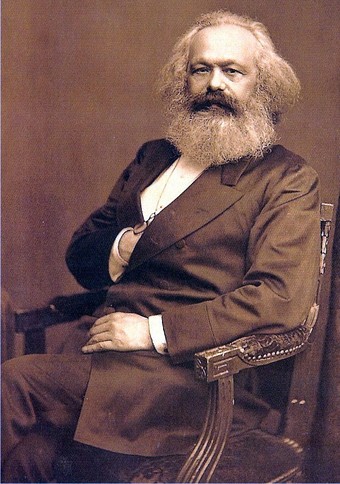
Karl Marx
Conflict theory derives from the ideas of Karl Marx.
In the “Economic and Philosophical Manuscripts of 1844,” Marx identifies four types of alienation in labor under capitalism. The first is the alienation of the worker from the work he produced, or from the product of his labor. The product’s design and the manner in which it is produced are determined not by its actual producers, nor even by those who consume products, but rather by the capitalist class. This capitalist class appropriates labor, including that of designers and engineers, and seeks to shape the tastes of consumers in order to maximize profit.
The second is the alienation of the worker from working, or from the act of producing itself. This kind of alienation refers to the patterning of work in the capitalist mode of production into an endless sequence of discrete, repetitive, trivial, and meaningless motions, offering little, if any, intrinsic satisfaction.
The third is the alienation of the worker from himself as a producer, or from his or her “species being” or “essence as a species. ” To Marx, this human essence was not separate from activity or work, nor static, but includes the innate potential to develop as a human organism. Species being is a concept that Marx deploys to refer to what he sees as the original or intrinsic essence of the species, which is characterized both by plurality and dynamism: all beings possess the tendency and desire to engage in multiple activities to promote their mutual survival, comfort, and sense of interconnection.
The fourth is the alienation of the worker from other workers, in which the capitalist system reduces the act of work to a simple economic practice, rather than recognizing the social elements of the act of production. A capitalist system sees the labor of the worker to a commercial commodity that can be traded in the competitive labor-market. It does not view labor as a constructive socioeconomic activity that is part of the collective common effort performed for personal survival and the betterment of society. When the bourgeoisie interferes with or impedes any of these natural tendencies, the worker is alienated.
16.3.5: Industrial Conflict
Industrial sociology examines the effects of industrial organization on workers, and the conflicts that can result.
Learning Objective
Summarize the main points of industrial sociology and Labor Process Theory, including the development of labor unions and types of unionism
Key Points
- Industrial sociology examines the effects of labor markets, work organization and management on societal inequality and “the ways in which workers challenge, resist, and make their own contributions to the patterning of work and shaping of work institutions”.
- In his Labor Process Theory, Sociologist Harry Braverman argued that capitalist managers were incessantly driven to deskill the labor force to lower production costs and ensure higher productivity.
- A labor union is an organization of workers who have banded together to achieve common goals such as higher pay, increasing the number of employees an employer hires, and better working conditions.
- Social unionism encompasses many unions that use their organizational strength to advocate for social policies and legislation favorable to their members or to workers in general.
Key Terms
- deskill
-
To redesign (a job) so that less skill is required to carry it out, for example through the introduction of new technology.
- Marxist
-
Following the ideals of Karl Marx, including that of egalitarian communism.
- labor union
-
A continuous association of wage-earners for the purpose of maintaining or improving the conditions of their employment; a trade union.
Example
- An example of a labor union is the American Federation of Labor and Congress of Industrial Organization (AFL-CIO), whose constituent unions represent most American workers. An example of a craft union was the American Federation of Labor before it merged with the Congress of Industrial Organization. In the old model of the AFL,all carpenters belong to the carpenters’ union, the plasterers join the plasterers’ union, and the painters belong to the painters’ union. Each craft union has its own administration, its own policies, its own collective bargaining agreements, and its own union halls.
Industrial sociology examines the effects of labor markets, work organization, employment relations, managerial approaches, and other factors of inequality in society, and “the ways in which workers challenge, resist, and make their own contributions to the patterning of work and shaping of work institutions” (Watson, 2008).
One branch of industrial sociology is labor process theory (LPT). In 1974, Harry Braverman wrote Labor and Monopoly Capital: The Degradation of Work in the Twentieth Century, which provided a critical analysis of scientific management. This book analyzed capitalist productive relations from a Marxist perspective. Following Marx, Braverman argued that work within capitalist organizations was exploitative and alienating, and therefore workers had to be coerced into servitude. For Braverman, the pursuit of capitalist interests over time ultimately leads to the deskilling and routinization of the worker.
Braverman demonstrated several mechanisms of control in both the factory blue collar and clerical white collar labor force. His key contribution is his “deskilling” thesis. Braverman argued that capitalist owners and managers were incessantly driven to deskill the labor force to lower production costs and ensure higher productivity. Deskilled labor is cheap and above all easy to control due to the workers lack of direct engagement in the production process. In turn, work becomes intellectually or emotionally unfulfilling. The lack of capitalist reliance on human skill reduces the need of employers to reward workers in anything but a minimal economic way.
Unions
A labor or trade union is an organization of workers that have banded together to achieve common goals such as higher pay, increasing the number employees an employer hires, and better working conditions. Originating in Europe, trade unions became popular in many countries during the Industrial Revolution, when the lack of skill necessary to perform most jobs shifted employment bargaining power almost completely to the employers’ side, causing many workers to be mistreated and underpaid. Trade union organizations may be composed of individual workers, professionals, past workers, students, apprentices and/or the unemployed .
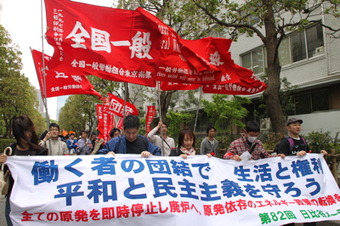
Trade Union in Japan
The Nambu University Teachers Union members picket on May Day 2011.
Industrial unionism is a labor union organizing method through which all workers in the same industry are organized into the same union—regardless of skill or trade—thus giving workers in one industry, or in all industries, more leverage in bargaining and in strike situations. Advocates of industrial unionism value its contributions to building unity and solidarity, suggesting the slogans, “an injury to one is an injury to all” and “the longer the picket line, the shorter the strike. “
In contrast, craft unionism organizes workers along lines of their specific trades (i.e., workers using the same kind of tools, or doing the same kind of work with approximately the same level of skill), even if this leads to multiple union locals with different contracts in the same workplace.
In addition to advocating for worker rights, unions may also engage in broader political or social struggle. Social unionism encompasses many unions that use their organizational strength to advocate for social policies and legislation favorable to their members or to workers in general. In some countries, unions are closely aligned with political parties.
16.3.6: Labor Unions
Labor unions provide members with the power of collective bargaining over and fight for workers rights.
Learning Objective
Outline the development and purpose of labor unions for workers in society
Key Points
- Labor unions are legally recognized as representatives of workers in many industries in the United States.
- Their activity today centers on collective bargaining over wages, benefits, and working conditions for their membership, and on representing their members in disputes with management over violations of contract provisions.
- Most unions in America are aligned with one of two larger umbrella organizations: the AFL-CIO and the Change to Win Federation.
- Union membership has been declining in the U.S. since 1954.
- To fight employer anti-union programs, unions are currently advocating new “card check” federal legislation that would require employers to bargain with a union if more than 50% of workers signed forms, or “cards,” stating they wish to be represented by that union.
Key Terms
- “card check”
-
Card check (also called majority sign-up) is a method for American employees to organize into a labor union in which a majority of employees in a bargaining unit sign authorization forms, or “cards,” stating they wish to be represented by the union.
- labor union
-
A continuous association of wage-earners for the purpose of maintaining or improving the conditions of their employment; a trade union.
- collective bargaining
-
A method of negotiation in which employees negotiate as a group with their employers, usually via a trade union
Example
- The SEIU, or service employees international union, is the fastest growing union in North America.
Labor unions are legally recognized as representatives of workers in many industries in the United States. Labor union’s activism centers on collective bargaining over wages, benefits, and working conditions for their membership, and on representing their members in disputes with management over violations of contract provisions.
Most unions in America are aligned with one of two larger umbrella organizations: the AFL-CIO created in 1955, and the Change to Win Federation, which split from the AFL-CIO in 2005. Both advocate policies and legislation on behalf of workers in the United States and Canada, and take an active role in politics. The AFL-CIO is especially concerned with global trade issues.
Union Membership
To join a traditional labor union, workers must either be given voluntary recognition from their employer or have a majority of workers in a bargaining unit vote for union representation. In either case, the government must then certify the newly formed union. Other forms of unionism include minority unionism, solidarity unionism, and the practices of organizations such as the Industrial Workers of the World, which do not always follow traditional organizational models.
Union membership had been declining in the US since 1954. In 2007, the Labor Department reported the first increase in union memberships in 25 years and the largest increase since 1979. Most of the recent gains in union membership have been in the service sector while the number of unionized employees in the manufacturing sector has declined. Although most industrialized countries have seen a drop in unionization rates, the drop in union density (the unionized proportion of the working population) has been more significant in the United States than elsewhere. Dropping unionization rates cannot be attributed entirely to changing market structures; scholars have shown the tremendous complexity inherent in explaining the decline of union density.
Although much smaller compared to their peak membership in the 1950s, American unions remain an important political factor, both through mobilization of their own memberships and through coalitions with like-minded activist organizations around issues such as immigrant rights, trade policy, health care, and living wage campaigns. To fight employer anti-union programs, unions are currently advocating new “card check” federal legislation that would require employers to bargain with a union if more than 50% of workers signed forms, or “cards,” stating they wish to be represented by that union, rather than waiting 45 to 90 days for a federally-supervised a secret ballot election during which time employers can fire, harass and generally make life miserable for pro-union employees.
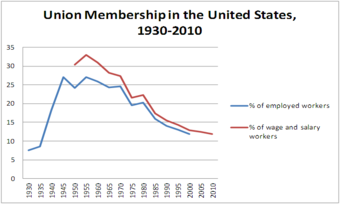
Union Membership in the United States
This diagram shows the rise and fall of union membership in the United States.
16.3.7: Work and Technology
The Information Age has impacted the workforce through automation and computerization, resulting in higher productivity and fewer jobs.
Learning Objective
Discuss the shift in the economy from mechanization to automation due to the Information Age and its impact on the modern industrial worker
Key Points
- Knowledge workers are workers whose main capital is knowledge.
- Typical examples of knowledge workers may include software engineers, architects, engineers, scientists, and lawyers, because they “think for a living”.
- In the Information Age, workers are being replaced by computers that can do the job more effectively and faster.
- Automation is the use of control systems and information technologies to reduce the need for human work in the production of goods and services.
- The service sector consists of the “soft” parts of the economy, where the production of services is valued instead of end products.
Key Terms
- service sector
-
The tertiary sector of the economy (also known as the service sector or the service industry) is one of the three economic sectors, the others being the secondary sector (approximately the same as manufacturing) and the primary sector (agriculture, fishing, and extraction such as mining).
- Information Age
-
The current era, characterized by the increasing importance and availability of information (especially by means of computers), as opposed to previous eras (such as the Industrial Age) in which most endeavors related to some physical, man-made process or product.
- knowledge worker
-
Someone who works with information or data.
Examples
- Examples of service sector jobs are jobs in the medical services sectors, teachers, lawyers, and sales representatives.
- Examples of service sector jobs are jobs in the medical services sectors, teachers, lawyers, and sales representatives.
The Information Age has impacted the workforce in several ways. It has created a situation in which workers who perform easily automated tasks are being forced to find work that is less automated. They are being forced to compete in a global job market, they are being replaced by computers that can do jobs more effectively and faster. This poses problems for workers in industrial societies.
Automation
There is another way in which the Information Age has impacted the workforce: automation and computerization have resulted in higher productivity coupled with net job loss. Automation is the use of control systems and information technologies to reduce the need for human work in the production of goods and services . In the scope of industrialization, automation is a step beyond mechanization. Whereas mechanization provides human operators with machinery to assist them with the muscular requirements of work, automation greatly decreases the need for human sensory and mental requirements as well. Automation plays an increasingly important role in the world economy and in daily experience.

Automation
Automation is one of the ways in which the modern technology has impacted the workplace.
Automation has had a notable impact in a wide range of industries beyond manufacturing. For example, telephone operators have been replaced largely by automated telephone switchboards and answering machines. Medical processes such as primary screening in electrocardiography or radiography and laboratory analysis of human genes, sera, cells, and tissues are carried out at much greater speed and accuracy by automated systems. Automated teller machines have reduced the need for bank visits to obtain cash and carry out transactions. In general, automation has been responsible for the shift in the world economy from industrial jobs to service jobs in the 20th and 21st centuries.
The service sector consists of the “soft” parts of the economy—activities where people offer their knowledge and time to improve productivity, performance, potential, and sustainability. The basic characteristic of this sector is the production of services instead of end products. Typical examples of knowledge workers may include software engineers, architects, engineers, scientists and lawyers, because they “think for a living.”
16.3.8: Economic Sociology
Economic sociology is the study of the social causes and social effects of various economic phenomena.
Learning Objective
Examine the two periods of economic sociology – classical and contemporary – and the difference between economic sociology and socioeconomics
Key Points
- Economic sociology is the study of the social causes and social effects of various economic phenomena. This is distinguishable from the field of socioeconomics, which focuses on the social impact of very specific economic changes.
- Many classical sociologists, from Émile Durkheim to Georg Simmel, include economic analyses in their texts. Max Weber’s book The Protestant Ethic and the Spirit of Capitalism is the archetypical representation of the works of economic sociology’s classical period.
- Contemporary economic sociology emphasizes the social consequences of economic exchanges, the social meanings they involve, and the social interactions that they facilitate or obstruct.
- Some economic sociologists provide a social explanation to questions traditionally addressed by economists. However, other contemporary economic sociologists have forged different research programs based on new questions and new methods.
Key Terms
- The Protestant Ethic and the Spirit of Capitalism
-
The Protestant Ethic and the Spirit of Capitalism is a book written by Max Weber, a German sociologist, economist, and politician. Begun as a series of essays, the original German text was composed in 1904 and 1905, and was translated into English for the first time by Talcott Parsons in 1930. It is considered a founding text in economic sociology and sociology in general.
- economic sociology
-
Economic sociology studies both the social effects and the social causes of various economic phenomena.
Economic sociology is the study of the social causes and social effects of various economic phenomena. This is distinguishable from the field of socioeconomics, which focuses on the social impact of very specific economic changes, such as the closing of a factory, market manipulation, or new policies that impact the economy of a very specific locale or population. The field of economic sociology can be broadly divided into a classical period and a contemporary period.
Sociology came of age in the late nineteenth century, at the same time as capitalism and modernity were taking root. The classical period was concerned particularly with modernity and its phenomenological progeny, such as rationalization, secularization, urbanization, and social stratification. Thus, many classical sociologists, from Émile Durkheim to Georg Simmel, include economic analyses in their texts. Max Weber’s book The Protestant Ethic and the Spirit of Capitalism is the archetypical representation of the works of economic sociology’s classical period . Published in 1905, Weber argues that capitalism flourished in northern Europe because of a preexisting religious ethic that encouraged dedication and hard work in the course of proving oneself worthy of salvation. The Protestant Ethic and the Spirit of Capitalism is representative of classical economic sociology in that it uses sociological data on religion to explain the economic phenomenon of northern Europe’s embrace of capitalism.
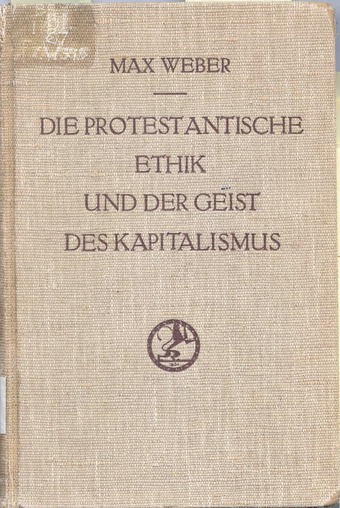
The Protestant Work Ethic and the Spirit of Capitalism
This picture shows the cover to the 1934 edition of Max Weber’s The Protestant Work Ethic and the Spirit of Capitalism.
Contemporary economic sociology emphasizes the social consequences of economic exchanges, the social meanings they involve, and the social interactions that they facilitate or obstruct. Influential figures in modern economic sociology include Fred L. Block, James S. Coleman, Mark Granovetter, Harrison White, Paul DiMaggio, Joel M. Podolny, Richard Swedberg, and Viviana Zelizer in the United States, as well as Luc Boltanski, Laurent Thévenot, or Jens Beckert in Europe, among many others. In some cases, contemporary economic sociology borrows mathematical tools and economic theories such as utility maximization and game theory. Some economic sociologists provide a social explanation to questions traditionally addressed by economists. However, other contemporary economic sociologists have forged different research programs based on new questions and new methods.
Chapter 15: Government
15.1: Politics, Power, and Authority
15.1.1: Politics
Political sociology studies the relation between state and society, authority and power, and the methods used to formulate social policy.
Learning Objective
Diagram the three major traditional theoretical frameworks of political sociology, plus trends in contemporary sociology
Key Points
- The term “politics” is generally applied to behavior within civil governments, but politics has been observed in all human group interactions. It consists of social relations involving authority or power, the regulation of political units, and the methods used to formulate and apply social policy.
- Traditionally there have been four main areas of research: the socio-political formation of the modern state; how social inequality influences politics; how social movements outside of the formal institutions affect formal politics; and power relationships within and between social groups.
- There are three major theoretical frameworks: pluralism, elite or managerial theory, and class analysis.
- Pluralism sees politics primarily as a contest among competing interest groups. It holds the view that politics and decision making are located mostly in the framework of government, but many non-governmental groups use their resources to exert influence.
- Elite or managerial theory is sometimes called a state-centered approach. It posits that a small minority—consisting of members of the economic elite and policy-planning networks—holds the most power and that this power is independent of a state’s democratic elections process.
- Social class theory analysis emphasizes the political power of capitalist elites.
Key Terms
- state
-
Any sovereign polity. A government.
- social policy
-
Guidelines, principles, legislation and activities that affect the living conditions conducive to human welfare.
- politics
-
the art or science of influencing people on a civic, or individual level, when there are more than 2 people involved
Example
- If you’ve ever joined a group or a club, you have probably witnessed politics in process. Even groups we don’t think of as political still practice politics. For example, a school sports team has its own politics. The team’s coach exercises authority over the team’s players; in turn, the coach must answer to the authorities of the school or the state athletic association concerning when and where the team can practice and compete. Usually, decisions will be made by the coach, but some coaches may also appoint team captains who have a say in decision-making. On some especially democratic teams, all players may have some say in certain decisions. This is politics.
Politics is the process by which groups of people make decisions. The term is generally applied to behavior within civil governments, but politics has been observed in all human group interactions, including corporate, academic, and religious institutions. It consists of social relations involving authority or power, the regulation of political units, and the methods and tactics used to formulate and apply social policy.
Contemporary political sociology involves the study of relations between state and society.
In the past, a typical research question in political sociology might have been: “Why do so few American citizens choose to vote? ” or “What difference does it make if women get elected? “
Modern political sociologists are now focused on questions such as: “How is the body a site of power? “, “How are emotions relevant to global poverty? “, or “What difference does knowledge make to democracy? “
Traditional Political Sociology
Traditionally there have been four main areas of research in political sociology:
- The socio-political formation of the modern state
- “Who rules? ” How social inequality between groups (class, race, gender, etc.) influences politics
- How public personalities, social movements, and trends outside of the formal institutions of political power affect formal politics
- Power relationships within and between social groups (e.g. families, workplaces, bureaucracy, media, etc.).
Political sociology was traditionally concerned with how social trends, dynamics, and structures of domination affect formal political processes. It also explored how various social forces work together to change political policies. From this perspective there are three major theoretical frameworks: pluralism, elite or managerial theory, and class analysis (which overlaps with Marxist analysis).
Pluralism
Pluralism sees politics as a contest between competing interest groups. It holds the view that politics and decision making are located mostly in the framework of government, but many non-governmental groups use their resources to exert influence. Groups of individuals try to maximize their interests. There are multiple lines of power that shift as power is a continuous bargaining process between competing groups. Any change under this view will be slow and incremental—groups have different interests and may act as “veto groups” to destroy legislation that they do not agree with.
Elite/Managerial Theory
Elite or managerial theory is sometimes called a state-centered approach. It also seeks to describe and explain power relationships in contemporary society. The theory posits that a small minority—consisting of members of the economic elite and policy-planning networks—holds the most power. This power is independent of a state’s democratic elections process. Through positions in corporations, corporate boards, and policy-planning networks, members of the “elite” are able to exert significant power over the policy decisions of corporations and governments.
Class Analysis
Social class analysis emphasizes the political power of capitalist elites. It can be split into two parts. One is the ‘power structure’ or ‘instrumentalist’ approach; the other is the ‘structuralist’ approach. The power structure approach focuses on determining who rules, while the structuralist approach emphasizes the way a capitalist economy operates, allowing and encouraging the state to do some things but not others.
Contemporary Political Sociology
Contemporary political sociology is concerned with the play of power and politics across societies, which includes, but is not restricted to relations between the state and society. In part, this is a product of the growing complexity of social relations, the impact of social movement organizing, and the relative weakening of the state via globalization. Political sociology is as much focused on micro questions (the formation of identity through social interaction; the politics of knowledge), as it is on macro questions (how to capture and use state power).
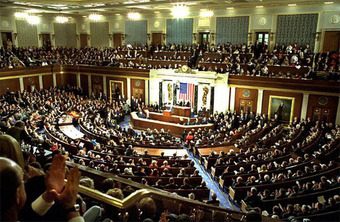
President Bush’s 2003 State of the Union Address
Politics is a decision making process, which often takes place in legislative bodies such as the U.S. Congress.
15.1.2: Power
Power is frequently defined as the ability to influence the behavior of others with or without resistance.
Learning Objective
Differentiate between power and constraint, using real life examples
Key Points
- Power can be seen as evil or unjust, but the exercise of power is accepted as endemic to humans as social beings. The use of power need not involve coercion, force or the threat of force.
- The sociological examination of power concerns itself with discovering and describing the relative strengths: equal or unequal; stable or subject to periodic change.
- Power may derive from a number of sources, including social class (material wealth can equal power), resource currency (material items such as money, property, food), personal or group charisma, or social influence of tradition (compare ascribed power).
- Researchers have documented the bystander effect: they found that powerful people are three times as likely to first offer help to a stranger in distress.
Key Terms
- power elite
-
a small group of people who control a disproportionate amount of wealth or political power
- bystander effect
-
When someone is less likely to help another if other potential helpers are present.
- unilateralism
-
A tendency of nations to act on their own, or with only minimal consultation and involvement with other nations.
- power
-
The ability to get one’s way even in the face of opposition to one’s goals.
Example
- Employer-employee relationships offer an example of power relations. Typically, the employer (or boss) has more power. That is, the balance of power tips in her favor: she can threaten to fire an employee, reduce his salary, assign undesirable tasks, and so on. By comparison, the employee has less power. Labor unions attempt to bring more balance into this relationship by forming large coalitions of employees who, by working together, can exert power of their own.
Power is frequently defined by political scientists as the ability to influence the behavior of others with or without resistance. The term authority is often used for power perceived as legitimate by the social structure. Power can be seen as evil or unjust, but the exercise of power is accepted as endemic to humans as social beings. The use of power need not involve coercion, force or the threat of force. At one extreme, power closely resembles what English speakers call “influence”, although some authors make a distinction between the two.
The sociological examination of power involves discovering and describing the relative strengths: equal or unequal; stable or subject to periodic change. Sociologists usually analyze relationships in which parties have relatively equal or nearly equal power in terms of constraint rather than of power. Thus power has a connotation of unilateralism. If this were not so, then all relationships could be described in terms of power, and its meaning would be lost.
Power may derive from a number of sources, including social class (material wealth can equal power), resource currency (material items such as money, property, food), personal or group charisma, ascribed power (acting on perceived or assumed abilities, whether these bear testing or not), social influence of tradition (compare ascribed power), etc.
People use more than rewards, threats and information to influence others. In everyday situations, people use a variety of power tactics to push or prompt others into particular action. There are many examples of power tactics that are quite common and employed everyday. Some of these tactics include bullying, collaboration, complaining, criticizing, demanding, disengaging, evading, humor, inspiring, manipulating, negotiating, socializing and supplicating. Recent experimental psychology suggests that the more power one has the less one takes on the perspective of others, implying that the powerful have less empathy.
Powerful people are also more likely to take action. In one example, more powerful people turned off an irritatingly close fan twice as much as less powerful people. Researchers have documented the “bystander effect” and found that powerful people are three times as likely to first offer help to a stranger in distress.

A rally of the trade union UNISON in Oxford during a strike
Labor unions attempt to bring more balance into the relationship between employers and employees by forming large coalitions of employees who, by working together, can exert power of their own.
15.1.3: Authority
Authority refers to the use of power that is seen as legitimate or socially approved/recognized.
Learning Objective
Give examples of the three types of authority as defined by Max Weber and what distinguishes all of them from coercion or force
Key Points
- Power can be exerted by the use of force or violence. Authority, by contrast, depends on subordinate groups consenting to the use of power wielded by superior groups.
- Weber defined domination (authority) as the chance of commands being obeyed by a specifiable group of people. Legitimate authority is that which is recognized as legitimate and justified by both the ruler and the ruled.
- Weber states that legitimacy distinguishes authority, from coercion, force, power, leadership, persuasion and influence. Superiors, he states, feel that they have a right to issue commands; subordinates perceive an obligation to obey.
- Authoritarianism primarily differs from totalitarianism in that social and economic institutions exist that are not under governmental control.
- The three attributes of authority are status, specialist skills, and social position.
Key Terms
- authority
-
The power to enforce rules or give orders.
- power
-
The ability to get one’s way even in the face of opposition to one’s goals.
Examples
- Authority only lasts so long as people recognize the legitimacy of power. But when people begin to question the legitimacy of that power, it loses authority. For example, when American colonists began to question the legitimacy of Britain’s rule over the colony, Britain lost its authority. Without authority, Britain’s power had to be backed by force.
- In democratic countries, people recognize the legitimacy of power obtained through free and fair elections. After an election, the winning party takes office without a struggle or show of military force because everyone recognizes the legitimacy of its newly won authority.
Authority is the legitimate or socially approved use of power that a person or a group holds over another. Legitimacy is vital to the notion of authority; legitimacy is the main means by which authority is distinguished from more general notions of power. Power can be exerted by the use of force or violence. Authority, by contrast, depends on subordinate groups consenting to the use of power wielded by superior groups.
Max Weber, in his sociological and philosophical work, identified and distinguished three types of legitimate domination (Herrschaft in German, which generally means ‘domination’ or ‘rule’). These have sometimes been translated to English as types of authority, because domination is not seen as a political concept. Weber defined domination (authority) as the chance of commands being obeyed by a specifiable group of people. Legitimate authority is that which is recognized as legitimate and justified by both the ruler and the ruled.
The first type discussed by Weber is rational-legal authority. It is a form of authority with legitimacy that depends on formal rules and established laws of the state, which are usually written down and are often very complex.
The second type of authority is traditional authority, which derives from long-established customs, habits, and social structures. When power passes from one generation to another, it is known as traditional authority.
The third form of authority is charismatic authority. Here, the charisma of the individual or the leader plays an important role.
Weber states that legitimacy distinguishes authority from coercion, force, power, leadership, persuasion, and influence. Superiors, he states, feel that they have a right to issue commands; subordinates perceive an obligation to obey. The degree to which these rights and obligations are felt is based on the perceived legitimacy of the authority. A well-established, respected, democratically elected government typically wields more authority than an ad hoc, temporary, or corrupt government.

A Teacher’s Authority
Teachers have authority because students recognize that their power over the classroom is legitimate.
15.1.4: Authority and Legitimate Violence
Max Weber conceived of the state as a monopoly of the legitimate use of physical force.
Learning Objective
Assess Weber’s argument about the state’s relationship to physical force
Key Points
- Weber defines the state as a community successfully claiming authority over legitimate use of physical force in a given territory.
- Besides the police and the military, private force can be used too, as long as it has legitimacy derived from the state.
- The right of self-defense is the right by which civilians acting on their own behalf may engage in violence for the sake of defending one’s own life or the lives of others.
Key Terms
- monopoly
-
a situation in which one party or company exclusively provides a particular product or service, dominating that market and generally exerting powerful control over it
- Max Weber
-
(1864–1920) A German sociologist, philosopher, and political economist who profoundly influenced social theory, social research, and the discipline of sociology itself.
- right of self-defense
-
The right of self-defense (according to U.S. law) is the right by which civilians acting on their own behalf may engage in violence for the sake of defending one’s own life or the lives of others, including the use of deadly force.
- the state
-
A state is a political organization with a centralized government that maintains a monopoly over the legitimate use of force within a certain territory.
Example
- Max Weber’s theory about states and violence can help explain why states would want to enact policies like gun control. In order to maintain a monopoly on legitimate violence, states must limit the means by which others may carry out violent acts. By controlling access to guns, the state furthers this objective. Proponents of gun control argue that limiting access to guns promotes public safety. Opponents of gun control point out that this increases a state’s authority while diminishing the possibility for armed resistance by private individuals.
Max Weber, in Politics as a Vocation, conceived of the state as a monopoly of the legitimate use of physical force. According to Weber, the state is that entity that “upholds the claim to the monopoly of the legitimate use of physical force in the enforcement of its order. ” The state’s authority is derived from this: the state can enforce its precepts through force without losing its legitimate authority. This definition of the state has figured prominently in philosophy of law and in political philosophy throughout the twentieth century.
Ownership of territory is another characteristic that Weber deemed prerequisite for a state. Territory is necessary because it defines the scope of the state’s authority: use of force is acceptable, but only in the jurisdiction specified by the state’s lands. Such a monopoly, according to Weber, must occur via a process of legitimation.
The police and the military are the state’s main instruments of legitimate violence, but this does not mean that only public force can be used: private force can be used, too, as long as it has legitimacy derived from the state. The right of self-defense is the right by which civilians acting on their own behalf may engage in violence for the sake of defending one’s own life or the lives of others, including the use of deadly force. In any instance where an individual uses force to defend a third party, it must be demonstrated that the third party was in a position that required another individual’s intervention. The right of self-defense is a private form of legitimate violence that is recognized by the state.

A Helicopter Operated by Blackwater Worldwide
Blackwater Worldwide is private military company that contracts with the United States to provide military services. States may maintain a monopoly on legitimate violence but outsource its execution by contracting with private parties such as Blackwater.

A police officer
States maintain a monopoly on violence, exercised by police officers.
15.1.5: Traditional Authority
Traditional authority refers to a form of leadership in which authority derives from tradition or custom.
Learning Objective
Compare patrimonial government with feudalism within the context of traditional authority
Key Points
- Weber traced traditional domination back to patriarchs, their households, and the ancient tradition of family. In such systems, the master is designated in accordance with the rules of inheritance.
- Patrimonial government occurs when the ruler’s household expands to governmental offices. All officials are personal dependents or favorites of the ruler, and are appointed by him.
- Feudalism replaced the paternal relationship of patrimonalism with a contract of allegiance based on knightly militarism.
Key Terms
- tradition
-
A part of culture that is passed from person to person or generation to generation, possibly differing in detail from family to family, such as the way holidays are celebrated.
- patrimonial government
-
A form of governance in which all power flows directly from the leader. The leaders of these countries typically enjoy absolute personal power.
- feudalism
-
A social system that is based on personal ownership of resources and personal fealty between a suzerain (lord) and a vassal (subject). Defining characteristics of feudalism are direct ownership of resources, personal loyalty, and a hierarchical social structure reinforced by religion.
Example
- Traditional authority is generally associated with monarchies or tribal systems. For example, historically, kings derived their authority from tradition. They gained power through a line of succession. They became kings because their fathers before them had been kings, not because of any special ability or popularity. They remained in power because it was a tradition in those societies to have a king as a ruler, and subjects did not question the legitimacy of the king’s reign over his kingdom.
Traditional Authority
Traditional authority is a type of leadership in which the authority of a ruling regime is largely tied to tradition or custom. In sociology, the concept of traditional authority comes from Max Weber’s tripartite classification of authority. In addition to traditional authority, Weber claimed that the other two styles of authority were charismatic authority and rational-legal authority. Weber noted that, in history, these ideal types of domination always seemed to occur in combinations.
Weber traced traditional domination back to patriarchs, their households, and the ancient tradition of the family. In such systems, the master, almost exclusively an older father, is designated in accordance with the rules of inheritance. He has no administrative staff, nor any machinery to enforce his will by force alone. Instead, he depends on the willingness of subservient group members to respect his authority. They obey him based on the belief that this is their duty, sanctioned by tradition.
Patrimonial government is related to this model, but is slightly different. This occurs when a patriarchal ruler’s household expands to governmental offices. In this style of leadership, all officials are personal dependents or favorites of the ruler, and are appointed by the ruler. Their interactions with the ruler are based on paternal authority and filial dependence. Military force is an important instrument of patrimonial rule. Patrimonial dominance has often prevailed in the Orient.
Patrimonalism and Feudalism
In comparison to patrimonalism, feudalism has one major similarity and several important differences. The similarity is that both are based on tradition and have powerful rulers who grant rights in return for military and administrative services. There are two important differences. First, feudalism replaced the paternal relationship of patrimonalism with a contract of allegiance based on knightly militarism. Second, in a patrimonial government, officials are personally dependent on the patriarch. In feudalism, these individuals are replaced with vassals, who have contractual freedom, personal allegiance, and socioeconomic prominence.

Louis XIV of France
Historically, kings have derived their authority from tradition.
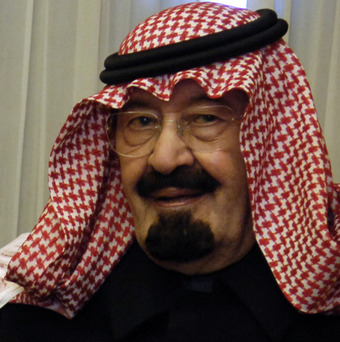
King Abdullah bin Abdul al-Saud of Saudi Arabia
King Abdullah bin Abdul al-Saud, King of Saudi Arabia, derived his authority from tradition.
15.1.6: Rational-Legal Authority
Rational-legal authority is a form of leadership in which authority is largely tied to legal rationality, legal legitimacy, and bureaucracy.
Learning Objective
Recall the three characteristics of the modern state, according to Weber
Key Points
- Unlike charismatic authority and traditional authority, rational-legal authority derives its powers from the system of bureaucracy and legality.
- Weber defined legal order as a system wherein the rules are enacted and obeyed as legitimate because they are in line with other laws on how they can be enacted and how they should be obeyed.
- The modern state based on rational-legal authority emerged from the patrimonial and feudal struggle for power uniquely in Western civilization.
- A modern state exists where a political community has created an administrative and legal order, binding authority over citizens, and the legitimate use of physical force.
Key Terms
- bureaucracy
-
Structure and regulations in place to control activity. Usually in large organizations and government operations.
- legal order
-
A system where the rules are enacted and obeyed as legitimate because they are in line with other laws on how they can be enacted and how they should be obeyed. Further, they are enforced by a government that monopolizes their enactment and the legitimate use of physical force.
- authority
-
The power to enforce rules or give orders.
Example
- Different forms of authority transfer power in different ways. In traditional authority, power is usually passed on through a family line. In rational-legal authority, power is passed on according to a set of rules. In the United States, for example, presidential power is passed on through elections. Elections must follow specific rules to ensure they are fair: all eligible voters must be allowed to vote, no poll tax can be charged because it would discriminate against those who could not pay, and so on. Although individual voters may choose which candidate they favor based on a candidate’s charisma or family background, the election itself must follow rational-legal requirements. When election results are disputed, they are decided by referring back to those rules. Thus, for example, when the 2000 election between Bush and Gore came down to a very close vote, it was decided by a careful review of ballots and voting procedures, not by anything having to do with the qualifications of the candidates.
Rational-legal authority is a form of leadership in which the authority of an organization or a ruling regime is largely tied to legal rationality, legal legitimacy, and bureaucracy. It is the second of Max Weber’s tripartite classification of authority. The majority of the modern states of the twentieth century are rational-legal authorities, according to those who use this form of classification .
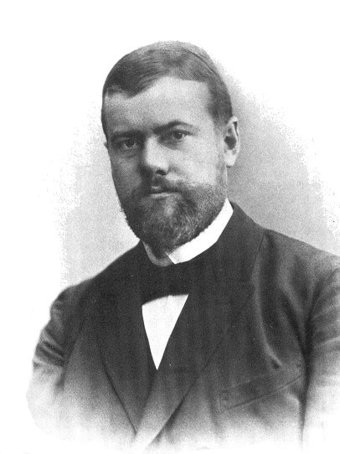
Max Weber
Max Weber and Wilhelm Dilthey introduced verstehen—understanding behaviors—as goal of sociology.
Unlike charismatic authority and traditional authority, rational-legal authority derives its powers from the system of bureaucracy and legality. Weber defined legal order as a system wherein the rules are enacted and obeyed as legitimate because they are in line with other laws on how they can be enacted and how they should be obeyed. These rules are enforced by a government that monopolizes their enactment, while holding the legitimate use of physical force.
Weber wrote that the modern state based on rational-legal authority emerged from the patrimonial and feudal struggle for power uniquely in Western civilization. The prerequisites for the modern Western state are the monopoly by a central authority of the means of administration and control; the monopoly of legislative authority; and the organization of officialdom, dependent upon the central authority.
According to Max Weber, a modern state exists where a political community has three elements. First, an administrative and legal order that has been created and can be changed by legislation that also determines its role. Second, it must have binding authority over citizens and actions in its jurisdiction. Lastly, it must possess the right to legitimately use the physical force in its jurisdiction.

A FEMA Employee Fills Out Paperwork
Ration-legal authority depends on routinized administration, which often involves a lot of paperwork.
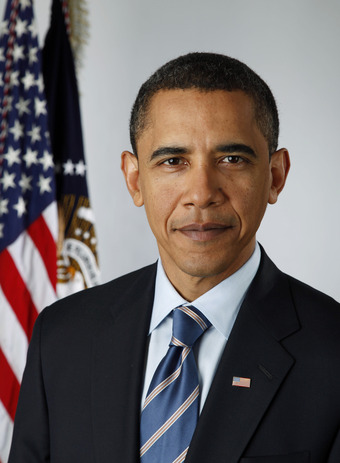
President Barack Obama
Barack Obama, President of the United States, derives his authority from a rational-legal system of laws outlined in a formal document, the Constitution of the United States of America.
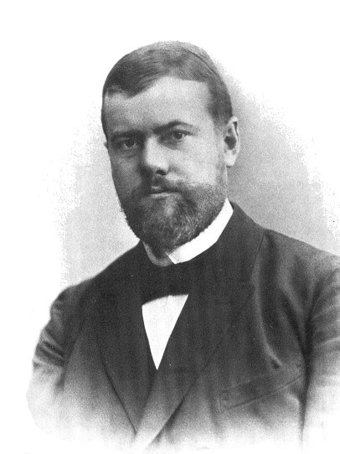
Max Weber on Rational-Legal Authority
According to Weber, rational-legal authority is a form of leadership in which the authority of an organization or a ruling regime is largely tied to legal rationality, legal legitimacy, and bureaucracy.
15.1.7: Charismatic Authority
Charismatic authority is power legitimized by a leader’s exceptional personal qualities, which inspire loyalty and obedience from followers.
Learning Objective
Create a model of a hypothetical charismatic leader in a hypothetical government which describes the charisma and explains in detail how it is legitimized, used, and maintained
Key Points
- For Weber, charisma applies to “a certain quality of an individual personality, by virtue of which he is set apart from ordinary men and treated as endowed with supernatural powers”.
- In contrast to the current popular use of the term charismatic leader, Weber saw charismatic authority not so much as character traits of the charismatic leader, but as a relationship between the leader and his followers.
- A cult of personality refers to when an individual uses mass media, propaganda, or other methods to create an idealized and heroic public image, often through unquestioning flattery and praise.
- The methods of charismatic succession are search, revelation, designation by original leader, designation by qualified staff, hereditary charisma, and office charisma.
Key Terms
- cult of personality
-
A situation where a leader (often a dictator) has been falsely idolized and made into a national or group icon and is revered as a result.
- routinization
-
Charismatic authority almost always endangers the boundaries set by traditional or rational (legal) authority. It tends to challenge this authority, and is thus often seen as revolutionary. Usually this charismatic authority is incorporated into society. Hereby the challenge that it presents to society will subside. The way in which this happens is called routinization.
- revelation
-
A manifestation of divine truth.
Example
- In popular speech, we think of charisma as a positive personality trait, but for Max Weber, charisma referred simply to a relationship between a leader and his or her subjects. Charismatic leaders gain authority not because they are necessarily kind, but because they are seen as superhuman. Thus, Hitler and Mussolini can be seen as examples of charismatic leaders.
Charismatic authority is one of three forms of authority laid out in Max Weber’s tripartite classification of authority. Weber defined charismatic authority as “resting on devotion to the exceptional sanctity, heroism or exemplary character of an individual person, and of the normative patterns or order revealed or ordained by him” .
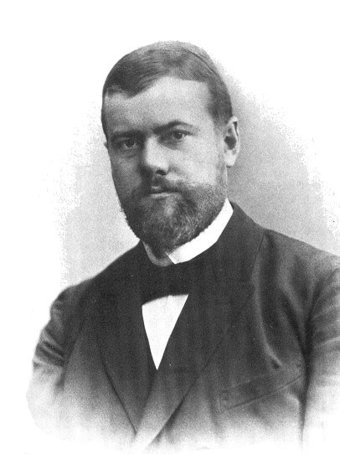
Max Weber
Weber defined charismatic authority as “resting on devotion to the exceptional sanctity, heroism or exemplary character of an individual person, and of the normative patterns or order revealed or ordained by him.”
Charismatic authority is power legitimized on the basis of a leader’s exceptional personal qualities, or the demonstration of extraordinary insight and accomplishment, which inspire loyalty and obedience from followers. In contrast to the current popular use of the term charismatic leader, Weber saw charismatic authority not so much as character traits of the charismatic leader but as a relationship between the leader and his followers. For Weber, charisma applies to “a certain quality of an individual personality, by virtue of which he is set apart from ordinary men and treated as endowed with supernatural, superhuman, or at least specifically exceptional powers or qualities. “
Charismatic authority almost always evolves in the context of boundaries set by traditional or rational-legal authority, but by its nature tends to challenge this authority, and is thus often seen as revolutionary. However, the constant challenge that charismatic authority presents to a particular society will eventually subside as it is incorporated into that society through routinization. Routinization is the process by which “charismatic authority is succeeded by a bureaucracy controlled by a rationally established authority or by a combination of traditional and bureaucratic authority. “
In politics, charismatic rule is often found in various authoritarian states, autocracies, dictatorships, and theocracies. In order to help to maintain their charismatic authority, such regimes will often establish a vast cult of personality, which is signaled when an individual uses mass media, propaganda, or other methods to create an idealized and heroic public image, often through unquestioning flattery and praise. When the leader of such a state dies or leaves office and a new charismatic leader does not appear, such a regime is likely to fall shortly thereafter unless it has become fully routinized.
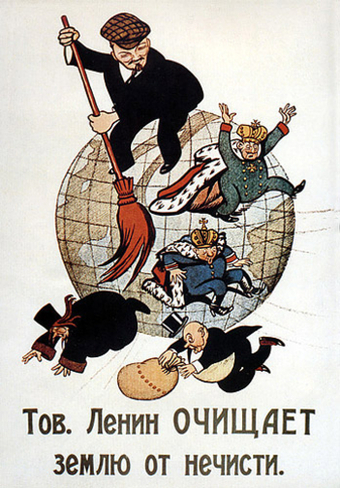
Lenin, a charismatic leader
Bolshevik political cartoon poster from 1920 depicting Lenin sweeping away monarchists and capitalists; the caption reads, “Comrade Lenin Cleanses the Earth of Filth.”
According to Max Weber, the methods of charismatic succession are search, revelation, designation by original leader, designation by qualified staff, hereditary charisma, and office charisma. These are the various ways in which an individual and a society can contrive to maintain the unique energy and nature of charisma in their leadership.
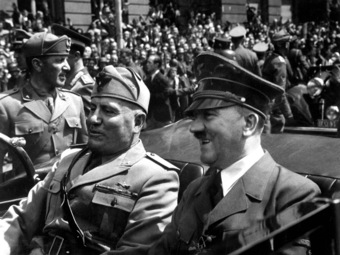
Mussolini and Hitler
According to Weber, charismatic leaders gain authority not because they are necessarily kind, but because they are seen as superhuman.
15.1.8: The Transfer of Authority
In the United States, transfers of authority generally occur after presidential elections.
Learning Objective
Compare presidential transitions with transitional justice using real-life examples
Key Points
- A presidential transition refers to the period of time between the end of a presidential election and the inauguration of a new president.
- In the United States, during a presidential transition, the outgoing, “lame duck” president has lost many of the intangible benefits of a presidency, but the incoming president-elect is not yet legally empowered to enforce policy.
- Transitional justice refers to a range of efforts, on the part of the state, to address past human rights violations. These efforts include both judicial and non-judicial methods.
- In the context of transitional justice, memorialization is used to honor the victims of human rights abuses.
Key Terms
- Presidential transition
-
A presidential transition or presidential interregnum refers to the period of time between the end of a presidential election and the inauguration of a new president.
- transitional justice
-
Transitional justice generally refers to a range of approaches that states may use to address past human rights violations. This includes both judicial and non-judicial approaches.
- president-elect
-
a person who has been elected to a presidency but has not yet been inducted into office
Presidential Transitions
A presidential transition refers to the period of time between the end of a presidential election and the inauguration of a new president. During this time, the incoming president usually designates new governmental personnel, including those individuals who will either serve in the cabinet or lead governmental agencies.
In the United States, the presidential transition extends from the date of the presidential election, in early November, until the twentieth day of January in the following year. This was specified in the Twentieth Amendment to the Constitution. During a presidential transition, the outgoing president, also known as the “lame duck,” has lost many of the intangible benefits of a presidency. That being said, the incoming president-elect is not yet legally empowered to enforce policy. This ambiguity, between the president-elect and outgoing president, creates the potential for a leadership vacuum, which may be most acutely felt during wartime or times of economic crisis.
Transitional Justice
In other nations, many of which have experienced undemocratic governments and dictators, transitional justice refers to a state’s efforts to address past human rights violations. These efforts can be both judicial and non-judicial, and refer to actions, policies or institutions that are enacted at a point of political transition from violence or repression to societal stability. As a project, transitional justice has a number of goals, including rebuilding social trust, repairing a fractured judicial system, and building a democratic system of governance.
In the context of transitional justice, memorialization is used to honor the victims of human rights abuses. By demonstrating respect and acknowledging the past, national memorials can help governments reconcile tensions with victims. They can also help to establish a record of history and to prevent the recurrence of abuse.

Presidential Inauguration, 2005
In the United States, elaborate inauguration ceremonies mark the transfer of authority.
15.2: Government and the State
15.2.1: Functions of the State
Various schools of thought consider the state to be either a neutral entity separated from society or an immoral partisan instrument.
Learning Objective
Classify the different political theories concerning the function of the state in society
Key Points
- Liberal and conservative theories of the state tend to see the state as a neutral entity separated from society and the economy. These theories treat the economic system of capitalism as a given.
- Marxist theories see the state as a partisan instrument that primarily serves the interests of the upper class. These theories emphasize the relationship between political power and economic power.
- Anarchists believe that the state apparatus should be completely dismantled and an alternative set of social relations created. These social relations would not be based on state power at all.
- Pluralists view the state as a neutral body that simply enacts the will of whichever groups dominate the electoral process.
- A polyarchy, a concept developed by Robert Dahl, refers to the idea that the modern democratic state’s acts in response to the pressures applied to it by a variety of organized interests.
Key Terms
- anarchist
-
One who believes in or advocates the absence of hierarchy and authority in most forms (compare anarchism), especially one who works toward the realization of such.
- pluralist
-
an advocate of pluralism (in all senses)
- polyarchy
-
a government by many persons, of whatever order or class
Examples
- Many people consider the United States to be a pluralist state. Even our money reads “E Pluribus Unum,” which means out of many, one. Much of U.S. politics can be understood by looking at different special interest groups who compete to get their agendas passed. For example, in debates over education, the National Education Association, a union of teachers, might be considered one special interest group, while a group of parents could band together to form another interest group. The teachers union would likely support tenure for teachers, while the parents group might want stricter evaluation of teachers or stiffer requirements for pay raises. According to the pluralist view, whichever interest group was better able to recruit members to its cause, and to persuade policymakers, would prevail.
- Marxists explain political outcomes and policies not by reference to different interest groups, but by assuming that the state acts in a way that benefits capitalists and hurts workers. So, for example, Marxists would not be surprised to see government forces such as the police or national guard mobilized in order to put down strikers, nor would they be surprised when politicians continually give tax cuts to the rich. On an even more mundane level, Marxists might point out that many states have given capitalists extra privileges by treating corporations as people, affording them the same rights as human beings.
The State
A state is an organized political community acting under a government. States may be classified as sovereign if they are not dependent on, or subject to, any other power or state. States are considered to be subject to external sovereignty, or hegemony, if their ultimate sovereignty lies in another state. A federated state is a territorial, constitutional community that forms part of a federation. Such states differ from sovereign states, in that they have transferred a portion of their sovereign powers to a federal government .
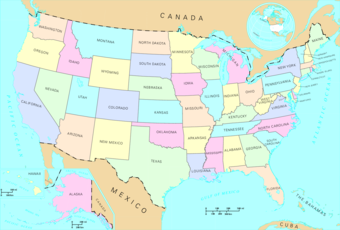
The United States
Americans live in a federal system of 50 states that, together, make up the United Sates of America.
Theories of the State
Most political theories of the state can roughly be classified into two categories. The first, which includes liberal or conservative theories, treats capitalism as a given, and concentrates on the function of states in a capitalist society. Theories of this variety view the state as a neutral entity distinct from both society and the economy.
Marxist Theory
Marxist theory, on the other hand, sees politics as intimately intermingled with economic relations, and emphasizes the relationship between economic power and political power. Marxists view the state as a partisan instrument that primarily serves the interests of the upper class. Marx and Engels were clear that communism’s goal was a classless society in which the state would have “withered away. ” For Marxist theorists, the role of the non-socialist state is determined by its function in the global capitalist order. Marx’s early writings portrayed the state as “parasitic,” built upon the superstructure of the economy and working against the public interest. He believed that the state mirrored societal class relations, that it regulated and repressed class struggle, and that it was a tool of political power and domination for the ruling class.
Anarchism
Anarchism is a political philosophy that considers states immoral and instead promotes a stateless society, anarchy. Anarchists believe that the state is inherently an instrument of domination and repression, no matter who is in control of it. Anarchists believe that the state apparatus should be completely dismantled and an alternative set of social relations created, which would be unrelated to state power.

Anarchists at the G20 Summit in London, 2009
Anarchists oppose state control.
Pluralism
Pluralists view society as a collection of individuals and groups competing for political power. They then view the state as a neutral body that simply enacts the will of whichever group dominates the electoral process. Within the pluralist tradition, Robert Dahl developed the theory of the state as a neutral arena for contending interests. He also viewed governmental agencies as simply another set of competing interest groups. The pluralist approach suggests that the modern democratic state acts in response to pressures that are applied by a variety of organized interests. Dahl called this kind of state a polyarchy. Pluralism has been challenged on the ground that it is not supported by empirical evidence.
15.2.2: Characteristics of the State
A state is an organized political community acting under a government. States differ in sovereignty, governance, geography, and interests.
Learning Objective
Discuss the central characteristics that define the state
Key Points
- Federated states differ from sovereign states in that they have transferred a portion of their sovereign powers to a federal government.
- Under the rule of law, no one person can rule and even top government officials are bound by the law.
- The “nation” refers to a large geographical area and the people living there who perceive themselves as having a common identity.
- The nation state is a state that self-identifies as deriving its political legitimacy from serving as a sovereign entity for a nation as a sovereign territorial unit.
- Civil society is the arena outside of the family, the state, and the market where people associate to advance common interests.
Key Terms
- nation state
-
a political entity (a state) associated with a particular cultural entity (a nation)
- civil society
-
All of the institutions, voluntary organizations, and corporate bodies that are less than the state but greater than the family.
- Sovereign states
-
A sovereign state is a political organization with a centralized government that has supreme independent authority over a geographic area.
Example
- To understand the differences between state and nation, consider an example like Poland. The people of Poland have long formed a nation with a shared language and culture, but that nation has, through history, been cross-cut by various political borders. Thus, at times, members of the Polish nation have been governed by different states. Today, Poland’s boundaries roughly align with the geographical area where the people of the Polish nation live, and thus Poland can be thought of as a nation state.
States may be classified as sovereign if they are not dependent on, or subject to, any other power or state. Other states are subject to external sovereignty or hegemony where ultimate sovereignty lies in another state. A federated state is a territorial and constitutional community forming part of a federation. Such states differ from sovereign states, in that they have transferred a portion of their sovereign powers to a federal government.
The concept of the state is different from the concept of government. A government is the particular group of people that controls the state apparatus at a given time. In other words, governments are the means through which state power is employed; for example, by applying the rule of law. The rule of law is a legal maxim whereby governmental decisions are made by applying known legal principles. The rule of law is rule not by one person, as in an absolute monarchy, but by laws, as in a democratic republic; no one person can rule and even top government officials are under and ruled by the law.
The concept of the state is also different from the concept of a nation, which refers to a large geographical area, and the people therein who perceive themselves as having a common identity. The state is a political and geopolitical entity; the nation is a cultural or ethnic entity. The nation state is a state that self-identifies as deriving its political legitimacy from serving as a sovereign entity for a nation as a sovereign territorial unit. The term nation state implies that the two geographically coincide.
In classical thought, the state was identified with political society and civil society as a form of political community. In contrast, modern thought distinguishes the nation state as a political society from civil society as a form of economic society. Civil society is the arena outside of the family, the state, and the market where people associate to advance common interests. It is sometimes considered to include the family and the private sphere and then referred to as the third sector of society, distinct from government and business.

Heads of State
In the United States, the state is governed by a government headed by an elected president. Pictured here are, from left to right, Presidents George H.W. Bush, Barack Obama, George W. Bush, Bill Clinton, and Jimmy Carter.
15.2.3: Citizenship Rights
Citizenship carries both rights and responsibilities, as it describes a person with legal rights within a given political order.
Learning Objective
Discuss the rights and responsibilities of citizenship held by individuals
Key Points
- Citizenship is the state of being a member of a particular social, political, national, or human resource community. The term describing all citizens as a whole is citizenry.
- Citizenship generally carries with it the right of political participation in a community, including voting, participating in government, and receiving state protection.
- A person who does not have citizenship in any state is stateless.
- Many people are presumed to be citizens of a nation if they were born within the physical geographic territory of the nation. This policy is called, by the Latin legal term. jus soli, meaning “right of soil. ” A jus sanguinis policy grants citizenship based on ancestry or ethnicity.
- Nationalization is the acquisition of citizenship by somebody who was not a citizen of that country at the time of birth.
- The term “citizen of the world” has been applied to people who have fewer ties to a particular nation and more of a sense of belonging to the world in general.
Key Terms
- jus sanguinis
-
Jus sanguinis (Latin: right of blood) is a social policy by which citizenship is not determined by place of birth, but rather by having one or both parent who are citizens of the nation. It contrasts with jus soli (Latin for “right of soil”).
- jus soli
-
A right by which nationality or citizenship can be recognized to any individual born in the territory of the related state.
- nationalization
-
Nationalization is the process of taking an industry or assets into government ownership by a national government or state
Examples
- In the United States, citizens have certain rights and responsibilities, as defined in the U.S. Constitution and Bill of Rights. Citizens have the right to free speech and freedom of assembly, for example, but they also have the responsibility to follow the laws of the land and to pay taxes.
- In the United States, citizens have certain rights and responsibilities, as defined in the U.S. Constitution and Bill of Rights. Citizens have the right to free speech and freedom of assembly, for example, but they also have the responsibility to follow the laws of the land and to pay taxes.
Legally, citizenship denotes a link between an individual and a state. Under international law, citizenship is synonymous to nationality, although the two may have different meanings under national law. A person who does not have citizenship in any state is stateless.
A person is generally presumed to be a citizen of a nation if one or both of their parents are also a citizen of said nation; this is often called jus sanguinis (Latin legal term), meaning “right of blood. ” A jus sanguinis policy means grants citizenship based on ancestry or ethnicity, and is related to the concept of a nation state common in Europe. Many people are presumed to be citizens of a nation if they were born within the physical geographic territory of the nation. This policy is called by jus soli (Latin legal term), meaning “right of soil. ” These first two factors are usually lumped together under the term birthright citizenship .
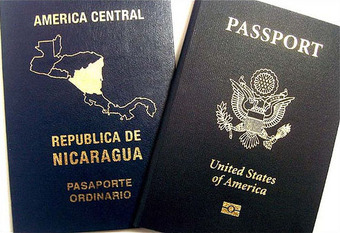
Dual Citizenship
Some people may be citizens of more than one country.
Nationalization is the acquisition of citizenship by somebody who was not a citizen of that country at the time of birth. In general, basic requirements for nationalization are that the applicant hold a legal status as a full-time resident for a minimum period of time, and that the applicant promises to obey and uphold that country’s laws, to which an oath or pledge of allegiance is sometimes added. Citizenship can also be obtained by marrying a citizen, which is termed jure matrimonii.
Citizenship status, under social contract theory, carries with it both rights and responsibilities. In this sense, citizenship was described as “a bundle of rights — primarily, political participation in the life of the community, the right to vote, and the right to receive certain protection from the community, as well as obligations. ” Citizenship is a status in society. It generally describes a person with legal rights within a given political order. It almost always has an element of exclusion, meaning that some people are not citizens; this distinction can sometimes be very important, or not important, depending on a particular society.
More generally, citizenship is seen as the relation between an individual and a particular nation. Certain entities, however, cross national boundaries, such as trade organizations, non-governmental organizations, and multi-national corporations, and sometimes the term “citizen of the world” has been applied in to people who have fewer ties to a particular nation and more of a sense of belonging to the world in general.
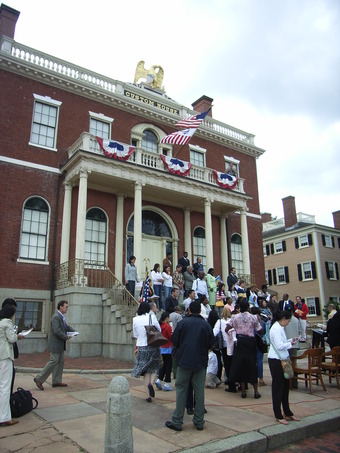
Naturalization Ceremony, Salem, MA, Citizenship Day 2007
New citizens are welcomed during a naturalization ceremony in Salem, MA.
15.2.4: State Formation
Theories explaining the origins and formation of states all revolve around the ability to centralize power in a sustainable way.
Learning Objective
Discuss the formation of states and centralization of authority in modern history
Key Points
- States first arose when agriculture and writing made centralized power possible.
- In hydraulic civilizations, water and irrigation were centrally controlled, which consequently led to the general centralization of power in a despotic state.
- According to the coercion theory of state formation, states formed in order to handle the burden of fighting and defending against wars.
- States have continued to grow more rational and bureaucratic, with expanding executive bureaucracies, such as the extensive cabinet system in the United States. Thus, states have evolved from relatively simple but powerful central powers to complex and highly organized institutions.
Key Terms
- Centralization of power
-
Centralization of power occurs in governments in which power or legal authority is exerted or coordinated by a de facto political executive to which federal states, local authorities, and smaller units are considered subject. In a national context, centralization occurs in the transfer of power to a typically sovereign nation state.
- Hydraulic civilization
-
A hydraulic empire (also known as a hydraulic despotism, or water monopoly empire) is a social or government structure which maintains power and control through exclusive control over access to water. It arises through the need for flood control and irrigation, which requires central coordination and a specialized bureaucracy.
State Formation and the Centralization of Power
Today we take it for granted that different societies are governed by different states, but this has not always been the case. Since the late nineteeth century, virtually the entirety of the world’s inhabitable land has been parceled up into areas with more or less definite borders claimed by various states. Earlier, quite large land areas had been either unclaimed or uninhabited, or inhabited by nomadic peoples who were not organized as states. In fact, for most of human history, people have lived in stateless societies, characterized by a lack of concentrated authority, and the absence of large inequalities in economic and political power.
The first known states were created in Ancient Egypt, Mesopotamia, India, China, the Americas (e.g., Aztec civilization, Inca civilization). Most agree that the earliest states emerged when agriculture and writing made it possible to centralize power in a durable way. Agriculture allowed communities to settle and also led to class division: some people devoted all their time to food production, while others were freed to specialize in other activities, such as writing or ruling. Thus, states, as an institution, were a social invention. Political sociologists continue to debate the origins of the state and the processes of state formation.
Competing Theories of State Formation
Hydraulic Civilization
According to one early theory of state formation, the centralized state was developed to administer large public works systems (such as irrigation systems) and to regulate complex economies. This theory was articulated by German American historian Karl August Wittfogel in his book 1957 Oriental Despotis. Wittfogel argued that most of the earliest states were formed in hydraulic civilizations, by which he meant civilizations where leaders controlled people by controlling the water supply. Often, these civilizations relied on complex irrigation systems that had to be centrally managed. The people, therefore, had good reason to give control to a central state, but in giving up control over the irrigation system, they also gave up control over their own livelihoods and, thus, the central state gained immense control over people in general. Although Wittfogel’s theory is well known, it has also been criticized as inaccurate. Modern archaeological and anthropological evidence shows that many early societies were not as centralized, despotic, or unequal as the hydraulic theory would suggest.
Coercion, War, and the State
An alternative theory of state formation focuses on the rise of more modern nation-states and explains their rise by arguing they became necessary for leveraging the resources necessary to fight and defend against wars. Sociologist Charles Tilly is the best known theorist in this tradition. Tilly examined political, social, and technological change in Europe from the Middle Ages to the present and attempted to explain the unprecedented success of the nation-state as the dominant form of state on Earth. In other words, instead of asking (like Wittfogel) where the very first states came from, Tilly asked where the types of states with which we’re most familiar came from, and why they became so common.
According to Tilly’s theory, military innovation in pre-modern Europe (especially gunpowder and mass armies) made war extremely expensive. As a result, only states with a sufficient amount of capital and a large population could afford to pay for their security and ultimately survive in the hostile environment. Thus, the modern states and its institutions (such as taxes) were created to enable war making.

Ancient Persian and Greek Warriors
States may have formed to help societies organize for war.
Rationalization and Bureaucracy
Yet another theory of state formation focuses on the long, slow, process of rationalization and bureaucratization that began with the invention of writing. The Greeks were the first people known to have explicitly formulated a political philosophy of the state, and to have rationally analyzed political institutions. In Medieval Europe, feudalism furthered the rationalization and formalization of the state. Feudalism was based on the relationship between lord and vassal, which became central to social organization and, indeed to state organization. The Medieval state was organized by Estates, or parliaments in which key social groups negotiated with the king about legal and economic matters. Since then, states have continued to grow more rational and bureaucratic, with expanding executive bureaucracies, such as the extensive cabinet system in the United States. Thus, states have evolved from relatively simple but powerful central powers to complex and highly organized institutions.
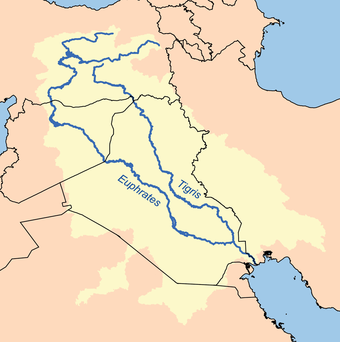
The Tigris-Euphrates Watershed in Mesopotamia
In hydraulic civilizations, control over water concentrated power in central despotic states.
15.3: Types of States
15.3.1: Types of States
States vary based on who holds power, who elects the empowered, and how authority is maintained.
Learning Objective
Identify the central features that distinguish different types of states
Key Points
- One way to classify these governments is by looking at how leaders gain power. Under this system, governments fall into general categories of authoritarianism, oligarchy, and democracy.
- Authoritarian governments differ in who holds power and in how much control they assume over those that they govern, but all are marked by the fact that the empowered are unelected individuals. One well-known example of this type of government is a monarchy.
- An oligarchy is a form of government in which power effectively rests with a small elite segment of society distinguished by royalty, wealth, family, military, or religious hegemony. One common example is theocracy.
- Democracy is a form of government in which the right to govern is held by the majority of citizens within a country or a state. All members of the society have equal access to power and all members enjoy universally recognized freedoms and liberties.
Key Terms
- theocracy
-
Government under the control of a Church or state-sponsored religion
- Democratic presidential republic
-
A system of government where an executive branch is led by a president who serves as both head of state and head of government; in such a system, this branch exists separately from the legislature, to which it is not responsible and which it cannot, in normal circumstances, dismiss.
- oligarchy
-
A government run by only a few, often the wealthy
Examples
- The United States is a democratic presidential republic.
- In the 19th century, Britain, which was a monarchy, concentrated all power in an individual king.
States come in a variety of forms that vary based on who holds power, how positions of leadership are obtained, and how authority is maintained. The United States is a democratic presidential republic: a democratic government headed by a powerful elected executive, the president. The United States originally won its independence from Britain, which was a monarchy, in which power was concentrated in an individual king. Other forms of government include oligarchy and dictatorship or totalitarianism. One way to classify these governments is by looking at how leaders gain power. Under this system, governments fall into general categories of authoritarianism, oligarchy, and democracy.
Authoritarian Governments
Authoritarian governments differ in who holds power and in how much control they assume over those that they govern, but all are marked by the fact that the empowered are unelected individuals. One well-known example of this type of government is a monarchy.
A monarchy is a form of government in which supreme power is absolutely or nominally lodged with an individual, who is the head of state, often for life or until abdication. The person who heads a monarchy is called a monarch. There is no clear definition of monarchy. Some monarchs hold unlimited political power while many constitutional monarchies, such as the United Kingdom and Thailand, have monarchs with limited political power. Hereditary rule is often a common characteristic, but elective monarchies are also considered monarchies (e.g., The Pope) and some states have hereditary rulers, but are considered republics (e.g., the Dutch Republic). Currently, 44 nations in the world have monarchs as heads of state.
Totalitarianism (or totalitarian rule) is a political system that strives to regulate nearly every aspect of public and private life. Totalitarian regimes or movements maintain themselves in political power by means of an official all-embracing ideology and propaganda disseminated through the state-controlled mass media, a single party that controls the state, personality cults, control over the economy, regulation and restriction of free discussion and criticism, the use of mass surveillance, and widespread use of state terrorism.
Oligarchic Governments
An oligarchy is a form of government in which power effectively rests with a small elite segment of society distinguished by royalty, wealth, family, military, or religious hegemony. An oligarchy is different from a true democracy because very few people are given the chance to change things. An oligarchy does not have to be hereditary or monarchic. An oligarchy does not have one clear ruler, but several powerful people who rule. One common example is that of theocracy.
Theocracy is a form of government in which a god or deity is recognized as the state’s supreme civil ruler, or in a broader sense, a form of government in which a state is governed by immediate divine guidance or by officials who are regarded as divinely guided. Theocratic governments enact theonomic laws. Theocracies are distinguished from other secular forms of government that have a state religion, or are merely influenced by theological or moral concepts, and monarchies held “by the Grace of God. “
Democratic Governments
Democracy is a form of government in which the right to govern is held by the majority of citizens within a country or a state. The two principles of a democracy are that all citizens have equal access to power and that all citizens enjoy universally recognized freedoms and liberties. There are several varieties of democracy, some of which provide better representation and more freedoms for their citizens than others. However, if any democracy is not carefully legislated with balances, such as the separation of powers, to avoid an uneven distribution of political power, then a branch of the system of rule could accumulate power and become harmful to the democracy itself. Freedom of political expression, freedom of speech, and freedom of the press are essential so that citizens are informed and able to vote in their personal interests.

Countries of the World, by Type of Government in 2011
This map shows all the countries of the word, colored according to their type of government. Blue represents full presidential republics, while green and yellow are presidential republics with less powerful presidents. Orange represents parliamentary republics. Red and pink are parliamentary constitutional monarchies, and purple represents absolute monarchies. Brown represents single-party republics, green shows countries where government has been suspended (e.g., military dictatorships), and grey countries do not fit any of the above categories.
15.3.2: Monarchy
A monarchy is a form of government in which supreme power is absolutely or nominally lodged with an individual, who is the head of state.
Learning Objective
Give examples of monarchies in the contemporary world
Key Points
- Monarchy was a common form of government in the world during the ancient and medieval times. It is less common today, although several monarchies still exist.
- Modern monarchies often takes the form of a constitutional monarchy, in which the monarch retains a unique legal and ceremonial role, but exercises limited or no political power pursuant to a constitution or tradition which allocates governing authority elsewhere.
- Most states only have a single person acting as monarch at any given time, although two monarchs have ruled simultaneously in some countries, a situation known as diarchy.
Key Terms
- diarchy
-
A form of government where power is shared between two joint authorities.
- hereditary rule
-
Hereditary rule is a form of government in which all the rulers come from the same family, and the crown is passed down from one member to another member of the family.
Example
- Currently, 44 nations in the world have monarchs as heads of state. Of these, 16 are Commonwealth realms such as Canada and Australia that recognize the monarch of the United Kingdom as their head of state.
A monarchy is a form of government in which supreme power is absolutely or nominally lodged with an individual, who is the head of state, often for life or until abdication. The person who heads a monarchy is called a monarch.
Monarchy was the most common form of government into the 19th century, but it is no longer prevalent, at least at the national level. Monarchy now often takes the form of a constitutional monarchy, in which the monarch retains a unique legal and ceremonial role, but exercises limited or no political power pursuant to a constitution or tradition which allocates governing authority elsewhere. Currently, 44 nations in the world have monarchs as heads of state. Of these, 16 are Commonwealth realms such as Canada and Australia that recognize the monarch of the United Kingdom as their head of state.
There is no clear definition of monarchy. Even characteristics most commonly associated with monarchies are not universal. For example, monarchies are often though of as highly centralized forms of absolute power. But holding unlimited political power in the state is not the defining characteristic, as many constitutional monarchies such as the United Kingdom and Thailand are considered monarchies yet their monarchs have limited political power. Hereditary rule is often a common characteristic, but some monarchs are elected (e.g., the Pope), and some states with hereditary rulers are nevertheless considered republics (e.g., the Dutch Republic).
Most states only have a single person acting as monarch at any given time, although two monarchs have ruled simultaneously in some countries, a situation known as diarchy. Historically, this was the case in the ancient Greek city-state of Sparta or 17th-century Russia, and there are examples of joint sovereignty of spouses or relatives (such as William and Mary in the Kingdoms of England and Scotland).

Queen Elizabeth II
Queen Elizabeth II is the monarch of the United Kingdom.
15.3.3: Oligarchy
An oligarchy is a form of government in which power effectively rests with a small elite segment of society.
Learning Objective
Compare and contrast the different types of oligarchical governments that exist
Key Points
- Like monarchies, oligarchies may depend on blood relations, but they may also depend on wealth, religion, or military hegemony.
- In de jure oligarchies, an elite group is given power by the law. For example, the law may give only nobility the right to vote, or a theocracy may be ruled by a group of religious leaders.
- In de facto oligarchies, those with more resources are able to gain political power, despite laws that ostensibly treat all citizens equally.
- Some contemporary authors have characterized the United States’ current state of affairs as being oligarchic in nature.
Key Term
- elite
-
A special group or social class of people which have a superior intellectual, social or economic status as, the elite of society.
Examples
- The Soviet Union was a de jure oligarchy: only members of the Communist Party were allowed to vote or hold office. Today, Russia may be considered a de facto oligarchy: Since the collapse of the Soviet Union on 31 December 1991, privately owned Russia-based multinational corporations, including producers of petroleum, natural gas, and metal have become oligarchs. Privatization allowed executives to amass phenomenal wealth and power almost overnight. In May 2004, the Russian edition of Forbes identified 36 of these oligarchs as being worth at least $1 billion.
- Another modern example of oligarchy could be seen in South Africa during the twentieth century. Here, the basic characteristics of oligarchy are particularly easy to observe, since the South African form of oligarchy was based on race. After the Second Boer War, a tacit agreement or understanding was reached between English- and Afrikaans-speaking whites. Together, they made up about 20 percent of the population, but this small percentage ruled the vast non-white and mixed-race population. Whites had access to virtually all the educational and trade opportunities, and they proceeded to deny this to the black majority. Although this process had been going on since the mid-17th- 18th century, after 1948 it became official government policy and became known worldwide as apartheid. This lasted until the arrival of democracy in South Africa in 1994, punctuated by the transition to a democratically-elected government dominated by the black majority.
An oligarchy is a form of government in which power effectively rests with a small elite segment of society distinguished by royalty, wealth, family, military, or religious hegemony. Oligarchies are often controlled by politically powerful families whose children are heavily conditioned and mentored to be heirs of the power of the oligarchy. These types of states have been tyrannical throughout history, relying on public servitude and complacency in order to exist.
States may be oligarchies de jure or de facto. In de jure oligarchies, an elite group is given power by the law. The law may give only nobility the right to vote, or a theocracy may be ruled by a group of religious leaders. In de facto oligarchies, those with more resources are able to gain political power, despite laws that ostensibly treat all citizens equally. One example of this is a corporate oligarchy, or corporatocracy—a system in which power effectively rests with a small, elite group of inside individuals, sometimes from a small group of educational institutions, or influential economic entities or devices, such as banks, commercial entities, lobbyists that act in complicity with, or at the whim of the oligarchy, often with little or no regard for constitutionally protected prerogative. Monopolies are sometimes granted to state-controlled entities, such as the Royal Charter granted to the East India Company, or privileged bargaining rights to unions (labor monopolies) with very partisan political interests. Today’s multinational corporations function as corporate oligarchies with influence over democratically elected officials.
Some contemporary authors have characterized the United States’ current state of affairs as being oligarchic in nature. Jeffrey A. Winters argues that “oligarchy and democracy operate within a single system, and American politics is a daily display of their interplay. ” Bernie Sanders (I-VT) opined in a 2010 article from The Nation that an “upper-crust of extremely wealthy families are hell-bent on destroying the democratic vision of a strong middle-class which has made the United States the envy of the world. In its place they are determined to create an oligarchy in which a small number of families control the economic and political life of our country. “
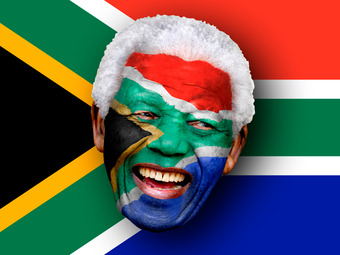
Nelson Mandela
In 1994, Nelson Mandela became the first president of South Africa elected in a fully representative election, which marked the end of oligarchic apartheid in that country.

Alexander Lebedev and President Putin
Alexander Lebedev represents a new class of Russian oligarchs, which arose after the fall of communism by taking control of major industries. He is one of the richest people in the world.
15.3.4: Dictatorship and Totalitarianism
Dictatorships govern without consent of the people and in totalitarian dictatorships the power to govern extends to all aspects of life.
Learning Objective
Compare and contrast dictatorships with totalitarian governments
Key Points
- Dictatorship is a form of government in which the ruler has the power to govern without consent of those being governed.
- Totalitarian governments are those that regulate nearly every aspect of public and private behavior.
- Dictatorship concerns the source of the governing power (where the power comes from, the people or a single leader) and totalitarianism concerns the scope of the governing power (what is the government and how extensive is its power).
Key Terms
- dictatorship
-
A type of government where absolute sovereignty is allotted to an individual or a small clique.
- totalitarianism
-
A system of government in which the people have virtually no authority and the state wields absolute control, for example, a dictatorship.
Example
- Nazi Germany may be the most familiar example of a totalitarian dictatorship. Under the Nazi regime, Hitler was a dictator who governed without the consent of the people and he led a totalitarian government that regulated all aspects of daily life and exerted immense control over its subjects.
Dictatorship and totalitarianism are often associated, but they are actually two separate phenomena. Dictatorship is a form of government in which the ruler has the power to govern without consent of those being governed. Dictatorship can also be defined simply as “a system that does not adhere to democracy,” where democracy is defined as a form of government where those who govern are selected through contested elections. A dictator’s power can originate in his or her family, political position, or military authority.
Many dictatorships are also totalitarian. Totalitarian governments are those that exert total control over the governed; they regulate nearly every aspect of public and private behavior. Totalitarianism entails a political system where the state recognizes no limits to its authority, and it strives to regulate every aspect of public and private life wherever feasible. Totalitarian regimes stay in political power through all-encompassing propaganda campaigns (disseminated through the state-controlled mass media), a single party that is often marked by political repression, personality cultism, control over the economy, regulation and restriction of speech, mass surveillance, and widespread use of terror.
In other words, dictatorship concerns the source of the governing power (where the power comes from—the people or a single leader) and totalitarianism concerns the scope of the governing power (what is the government and how extensive is its power). In this sense, dictatorship (government without people’s consent) exists in contrast with democracy (government whose power comes from people) and totalitarianism (where government controls every aspect of people’s lives) exists in contrast with pluralism (where government allows multiple lifestyles and opinions) .
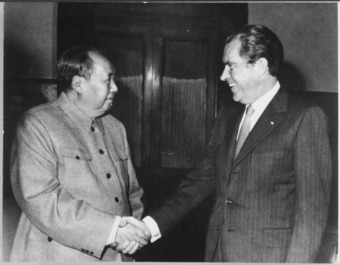
President Nixon and Mao Zedong, 1972
In 1972, Nixon traveled to China and met with Mao Zedong, the leader of the totalitarian Chinese Communist Party.
15.3.5: Democracy
Democracy is a form of government in which sovereignty is held by the majority of citizens within a country or a state.
Learning Objective
Discuss the central features of democratic governments
Key Points
- Democracies come in several forms, though all have competitive elections and freedoms of expression.
- Democracies must balance conflicting obligations to try to maximize freedom and protect individual rights.
- In most democracies, citizens are represented by elected lawmakers charged with drafting and voting on laws.
Key Terms
- separation of powers
-
A theoretical model for governance, common in democratic states, which features the division of sovereign power into at least three (but sometimes up to six) organs of state in order to forestall tyranny, by preventing the acquisition of a monopoly of power by a monarch or oligarchy; also, such an arrangement.
- representative democracy
-
A policy under the rule of people acting on the behalf of and, to a lesser extent, in the interests of the voting blocks by which they were elected.
- tyranny of the majority
-
A situation in which a government or other authority democratically supported by a majority of its subjects makes policies or takes actions benefiting that majority, without regard for the rights or welfare of the rest of its subjects.
Examples
- The United States is an example of a representative democracy. Citizens over the age of 18 may vote in elections to choose their representatives. Those representatives serve in local, state, and national governments. For example, at the local level, citizens elect mayors; at the state level, they elect governors and state legislators; and at the national level, they elect the president, representatives, and senators.
- The United States also provides historical examples of the tyranny of the majority. For example, until 1967, some states outlawed interracial marriage. Such laws embodied majority opinion, at least at the time the law was made, but were oppressive to a minority of citizens who opposed the law. Democracy can make such laws difficult to change until majority sentiment shifts–in this case, after the Civil Rights era of the 1960s.
Democracy is a form of government in which the power of government comes from the people. More formally, we might say that in democracy, the right to govern, or sovereignty, is held by the majority of citizens within a country or state. Even though there is no universally accepted definition of democracy, all definitions include two fundamental principles: First, in a democracy, all citizens have equal access to power. Second, all citizens enjoy universally recognized freedoms and liberties.
Democracies come in several forms, some of which provide better representation and more freedoms for their citizens than others. An essential process in representative democracies is competitive elections that are fair both substantively and procedurally. Furthermore, freedom of political expression, freedom of speech, and freedom of the press are essential so that citizens are informed and able to vote in their personal interests.
Democracies must balance conflicting obligations to try to maximize freedom and protect individual rights. For example, many democracies limit representation. In a full, direct, democracy, every citizen would be able to vote on every law. But in reality, in most democracies, citizens are represented by elected lawmakers charged with drafting and voting on laws. Many also institute measures such as the separation of powers, which divides executive, judicial, and legislative authority among different branches of government to protect against the possibility that a single government or branch of government could accumulate too much power and become harmful to democracy itself. Although such measures may limit representation, they make lawmaking more efficient and help guard against dangers such as the tyranny of the majority. Although majority rule is often described as a characteristic feature of democracy, without responsible government it is possible for the rights of a minority to be abused by the tyranny of the majority, in which a majority institutes policies abusive to a minority (for example, a racial majority may deny a racial minority access to education, housing, jobs, or other resources).
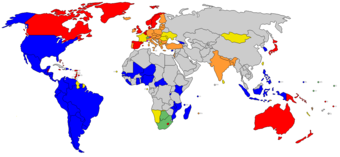
Electoral Democracies
This map depicts electoral democracies around the world, as judged by Freedom House in 2006. Different colors indicate different forms of democracy. Orange countries are parliamentary republics. Green, yellow, and blue are presidential republics with less (green) or more (blue) presidential power. Red are parliamentary constitutional monarchies in which the monarch does not personally exercise power.
15.3.6: New State Spaces
States are not necessarily the same as nations. New state spaces are redefining borders, and they may not be ruled by national governments.
Learning Objective
Explain how political boundaries are changing due to globalization
Key Points
- A global city is a city that is central to the global economic or cultural system, such as New York or London.
- Not only are global cities important economically, but they are also politically unique. In some ways, global cities are more intimately connected to the global economic system and to other global cities than they are to surrounding regions or national settings.
- Another example of a new state space is seen in regional and international governments such as the European Union.
- State power is not restricted to the national level. New state spaces are evolving at both the local level (global cities) and the international level (the European Union).
Key Terms
- European Union
-
A supranational organization created in the 1950s to bring the nations of Europe into closer economic and political connection. At the beginning of 2007, 27 member nations were Austria, Belgium, Bulgaria, Cyprus, Czech Republic, Denmark, Estonia, Finland, France, Germany, Greece, Hungary, Ireland, Italy, Latvia, Lithuania, Luxembourg, Malta, The Netherlands, Poland, Portugal, Romania, Slovakia, Slovenia, Spain, Sweden, United Kingdom.
- Global city
-
A global city (also called world city or sometimes alpha city or world center) is a city generally considered to be an important node in the global economic system.
- Political borders
-
A border is a geographical boundary of political entities or legal jurisdictions.
Examples
- New York and London are examples of global cities that command vast political, economic, and cultural influence both domestically and internationally.
- Another example of a new state space is the European Union, a confederation of 27 European states that encourages political and economic cooperation among its members.
For the last couple centuries, states have been largely coterminous with nations: the two tend to overlap. But states are not necessary the same as nations, and state boundaries will not necessarily always be the same as national boundaries. Recent sociological work has argued that, with globalization, relevant political borders are changing. This branch of sociology defines new state spaces as geographical spaces that are not governed simply by national governments. Instead, they may be more directly influenced by local, regional, or even international governmental bodies. One of the most prominent theories in this field is that of global cities.
Global Cities
A global city is a city that is central to the global economic system, such as New York or London. According to global cities theory, globalization is not a process that affects all places evenly. Globalization is carried out by certain cities, which can be arranged in a hierarchy of importance. Some of these cities are absolutely central to the operation of the global economic system, and some are more peripheral. The most complex and central cities are known as global cities.
Not only are global cities important economically, but they are also politically unique. In some ways, global cities are more intimately connected to the global economic system and to other global cities than they are to surrounding regions or national settings. In general, global cities tend to actively influence and participate in international effents and world affairs. They may be national capitals, or they may host the headquarters of international organizations such as the World Bank, NATO, or the UN. They also tend to have large expatriate communities, groups of people from other countries, who give the cities a cosmpolitan flair and also increase the relevance of foreign political events for global cities.
Regional and International Government
Another example of a new state space is seen in regional and international governments such as the European Union. The European Union is a confederation of 27 European states. It was originally formed to encourage and enable economic cooperation, but has grown to have a good deal of political power, most notably directing a Common Agricultural Policy for member states. Thus, citizens of European countries are governed not only by local and national states, but also by the European Union.
State power is not restricted to the national level. New state spaces are evolving at both the local level (global cities) and the international level (the European Union).

New York Stock Exchange – Wall Street
New York is global city, central to the global economy.
15.4: Democracy
15.4.1: Democracy
Democracy is an egalitarian form of government in which all the citizens of a nation together determine policy, laws, and state actions.
Learning Objective
Discuss the definition of democracy: its core qualities, and any controversy over those qualities
Key Points
- The most common system that is deemed democratic in the modern world is parliamentary democracy in which the voting public takes part in elections and chooses politicians to represent them in a legislative assembly.
- A purer form is direct democracy in which the voting public makes direct decisions or participates directly in the political process.
- Elements considered essential to democracy include freedom of political expression, freedom of speech, and freedom of the press, so that citizens are adequately informed and able to vote according to their own best interests as they see them.
- Majority rule is often listed as a characteristic of democracy. However, it is also possible for a minority to be oppressed by a tyranny of the majority in the absence of governmental or constitutional protections of individual or group rights.
Key Terms
- egalitarian
-
Characterized by social equality and equal rights for all people.
- civil society
-
All of the institutions, voluntary organizations, and corporate bodies that are less than the state but greater than the family.
- Parliament
-
A democratic government’s legislature.
Examples
- In a representative democracy, every vote has equal weight, no unreasonable restrictions can apply to anyone seeking to become a representative, and the freedom of its citizens is secured by legitimized rights and liberties which are generally protected by a constitution.
- In the United States, separation of powers is often cited as a central attribute, but in other countries, such as the United Kingdom, the dominant principle is that of parliamentary sovereignty (while maintaining judicial independence).
Democracy is an egalitarian form of government in which all the citizens of a nation together determine public policy, the laws, and the actions of their state. It requires that all citizens (meeting certain qualifications) have an equal opportunity to express their opinion. In practice, democracy is the extent to which a given system approximates this ideal. A given political system is referred to as a democracy if it allows a certain approximation to ideal democracy. Although no country has ever granted all its citizens (i.e. including minors) the vote, most countries today hold regular elections based on egalitarian principles, at least in theory.
The most common system that is deemed democratic in the modern world is parliamentary democracy in which the voting public takes part in elections and chooses politicians to represent them in a legislative assembly. The members of the assembly then make decisions with a majority vote. A purer form is direct democracy in which the voting public makes direct decisions or participates directly in the political process. Elements of direct democracy exist on a local level and in exceptions on the national level in many countries, although these systems coexist with representative assemblies.
The term democracy comes from the Greek word δ (dēmokratía), “rule of the people,” which was coined from δ (dēmos), “people,” and κ (kratia), “rule,” in the middle of the 5th-4th century BCE to denote the political systems then existing in some Greek city-states, notably Athens following a popular uprising in 508 BCE. Other cultures since Greece have significantly contributed to the evolution of democracy, such as Ancient Rome, Europe, and North and South America. The concept of representative democracy arose largely from ideas and institutions that developed during the European Middle Ages and the Age of Enlightenment and in the American and French Revolutions. The right to vote has been expanded in many jurisdictions over time from relatively narrow groups (such as wealthy men of a particular ethnic group), with New Zealand the first nation to grant universal suffrage for all its citizens in 1893.
Elements considered essential to democracy include freedom of political expression, freedom of speech, and freedom of the press, so that citizens are adequately informed and able to vote according to their own best interests as they see them. The term “democracy” is often used as shorthand for liberal democracy, which may include elements such as political pluralism, equality before the law, the right to petition elected officials for redress of grievances, due process, civil liberties, human rights, and elements of civil society outside the government. Democracy is often confused with the republic form of government. In some definitions of republic, a republic is a form of democracy. Other definitions make republic a separate, unrelated term.
While there is no universally accepted definition of democracy, equality and freedom have both been identified as important characteristics of democracy since ancient times. These principles are reflected in all citizens being equal before the law and having equal access to legislative processes. For example, in a representative democracy, every vote has equal weight, no unreasonable restrictions can apply to anyone seeking to become a representative, and the freedom of its citizens is secured by legitimized rights and liberties which are generally protected by a constitution.
According to some theories of democracy, popular sovereignty is the founding principle of such a system. However, the democratic principle has also been expressed as “the freedom to call something into being which did not exist before, which was not given … and which therefore, strictly speaking, could not be known. ” This type of freedom, which is connected to human natality, or the capacity to begin anew, sees democracy as “not only a political system… [but] an ideal, an aspiration, really, intimately connected to and dependent upon a picture of what it is to be human—of what it is a human should be to be fully human. “
In the United States, separation of powers is often cited as a central attribute, but in other countries, such as the United Kingdom, the dominant principle is that of parliamentary sovereignty (whilst maintaining judicial independence). In other cases, democracy is used to mean direct democracy. Though the term “democracy” is typically used in the context of a political state, the principles are applicable to private organizations and other groups as well.
Majority rule is often listed as a characteristic of democracy. However, it is also possible for a minority to be oppressed by a tyranny of the majority in the absence of governmental or constitutional protections of individual or group rights. An essential part of an ideal representative democracy is competitive elections that are fair both substantively and procedurally.
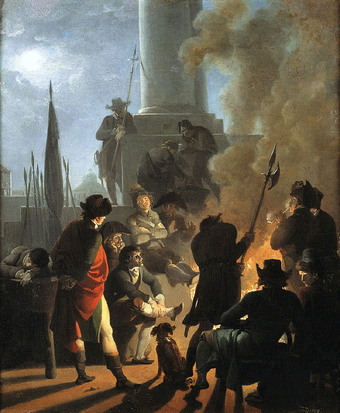
The French Revolution and the Birth of Democracy
This painting, called Le bivouac des sans-coulottes, depicts a scene from the French Revolution, which ushered in democracy in France.
15.4.2: Participatory Democracy
Participatory democracy emphasized the broad participation of constituents in the direction and operation of political systems.
Learning Objective
List the key qualities of participatory democracy and some of its historical manifestations
Key Points
- Participatory democracy tends to advocate more involved forms of citizen participation than traditional representative democracy.
- Participatory democracy strives to create opportunities for all members of a population to make meaningful contributions to decision making, and seeks to broaden the range of people who have access to such opportunities.
- In 8th and 7th century Ancient Greece, the informal distributed power structure of the villages and minor towns began to be displaced with collectives of Oligarchs seizing power as the villages and towns coalesced into city states.
- Deliberative democracy differs from traditional democratic theory in that authentic deliberation, not mere voting, is the primary source of a law’s legitimacy.
- Demarchy is a hypothetical system where government is heavily decentralized into smaller independent groups and where randomly selected decision makers have been chosen to govern, and each group is responsible for one or several functions in society.
- Deliberative democracy differs from traditional democratic theory in that authentic deliberation, not mere voting, is the primary source of a law’s legitimacy.
- Demarchy is a hypothetical system where government is heavily decentralized into smaller independent groups. Each group is responsible for one or several functions in society.
Key Terms
- deliberative democracy
-
Deliberative democracy or discursive democracy is a form of democracy in which deliberation is central to decision making. Deliberative democracy differs from traditional democratic theory in that authentic deliberation, not mere voting, is the primary source of legitimacy for the lawmaking processes.
- Demarchy
-
Demarchy (or lottocracy) is a form of government in which the state is governed by randomly selected decision makers who have been selected by sortition (lot) from a broadly inclusive pool of eligible citizens.
- Occupy movement
-
The Occupy movement is an international protest movement against social and economic inequality; its primary goal is to to make economic structure and power relations in society more fair.
Example
- In the United States, many states and local communities have tried to reinvigorate participatory democracy by introducing novel types of ballot initiatives. An initiative or proposition is begun by a group of interested citizens who gather support for a measure they would like to put to a popular vote. Usually, they must gather a certain number of signatures to show that the initiative has enough support to give it a chance in an election. If they gather enough signatures, the initiative will appear on a ballot and be put to a popular vote. Through this process, laws can be made by direct vote rather than by elected representatives in a legislature. One recent example of a ballot initiative was Proposition 8 in California in 2008, which was passed by the people and banned same-sex marriage in the state (until it was overturned by the court).
Participatory democracy is a process emphasizing the broad participation of constituents in the direction and operation of political systems. The etymological roots of democracy (Greek demos and kratos) imply that the people are in power and, thus, that all democracies are participatory. However, participatory democracy tends to advocate more involved forms of citizen participation than traditional representative democracy. Participatory democracy strives to create opportunities for all members of a population to make meaningful contributions to decision making and seeks to broaden the range of people who have access to such opportunities.
Participatory democracy has been a feature of human society since at least classical times. It is believed to have been a common practice of undeveloped people and hunter-gatherer tribes. In seventh and eighth century ancient Greece, the informal distributed power structure of the villages and minor towns began to be displaced with collectives of oligarchs seizing power as the villages and towns coalesced into city-states. A brief period where a region was governed almost totally by participatory democracy occurred during the Spanish civil war, from 1936-1938, in the parts of Spain controlled by anarchist Republicans. In the 1960s, the promotion and use of participatory democracy was a major theme for elements of the American Left. In 2011, participatory democracy became a notable feature of the Occupy movement, with Occupy camps around the world making decisions based on the outcome of working groups where every protestor gets to have his say, and by general assemblies where the decisions taken by working groups are effectively aggregated together .
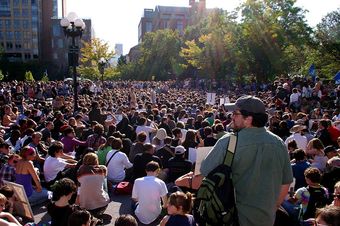
Occupy Wall Street, Washington Square Park 2011
The Occupy Wall Street General Assembly meets in Washington Square Park for the first time on Saturday, October 8.
Political variants of participatory democracy include consensus democracy, deliberative democracy, demarchy, and grassroots democracy. Deliberative democracy differs from traditional democratic theory in that authentic deliberation, not mere voting, is the primary source of a law’s legitimacy. It adopts elements of both consensus decision making and majority rule. When practiced by small groups, it is possible for decision making to be both fully participatory and deliberative. But for large political entities, the democratic reform dilemma makes it difficult for any system of decision making based on political equality to involve both deliberation and inclusive participation. Demarchy is a hypothetical system where government is heavily decentralized into smaller independent groups and where randomly selected decision makers have been chosen to govern, and each group is responsible for one or several functions in society. The system seeks to avoid problems with centralized and electoral governance, while still providing a stable democratic system.
Some scholars argue for refocusing the term on community-based activity within the domain of civil society, based on the belief that a strong non-governmental public sphere is a precondition for the emergence of a strong liberal democracy.
15.4.3: Monarchies and Liberal Democracies
Monarchies, in which sovereignty embodied in a single individual, eventually gave way to liberal democracies.
Learning Objective
Distinguish between an absolute monarchy and a constitutional monarchy
Key Points
- When the monarch has no or few legal restraints in state and political matters, it is called an absolute monarchy and is a form of autocracy.
- Monarchies are associated with political or sociocultural hereditary rule, in which monarchs rule for life (although some monarchs do not hold lifetime positions).
- An absolute monarchy refers to when the monarch has no or few legal restraints in state and political matters.
- In a constitutional monarchy, the monarch retains a unique legal and ceremonial role.
- Throughout history, monarchies have been abolished, either through revolutions, legislative reforms, coups d’état, or wars.
- Liberal democracy traces its origins—and its name—to the European 18th century, also known as the Age of Enlightenment.
Key Terms
- absolute monarchy
-
A state over which a sole monarch has absolute and unlimited power.
- constitutional monarchy
-
A monarchy in which the monarch’s power is limited by a written constitution.
- Enlightenment
-
A 17th and 18th-century philosophical movement in European history; the Age of Enlightenment or Age of Reason emphasizing rationalism.
Example
- Currently, 44 sovereign nations in the world have monarchs acting as heads of state, 16 of which are Commonwealth realms that recognize Queen Elizabeth II of England as their head of state.
A monarchy is a form of government in which sovereignty is actually or nominally embodied in a single individual, the monarch. A monarch that has few or no legal restraints in state and political matters is referred to as an absolute monarchy, a form of autocracy. Monarchies are associated with political or sociocultural hereditary rule, in which monarchs rule for life (although some monarchs do not hold lifetime positions). Throughout history, monarchies have been abolished, either through revolutions, legislative reforms, coups d’état or wars. The twentieth century saw a major escalation of this process, with many monarchies violently overthrown by revolution or war, or abolished as part of the process of decolonization. The 21st century has already seen several monarchies abolished, usually by peaceful means in a referendum.
Monarchy was the most common form of government into the 19th century, but it is no longer prevalent, at least at the national level. Where it exists, it now often takes the form of constitutional monarchy, in which the monarch retains a unique legal and ceremonial role, but exercises limited or no political power pursuant to a constitution or tradition which allocates governing authority elsewhere. Currently, 44 sovereign nations in the world have monarchs acting as heads of state—16 of those are Commonwealth realms that recognize Queen Elizabeth II as their head of state.
Liberal democracy traces its origins, and its name, to the European 18th century, also known as the Age of Enlightenment. At the time, the vast majority of European states were monarchies, with political power held either by the monarch or the aristocracy. Near the end of the 18th century, these ideas inspired the American and French Revolutions, the latter giving birth to the ideology of liberalism, and instituting forms of government that attempted to apply the principles of the Enlightenment philosophers into practice. Reforms and revolutions helped move most European countries towards liberal democracy. Liberalism ceased being a fringe opinion and joined the political mainstream.
15.4.4: The Spread of Liberal Democracy
Liberal democracy requires universal suffrage, competitive politics, and the rule of law and is currently the dominant world political ideology.
Learning Objective
Defend the notion of liberal democracy using examples from its enlightenment origins
Key Points
- Liberal democracy is a common form of representative democracy.
- According to the principles of liberal democracy, elections should be free and fair, with the presence of multiple and distinct political parties.
- The liberal democracies usually have universal suffrage, granting all adult citizens the right to vote regardless of race, gender, or property ownership.
- Liberal democracy traces its origins to the European 18th century, also known as the Age of Enlightenment.
- The Enlightenment intellectuals believed that human affairs should be guided by reason and principles of liberty and equality. They were opposed to the rule of undemocratic and illegitimate monarchies and aristocracies.
- Liberal democracies are currently the dominant form of political ideology in the modern world.
- The rule of law refers to the concept that laws should apply to those who govern as well as to the governed.
- The ideas of the Enlightenment inspired the American Revolution and the French Revolution, which gave birth to the ideology of liberalism.
- Throughout the 19th and 20th centuries, reforms and revolutions helped move most European countries towards liberal democracy.
Key Terms
- Enlightenment
-
A 17th and 18th-century philosophical movement in European history; the Age of Enlightenment or Age of Reason emphasizing rationalism.
- the rule of law
-
The rule of law is a legal maxim whereby governmental decisions are made by applying known legal principles.
- liberalism
-
Any political movement founded on the autonomy and personal freedom of the individual, progress and reform, and government by law with the consent of the governed.
Example
- The United States, Canada, France, and other Western countries are examples of liberal democracies.
Liberal democracy is a common form of representative democracy. According to the principles of liberal democracy, elections should be free and fair, with the presence of multiple and distinct political parties. Liberal democracies also usually have universal suffrage, granting all adult citizens the right to vote.
Liberal democracy traces its origins—and its name—to the European 18th century, also known as the Age of Enlightenment. At the time, the vast majority of European states were monarchies, with political power held either by the monarch or the aristocracy. The possibility of democracy had not been seriously considered in political theory since classical antiquity, and the widely held belief was that democracies would be inherently unstable and chaotic in their policies due to the changing whims of the people. It was further believed that democracy was contrary to human nature, as human beings were seen to be inherently evil, violent, and in need of a strong leader to restrain their destructive impulses.
The Enlightenment
These conventional views were first challenged by a relatively small group of Enlightenment intellectuals who believed that human affairs should be guided by reason and principles of liberty and equality. They argued that all people are created equal, and therefore political authority cannot be justified on the basis of so-called noble blood, a supposed privileged connection to God, or any other characteristic alleged to make one person superior to others. They further argued that governments exist to serve the people, not vice versa, and that laws should apply to those who govern as well as to the governed, a concept known as the rule of law.
Reform and Revolution
Near the end of the 18th century, these ideas inspired the American Revolution and the French Revolution, the pair of which gave birth to the ideology of liberalism and instituted forms of government that attempted to apply the principles of Enlightenment philosophy in practice. The dominions of the British Empire became laboratories for liberal democracy from the mid-19th century onward. In Canada, responsible government began in the 1840s and in Australia and New Zealand parliamentary government elected by male suffrage and secret ballot was established from the 1850s and female suffrage achieved from the 1890s.
Reforms and revolutions helped move most European countries towards liberal democracy. Liberalism ceased to be a fringe opinion and joined the political mainstream. The political spectrum changed; traditional monarchy became more and more a fringe view and liberal democracy became more and more mainstream. By the end of the 19th century, liberal democracy was no longer only a liberal idea, but an idea supported by many different ideologies. After World War I and especially after World War II, liberal democracy achieved a dominant position among theories of government and is now endorsed by the vast majority of the political spectrum.

Electoral Democracies
Countries highlighted in blue are designated “electoral democracies” in Freedom House’s 2010 survey Freedom in the World.
15.4.5: Democracy in the U.S.
The United States is a federal constitutional republic in which the federal government shares sovereignty with the state governments.
Learning Objective
Diagram the basic form of the United States government, focusing on its branches and electoral system
Key Points
- The executive branch is headed by the President and is independent of the legislature.
- Legislative power is vested in the two chambers of Congress, the Senate and the House of Representatives.
- The Judicial branch, which is composed of the Supreme Court and lower federal courts, exercises judicial power.
- Suffrage is nearly universal for citizens 18 years of age and older.
- On a national level, the President is elected indirectly by the people through an Electoral College.
- The modern political party system in the United States is a two-party system dominated by the Democratic Party and the Republican Party.
- Special interest groups advocate the cause of their specific constituency.
Key Terms
- legislative power
-
Legislative power refers to the power of a legislature, or deliberative assembly to pass, amend and repeal laws.
- electoral college
-
The Electoral College consists of individual state appointed electors who formally elect the President and Vice President of the United States.
- suffrage
-
The right or chance to vote, express an opinion or participate in a decision.
Example
- In the United States, suffrage is nearly universal for citizens 18 years of age and older.
The United States is a federal constitutional republic in which the President of the United States (the head of state and government), Congress, and judiciary share powers reserved to the national government, and the federal government shares sovereignty with the state governments. The executive branch is headed by the President and is independent of the legislature.
Legislative power is vested in the two chambers of Congress, the Senate and the House of Representatives. The judicial branch, composed of the Supreme Court and lower federal courts, exercises judicial power. The judiciary’s function is to interpret the United States Constitution and federal laws and regulations. This includes resolving disputes between the executive and legislative branches. The federal government’s organization is explained in the Constitution.
In the United States, suffrage is nearly universal for citizens 18 years of age and older. All states and the District of Columbia contribute to the electoral vote for president. Unlike the United Kingdom and other similar parliamentary systems that directly choose a particular political party, Americans vote for a specific candidate. Within the federal government, officials are elected at the federal (national), state and local levels. On a national level, the President is elected indirectly by the people through an Electoral College. People vote for electors who pledge, in turn, to cast their electoral votes for a particular candidate. In modern times, the electors virtually always vote with the popular vote of their state. All members of Congress and offices at the state and local levels are directly elected.
The modern political party system in the United States is a two-party system dominated by the Democratic Party and the Republican Party. These two parties have won every United States presidential election since 1852, and have controlled the United States Congress since at least 1856. Periodically, several other third parties achieve relatively minor representation at the national and state levels. Among the two major parties, the Democratic Party generally positions itself as left-of-center in American politics and supports a liberal platform, while the Republican Party generally positions itself as right-of-center and supports a conservative platform.
Special interest groups advocate the social, economic, and political causes of their specific constituencies. Business organizations will favor low corporate taxes and restrictions of the right to strike, whereas labor unions will support minimum wage legislation and protection for collective bargaining. Other private interest groups, such as churches and ethnic groups, are more concerned about broader policy issues that can impact their organizations or their beliefs. The amount of money spent by these special interests continues to grow, as campaigns become increasingly expensive. Many Americans have the feeling that these wealthy interests, whether corporations, unions, or specially organized campaign finance organizations called Political Action Committees (PACs), are so powerful that ordinary citizens can do little to counteract their influence.
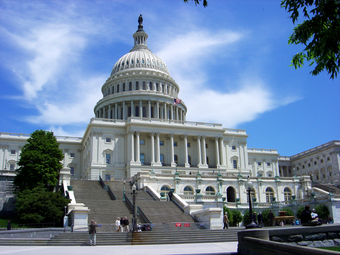
The United State Capitol Building
The United States congress meets in the Capitol.
15.4.6: The Political Participation of Women
Women’s political participation has increased due to landmark events—women’s suffrage and the election of women to public office.
Learning Objective
Break down the achievements and shortcomings of the battle for women’s rights in the U.S.
Key Points
- Women’s rights are entitlements and freedoms claimed for women and girls of all ages in many societies.
- In some places these rights are institutionalized or supported by law, local custom, and behavior, whereas in others they may be ignored or suppressed.
- Woman suffrage in the United States was achieved gradually, at state and local levels, during the 19th century and early 20th century, culminating in 1920 with the passage of the Nineteenth Amendment to the United States Constitution.
- The Nineteenth Amendment of the U.S. Constitution states that “The right of citizens of the United States to vote shall not be denied or abridged by the United States or by any State on account of sex”.
- The Equal Rights Amendment was a proposed measure that stated that “equality of rights under the law shall not be denied or abridged by the United States or any state on account of sex.” The amendment died in 1982 because not enough states had ratified it.
- While women are generally as likely to vote as men in developed countries, women are underrepresented in political positions. Women make up a very small percentage of elected officials, both at local and national levels.
Key Terms
- Equal Rights Amendment
-
The Equal Rights Amendment (ERA) was a proposed amendment to the United States Constitution designed to guarantee equal rights for women.
- Nineteenth Amendment
-
The amendment to the United States Constitution, passed in 1920, that gave women the right to vote.
- suffrage
-
The right or chance to vote, express an opinion or participate in a decision.
Examples
- Women make up a very small percentage of elected officials, both at local and national levels. In the U.S., for instance, in the 109th Congress (2005-2007) there were only 14 female Senators (out of 100) and 70 Congressional Representatives (out of 435).
- Women make up a very small percentage of elected officials, both at local and national levels. In the U.S., for instance, in the 109th Congress (2005-2007) there were only 14 female Senators (out of 100) and 70 Congressional Representatives (out of 435).
Women’s rights are entitlements and freedoms claimed for women and girls of all ages in many societies. In some places these rights are institutionalized or supported by law, local custom, and behavior, whereas in others they may be ignored or suppressed. The women’s rights movement functions in response to an inherent historical and traditional bias against the exercise of rights by women and girls in favor of men and boys.
Women’s suffrage in the United States was achieved gradually, at state and local levels, during the 19th century and early 20th century, culminating in 1920 with the passage of the Nineteenth Amendment to the United States Constitution. The amendment stated, “the right of citizens of the United States to vote shall not be denied or abridged by the United States or by any State on account of sex.” Politicians responded to the newly enlarged electorate by emphasizing issues of special interest to women—prohibition, child health, public schools, and world peace. Women responded to these issues, but in terms of general voting, they shared the same outlook and the same voting behavior as men.
In the United States, the National Organization for Women (NOW) was created in 1966 with the purpose of bringing about equality for all women. NOW was one important group that fought for the Equal Rights Amendment (ERA). This amendment stated that “equality of rights under the law shall not be denied or abridged by the United States or any state on account of sex.” But there was disagreement on how the proposed amendment would be understood. Supporters believed it would guarantee women equal treatment. But critics feared it might deny women the right be financially supported by their husbands. The amendment died in 1982 because not enough states had ratified it. ERAs have been introduced in subsequent sessions of Congress, but they have never been ratified.
While women are generally as likely to vote in developed countries, they are underrepresented in political positions. Women make up a very small percentage of elected officials, both at local and national levels. In the U.S., for instance, in the 109th Congress (2005-2007) there were only 14 female Senators (out of 100) and 70 Congressional Representatives (out of 435).

Voting Women
Women standing in line to vote in Bangladesh.
15.4.7: Theories of Democracy
Theories of democracy advocate different degrees of participation by the people with the government.
Learning Objective
Distinguish between parliamentary democracy, minimal democracy, direct democracy, radical democracy and deliberative democracy, and relate them to the concept of “true” democracy and freedom
Key Points
- Democracy, or “rule by the people,” is an egalitarian form of government in which all the citizens of a nation determine public policy, the laws, and the actions of their state together, requiring that all citizens have an equal opportunity to express their opinion.
- The most common system that is deemed “democratic” in the modern world is parliamentary democracy, in which the voting public takes part in elections and chooses politicians to represent them in a legislative assembly.
- Theoretically, Aristotle contrasted rule by the many (democracy/polity) with rule by the few (oligarchy/aristocracy) and with rule by a single person (tyranny or today autocracy/monarchy).
- Under minimalism, democracy is a system of government in which citizens give teams of political leaders the right to rule in periodic elections.
- Direct democracy holds that citizens should participate directly in making laws and policies, and not do so through their representatives.
- Deliberative democracy is based on the notion that democracy is government by discussion.
- Deliberative democracy is based on the notion that democracy is government by discussion.
- Radical democracy is based on the idea that there are hierarchical and oppressive power relations that exist in society
Key Terms
- direct democracy
-
Direct democracy (or pure democracy) is a form of government in which people vote on policy initiatives directly, as opposed to a representative democracy in which people vote for representatives who then vote on policy initiatives.
- deliberative democracy
-
Deliberative democracy or discursive democracy is a form of democracy in which deliberation is central to decision making. Deliberative democracy differs from traditional democratic theory in that authentic deliberation, not mere voting, is the primary source of legitimacy for the lawmaking processes.
- autocracy
-
A form of government in which unlimited power is held by a single individual.
- democracy
-
a system of rule by the people, especially as a form of government; either directly or through elected representatives
What Is A Democracy?
Democracy, or rule by the people, is an egalitarian form of government in which all the citizens of a nation determine public policy, the laws, and the actions of their state together. Democracy requires that all citizens have an equal opportunity to express their opinion. In practice, democracy is the extent to which a given system approximates this ideal, and a given political system is referred to as a democracy if it allows a certain approximation to ideal democracy. Although no country has ever granted all its citizens the right to vote, most countries today hold regular elections based on egalitarian principles, at least in theory.
The most common system that is deemed democratic in the modern world is parliamentary democracy, in which the voting public takes part in elections and chooses politicians to represent them in a legislative assembly. The members of the assembly then make decisions with a majority vote. A purer form is direct democracy in which the voting public makes direct decisions or participates directly in the political process. Elements of direct democracy exist on a local level and, in exceptions, on the national level in many countries, though these systems coexist with representative assemblies.
Theoretically, Aristotle contrasted rule by the many (democracy/polity) with rule by the few (oligarchy/aristocracy) and with rule by a single person (tyranny or autocracy/monarchy). He also thought that there was a good and a bad variant of each system (he considered democracy to be the degenerate counterpart to polity). For Aristotle, the underlying principle of democracy is freedom, since only in a democracy can the citizens have a share in freedom. There are two main aspects of freedom: (1) being ruled and ruling in turn, since everyone is equal according to number, not merit, and; (2) to be able to live as one pleases.
Among political theorists, there are many contending conceptions of democracy:
Minimalist Democracy
Under minimalism, democracy is a system of government in which citizens give teams of political leaders the right to rule in periodic elections. According to this minimalist conception, citizens cannot and should not rule because, for example, on most issues, most of the time, they have no clear views or their views are not well-founded.
Direct Democracy
Direct democracy, on the other hand, holds that citizens should participate directly in making laws and policies, and not do so through their representatives. Proponents of direct democracy offer varied reasons to support this view, declaring that political activity can be valuable in itself, since it socializes and educates citizens, and popular participation can check powerful elites. Most importantly, according to this theory, citizens do not really rule themselves unless they directly decide laws and policies for themselves.
Deliberative Democracy
Deliberative democracy is based on the notion that democracy is government by discussion. Deliberative democrats contend that laws and policies should be based upon reasons that all citizens can accept. The political arena should be one in which leaders and citizens make arguments, listen, and change their minds.
Radical Democracy
Radical democracy is based on the idea that there are hierarchical and oppressive power relations that exist in society. Democracy’s role is to make visible and challenge those relations by allowing for difference, dissent, and antagonisms in the decision making processes.
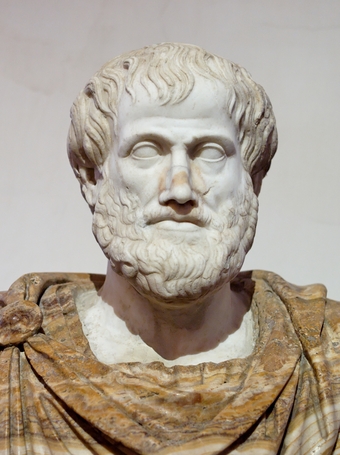
Aristotle
Aristotle was one of the first theorists of democracy.
15.4.8: Public Sphere and Civil Society
The public sphere is composed of voluntary associations that promote social capital and social cohesion while enhancing democracy.
Learning Objective
Formulate an argument which advocates for a strong civil society based on the definitions of civil society in this text
Key Points
- Civil society is the arena outside of the family, the state, and the market where people associate to advance common interests.
- Voluntary associations build social capital, trust, and shared values, which are transferred into the political sphere and help to hold society together, facilitating an understanding of the interconnectedness of society and interests within it.
- Critics argue that the public sphere can be undemocratic, noting that civil society actors have now obtained a remarkable amount of political power without anyone directly electing or appointing them.
- The public sphere is an area in social life where individuals can come together to freely discuss and identify societal problems, and through that discussion influence political action.
- The basic belief in public sphere theory is that political action is steered by the public sphere and that the only legitimate governments are those that listen to the public sphere.
- The basic belief in public sphere theory is that political action is steered by the public sphere and that the only legitimate governments are those that listen to the public sphere.
Key Terms
- Third sector
-
The voluntary sector or community sector (also non-profit sector or “not-for-profit” sector) is the sphere of social activity undertaken by organizations that are for non-profit and non-governmental. This sector is also called the third sector, in reference to the public sector and the private sector. Civic sector is another term for the sector, emphasizing the sector’s relationship to civil society.
- Public sphere
-
The public sphere is an area in social life where individuals can come together to freely discuss and identify societal problems, and through that discussion influence political action. It mediates between the private sphere and the Sphere of Public Authority.
- Sphere of Public Authority
-
The Sphere of Public Authority is that of the state, the realm of the police, and the ruling class.
Example
- In his book Bowling Alone, Robert Putnam gave the famous example of bowling leagues as a voluntary association that makes up civil society. Years ago, people used to come together in bowling leagues to bowl with their friends and compete against other leagues. These leagues brought people together outside of work and family obligations, giving them a third space for association. But over the years, bowling leagues have become less common (and, according to Putnam, so have all types of voluntary associations). Because of this, people have fewer ties to other people outside of work or home. That has decreased opportunities to engage with others, build social capital, trust, shared values, and so on. According to Putnam, this has had a deleterious effect on democracy.
Civil society is the arena outside of the family, the state, and the market where people associate to advance common interests. It is sometimes considered to include the family and the private sphere and then referred to as the third sector of society, distinct from government and business. Dictionary.com’s 21st Century Lexicon defines civil society as 1) the aggregate of non-governmental organizations and institutions that manifest interests and will of citizens, or 2) individuals and organizations in a society which are independent of the government. Sometimes the term is used in the more general sense of “the elements such as freedom of speech, an independent judiciary, etc, that make up a democratic society. “
Civil Society and Democratic Political Society
The literature on relations between civil society and democratic political society have their roots in early liberal writings like those of Alexis de Tocqueville. However, they were developed in significant ways by 20th century theorists like Gabriel Almond and Sidney Verba, who identified the role of political culture in a democratic order as vital. They argued that the political element of many voluntary organizations facilitates better awareness and a more informed citizenry, who make better voting choices, participate in politics, and hold government more accountable as a result. The statutes of these organizations have often been considered micro-constitutions because they accustom participants to the formalities of democratic decision making.
More recently, Robert D. Putnam has argued that even non-political organizations in civil society are vital for democracy. This is because they build social capital, trust, and shared values, which are transferred into the political sphere and help to hold society together, facilitating an understanding of the interconnectedness of society, and interests within it.
Others, however, have questioned how democratic civil society actually is. Some have noted that the civil society actors have now obtained a remarkable amount of political power without anyone directly electing or appointing them. It has also been argued that civil society is biased towards the global north. Partha Chatterjee has argued that, in most of the world, “civil society is demographically limited. ” For Jai Sen, civil society is a neo-colonial project driven by global elites in their own interests. Finally, other scholars have argued that, since the concept of civil society is closely related to democracy and representation, it should in turn be linked with ideas of nationality and nationalism.
The Public Sphere
The public sphere is an area in social life where individuals can come together to freely discuss and identify societal problems, and through that discussion influence political action. It is “a discursive space in which individuals and groups congregate to discuss matters of mutual interest and, where possible, to reach a common judgment. ” The public sphere can be seen as “a theater in modern societies in which political participation is enacted through the medium of talk” and “a realm of social life in which public opinion can be formed. “
The public sphere mediates between the private sphere and the Sphere of Public Authority, “The private sphere comprised civil society in the narrower sense, that is to say, the realm of commodity exchange and of social labor. ” Whereas the Sphere of Public Authority dealt with the state, or realm of the police and the ruling class, the public sphere crossed over both these realms and “through the vehicle of public opinion it put the state in touch with the needs of society. ” “This area is conceptually distinct from the state: it [is] a site for the production and circulation of discourses that can in principle be critical of the state. ” The public sphere “is also distinct from the official economy; it is not an arena of market relations but rather one of discursive relations, a theater for debating and deliberating rather than for buying and selling. ” These distinctions between “state apparatuses, economic markets, and democratic associations…are essential to democratic theory. ” The people themselves came to see the public sphere as a regulatory institution against the authority of the state. The study of the public sphere centers on the idea of participatory democracy, and how public opinion becomes political action.
The basic belief in public sphere theory is that political action is steered by the public sphere and that the only legitimate governments are those that listen to the public sphere. “Democratic governance rests on the capacity of and opportunity for citizens to engage in enlightened debate. ” Much of the debate over the public sphere involves what is the basic theoretical structure of the public sphere, how information is deliberated in the public sphere, and what influence the public sphere has over society.

Elks Lodge in Ashland, Wisconsin
Voluntary associations, such as Elks Clubs, make up the public sphere.
15.5: The U.S. Political System
15.5.1: The U.S. Political System
The United States is a representative federal democracy driven by elections in which citizens’ and lobbyists’ diverse interests compete.
Learning Objective
List three defining characteristics of the U.S. political system
Key Points
- U.S. politics are shaped by two major political parties: Democrats and Republicans.
- Citizens have competing interests that differ based on their different backgrounds—the types of jobs they have, their race or age, whether they have children, etc.
- Politics are also shaped by special interest groups, lobbyists, and the media.
Key Term
- lobbyist
-
A person remunerated to persuade (to lobby) politicians to vote in a certain way or otherwise use their office to affect a desired result.
The U.S. federal government is composed of three distinct branches—legislative, executive, and judicial—whose powers are vested by the U.S. Constitution in the Congress, the President, and the federal courts, including the Supreme Court, respectively .
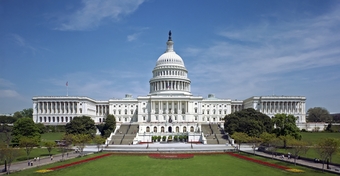
Congress
The legislative branch of the U.S. government.
The United States is a representative democracy. Citizens elect representatives to national, state, and local government; those representatives create the laws that govern U.S. society. Although nothing in U.S. law requires it, in practice, the political system is dominated by political parties. With rare exceptions, elections are decided between the two major parties: Democrats and Republicans. Although citizens vote for individual candidates, most candidates are affiliated with one part or another. Therefore, much of U.S. politics boils down to party politics.
The United States is also a diverse society, and citizens’ competing interests are reflected in politics. Citizens may have different voting preferences depending on their family backgrounds, the types of jobs they have, their race or age, whether they have children, and so on. To understand the electoral process, we must understand how different interests come into play.
Individual citizens are not the only players in U.S. politics. Although individual citizens are the only ones who can cast votes, special interest groups and lobbyists may influence elections and law-making with money and other resources. At times, this influence has grown so noticeable that some have called into question whether the U.S. is truly a democracy of the people or something more like an oligarchy of special interest groups. The media also play an important role in politics by influencing public sentiment and acting as an information filter.
15.5.2: Political Parties and Elections
Political parties seek to influence government policy by nominating select candidates to hold seats in political offices.
Learning Objective
Evaluate the party system, both in proportional representation voting systems and two-party systems
Key Points
- Parties participate in electoral campaigns and educational outreach or protest actions.
- Parties often espouse an expressed ideology or vision bolstered by a written platform with specific goals, forming a coalition among disparate interests.
- The type of electoral system is a major factor in determining the type of political party system.
- In countries that have a proportional representation voting system, three or more parties are often elected to parliament in significant proportions, and thus may have more access to public office.
- In two-party systems, two political parties dominate to such an extent that electoral success under the banner of any other party is almost impossible.
- Political parties, still called factions by some, are lobbied vigorously by organizations, businesses, and special interest groups such as trades unions.
- Multi-party systems are systems in which more than two parties are represented and elected to public office.
- Political parties, still called factions by some, are lobbied vigorously by organizations, businesses, and special interest groups such as trades unions.
Key Terms
- proportional representation
-
A voting principle aimed at securing a close match between the percentage of votes that groups of candidates (usually political parties) obtain in elections, and the percentage of seats they receive in the elected body.
- two-party system
-
A two-party system is a system where two major political parties dominate voting in nearly all elections at every level of government and, as a result, all or nearly all elected offices are members of one of the two major parties.
- faction
-
A group of people, especially within a political organization, who express a shared belief or opinion different from people who are not part of the group.
Typically, a political party is a political organization seeking to influence government policy by nominating its own select candidates to hold seats in political office, via the process of electoral campaigning. Parties often espouse an expressed ideology or vision, bolstered by a written platform with specific goals that form a coalition among disparate interests.
The type of electoral system is a major factor in determining the type of party political system. In countries with a simple plurality voting system there can be as few as two parties elected in any given jurisdiction. In countries that have a proportional representation voting system, as exists throughout Europe, or a preferential voting system, such as in Australia or Ireland, three or more parties are often elected to parliament in significant proportions, allowing more access to public office. In a nonpartisan system, no official political parties exist, sometimes due to legal restrictions on political parties. In nonpartisan elections, each candidate is eligible for office on his or her own merits. In nonpartisan legislatures, no formal party alignments within the legislature is common.
In two-party systems, such as in Jamaica and Ghana, the two political parties dominate to such an extent that electoral success under the banner of any other party is virtually impossible. Multi-party systems are systems in which more than two parties are represented and elected to public office. Australia, Canada, Pakistan, India, Ireland, the United Kingdom, and Norway are examples of countries with two strong main parties, along with smaller or “third” parties that have also obtained representation. The smaller parties may form part of a coalition government together with one of the larger parties, or act independently.
Political parties, still called factions by some, are lobbied vigorously by organizations, businesses and special interest groups such as trades unions. Money and gifts-in-kind to a party, or its leading members, may be offered as incentives. Such donations are the traditional source of funding for all right-of-center cadre parties. In the late 19th century, these parties faced opposition by the newly founded left-of-center workers’ parties, who formed a new party type—the mass membership party—and a new source of political fundraising—membership dues.

Republican Party, 1985
Ronald Reagan giving his Acceptance Speech at the Republican National Convention, Detroit, MI.
15.5.3: Voting Behavior
Voter turnout depends on socioeconomic factors such as education, income, gender, age, and race.
Learning Objective
Describe a few factors that determine voter turnout
Key Points
- Voter turnout is the percentage of eligible voters who cast a ballot in an election. “Eligible voters” are defined differently in different countries, and the term should not be confused with the total adult population.
- Socioeconomic factors significantly affect how likely individuals are to vote. The most important socioeconomic factor in voter turnout is education. The more educated a person is, the more likely he or she is to vote.
- While women are generally as likely to vote as men in developed countries, women are underrepresented in political positions.
- Age is another crucial factor determining voter turnout. Young people are much less likely to vote than are older people, and they are less likely to be politicians.
- Generally, racial and ethnic minorities are less likely to vote in elections and are underrepresented in political positions.
- Political power is also stratified through income and education. Wealthier and more educated people are more likely to vote.
Key Terms
- voter turnout
-
Voter turnout is the percentage of eligible voters who cast a ballot in an election.
- socioeconomic factors
-
Socioeconomic factors include education, income, ethnicity, race, and gender.
- racial and ethnic minorities
-
A group of people who have a different ethnicity, religion, language, or culture than that of the majority of people in the place where they live.
Voter Turnout
Voter turnout is the percentage of eligible voters who cast a ballot in an election. “Eligible voters” are defined differently in different countries, and the term should not be confused with the total adult population. After increasing for many decades, there has been a trend of decreasing voter turnout in most established democracies since the 1960s . In general, low turnout may be due to disenchantment, indifference, or contentment. Low turnout is often considered to be undesirable, and there is much debate over the factors that affect turnout and how to increase it. In spite of significant study devoted to the issue, scholars are divided on reasons for the decline. The causes of decreasing turnout have been attributed to a wide array of economic, demographic, cultural, technological, and institutional factors. There have been many efforts to increase turnout and encourage voting.
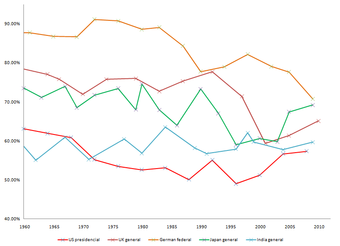
Voter turnout over time for five countries
Change in voter turnout over time for five selected countries.
In each nation, some parts of society are more likely to vote than others. In high-turnout nations, these differences tend to be limited: as turnout approaches 90 percent, it becomes difficult to find differences of much significance between voters and nonvoters. In low turnout nations, however, the differences between voters and non-voters can be quite marked. Socioeconomic factors significantly affect whether or not individuals voting tendencies. The most important socioeconomic factor in voter turnout is education. The more educated a person is, the more likely he or she is to vote, even when controlling for other factors such as income and class that are closely associated with education level .
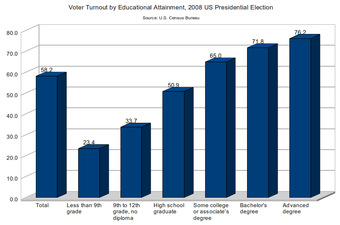
Voter Turnout by Educational Attainment –2008 Presidential Election
Educational attainment, an indicator of social class, can predict one’s level of political participation. Those with high educational attainment are more likely to vote in elections than those with little education.
Gender, Age, Ethnicity, Race, Income
There is some debate over the effects of ethnicity, race, and gender on voter turnout. While women are generally as likely as men to vote in developed countries, women are underrepresented in political positions. Women make up a very small percentage of elected officials, both at local and national levels. In the U.S., for instance, in the 109th Congress (2005-2007) there were only 14 female Senators (out of 100) and 70 Congressional Representatives (out of 435).
Age is another crucial factor determining voter turnout. Young people are much less likely to vote than are older people, and they are less likely to be politicians. The lower voting rates of young people in the U.S. help explain why things like Medicare and Social Security in the U.S. are facing looming crises: the elderly will retain many of the benefits of these programs and are unwilling to allow them to be changed even though young people will be the ones to suffer the consequences of these crises.
Generally, racial and ethnic minorities are less likely to vote in elections and are also underrepresented in political positions. If blacks were represented in proportion to their numbers in the U.S., there should be 12 Senators and 52 Members of the House. In 2009, there was 1 black Senator (Roland Burris) and 39 Members of the House. In 2010, the number in the House increased slightly to 41 (7.8 percent), but remained at just 1 percent of the Senate.
Political power is also stratified through income and education. Wealthier and more educated people are more likely to vote. Additionally, wealthier and more educated people are more likely to hold political positions. In the 2004 U.S. Presidential Election, the candidates, John Kerry, and George W. Bush, were both Yale University alumni. John Kerry was a lawyer and George W. Bush had an MBA from Harvard. Both were white, worth millions of dollars, and came from families involved in politics.
15.5.4: Lobbyists and Special Interest Groups
Lobbying describes paid activity in which special interest groups argue for specific legislation in decision-making bodies.
Learning Objective
Analyze the significance of lobbying according to its multiple instantiations
Key Points
- Lobbying in the United States describes paid activity in which special interests hire well-connected, professional advocates, often lawyers.
- Lobbying happens at every level of government, including federal, state, county, municipal, and local governments.
- A lobbyist, according to the legal sense of the word, is a professional, often a lawyer.
- Pro bono clients offer activities like fundraisers and awards ceremonies on neutral territory to meet and socialize with local legislators.
- Corporations which lobby actively tend to be few in number, large, and often sell to the government.
Key Terms
- corporations
-
Plural of corporation.
- lobbyist
-
A person remunerated to persuade (to lobby) politicians to vote in a certain way or otherwise use their office to effect a desired result.
Example
- When people think about lobbying, they often imagine corruption and poor policy results. Lobbying does not always have such deleterious effects. But sometimes it does. According to critics, lobbying can lead to poor policymaking because legislators do not consider policies based on their merits but instead based on their political repercussions. For example, food industry lobbyists and healthcare lobbyists recently clashed over the issue of school lunches. A group supported by the United States Department of Agriculture proposed healthier lunches as a way to combat childhood obesity by limiting the number of potatoes served, limiting salty foods, and adding more fresh vegetables. This group was countered by a strong food lobby backed by Coca-Cola, Del Monte, and makers of frozen pizza. The food lobbyists succeeded in blocking the proposed reforms, even writing rules suggesting that the tomato paste on a pizza qualified as a vegetable. According to critics, this case appeared to be an example where business interests won out over health concerns.
Lobbying in the United States describes paid activity in which special interests hire well-connected professional advocates, often lawyers, to argue for specific legislation in decision-making bodies such as the United States Congress. It is a highly controversial phenomenon, often seen in a negative light by journalists and the American public, and frequently misunderstood. The current pattern suggests much lobbying is done by corporations although a wide variety of coalitions representing diverse groups are possible. Lobbying happens at every level of government, including federal, state, county, municipal, and even local governments.
Lobbyists are intermediaries between client organizations and lawmakers: They explain to legislators what their organizations want, and they explain to their clients what obstacles elected officials face. Many lobbyists work in lobbying firms or law firms, some of which retain clients outside of lobbying. Others work for advocacy groups, trade associations, companies, and state and local governments. Lobbyists can also be one type of government official, such as a governor of a state, who presses officials in Washington for specific legislation.
While the bulk of lobbying happens by business and professional interests who hire paid professionals, some lobbyists represent non-profits and work pro bono for issues in which they are personally interested. Pro bono clients offer activities like fundraisers and awards ceremonies on neutral territory to meet and socialize with local legislators.
Corporations which lobby actively tend to be large corporations, few in number, and often they sell to the government. Most corporations do not hire lobbyists. One study found that the actual number of firms which do lobbying regularly is fewer than 300, and that the percent of firms engaged in lobbying was 10 percent from 1998-2006. Corporations considering lobbying run into substantial barriers to entry: Corporations have to research the relevant laws about lobbying, hire lobbying firms, and cultivate influential people and make connections. For example, when an issue regarding a change in immigration policy arose, large corporations that were currently lobbying switched focus somewhat to take account of the new regulatory world, but new corporations—even ones likely to be affected by any possible rulings on immigration—stayed out of the lobbying fray, according to the study.

The Defense Lobby
Defense contractors such as Boeing and Lockheed Martin sell extensively to the government and must, of necessity, engage in lobbying to win contracts.
15.5.5: African Americans as a Political Force
Collectively, African Americans are more involved in the American political process than other minority groups.
Learning Objective
Sketch an outline of the general African-American influence on U.S. politics from the mid 1800s to today
Key Points
- African Americans have the highest level of Congressional representation of any minority group in the U.S., though this doesn’t extend to the senate.
- Historically, African Americans were supporters of the Republican Party because it was Republican President Abraham Lincoln who granted freedom to American slaves.
- The African American trend of voting for Democrats can be traced back to the 1930s during the Great Depression, when Franklin D. Roosevelt’s New Deal program provided economic relief for African Americans.
- African Americans tend to be conservative on issues related to the family but progressive on questions of social justice and social spending. They tend to hold far more conservative opinions on abortion, extramarital sex, and raising children out of wedlock than Democrats as a whole.
Key Terms
- Republican Party
-
The Republican Party is one of the two major political parties in the United States, along with the Democratic Party. Founded by anti-slavery activists in 1854, it dominated politics nationally for most of the period 1860-1932. Currently the party’s platform generally reflects American conservatism in the U.S. political spectrum.
- Great Depression
-
A major economic collapse that lasted from 1929 to 1940 in the US and a similar period in many other countries.
- conservative
-
A person who favors maintenance of the status quo or reversion to some earlier status.
Collectively, African Americans are more involved in the American political process than other minority groups, indicated by the highest level of voter registration and participation in elections among these groups in 2004 . African Americans collectively attain higher levels of education than immigrants to the United States. African Americans also have the highest level of Congressional representation of any minority group in the U.S, though this doesn’t extend to the senate .
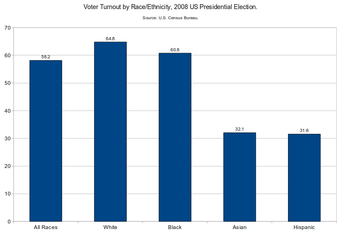
Voter Turnout by Race, 2008 Presidential Election
This is a chart illustrating voter turnout by race for the 2008 Presidential Election using data from the U.S. Census Bureau.

Senator Roland Burris
Although African Americans have high political participation rates, they are underrepresented in political office. Senator Roland Burris, of Illinois, is currently the only African American senator.
The large majority of African Americans support the Democratic Party. In the 2004 Presidential Election, Democrat John Kerry received 88 percent of the African American vote, compared to 11 percent for Republican George W. Bush. Although there is an African American lobby in foreign policy, it has not had the impact that African American organizations have had in domestic policy.
Historically, African Americans were supporters of the Republican Party because it was Republican President Abraham Lincoln who granted freedom to American slaves; at the time, the Republicans and Democrats represented the sectional interests of the North and South, respectively, rather than any specific ideology—both right and left were represented equally in both parties.
The African American trend of voting for Democrats can be traced back to the 1930s during the Great Depression, when Franklin D. Roosevelt’s New Deal program provided economic relief for African Americans. Roosevelt’s New Deal coalition turned the Democratic Party into an organization of the working class and their liberal allies, regardless of region. The African American vote became even more solidly Democratic when Democratic presidents John F. Kennedy and Lyndon B. Johnson pushed for civil rights legislation during the 1960s.
African Americans tend to hold far more conservative opinions on abortion, extramarital sex, and raising children out of wedlock than Democrats as a whole. On financial issues, they are in line with Democrats, generally supporting a more progressive tax structure to provide more services and reduce injustice and as well as more government spending on social services.
15.5.6: Hispanics as a Political Force
Hispanics have the ability to be an influential force in politics, a fact that is especially true in areas with high Hispanic populations.
Learning Objective
Explain the nuances within the so-called ”Hispanic vote”
Key Points
- The term Hispanic is used in the United States to refer to people with origins in Spanish-speaking countries, like Mexico, Cuba, Puerto Rico, and Costa Rica.
- The majority of Hispanics either identify themselves as Democrats or support the Democratic party.
- Due to the homogeneity among Hispanic voters, they have the ability to be an influential force in American politics. This is especially true in areas with high Hispanic populations, and, based on demographic predictions, will continue to be important throughout the 21st century.
- Depending on their ethnicity and background, Hispanics differ on voting trends. For example, Cuban Americans and Colombian Americans tend to favor conservative political ideologies. In contrast, Mexican Americans, Puerto Rican Americans, and Dominican Americans tend to favor liberal views.
- The Presidency of George W. Bush had a significant impact on the political leanings of Hispanics and Latinos.
- In the 2006 midterm election, however, due to the unpopularity of the Iraq War, the heated debate concerning illegal immigration, and Republican-related Congressional scandals, Hispanics and Latinos went as strongly Democratic as they have since the Clinton years.
Key Terms
- Hispanic
-
of or relating to a Spanish-speaking people or culture, as in Latin America.
- midterm election
-
an election, held every four years, to elect members of Congress; during midterm elections, the president is not elected
- Democratic Party
-
The Democratic Party is one of two major contemporary political parties in the United States, the other of which is the Republican Party.
Example
- Some political organizations associated with Hispanic and Latino Americans are LULAC, the NCLR, the United Farm Workers, the Cuban American National Foundation, and the National Institute for Latino Policy
The term Hispanic, as defined by the Office of Management and Budget, is used in the United States to identify people with origins in Spanish-speaking countries, like Mexico, Peru, Cuba, or Costa Rica.
Hispanic Party Affiliation
Depending on their location and background, Hispanics differ on their political views. While Hispanics have a diversity of views, they disproportionately identify themselves as Democratic and/or support Democratic candidates. Only 23% of Hispanics identify as Republicans. For example, in the 2010 midterm elections, in spite of general Republican victories, 60% of Hispanics voted Democratic, while only 38% voted Republican. In 2008, 67% of Hispanics supported Obama. In 2006, 69% of Hispanic voters supported Democratic candidates in congressional races, while only 30% supported Republican candidates.
Demographic Trends
Due to the homogeneity among Hispanic voters, they have the ability to be an influential force in American politics. This is especially true in areas with high Hispanic populations. Statistics indicate that the American Hispanic population is increasing and will continue to do so steadily over the ensuing decades of the 21st century . A 2012 study, conducted by the Center for Immigration Studies, projected that in November 2012, Hispanics would comprise 17.2% of the total U.S. population. The same study showed that, in the United States, Hispanics now constitute 15% of adults, 11.2% of adult citizens, and 8.9% of actual voters. In comparison, the same study showed that in 2012, non-Hispanic whites were expected to constitute 73.4% of the national vote. Non-Hispanic blacks were only expected to represent 12.2% of the national vote.
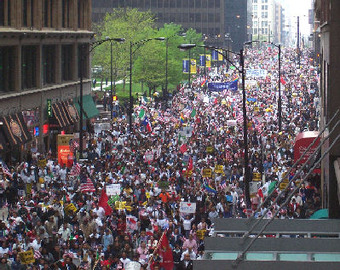
An Immigration Rally in Chicago, 2006
Immigration is an important issue for may Hispanic and Latino voters.
Political Differences in the Hispanic Community
Hispanics are often classified as a unitary voting bloc, but there are differences in political preferences within this community. For example, Cuban Americans and Colombian Americans tend to favor conservative political ideologies and to support the Republican Party. Mexican Americans, Puerto Rican Americans, and Dominican Americans, on the other hand, tend to favor liberal views and to support the Democratic party. That being said, because the latter groups are far more numerous (Mexican Americans account for 64% of Hispanics in the U.S.) the Democratic Party is considered to be in a far stronger position with Hispanics overall.
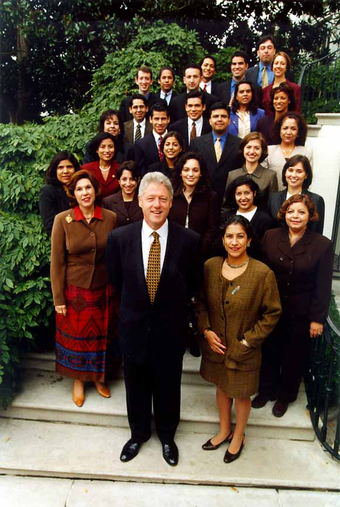
President Clinton’s Latino Appointees, 1998
Hispanics and Latinos made political gains under the Clinton Administration. This 1998 photograph shows President Bill Clinton and his Hispanic and Latino appointees.
15.5.7: The Role of the Media
Media are means of transmitting information, which is important for a democracy in which citizens must make their own informed decisions.
Learning Objective
Give a concrete example of gatekeeping that may have political consequences
Key Points
- In communications, media are the storage and transmission channels or tools used to store and deliver information or data.
- Media of the United States consist of several different types of communications media: television, radio, cinema, newspapers, magazines, and Internet-based Web sites.
- Ninety-nine percent of American households have at least one television, and the majority of households have more than one.
- A central method in which the media influences the U.S. political system is through gatekeeping, a process through which information is filtered for dissemination, be it publication, broadcasting, the Internet, or some other type of communication.
- The Internet has provided a means for newspapers and other media organizations to deliver news and, significantly, the means to look up old news. Some organizations only make limited amounts of their output available for free and charge for access to the rest.
- The U.S. has three leading weekly newsmagazines: Time, Newsweek, and U.S. News and World Report.
- The Internet has provided a means for newspapers and other media organizations to deliver news and, significantly, the means to look up old news. Some organizations only make limited amounts of their output available for free and charge for access to the rest.
Key Terms
- Gatekeeping
-
Gatekeeping is practiced by gatekeepers, people who control access to something, for example, via a city gate. In the late twentieth century, the term came into metaphorical use, referring to individuals who decide whether a given message will be distributed by a mass medium.
- media
-
In communications, media (singular medium) are the storage and transmission channels or tools used to store and deliver information or data.
Example
- Media can influence politics by what they say, but also by what they don’t say. Gatekeeping is the process through which information is filtered for dissemination, be it publication, broadcasting, the Internet, or some other type of communication. Gatekeeping occurs at all levels of the media structure, from a reporter deciding which sources are included in a story to editors deciding which stories are printed or covered, and includes media outlet owners and even advertisers. In 1950, the idea of gatekeeping was officially applied to news. David Manning White looked at the factors an editor takes into consideration when deciding which news will make the paper and which news will not. White contacted an editor, a man called Mr. Gates who was in his mid-40s and had 25 years of experience in journalism. Mr. Gates was the wire editor of a morning newspaper with a circulation of 30,000 in a mid-west city of 100,000. As it happened, he retained all copy (news stories) that he rejected from the paper. After his shift, he made notes on why each story was rejected, assuming he could still remember the reason. White wanted to know whether Mr. Gates’s decisions were objective or whether they were subjective and based on the editor’s own set of experiences, attitudes, and expectations. He found that rejections could be classified in two ways: 1) rejecting based on not being worthy of being reported or 2) rejecting based on duplicate of other reports on the same thing. These considerations fit with what we call news norms today: objective decisions about what is fit to print. However, Mr. Gates also admitted to preferring political news to other types, trying to avoid sensationalism, not liking suicide stories, and preferring stories that were more narrative and did not contain facts or figures. He also admitted that he did not like giving page space to a scandal that had been going on in the Catholic Church at the time. Thus, Mr. Gates was acting as a gatekeeper by making decisions about what sorts of news would receive space in his newspaper.
In communications, media are the storage and transmission channels or tools used to store and deliver information or data. Media are often referred to as synonymous with mass media or news media, but may refer to a single medium used to communicate any data for any purpose. Media of the United States consist of several different types of communications media: television, radio, cinema, newspapers, magazines, and Internet-based Web sites. American media conglomerates tend to be leading global players, generating large revenues, as well as large opposition in many parts of the world.
A central method in which the media influences the U.S. political system is through gatekeeping, a process through which information is filtered for dissemination, be it publication, broadcasting, the Internet, or some other type of communication. Gatekeeping occurs at all levels of the media structure, from a reporter deciding which sources are included in a story to editors deciding which stories are printed or covered, and includes media outlet owners and even advertisers. This, in turn, determines to a great extent which issues will be important to Americans and on the agendas of their elected officials.
The Internet has provided a means for newspapers and other media organizations to deliver news and, significantly, the means to look up old news. Some organizations only make limited amounts of their output available for free, and charge for access to the rest. Other organizations allow their archives to be freely browsed. It is possible that the latter type obtain more influence, as they are true to the spirit of freedom of information by virtue of making it free. Anyone who has followed external links only to be confronted with a pay-to-view banner might attest that the reputations of organizations that charge is not enhanced by their charging policy, particularly when the same information is available from sources that don’t charge.
15.5.8: The Role of Age
There is a correlation between age and political activity/organization.
Learning Objective
Explain the ways in which age can influence political participation
Key Points
- Age influences rates of political participation, and it is a determining factor in the issues people care about.
- Older people tend to be more politically active and better organized. They are seen as being more influential in politics.
- Young people are less likely to vote than older people.
- The 2008 election of President Obama illustrated that young people can be organized and mobilized. Obama’s ability to mobilize young people was seen as a crucial factor in his electoral success.
Key Terms
- AARP
-
AARP, formally the American Association of Retired Persons, is a United States-based non-governmental organization and interest group, founded in 1958 by Ethel Percy Andrus, PhD, a retired educator from California. The organization is based in Washington, D.C. According to its mission statement, it is “a nonprofit, nonpartisan membership organization for people age 50 and over … dedicated to enhancing quality of life for all as we age, [providing] a wide range of unique benefits, special products, and services for our members. “
- new media
-
Interactive digital media, such as the Internet, as opposed to traditional media such as print and television.
Example
- Older people are well organized by advocacy groups such as the AARP, which lobby on their behalf.
Age and Politics
Age is an important factor in U.S. politics because there is a correlation between age and rates of political participation and because it is a determining factor in the issues people care about.
Young people are much less likely to vote than are older people and are less likely to be politicians. The lower voting rates of young people in the U.S. help explain why things like Medicare and Social Security in the U.S. are facing looming crises—the elderly will retain many of the benefits of these programs and are unwilling to allow them to be changed even though young people will be the ones to suffer the consequences of these crises. Older people are also more organized, through organizations like the AARP, and they are more likely to vote as a block on issues that affect them directly. As a result, older individuals in the U.S. are seen as having more political power than younger people.
Mobilization According to Age
Given that there is a correlation between age and the issues relevant to those populations, some organizations have capitalized on these relationships in order to push political agendas.
Mobilizing the Elderly
The AARP, formerly the American Association of Retired Persons, is a United States-based, non-governmental organization and interest group, founded in 1958. Its mission is to improve the quality of life for retired people and people over the age of 50. On the one hand, AARP pursues its mission by providing services such as tax preparation help, discounts, and insurance for its members. On the other hand, AARP pursues its mission by mobilizing its immense resource base to lobby for policy change. AARP claims around 38 million members, making it one of the largest membership organizations in the United States. Its total revenue in 2006 was approximately $1 billion, of which $23 million was spent on lobbying. The AARP lobbies for issues that matter to older adults, such as health care and social security.
Mobilizing the Youth
Although they tend to be less organized and participate in lower numbers, young people also influence U.S. politics. Barack Obama was particularly noted for his popularity among young people. Obama’s campaign used the Internet to rally supporters and make his policies known, and the campaign’s use of the Internet targeted 18- to 29-year-olds, the age group most reliant on new media for political information. Obama’s campaign managers understood younger voters tended to ignore politicians because politicians tended to ignore issues which most concerned them. Politicians such as Obama focus on issues that are relevant to certain age groups in order to mobilize support. Obama’s ability to focus on these issues and reach out to young people is seen as one of the reasons for his success in the 2008 presidential election .

Young Obama Supporters, 2008
Barack Obama’s 2008 Presidential campaign was notable for attracting large numbers of young voters.
15.6: War and Terrorism
15.6.1: War
War is an organized, armed, and often prolonged conflict that is carried on between states, nations, or other parties.
Learning Objective
Recall three possible outcomes of a civil war
Key Points
- War entails confrontation with weapons, military technology, or equipment used by armed forces who employ military tactics and operational art within the broad categories of military strategy and military logistics.
- Warfare refers to the set of techniques used by a group to carry out war.
- Nuclear warfare is warfare in which nuclear weapons are the primary method of coercing the capitulation of the other side, as opposed to the supporting role nuclear weaponry might take in a more conventional war.
- Where evenly matched adversaries decide that the conflict has resulted in a stalemate, they may cease hostilities to avoid further loss of life and property.
- Negotiations between parties involved at the end of a war often result in a treaty.
- Some hostilities, such as insurgency or civil war, may persist for long periods of time with only a low level of military activity.
- Negotiations between parties involved at the end of a war often result in a treaty.
- Some hostilities, such as insurgency or civil war, may persist for long periods of time with only a low level of military activity.
Key Terms
- treaty
-
A binding agreement under international law concluded by subjects of international law, namely states and international organizations.
- civil war
-
A war fought between factions of the inhabitants of a single country, or the citizens of a single republic.
- insurgency
-
rebellion; revolt; the state of being insurgent
Example
- Negotiations between parties involved at the end of a war often result in a treaty, such as the Treaty of Versailles of 1919, which ended the First World War.
War is an organized, armed, and often prolonged conflict that is carried on between states, nations, or other parties typified by extreme aggression, social disruption, and usually high mortality. War should be understood as an actual, intentional, and widespread armed conflict between political communities, and it is defined as a form of political violence.
War entails confrontation with weapons, military technology, or equipment used by armed forces who employ military tactics and operational art within the broad categories of military strategy and military logistics. War studies by military theorists have sought to identify the philosophy of war and to reduce it to a military science. Conventional warfare is an attempt to reduce an opponent’s military capability through open battle. Conventional war is declared between existing states in which nuclear, biological, or chemical weapons are not used, or they only see limited deployment in support of conventional military goals and maneuvers. Nuclear warfare is warfare in which nuclear weapons are the primary method of coercing the capitulation of the other side, as opposed to the supporting role nuclear weaponry might take in a more conventional war.
The political and economic circumstances of peace following a war are highly situational—post-war political and economic realities can not be forecasted. When evenly adversaries decide that a conflict has resulted in a stalemate, they may cease hostilities to avoid further loss of life and property. They may decide to restore the pre-war territorial boundaries, redraw boundaries at the line of military control, or negotiate to keep or exchange captured territory. Negotiations between parties involved at the end of a war often result in treaties, such as the Treaty of Versailles of 1919, which ended the First World War.
Some hostilities, such as insurgency or civil war, may persist for long periods of time with a low level of military activity. In some cases a treaty is never reached, but fighting may trail off and eventually stop after the political demands of the belligerent groups have been reconciled, a political settlement has been negotiated, the combatants are gradually killed or decide the conflict is futile, or the belligerents cease active military engagement but still threaten each other.
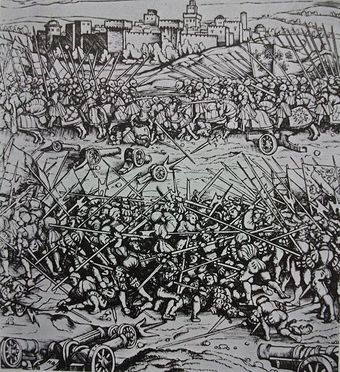
Battle of Ravena (1512)
The Battle of Ravenna, in which France defeated the Spaniards on Easter Sunday in 1512
15.6.2: Terrorism
Terrorism is an act of violence intended to create fear, which is then leveraged in order to achieve goals.
Learning Objective
Criticize an instance in history in which the term ”terrorist” or ”terrorism” has been misused to describe a religious group, government, or revolutionary action, using the definition of terrorism in this text
Key Points
- Terrorism has been practiced by a broad array of political organizations for furthering their objectives.
- An abiding characteristic of terrorism is indiscriminate use of violence against noncombatants to gain publicity for an individual, group or cause.
- The perpetrators of acts of terrorism can be individuals, groups or states.
- Religious terrorism is terrorism performed by groups or individuals, the motivation of which is typically rooted in faith-based tenets.
- The terms “terrorism” and “terrorist” (someone who engages in terrorism) carry strong negative connotations.
Key Terms
- terrorism
-
The deliberate commission of an act of violence to create an emotional response through the suffering of the victims in the furtherance of a political or social agenda.
- perpetrator
-
One who perpetrates; especially, one who commits an offense or crime.
- noncombatant
-
A non-fighting member of the armed forces
Example
- Some terrorist groups may see themselves as first and foremost fighting for liberation, a struggle so important that they argue it justifies unpalatable methods. For example, the ETA (Euskadi Ta Askatasuna) has evolved from a group promoting traditional Basque culture to a paramilitary group with the goal of gaining independence for the Greater Basque Country. ETA is the main organization of the Basque National Liberation Movement and is the most important participant in the Basque conflict. Since 1968, ETA has been held responsible for killing 829 individuals, injuring thousands, and undertaking dozens of kidnappings. The group is proscribed as a terrorist organization by Spanish, British and French authorities, the European Union as a whole, and the United States.
Terrorism is the systematic use of terror, especially as a means of coercion. Although the term lacks a universal definition, common definitions of terrorism refer to violent acts intended to create fear (terror). These acts are perpetrated for a religious, political, or ideological goal, and deliberately target or disregard the safety of non-combatants (civilians).
Terrorism has been practiced by a broad array of political organizations for furthering their objectives. It has been practiced by right-wing and left-wing political parties, nationalistic groups, religious groups, revolutionaries, and ruling governments. An abiding characteristic is the indiscriminate use of violence against noncombatants to gain publicity for a group, cause or individual. Therefore, the power of terrorism comes from its ability to leverage human fear to help achieve these goals.
Terrorists
The terms “terrorism” and “terrorist” carry strong negative connotations. These terms are often used as political labels to condemn such violence as immoral, indiscriminate, or unjustified or to condemn an entire segment of a population. However, some groups, when involved in a liberation struggle, have been called terrorists by the Western governments or media. In some liberation struggles, these same persons can become the leaders or statesman of these liberated nations . Thus, the perpetrators of terrorism can widely vary; terrorists can be individuals, groups or states. According to some definitions, clandestine or semi-clandestine state actors may also carry out terrorist acts outside the framework of a state of war.

A pro-ETA mural in Durango, Biscay
The ETA is considered a terrorist organization by most governments, but proclaims its own mission to be liberation.
Religious Terrorism
Religious terrorism is performed by groups or individuals, the motivation of which is typically rooted in faith-based tenets. Terrorist acts throughout the centuries have been performed on religious grounds with the hope to either spread or enforce a system of belief, viewpoint or opinion. Religious terrorism does not in itself necessarily define a specific religious standpoint or view, but instead usually defines an individual or group interpretation of that belief system’s teachings.

Terrorist Bomb Attack
A view of damages to the U.S. Embassy in Beirut caused by a terrorist bomb attack, April 1983
15.6.3: Peace
Peace is a state of harmony characterized by the lack of violent conflict or war.
Learning Objective
Explain the difference between principled pacifism and pragmatic pacifism, and what they share in common
Key Points
- Commonly understood as the absence of hostility, peace also suggests the existence of healthy interpersonal or international relationships, prosperity in matters of social or economic welfare, the establishment of equality, and a working political order that serves the true interests of all.
- A peace movement is a social movement seeking to achieve ideals like the ending of a particular war.
- Principled pacifism holds that at some point along the spectrum from war to interpersonal physical violence, such violence becomes morally wrong.
- Pragmatic pacifism holds that the costs of war and inter-personal violence are so substantial that better ways of resolving disputes must be found.
Key Terms
- pragmatic pacifism
-
Pragmatic pacifism holds that the costs of war and interpersonal violence are so substantial that better ways of resolving disputes must be found.
- principled pacifism
-
Principled pacifism holds that at some point along the spectrum from war to interpersonal physical violence, such violence becomes morally wrong.
- international relations
-
International relations (I.R.) is the study of relationships between countries, including the roles of states, inter-governmental organizations (IGOs), international nongovernmental organizations (INGOs), non-governmental organizations (NGOs) and multinational corporations (MNCs).
Example
- The highest honor awarded to a peace maker is the Nobel Prize in Peace, awarded since 1901 by the Norwegian Nobel Committee. It is awarded annually to internationally notable persons following the prize’s creation in the will of Alfred Nobel. Other honorary awards around the world include the Gandhi Peace Prize and the Student Peace Prize.
Peace is a state of harmony characterized by the lack of violent conflict or war. Commonly understood as the absence of hostility, peace also suggests the existence of healthy or newly healed interpersonal or international relationships, prosperity in matters of social or economic welfare, the establishment of equality, and a working political order that serves the true interests of all. In international relations, peacetime is not only the absence of war or conflict, but also the presence of cultural and economic understanding.
Peace Movements
A peace movement is a social movement seeking to achieve ideals like the ending of a particular war (or all wars), while also minimizing inter-human violence with the goal of achieving world peace. Means to achieve these ends usually include advocacy, non-violent resistance, diplomacy, boycotts, moral purchasing, supporting anti-war political candidates, demonstrations, lobbying to create legislation, and pacifism.
Pacifism
Pacifism is the opposition to war or violence as a means of settling disputes or gaining advantage. Pacifism covers a spectrum of views ranging from the belief that international disputes should be peacefully resolved. Other views of pacifism include:
- calls for abolition of the institutions of the military and war
- opposition to any organization of society through governmental force (anarchist or libertarian pacifism)
- rejection of physical violence to obtain political, economic or social goals
- opposition to violence under any circumstance, including defense of self and others
Pacifism may be based on moral principles or pragmatism. Principled pacifism holds that at some point along the spectrum from war to interpersonal physical violence, such violence becomes morally wrong. Pragmatic pacifism holds that the costs of war and inter-personal violence are so substantial that better ways of resolving disputes must be found. Pacifists in general reject theories of a “just war. “

Peace Sign
The peace sign, one of several symbols used to represent peace
Chapter 14: Religion
14.1: The Nature of Religion
14.1.1: The Nature of Religion
Religion is a collection of cultural systems, belief systems, and worldviews that relate humanity to spirituality and to moral values.
Learning Objective
Define religion and its essential features
Key Points
- The sociologist Emile Durkheim defined religion as a “unified system of beliefs and practices relative to sacred things. ” By sacred things he meant things “set apart and forbidden — beliefs and practices which unite into one single moral community called a Church, all those who adhere to them”.
- The development of religion has taken different forms in different cultures. Some religions emphasize belief while others emphasize practice. Some religions focus on subjective experience of the religious individual while others consider activities of the religious community to be most important.
- Social constructionism says that religion is a modern concept that suggests all spiritual practice and worship follows a model similar to the Abrahamic religions and thus religion, as a concept, has been applied inappropriately to non-Western cultures.
Key Terms
- sacred
-
Set apart by solemn religious ceremony; especially, in a good sense, made holy; set apart to religious use; consecrated; not profane or common; as, a sacred place; a sacred day; sacred service
- belief system
-
The basis of a set of beliefs
- hierarchy
-
Any group of objects ranked so that everyone but the topmost is subordinate to a specified group above it.
Example
- Religious services can bring the community together. Sociolgists can imply that religious rituals can spark social interactions among community members.
Religion is a collection of cultural systems, belief systems, and worldviews that relate humanity to spirituality and, sometimes, to moral values. Many religions have narratives, symbols, traditions, and sacred histories that are intended to give meaning to life or to explain the origin of life or the universe.
Many languages have words that can be translated as “religion,” but they may use them in a very different way, and some have no word for religion at all. For example, the Sanskrit word “dharma,” sometimes translated as “religion,” also means law. Throughout classical South Asia, the study of law consisted of concepts such as penance through piety and ceremonial and practical traditions. Medieval Japan at first had a similar union between “imperial law” and universal or “Buddha law,” but these later became independent sources of power.
The typical dictionary definition of religion refers to a “belief in, or the worship of, a god or gods” or the “service and worship of God or the supernatural. ” However, many writers and scholars have noted that this basic “belief in god” definition fails to capture the diversity of religious thought and experience. Edward Burnett Tylor defined religion as simply “the belief in spiritual beings. ” He argued, in 1871, that narrowing the definition to mean the belief in a supreme deity or judgment after death would exclude many peoples from the category of religious and thus “has the fault of identifying religion rather with particular developments than with the deeper motive which underlies them. ” He also argued that the belief in spiritual beings exists in all known societies.
The sociologist Emile Durkheim, in his seminal book The Elementary Forms of the Religious Life, defined religion as a “unified system of beliefs and practices relative to sacred things. ” By sacred things he meant things “set apart and forbidden — beliefs and practices which unite into one single moral community called a Church, all those who adhere to them. ” Sacred things are not, however, limited to gods or spirits. On the contrary, a sacred thing can be “a rock, a tree, a spring, a pebble, a piece of wood, a house, in a word, anything can be sacred. ” Religious beliefs, myths, dogmas, and legends are the representations that express the nature of these sacred things and the virtues and powers that are attributed to them.
The development of religion has taken different forms in different cultures. Some religions place an emphasis on belief while others emphasize practice. Some religions focus on the subjective experience of the religious individual while others consider the activities of the religious community to be most important. Some religions claim to be universal, believing their laws and cosmology to be binding for everyone, while others are intended to be practiced only by a closely-defined or localized group. In many places religion has been associated with public institutions such as education, hospitals, the family, government, and political hierarchy.
One modern academic theory of religion, social constructionism, says that religion is a modern concept that has been defined relative to the Abrahamic religions and that thus, religion as a concept has been applied inappropriately to non-Western cultures that are not based upon such systems.

Sacred Buddhist Ritual in Nepal
His Holiness Jigdal Dagchen Sakya leading the empowerment into practice at Tharlam Monastery, Boudha, Kathmandu, Nepal.
14.1.2: The Elements of Religion
A conventional social scientific view understands religion as a group’s collective beliefs and rituals relating to the supernatural.
Learning Objective
Identify the different elements that comprise religion
Key Points
- Sacred refers to collective interests within different religious practices. Profane acts include individual concerns that are not part of religious rituals.
- Emile Durkheim argues that religion is composed of the sacred elements of social life. However, many see this definition as too broad, since there are many collective interests that most do not consider religious.
- Ritual is an everyday practice that resembles symbolic meaning in different religions.
- Other social scientists view religion as any attempt to answer existential questions. Many also consider this too broad a definition.
- A third social scientific perspective views religion as the collective beliefs and rituals of a group relating to the supernatural. Though not without criticisms, this categorization most closely adheres to the traditional and popular view of what constitutes a religion.
Key Terms
- sacred
-
Set apart by solemn religious ceremony; especially, in a good sense, made holy; set apart to religious use; consecrated; not profane or common; as, a sacred place; a sacred day; sacred service
- profane
-
Not sacred or holy, unconsecrated; relating to non-religious matters, secular.
- supernatural
-
Above nature; that which is beyond or added to nature, often so considered because it is given by God or some force beyond that which humans are born with. In Roman Catholic theology, sanctifying grace is considered to be a supernatural addition to human nature.
Example
- The Torah and Bible are considered holy books and are treated with reverence and respect and are considered sacred books in their religions.
Emile Durkheim argues that religion is comprised of the sacred elements of social life. Durkheim also identifies collective interests and group unity as part of the sacred, whereas individual concerns fall into the profane category. This distinction makes sense when we think about western religious traditions where, for example, the Torah and Bible are considered holy books treated with reverence and respect. Problems quickly emerge, however, when we think about nationalism or consumerism. Under Durkheim’s distinction, both nationalism and consumerism would be considered sacred practices.
The reverence afforded to the U.S. constitution, cars, shoes and former presidents clearly constitutes the sacred and thus religious, though the vast majority of U.S. religious practitioners would disagree that they are members of multiple faith traditions. As a result, some have argued Durkheim’s distinction is not sufficiently narrow to capture the essence of religion. If we want to examine the difference between collective and individual interests, Durkheim’s distinction steers us in the right direction .

Religious Symbols
Symbols for Major Religions of the World
Other social scientists view religion as any attempt to answer existential questions, i.e. “is there life after death” and “how does the universe work and what’s my role in it.” This categorization of religion highlights its functional role as serving specific social ends. In doing so, however, this perspective also attracts criticisms for being overly encompassing. Many branches of scientific investigation, for instance, would be considered religious, and even atheism would fit into the frame of attempting to answer existential questions.
A third social scientific perspective views religion as the collective beliefs and rituals of a group relating to the supernatural. If we simply focus on beliefs relating to the supernatural, this too may be broad enough to include atheism. However, when belief and rituals of a group relating to the supernatural are coupled together, the scope seems appropriately narrowed. Though not without criticisms, this categorization most closely adheres to the traditional and popular view of what constitutes a religion .

Islamic Text
BookTauzeeh ul Masail
14.2: Types of Religions
14.2.1: Magic and Supernaturalism
Supernaturalism refers to any belief system with supernatural forces, such as magic, and, in general, is prevalent in all societies.
Learning Objective
Give examples which help distinguish between the very similar concepts of religion and magic
Key Points
- Supernatural forces are not bound to laws of nature; they work outside of them.
- Mana is a classic example of a supernatural force that imbues objects with powers of authority.
- The term religion is reserved for an organized cult with a priesthood and dedicated sites of worship or sacrifice, while magic is prevalent in all societies, regardless of whether they have organized religion or more general systems of animism or shamanism.
Key Terms
- supernaturalism
-
A belief in the doctrine of supernatural or divine agency as manifested in the world, in human events, religious revelation, miracles, etc.
- Supernatural Forces
-
The supernatural is that which is not subject to the laws of nature, or more figuratively, that which is said to exist above and beyond nature.
- mana
-
A form of supernatural energy in Polynesian religion that inheres in things or people.
Example
- In Polynesian cultures, mana is the force that allows efficacy, or the ability to have an influence in the world. Similarly for Melanesians, mana primarily inhabits objects, like charms or amulets, which confer good fortune to whoever posseses them.
Supernaturalism
Supernaturalism is perhaps the broadest classification of religious practices, encompassing any belief system dealing with supernatural forces. Supernaturalism asserts the existence of forces beyond human comprehension that frequently interfere, for better or worse, in human affairs. Most simply, the laws of nature do not bind the supernatural. These forces are considered impersonal because they are thought to come and go as they see fit, and can inhabit human and non-human objects alike. In popular culture and fiction, the supernatural is whimsically associated with the paranormal and the occult, which differs from traditional concepts in some religions, such as Catholicism, where divine miracles are considered supernatural.
The concept ‘mana’ is a classic example of a supernatural force that imbues objects with powers and authority. For example, in Polynesian cultures, mana is the force that allows efficacy, or the ability to have an influence in the world. Similarly for Melanesians, mana primarily inhabits objects, like charms or amulets, which confer good fortune to whoever possesses them (though mana can also inhabit people or animals). Mana is not inherently good or evil; its impact depends on how it is used.
Magic
In many cases, it becomes difficult or impossible to draw any meaningful line between beliefs and practices that are magical versus those that are religious. In general, The term religion is reserved for an organized cult with a priesthood and dedicated sites of worship or sacrifice, while magic is prevalent in all societies, regardless of whether they have organized religion or more general systems of animism or shamanism. Religion and magic became conceptually separated with the development of western monotheism, where the distinction arose between supernatural events sanctioned by mainstream religious doctrine (“miracles”) and mere magic rooted in folk belief or occult speculation. In pre-monotheistic religious traditions, there is no fundamental distinction between religious practice and magic; tutelary deities concerned with magic are sometimes called “hermetic deities” or “spirit guides. “

Woman floating above bed
Supernatural force allows this woman to float.
14.2.2: Animism
Animism is the belief that non-human entities are spiritual beings, either intrinsically or because spirits inhabit them.
Learning Objective
Identify some of the key elements of animism and at least one real life instantiation
Key Points
- Pantheism is the belief that everything shares the same spiritual essence—individuals do not have distinct spirits or souls. Animism puts more emphasis on the uniqueness of each individual soul.
- In animist societies, ritual is considered essential to win the favor of the spirits that ward off other malevolent spirits and provide food, shelter, and fertility.
- Shamans, also sometimes called medicine men or women, serve as mediums between the physical world and the world of spirits.
Key Terms
- shaman
-
A member of certain tribal societies who acts as a religious medium between the concrete and spirit worlds.
- animism
-
A belief that spirits inhabit some or all classes of natural objects or phenomena.
- spirits
-
The undying essence of a human. The soul.
Example
- Shinto, the traditional religion of Japan, is highly animistic. In Shinto, spirits of nature, or kami, are believed to exist everywhere. These range from the major (such as the goddess of the sun), which can be considered polytheistic, to the minor, which are more likely to be seen as a form of animism.
Animism refers to the belief that non-human entities are spiritual beings, either intrinsically or because spirits inhabit them for a period of time. Unlike supernatural forces, animist spirits may be inherently good or evil. Often, these spirits are thought to be the souls of deceased relatives, and they are not worshiped as deities.
While animists believe everything to be spiritual in nature, they do not necessarily see the spiritual nature of everything in existence as being united (monism), the way pantheists do. Animism puts more emphasis on the uniqueness of each individual soul. In pantheism, everything shares the same spiritual essence—there are no distinct spirits and/or souls. Because humans are considered a part of nature, rather than superior to, or separate from it, animists see themselves on roughly equal footing with other animals, plants, and natural forces, and subsequently have a moral imperative to treat these agents with respect.
In animist societies, ritual is considered essential to win the favor of the spirits that ward off other malevolent spirits and provide food, shelter, and fertility. Shamans, also sometimes called medicine men or women, serve as mediums between the physical world and the world of spirits.
Animism is thought to be the belief system that laid the groundwork for the notion of a soul and the animation of traditionally inanimate objects, allowing every world religion to take those basic principles in other directions. Though earlier philosophers such as Aristotle and Thomas Aquinas discussed animism, the formal definition was postulated by Sir Edward Taylor late in the 19th century. Examples of Animism can be seen in forms of Shinto, Hinduism, Buddhism, pantheism, Paganism, and Neopaganism.

Shinto Shrine
Shinto is an animistic religion in Japan.
14.2.3: Theism and Monotheism
Theism refers to any belief system that incorporates a deity.
Learning Objective
Create a short sketch in which a monotheist, a deist, a polytheist, and Emile Durkheim enter into a debate about their views on god(s)
Key Points
- Since theism is so common throughout human history, Emile Durkheim saw deities as an extension of human social life.
- Monotheistic traditions conceive of God as omniscient, omnipotent, omnipresent and active in the governance and organization of the world and universe. Judaism, Christianity and Islam are monotheistic.
- Deism holds that religious beliefs must be founded on human reason and observed features of the natural world, and that these sources reveal the existence of a supreme being as creator.
- Polytheism is the belief that multiple gods exist. Hard polytheism recognizes multiple gods as being distinct and separate beings, while soft polytheism views multiple gods as being connected under the umbrella of a greater whole.
- Panentheism is the belief that the universe is a part of a deity, but that the deity is greater than the universe.
- Polytheism is the belief that multiple gods exist, but do not intervene with the universe.
- Monolatrism refers to the belief that there may be more than one deity, but that only one is worthy of being worshiped.
Key Terms
- deity
-
A preternatural or supernatural human or non-human being or entity, or an object that possesses miraculous or supernatural attributes, powers or superpowers (e.g. a god or goddess).
- monotheism
-
The belief in a single god; especially within an organized religion.
- polytheism
-
The belief of the existence of many gods.
Example
- Christian, Islamic and Jewish religions are theisms that comprise the monotheistic tradition that believes that there is only one God in all creation.
The term theism, first introduced by Ralph Cudworth (1617-1688), derives from the Greek word theos meaning “god”. It refers to any belief system that incorporates the existence of a deity. A deity is a supernatural being thought of as holy, divine or sacred. Though they take a variety of forms, deities are often expressed as taking human form. They are usually immortal, and are commonly assumed to have personalities, consciousness and intellects comparable (albeit superior) to those of humans. Typically, deities do not reveal themselves directly to humans, but make themselves known through their effects in the world. They are thought to dwell mainly in otherworldly or holy places like Heaven, Hell, the sky, the under-world, or in a supernatural plane or celestial sphere.
Due to the ubiquity of theistic traditions, Emilee Durkheim saw the deities as an extension of human social life. In line with this reasoning, psychologist Matt Rossini contends that when humans began living in larger groups, they may have created gods as a means of enforcing morality. In small groups, morality can be enforced by social forces like gossip or reputation. However, it is much harder to enforce morality using social forces in larger groups. He indicates that by including ever watchful gods and spirits, humans discovered an effective strategy for restraining selfishness and building more cooperative groups.
When only one deity is recognized, the faith tradition is called monotheistic. Typically, monotheistic traditions conceive of God as omniscient, omnipotent, omnipresent and active in governance and organization of the world and the universe. The most prominent modern day monotheistic religions include Christianity, Islam and Judaism.
In contrast to monotheism, deism is the belief that at least one deity exists and created the world, but that the creator(s), though transcendent and supreme, does/do not alter the original plan for the universe. Deism typically rejects supernatural events (prophecies, miracles and divine revelations) prominent in organized religion. Instead, deism holds that religious beliefs must be founded on human reason and observed features of the natural world, and that these sources reveal the existence of a supreme being as creator.
Faith traditions involving more than one deity are called polytheistic. Hard polytheism recognizes multiple gods as being distinct and separate beings. Examples include the Egyptian and Greek religions, as well as certain schools of Hinduism. Soft polytheism views multiple gods as being connected under the umbrella of a greater whole. Some forms of Hinduism like Smartism/Advaita Vedanta are considered soft polytheistic traditions. Polytheism can also be subdivided according to how individual deities are regarded: Henotheism is the belief that while only one deity is worshiped other deities may exist and other people are justified in worshiping those other deities. Monolatrism refers to the belief that there may be more than one deity, but that only one is worthy of being worshiped .
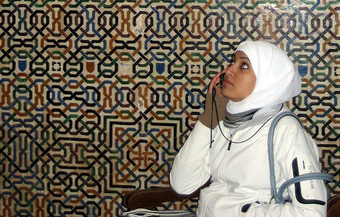
Muslim woman in tradition attire
Muslim Culture
14.2.4: The Sacred and the Profane
Emile Durkheim posited the sacred–profane dichotomy as central to all religion, but critics suggest this theory is too eurocentric.
Learning Objective
Analyze the role of the sacred–profane dichotomy in religion
Key Points
- The sacred–profane dichotomy is an idea posited by French sociologist Émile Durkheim.
- Durkheim considered the sacred–profane dichotomy to be the central characteristic of religion.
- The sacred represented the interests of the group, especially unity.
- Sacred group symbols are called totems.
- The profane involves mundane individual concerns.
- According to Durkheim, sacred/profane is not equivalent to good/evil; the sacred could be good or evil, and the profane could be either as well.
- Durkheim’s claim of the universality of the sacred–profane dichotomy has come under criticism as too centered on European thought.
Key Term
- profane
-
Not sacred or holy, unconsecrated; relating to non-religious matters, secular.
The sacred–profane dichotomy is an idea posited by French sociologist Émile Durkheim, who considered it to be the central characteristic of religion: “religion is a unified system of beliefs and practices relative to sacred things, that is to say, things set apart and forbidden.” In Durkheim’s theory, the sacred represented the interests of the group, especially unity, which were embodied in sacred group symbols, or totems. The profane, on the other hand, involved mundane individual concerns. Durkheim explicitly stated that the sacred/profane dichotomy was not equivalent to good/evil. The sacred could be good or evil, and the profane could be either as well.
Durkheim’s claim of the universality of this dichotomy for all religions/cults has been criticized by scholars such as British anthropologist Jack Goody. Goody also noted that “many societies have no words that translate as sacred or profane and that ultimately, just like the distinction between natural and supernatural, it was very much a product of European religious thought rather than a universally applicable criterion.”
14.3: The Functionalist Perspective on Religion
14.3.1: Functions of Religion
The functionalist perspective, which originates from Emile Durkheim’s work on religion, highlights the social role of religion.
Learning Objective
Explain how functionalists view the purpose of religion in society
Key Points
- The positivist tradition encourages the study of society using dispassionate and scientific methods.
- Emile Durkheim argued that religion provides social cohesion and social control to maintain society in social solidarity.
- Collective consciousness, which is the fusion of all of our individual consciousnesses, creates a reality of its own.
- Critics of the functionalist approach point out that religion can be dysfunctional. For example, religion may incite violence by a fundamentalist religious group.
Key Terms
- social control
-
any control, either formal or informal, that is exerted by a group, especially by one’s peers
- social cohesion
-
The bonds or “glue” that maintain stability in society.
Example
- Durkheim noted that religion provides a worldview for complex modern societies in order to maintain social order and solidarity.
Functions of Religion
The structural-functional approach to religion has its roots in Emile Durkheim’s work on religion. Durkheim argued that religion is, in a sense, the celebration and even (self-) worship of human society. Given this approach, Durkheim proposed that religion has three major functions in society: it provides social cohesion to help maintain social solidarity through shared rituals and beliefs, social control to enforce religious-based morals and norms to help maintain conformity and control in society, and it offers meaning and purpose to answer any existential questions. Further, Durkheim placed himself in the positivist tradition, meaning that he thought of his study of society as dispassionate and scientific. He was deeply interested in the problem of what held complex modern societies together. Religion, he argued, was an expression of social cohesion.
Religion, for Durkheim, is not imaginary, although he does deprive it of what many believers find essential. Religion is very real; it is an expression of society itself, and indeed, there is no society that does not have religion. We perceive as individuals a force greater than ourselves and give that perception a supernatural face. We then express ourselves religiously in groups, which for Durkheim makes the symbolic power greater. Religion is an expression of our collective consciousness, which is the fusion of all of our individual consciousness, which then creates a reality of its own.
It follows, then, that less complex societies, such as the Australian Aborigines, have less complex religious systems, involving totems associated with particular clans. The more complex a particular society is, the more complex the religious system. As societies come in contact with other societies, there is a tendency for religious systems to emphasize universalism to a greater and greater extent. However, as the division of labor makes the individual seem more important, religious systems increasingly focus on individual salvation and conscience.
The primary criticism of the structural-functional approach to religion is that it overlooks religion’s dysfunctions. For instance, religion can be used to justify terrorism and violence. Religion has often been the justification of, and motivation for, war. In one sense, this still fits the structural-functional approach as it provides social cohesion among the members of one party in a conflict. For instance, the social cohesion among the members of a terrorist group is high, but in a broader sense, religion is obviously resulting in conflict without questioning its actions against other members of society.

Catholic Church Gathering for Mass
Congregation Gathering Service for the Virgin Mary
14.3.2: Religion and Social Support
According to many social science studies, psychological well-being is positively correlated with religious engagement.
Learning Objective
Discuss the relationship between religion and social and individual well-being
Key Points
- Many studies suggest that religious people are happier and less stressed than their non-religious counterparts.
- The Legatum Prosperity Index reflects the research that there is a positive link between religious engagement and well-being.
- Religiosity has a salutary relationship with psychological adjustment, because it is related to less psychological distress, more life satisfaction, and better self-actualization.
Key Terms
- religiosity
-
An index of how strongly religious a person is
- self-actualization
-
Self-actualization is a term that has been used in various psychology theories, often in slightly different ways. The term was originally introduced by the organismic theorist Kurt Goldstein for the motive to realize one’s full potential. However, the concept was brought most fully to prominence in Abraham Maslow’s hierarchy of needs theory, in which “self-actualization” was the final level of psychological development that can be achieved when all basic and mental needs are fulfilled. In such a case, the “actualization” of full personal potential takes place.
- well-being
-
a state of health, happiness and/or prosperity
Example
- Surveys by Gallup, the National Opinion Research Center, and the Pew Organization conclude that spiritually committed people are twice as likely to report being “very happy” than the least religiously committed people. Therefore, some social scientists argue that religion provides a method for social support that leads to happiness.
Religion and Health
There is now extensive research suggesting that religious people are happier and less stressed than their non-religious counterparts. Social scientists have identified a number of mechanisms that might explain why religion might make an individual happier, none of which rest on the explanation of divine intervention or supernatural phenomenon. Certain features of religious practice may facilitate greater well-being for members. These include the following:
- basic social contact
- a large, non-family network of social support
- the positive mental health one derived from optimism and volunteering,
- coping strategies to enhance one’s ability to deal with stress
- a worldview that prevents existential questions from arising
Scientific Studies of Religion and Health
The Legatum Prosperity Index reflects the research that suggests that there is a positive link between religious engagement and well-being. People who report that God is very important in their lives are on average more satisfied with their lives, after accounting for their income, age and other individual characteristics that might bias results. A 1993 study by Kosmin & Lachman indicated that people without a religious affiliation appeared to be at greater risk for depressive symptoms than individuals affiliated with a religion. Surveys by Gallup, the National Opinion Research Center and the Pew Organization conclude that spiritually committed people are twice as likely to report being “very happy” than the least religiously committed people. An analysis of over 200 studies contends that high religiousness predicts a lower risk of depression, a lower risk of drug abuse, fewer suicide attempts. Those same studies associate religious involvement with reports of higher satisfaction with sex life and a sense of well-being. A review of 498 peer-review academic studies revealed that a large majority of them showed a positive correlation between religious commitment and higher levels of perceived well-being of self-esteem. These same studies revealed a positive correlation between religious involvement and lower levels of hypertension, depression, and clinical delinquency. A meta-analysis of 34 recent studies published between 1990 and 2001 found that religiosity has a salutary relationship with psychological adjustment. Religious involvement was related to less psychological distress, more life satisfaction, and better self-actualization. Finally, as signaled in a recent review of 850 research papers, the majority of well-conducted studies suggest that higher levels of religious involvement are positively associated with indicators of psychological well-being (life satisfaction, happiness, positive affect, and higher morale). In these studies, religious involvement was associated with less depression, fewer suicidal thoughts, and less drug alcohol abuse.
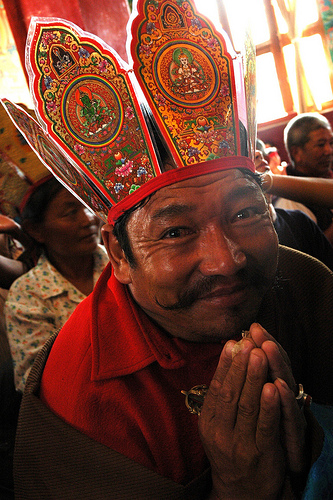
Tharlam Monastery of Tibetan Buddhism
An apparently happy man wears the 5 Dhyani Buddhas Crown and holds a Flower and Dorje (vajra).
14.4: The Conflict Perspective on Religion
14.4.1: Marx and the “Opiate of the Masses”
Karl Marx argues that religion works to calm uncertainty over our role in the universe and in society, and to maintain the status quo.
Learning Objective
Give an example which either supports or contradicts Marx’s idea that ”religion is the opium of the people”
Key Points
- One of the most frequently paraphrased statements of Karl Marx is, religion is the opium of the people.
- Karl Marx argues that religion plays a significant role in maintaining the status quo by promising rewards in the after-life rather than in this life.
- Social inequalities result from the differences inherent in class structures, such as the inequality between the proletariat and the bourgeoisie.
Key Terms
- proletariat
-
the working class or lower class
- status quo
-
the current state of things; the way things are, as opposed to the way they could be; the existing state of affairs.
- bourgeoisie
-
The capitalist class.
Example
- Marx’s view of capitalism saw rich capitalists getting richer and their workers getting poorer. Not only were workers being exploited, but in the process they were being further detached from the products they helped create. From this objectification comes alienation. The common worker is led to believe that he or she is a replaceable tool, and is alienated to the point of extreme discontent. Here, in Marx’s eyes, religion enters. Capitalism utilizes our tendency towards religion as a tool or ideological state apparatus to justify this alienation.
One of the most frequently paraphrased statements of Karl Marx is, religion is the opium of the people. It was translated from the German original, “Die Religion … ist das Opium des Volkes,” and is often referred to as “religion is the opiate of the masses. ” Taken in context, Marx is arguing that religion was constructed by people to calm uncertainty over our role in the universe and in society .

Religion as opium of the people
Abolition of Religion as the Illusory Happiness of the People.
Early social theorists offered explanations and analysis of religion in terms of the function of religion in society, the role of religion in the life of the individual, and the nature (and origin) of religion. With ‘the social-conflict approach,’ Karl Marx argues that religion plays a significant role in maintaining the status quo. Marx argues that religion accomplishes this by promising rewards in the after-life rather than in this life. By focusing attention on otherworldly rewards, religion pacifies members by providing a worldview that deflects attention that would otherwise be directed at the inequalities of this world.
Marx’s approach to sociology was critical in the sense that, in contrast to the knowledge for knowledge’s sake approach, it advocated change. Criticism of the system in place when he was writing was inherent in Marx’s approach; because of this, he took a particular stand on the existence of religion, namely, that it should be done away with. His efforts were, in his mind, based solely on what can be called applied science. Marx saw himself as doing sociology and economic theory for the sake of human development. As Christiano states, “Marx did not believe in science for science’s sake…he believed that he was also advancing a theory that would be a useful tool in effecting a revolutionary upheaval of the capitalist system in favor of socialism” (2008, 124). As such, the crux of his arguments was that humans are best guided by reason. Religion, Marx held, was a significant hindrance to reason, inherently masking the truth and misguiding followers. Marx viewed social alienation as the heart of social inequality . The antithesis to this alienation is freedom. Thus, to propagate freedom means to present individuals with the truth and give them a choice to accept or deny it. In this, “Marx never suggested that religion ought to be prohibited” (Christiano 2008, 126).
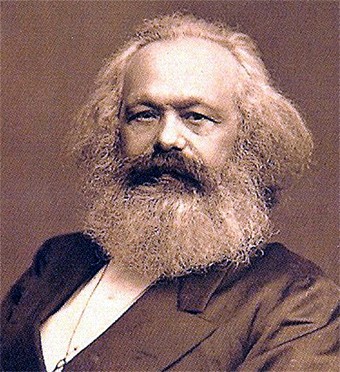
Karl Marx
Religion, Marx held, was a significant hindrance to reason, inherently masking the truth and misguiding followers.
14.4.2: Religion and Social Control
Marx viewed religion as a tool of social control used by the bourgeoisie to keep the proletariat content with an unequal status quo.
Learning Objective
Evaluate Karl Marx’s critical approach to religion
Key Points
- The social-conflict approach to religion highlights how religion, as a phenomenon of human behavior, maintains social inequality by advancing a worldview that justifies oppression.
- Karl Marx’s critical approach demanded that action be taken to resolve social inequalities. This was in stark contrast to his scholarly peers, many of whom pursued scholarship for the sake of knowledge, and did not attach to these academic projects overt political goals.
- Karl Marx viewed religion as a social control used to maintain the status quo in a given society.
Key Term
- status quo
-
the current state of things; the way things are, as opposed to the way they could be; the existing state of affairs.
Example
- Many types of people, whether they be Catholic, Muslim, or Jewish, are expected to follow their family’s religion as a social norm. From a Marxist perspective, these expectations become part of religion’s ability to control society and maintain the status quo.
Marxist Theory of Religion
The social-conflict approach is rooted in Karl Marx’s critique of capitalism. According to Marx, in a capitalist society, religion plays a critical role in maintaining an unequal status quo, in which certain groups of people have radically more resources and power than other groups of people. Marx argued that the bourgeoise used religion as a tool to keep the less powerful proletariat pacified. Marx argued that religion was able to do this by promising rewards in the after-life, instead of in this life. It was in this sense that Marx asserted the following. “Religion is the sigh of the oppressed creature, the feeling of a heartless world, and the soul of soulless circumstances. It is the opium of the people…The abolition of religion as the illusory happiness of the people is the demand for their real happiness” (p.72). In this passage, Marx is calling for the proletariat to discard religion and its deceit about other-worldly events. Only then would this class of people be able to rise up against the bourgeoisie and gain control of the means of production, and only then would they achieve real rewards, in this life. Thus, the social-conflict approach to religion highlights how religion, as a phenomenon of human behavior, functions to maintain social inequality by providing a worldview that justifies oppression.
It should be reiterated here that Marx’s approach to sociology was critical in the sense that it advocated for change in the world. This is in stark contrast to other scholars, many of whom pursue knowledge for knowledge’s sake, and lack overt political aims. Because Marx was committed to criticizing the prevailing organization of society during his time, he took a particularly aggressive stance towards religion. He believed that it was a tool of social control used to maintain an unequal status quo, and that it should be abolished.
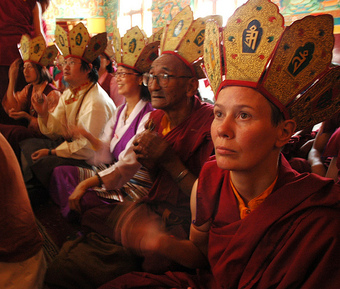
Religious Buddhist Gathering in Tibetan Monastery
Tharlam Monastery of Tibetan Buddhism
14.5: The Symbolic-Interactionist Perspective on Religion
14.5.1: Religious Symbols
Religious symbolism is the use of acts, artwork, and events to create a mythos expressing the teachings of the religion.
Learning Objective
Discuss the use of religious symbols as means of representing the ideals and values of a particular religion
Key Points
- Christianity has borrowed from the common stock of significant symbols known to most periods and to all regions of the world.
- Universalism refers to religious, theological and philosophical concepts with universal application or applicability.
- Comparative religion is the systematic comparison of the doctrines and practices of the world’s religions.
Key Terms
- comparative religion
-
Comparative religion compares the doctrines and practices of the worlds religions.
- Universalism
-
The theological belief that all souls can attain salvation.
Example
- The Star of David is a Jewish religious symbol that represents Judaism.
Religious symbolism is the use by a religion of symbols including archetypes, acts, artwork, events, or natural phenomena. Religions view religious texts, rituals and works of art as symbols of compelling ideas or ideals. Symbols help create a resonant mythos expressing the moral values of the society or the teachings of the religion, foster solidarity among adherents, and bring adherents closer to their object of worship.
The symbolism of the early Church was characterized as being understood by initiates only. After the legalization of Christianity in the 4th-century, more recognizable symbols were put in use. Christianity has borrowed from the common stock of significant symbols known to most periods and to all regions of the world.
The study of religious symbolism is either universalist, a component of comparative religion and mythology, or seen in a localized scope within the confines of a religion’s limits and boundaries. Universalism refers to religious, theological and philosophical concepts with universal application or applicability. Religion in this context is defined as a set of beliefs concerning the cause, nature and purpose of the universe. This is especially true when religion is considered the creation of a superhuman agency or agencies, usually involving devotional and ritual observances containing a moral code governing the conduct of human affairs.
Comparative religion concerns the systematic comparison of the world’s religions. There are many benefits to such a course of inquiry, but in general the comparative study of religion yields a deeper understanding of the fundamental philosophical concerns of religion, including ethics, metaphysics and the nature and form of salvation.
Religious symbolism is effective when it appeals to both the intellect and the emotions. The choice of suitable acts and objects is narrow enough that it would not be easy to avoid the appearance of an imitation of other traditions, even if there had been a deliberate attempt to invent an entirely new ritual.

Hindu Symbol
Aum Hindu symbol
14.5.2: Rituals
A ritual is a set of actions performed mainly for their symbolic value, that may be prescribed by the traditions of a community.
Learning Objective
Identify the types of and purposes of rituals in various contexts of society, such as religion or politics
Key Points
- The term ritual usually refers to actions which are stylized, while excluding actions which are arbitrarily chosen by the performers.
- In religion, a ritual can comprise the prescribed outward forms observation within a religion or religious denomination.
- The purposes of rituals are varied and may include fulfillment of religious obligations or ideals, satisfaction of spiritual or emotional needs of the practitioners, strengthening of social bonds, social and moral education, etc.
- The social function of rituals has often been exploited for political ends. Alongside the personal dimensions of worship and reverence, rituals can have a more basic social functions in expressing, fixing, and reinforcing the shared values and beliefs of a society.
- Many animal species use ritualized actions to court or to greet each other or to fight.
Key Terms
- social function
-
Rituals may serve a social function in that they express, fix, and reinforce the shared values and beliefs of a society.
- ritual
-
Rite; a repeated set of actions
Example
- Catholic Sunday mass is a type of religious ritual that represents the religious culture of Catholicism and enacts theological doctrinal beliefs.
Rituals
A ritual is a set of actions performed mainly for their symbolic value. It may be prescribed by the traditions of a community, including by a religious community. The term usually refers to actions which are stylized, and usually excludes actions which are arbitrarily chosen by the performers. The purposes of rituals are varied. Rituals can fulfill religious obligations or ideals, satisfy spiritual or emotional needs of the practitioners, strengthen of social bonds, provide social and moral education, demonstrate of respect or submission, allow one to state one’s affiliation, obtain social acceptance or approval for some event—or rituals are sometimes performed just for the pleasure of the ritual itself.
Rituals of various kinds are a feature of almost all known human societies, past or present. They include not only the various worship rites and sacraments of organized religions and cults, but also the rites of passage of certain societies, atonement and purification rites, oaths of allegiance, dedication ceremonies, coronations and presidential inaugurations, marriages and funerals, school “rush” traditions and graduations, club meetings, sports events, Halloween parties, veterans parades, Christmas shopping and more.
In religion, a ritual can comprise the prescribed outward forms of observation within a religion or religious denomination. Although ritual is often used in conjunction with worship performed in a church, the actual relationship between any religion’s doctrine and its ritual(s) can vary considerably from organized religion to non-institutionalized spirituality.
Social Uses of Ritual
The social function of rituals has often been exploited for political ends. Alongside the personal dimensions of worship and reverence, rituals can have social functions that express, fix and reinforce the shared values and beliefs of a society. Rituals can help create a firm sense of group identity. Humans have used rituals to create social bonds and even to nourish interpersonal relationships. For example, nearly all fraternities and sororities have rituals incorporated into their structure, from elaborate and sometimes secret initiation rites, to the formalized structures used to convene a meeting. Thus, numerous aspects of ritual and ritualistic proceedings are ingrained into the workings of those societies.
Ritual actions are not only characteristic of human cultures; animal rituals exist as well. Many animal species use ritualized actions to court or to greet each other, or to fight. At least some ritualized actions have very strong selective purpose in animals. For example, ritualized fights often help avoid or limit strong physical violence between conflicting animals.

Devotees tie red crimson threads on making a wish fulfilled.
The temple dedicated to Mata Chintpurni Devi is located in District Una of Himachal Pradesh.
14.5.3: Beliefs
Religious belief is a strong belief in a supernatural power or powers that control human destiny.
Learning Objective
Examine the complexity of belief and the categories of belief within society
Key Points
- Religious adherents often distinguish religious belief from superstition. The term superstition refers to what are seen as excessive or false religious behaviors as opposed to proper or accepted religious standards.
- People with pluralist beliefs make no distinction between faith systems, viewing each one as valid within a particular culture.
- People with syncretistic views blend the views of a variety of different religions or traditional beliefs into a unique fusion which suits their particular experience and context.
- People with exclusivist beliefs typically explain other religions as either in error, or as corruptions or counterfeits of the true faith. In monotheistic faiths, references to God are used in constructs such as “God’s Chosen People”.
- People with inclusivist beliefs recognize some truth in all faith systems, highlighting agreements and minimizing differences, but see their own faith as in some way ultimate.
Key Terms
- pluralist beliefs
-
Religious pluralism is an attitude or policy regarding the diversity of religious belief systems co-existing in society.
- superstition
-
A belief, not based on human reason or scientific knowledge, that future events may be influenced by one’s behaviour in some magical or mystical way.
- supernatural power
-
The supernatural is that which is not subject to the laws of nature, or more figuratively, that which is said to exist above and beyond nature.
Example
- A hijab symbolizes a type of Islamic religious belief of a muslim woman in her faith.
Belief
Religious belief is a strong belief in a supernatural power or powers that control human destiny. Such a state may relate to the existence, characteristics, and worship of a deity or deities; divine intervention in the universe and human life; or values and practices centered on the teachings of a spiritual leader. In contrast to other belief systems, religious beliefs are usually codified.
Belief and Superstition: a Matter of Perspective
Religious adherents often distinguish their own religious beliefs from superstition. Both superstition and many traditional religions are non-materialistic, do not see the world as being subject to laws of cause and effect, and presume that there are immaterial forces influencing our lives. Both religion and superstition seek meaning in otherwise random and chaotic events. However, the term “superstition” refers to what the speaker sees as excessive or false religious behavior as opposed to belief or behavior within a proper or accepted religious standard.
Categories of Belief
People with pluralist beliefs make no distinction between faith systems, viewing each one as valid within a particular culture. People with syncretistic views blend the views of a variety of different religions or traditional beliefs into a unique fusion which suits their particular experience and context. Adherents of particular religions deal with the differing doctrines and practices espoused by other religions in a variety ways.
People with exclusivist beliefs typically explain other religions as either in error, or as corruptions or counterfeits of the true faith. Throughout history, various groups of people have considered themselves as chosen by a deity for a purpose, such as to act as the deity’s agent on earth. In monotheistic faiths, like Abrahamic religions, references to God are often used in constructs such as “God’s Chosen People. ” By contrast, people with inclusivist beliefs recognize some truth in all faith systems, highlighting agreements and minimizing differences, but often see their own faith as in some way ultimate.

Praying Hands
Praying is an act of belief in many religious faiths.
14.5.4: Religious Experience
A religious experience is usually an uncommon occurrence in which an individual encounters what he or she considers to be the divine.
Learning Objective
Identify the different types of religious experiences a person can have and the impact of each for the person
Key Points
- The German thinker Rudolf Otto argued that all religious experiences are “numinous” experiences. For Otto, this meant that they invoked the mysterium tremendum, which is the tendency to invoke fear and trembling, and the mysterium fascinas, which is the tendency to attract, fascinate, and compel.
- In ecstasy, the believer is understood to have a soul or spirit which can leave the body.
- In enthusiasm, God is understood to be outside, other than, or beyond the believer. In such a belief system, this outer deity is believed to occasionally inhabit and possess the bodies of people. Those who are possessed in this way are often called mediums.
- In the mystical experience, all otherness disappears and the believer becomes one with the transcendent. The believer discovers that he or she is not distinct from other objects, other people, the cosmos, the deity, but part of an interconnected whole.
- The term spiritual awakening can refer to any of a wide range of experiences, including being born again, having a near-death experience, or achieving mystical liberation or enlightenment.
Key Terms
- numinous experiences
-
Numinous is is an English adjective describing the power or presence of a divinity. The numinous experience has both a quality of tremendum, which is the tendency to invoke fear and trembling, and a quality of fascinans, the tendency to attract, fascinate and compel. The numinous experience also has a personal quality to it, in that the person feels to be in communion with a wholly other. The numinous experience can lead in different cases to belief in deities, the supernatural, the sacred, the holy, and/or the transcendent.
- ecstasy
-
a trance, frenzy, or rapture associated with mystic or prophetic exaltation
- mystical experience
-
In the mystical experience, all otherness’disappears and the believer becomes one with the transcendent. The believer discovers that he or she is not distinct from the cosmos, the deity, or the other reality, but one with all of these, as part of an interconnected whole.
Example
- Meditation, a type of religious experience, is used to reach mental purification in Buddhism.
Studying Religious Experience
Religious experience is the subjective experience in which an individual reports that he or she has either contacted a transcendent reality, or encountered, in some fashion, the divine. A religious experience is usually uncommon, because it rarely involves everyday activities and life experiences, and because it is enmeshed with a particular individual’s perception of the divine. Studying religious experience objectively is a difficult task, because it is entirely a subjective phenomenon. Definitions of what exactly is divine, and what is not, might differ from person to person. However, scholars have identified certain features that seem to be either common or patterned among many religious experiences. This has allowed them to study religious experience objectively.
Numinous Experience
Rudolf Otto, a German thinker, attempted to theorize a single term that could explain the structure of all religious experience independent of cultural background. In his book, The Idea of the Holy, he identified this and called it the “numinous” experience. For an experience to be numinous, in Otto’s opinion, it needed to involve two things. First, it had to include the mysterium tremendum, which is the tendency to invoke fear and trembling. Secondly, it had to include the mysterium fascinas, which is the tendency to attract, fascinate or compel. According to Otto, a numinous experience also has a personal quality to it, because individuals typically feel that they are opening some unique communication chain with the divine.
Communicating with the Divine
Communication with the divine can express itself in two ways, the first of which relates to ectsasy, the second to enthusiasm. In ecstasy, believers are understood to have a soul or spirit which can leave the body. Characteristic of the shaman, the goal of this type of experience is to leave one’s body and experience transcendental realities. In enthusiasm, on the other hand, God is understood to be outside, other than, or beyond the believer. In this type of experience, a sacred power is believed to enter people occasionally, and gain possession of their bodies. A person capable of being possessed is sometimes called a medium.
Mystical Experience
Mystical experiences are in many ways the opposite of numinous experiences. In mystical experiences, all ‘otherness’ disappears, and the believer recognizes that they are one with the transcendent. The believer discovers that he or she is not distinct from other objects, the cosmos, the deity, or other realities, but part of a grand interconnected whole. This type of experience often comes into tension with institutional religion. Conventional religions, by definition, have strong institutional structures, including formal hierarchies and mandated sacred texts and/or creeds. Adherents of these institutional faiths are expected to respect or follow these mandates closely, all of which rely on demarcations and rigid hierarchies. Because mysticism emphasizes radical unity, which is the opposite of hierarchy, it is often deprecated or persecuted by members of these institutional faiths.
Spiritual Awakening
A spiritual awakening usually involves a person realizing, or becoming aware of, a sacred dimension of reality. While this may or may not be considered a religious experience, a spiritual awakening often has lasting effects upon an individual’s life. The term “spiritual awakening” can refer to a wide range of experiences, including being born again, having a near-death experience, or achieving mystical liberation or enlightenment.
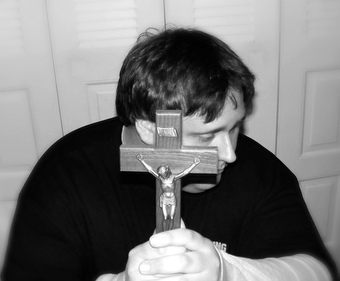
Catholic Religious Experience
Religious experience in Catholicism is accomplished by praying to Catholic religious symbols.
14.6: Religious Organizations
14.6.1: Cult
Cult refers to a religious movement or group whose beliefs or practices are considered abnormal or bizarre.
Learning Objective
Differentiate cults from sects, according to sociologists
Key Points
- In the 1930s, cults became the object of sociological study in the context of the study of religious behavior.
- American sociologist Howard P. Becker created four categories by splitting church into “ecclesia” and “denomination,” and sect into “sect” and “cult”.
- Cults, for Becker, were small religious groups lacking in organization and emphasizing the private nature of personal beliefs. Unlike sects, which are products of religious schism that maintain continuity with traditional beliefs, cults arise spontaneously around novel beliefs and practices.
- Those critical of cults share the assumption that some form of coercive persuasion or mind control is used by cult leaders to recruit and maintain members.
Key Terms
- apostate
-
A person who has renounced a religion or faith.
- ecclesia
-
The congregation, the group of believers, symbolic body or building.
- denomination
-
A class, or society of individuals, called by the same name; a sect; as, a denomination of Christians.
Example
- The Christian counter-cult movement is a social movement of Christian ministries and individual Christian counter-cult activists who oppose religious sects thought to either partially or entirely fail to abide by the teachings of the Bible. These religious sects are also known among Christians as cults or discernment ministries.
The word “cult” in current popular usage usually refers to a new religious movement or other group whose beliefs or practices are considered abnormal or bizarre. Originally denoting a system of ritual practices, the word was introduced into sociological classification in 1932 by American sociologist Howard P. Becker. In the 1930s, cults became the object of sociological study in the context of the study of religious behavior. They have been criticized by mainstream Christians for their unorthodox beliefs.
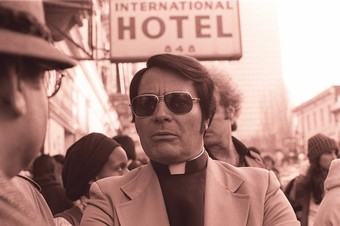
Rev. Jim Jones
Jim Jones was the leader of the Peoples Temple, a cult that committed a mass murder-suicide in 1978.
Becker’s Typology
Becker created four categories by splitting church into “ecclesia” and “denomination”, and sect into “sect” and “cult.” Cults, for Becker, were small religious groups lacking in organization and emphasizing the private nature of personal beliefs. Sociologists still maintain that unlike sects, which are products of religious schism that maintain continuity with traditional beliefs and practices, cults arise spontaneously around novel beliefs and practices.
While most scholars no longer refer to any new religious movements as cults, some sociologists still favor retaining the word as it was used in church-sect typologies. Other scholars and non-academic researchers who use the word do so from explicitly critical perspectives, focusing on the relationship between cult groups and the individuals who join them. These perspectives share the assumption that some form of coercive persuasion or mind control is used to recruit and maintain members by suppressing their ability to reason, think critically, and make choices in their own best interest. Mind control refers to a process in which a group or individual “systematically uses unethically manipulative methods to persuade others to conform to the wishes of the manipulator(s), often to the detriment of the person being manipulated. “
Opponents
Secular cult opponents like those belonging to the anti-cult movement tend to define a cult as a group that tends to manipulate, exploit, and control its members. Specific factors in cult behavior are said to include manipulative and authoritarian mind control over members, communal and totalistic organization, aggressive proselytizing, systematic programs of indoctrination, and perpetuation in middle-class communities. The role of former members, or “apostates,” has been widely studied by social scientists. At times, these individuals become outspoken public critics of the groups they leave. Their motivations, the roles they play in the anti-cult movement, the validity of their testimony, and the narratives they construct, are controversial. According to researchers who have studied apostates, there are several cases where hostile ex-members shade the truth and blow minor incidents out of proportion.
14.6.2: Sect
A sect is a group with distinctive religious, political, or philosophical beliefs.
Learning Objective
Evaluate the varying ways that sects have been understood over time.
Key Points
- Although in the past the term “sect” was mostly used to refer to religious groups, it has since expanded and in modern culture can refer to any organization that breaks away from a larger one to follow a different set of rules and principles.
- The historical usage of the term sect in Christianity has had pejorative connotations, referring to a group or movement with heretical beliefs or practices that deviate from those of groups considered orthodox.
- Among the first to define sects were the sociologists Max Weber and Ernst Troeltsch.
- There are differences between sects and cults in the degree that members are recruited and kept. A sect may also have members who choose to leave later, whereas a cult uses any means necessary to keep its members, including coercion.
- Sectarianism is sometimes defined in the sociology of religion as a worldview that emphasizes the unique legitimacy of believers’ creed and practices and that heightens tension with society.
- Sectarian violence refers to violence inspired by sectarianism. Some of the possible inputs for sectarian violence include power struggles, political climate, social climate, cultural climate, and economic landscape.
Key Terms
- sectarian violence
-
Sectarian violence or sectarian strife is violence inspired by sectarianism, that is, between different sects of one particular mode of ideology or religion within a nation or community.
- cult
-
A group of people with a religious, philosophical or cultural identity sometimes viewed as a sect, often existing on the margins of society or exploitative towards its members.
- sectarianism
-
Rigid adherence to a particular sect, party, or denomination.
Example
- Wherever people of different religions live in close proximity to each other, religious sectarianism can often be found in varying forms and degrees. In some areas, religious sectarians (for example Protestant and Catholic Christians in the United States) now exist peacefully side-by-side for the most part.
A sect is a group with distinctive religious, political, or philosophical beliefs. Although in the past it was mostly used to refer to religious groups, it has since expanded and in modern culture can refer to any organization that breaks away from a larger one to follow a different set of rules and principles. The term is occasionally used in a malicious way to suggest the broken-off group follows a more negative path than the original. The historical usage of the term “sect” in Christianity has had pejorative connotations, referring to a group or movement with heretical beliefs or practices that deviate from those of groups considered orthodox.
There are several different sociological definitions and descriptions for the term. Among the first to define them were the sociologists Max Weber and Ernst Troeltsch. In the church-sect typology, sects are described as newly formed religious groups that form to protest elements of their parent religion. A sect differs from cults in the degree that members are recruited and kept. Whereas the cult is able to enforce its norms and ideas against members, a sect has followers, sympathizers, supporters, or believers. A sect may also have members who choose to leave later, whereas a cult uses any means necessary to keep its members, including coercion.
Sectarianism is sometimes defined in the sociology of religion as a worldview that emphasizes the unique legitimacy of believers’ creed and practices and that heightens tension with the larger society by engaging in boundary-maintaining practices. Wherever people of different religions live in close proximity to each other, religious sectarianism can often be found in varying forms and degrees. In some areas, religious sectarians (for example Protestant and Catholic Christians in the United States) now exist peacefully side-by-side for the most part. Within Islam, there has been conflict at various periods between Sunnis and Shias. Shi’ites consider Sunnis to be damned, due to their refusal to accept the first Caliph as Ali and accept all following descendants of him as infallible and divinely guided. Many Sunni religious leaders, including those inspired by Wahhabism and other ideologies have declared Shias to be heretics and apostates.
The ideological underpinnings of attitudes and behaviors labeled as sectarian are extraordinarily varied. Members of a religious or political group may believe that their own salvation, or the success of their particular objectives, requires aggressively seeking converts from other groups. Adherents of a given faction may believe that for the achievement of their own political or religious project their internal opponents must be purged. Sectarian violence refers to violence inspired by sectarianism. Some of the possible inputs for sectarian violence include power struggles, political climate, social climate, cultural climate, and economic landscape.

Church-sect continuum
Before describing these different religions, it is important for the reader to understand that these classifications are a good example of what sociologists refer to as ideal types. Ideal types are pure examples of the categories. Because there is significant variation in each religion, how closely an individual religion actually adheres to their ideal type classification will vary.
14.6.3: The Christian Church
The Christian Church is the assembly of followers of Jesus Christ; in Christianity, a church is the building where its members meet.
Learning Objective
Describe the Church as the assembly of followers of Jesus Christ, and the building where its members meet.
Key Points
- The early Church originated in Roman Judea in the first century AD, founded on the teachings of Jesus of Nazareth, who is believed by Christians to be the Son of God and Christ the Messiah.
- The Eastern Orthodox Church and Oriental Orthodoxy each claim to be the original Christian Church. The Eastern Orthodox Church bases its claim primarily on its traditions and beliefs of the original Christian Church.
- The Roman Catholic Church teaches in its doctrine that it is the original Church founded by Christ and the Apostles in the 1st century AD.
- State churches are organizational bodies within a Christian denomination which are given official status or operated by a state.
- Churches of Christ are autonomous Christian congregations associated with one another through common beliefs and practices. Members of the Churches of Christ believe that Jesus founded only one church, that the current divisions between Christians are not God’s will, and that the only basis for restoring Christian unity is the Bible.
- Protestants believe that the Church, as described in the Bible, has a twofold character that can be described as the visible and invisible church. The invisible church consists of all those from every time and place who are vitally united to Christ through regeneration and salvation and who will be eternally united to Jesus Christ in eternal life. The visible church refers to the institutional body on earth which preaches the gospel and administers the sacrament.
- State churches are organizational bodies within a Christian denomination which are given official status or operated by a state.
Key Terms
- church
-
a Christian religious institution or building
- state churches
-
State churches are organizational bodies within a Christian denomination which are given official status or operated by a state.
- assembly
-
A legislative body; e.g., the General Assembly of the United Nations.
- Invisible Church
-
The invisible church or church invisible is a theological concept of an “invisible” body of the elect who are known only to God, in contrast to the “visible church”—that is, the institutional body on earth which preaches the gospel and administers the sacraments.
Example
- Churches of Christ are autonomous Christian congregations associated with one another through common beliefs and practices. They seek to base doctrine and practice on the Bible alone, and seek to be New Testament congregations as originally established by the authority of Christ.
The Christian Church is the assembly or association of followers of Jesus Christ. The four traditional notes of the Christian Church are unity, holiness, catholicity, and apostolicity. In the New Testament, the term “church,” which in Greek meant “assembly,” is used for local communities, and in a universal sense to mean all believers. In the Christian religion, a church is the building or structure used to facilitate the meeting of its members.
The “Original” Church
The early Church originated in Roman Judea in the first century AD, founded on the teachings of Jesus of Nazareth, who is believed by Christians to be the Son of God and Christ the Messiah. It is usually thought of as beginning with Jesus’ Apostles. The Eastern Orthodox Church and Oriental Orthodoxy each claim to be the original Christian Church. The Eastern Orthodox Church bases its claim primarily on its traditions and beliefs of the original Christian Church. By contrast, the Catholic Church teaches in its doctrine that it is the original Church founded by Christ on the Apostles in the 1st century AD. Since the Protestant Reformation, most Protestant denominations interpret “catholic,” especially in its creedal context, as referring to the Protestant concept of an eternal, invisible church of Christ and the Elect. Anglicans generally understand their tradition as a a middle path between Roman Catholicism and Eastern Christianity on one hand, and Protestantism on the other.
Churches of Christ
Churches of Christ are autonomous Christian churches associated with one another through common beliefs and practices. They seek to base doctrine and practice on the Bible alone, and seek to be New Testament congregations as originally established by the authority of Christ. Members of Churches of Christ believe that Jesus founded only one church, that the current divisions between Christians are not God’s will—the only basis for restoring Christian unity is the Bible. Many Protestants believe that the Church, as described in the Bible, has a twofold character that can be described as the visible and invisible church. The invisible church consists of all those from every time and place who are vitally united to Christ through regeneration and salvation and who will be eternally united to Jesus Christ in eternal life. The visible church—the institutional body on earth which preaches the gospel and administers the sacrament—consists of all those who visibly join themselves to a profession of faith and gathering together to know and serve the Head of the Church, Jesus Christ.
Political Significance
Churches can also have political significance around the world. State churches are organizational bodies within a Christian denomination, given official status or operated by a state. State churches are not necessarily national churches in the ethnic sense of the term, but the two concepts may overlap in a nation state where the state boundary largely corresponds to the distribution of a single ethnic group defined by a specific denomination. State churches, by contrast, may also be minority denominations which are given political recognition by the state.

Holy Ascension Orthodox Church in Mount Pleasant
Different Christian Sects construct their own Churches, which are their places of worship
14.6.4: The Ecclesia
Ecclesias are different from churches because they typically must compete with other religious voices in a community.
Learning Objective
Distinguish ecclesia from churches and denominations.
Key Points
- While a church is an institution that acts as the religious guardian for all members of a community, and that tolerates no competition, an ecclesia is less successful at garnering absolute adherence among all members.
- State churches are organizational bodies within a Christian denomination that are either given official status by a state, or operated directly by a state. State churches in Western Europe are generally ecclesias.
- An ecclesial community is, in Roman Catholic terminology, a Christian religious group that does not meet the Roman Catholic definition of a church.
- In Catholic canon law, a church is an ecclesial community headed by a bishop or someone recognized as the equivalent of a bishop.
Key Terms
- state churches
-
State churches are organizational bodies within a Christian denomination which are given official status or operated by a state.
- ecclesial community
-
An ecclesial community is, in Roman Catholic terminology, a Christian religious group that does not meet the Roman Catholic definition of a “Church”.
- particular church
-
In Catholic canon law, a particular church is an ecclesial community headed by a bishop or someone equivalent to a bishop.
Example
- A Baptist church gathering is an ecclesial community.
Church is a classificatory term used to describe the institutional expression of religion. Churches typically tolerate no religious competition, and serve as the guardians and guides of spiritual life for a particular group of people. Churches can be contrasted with denominations, which do involve competition between religions. A church, through its institutional presence, typically strives to provide an all-encompassing worldview for its adherents. It is also almost always enmeshed with the political and economic structures of a society. A striking historical example of this is the Holy Roman Empire.
A slight modification of the church type is that of ecclesia. Ecclesias include the above characteristics of churches, but they are generally less successful at garnering absolute adherence among all of the members of the society. Ecclesias are also typically not the sole religious body in a particular societal space. The state churches of some European nations would fit this type. State churches are organizational bodies within a Christian denomination that have been given official status by a state, or are directly operated by a state. The Anglican Church of England, for example, is a state church that does not have the adherence of all English citizens. Because of this, it is considered an ecclesia.
An ecclesial community is, in Roman Catholic terminology, a Christian religious group that does not meet the Roman Catholic definition of a church. Although the word “ecclesial” itself stems from the Greek word for “church” or “gathering,” ecclesias are not necessarily churches. The Catholic Church applies the word “Church” only to Christian communities that, in the view of the Catholic Church, “have true sacraments in light of Apostolic succession” and that possess a priesthood and the Eucharist. In this way, certain ecclesia fail to meet the requirements for a church. In Catholic canon law, a particular church is an ecclesial community headed by a bishop or an equivalent figure.

Choir of an Ecclesia
Catholic Mass
14.6.5: Religious Denominations
A religious denomination is a subgroup within a religion that operates under a common name, tradition, and identity.
Learning Objective
Explain why denominations form within religions.
Key Points
- Christian denominations include Eastern Orthodox, Anglicanism, and the many varieties of Protestantism.
- The four branches of Judaism include Orthodox, Conservative, Reform, and Reconstructionist.
- The two main branches of Islam are Sunni and Shia.
- Denominationalism is the division of one religion into separate groups, sects, schools of thought, or denominations.
- In Christianity, non-denominational institutions or churches are those not formally aligned with an established denomination, or that remain otherwise officially autonomous.
- Ecumenism mainly refers to initiatives aimed at greater Christian unity or cooperation.
- The term interfaith dialogue refers to cooperative, constructive, and positive interaction between people of different religious traditions and spiritual or humanistic beliefs
Key Terms
- denominationalism
-
The division of one religion into separate groups, sects, schools of thought, or denominations.
- ecumenism
-
Ecumenism mainly refers to initiatives aimed at greater Christian unity or cooperation.
- interfaith dialogue
-
The term interfaith dialogue refers to cooperative, constructive, and positive interaction between people of different religious traditions (i.e., “faiths”) or spiritual or humanistic beliefs, at both the individual and institutional levels. It is distinct from syncretism or alternative religion; this dialogue often promotes understanding between different religions to increase acceptance of others, rather than attempting to synthesize new beliefs.
Example
- Christianity has different denominations such as Protestantism and Catholicism, among others.
A religious denomination is a subgroup within a religion that operates under a common name, tradition, and identity. The term describes various Christian denominations (for example, Eastern Orthodox, Anglicanism, and the many varieties of Protestantism). The term also describes the four branches of Judaism (Orthodox, Conservative, Reform, and Reconstructionist), and describes the two main branches of Islam (Sunni and Shia). Denominationalism is the division of one religion into separate groups, sects, schools of thought, or denominations.
Denominations often form slowly over time for many reasons. Due to historical accidents of geography, culture and influence between different groups, members of a given religion slowly begin to diverge in their views. Members of a religion may find that they have developed significantly different views on theology, philosophy, religious pluralism, ethics, and religious practices and rituals. Consequently, different denominations may eventually form. In other cases, denominations form very rapidly, from a split or schism in an existing denomination, or if people share an experience of spiritual revival or spiritual awakening and subsequently choose to form a new denomination.
In Christianity, non-denominational institutions or churches are those not formally aligned with an established denomination or those that remain otherwise officially autonomous. Non-denominational congregations may establish a functional denomination via mutual recognition by other congregations with commonly held doctrine, policy, and worship—without formalizing external direction or oversight in such matters. Some non-denominational churches explicitly reject the idea of a formalized denominational structure as a matter of principle, holding that each congregation is better off being autonomous.
In a similar but different vein, ecumenism mainly refers to initiatives aimed at greater Christian unity or cooperation. It is used predominantly with reference to Christian denominations and churches separated by doctrine, history, and practice. Within this particular context, the term ecumenism refers to the idea of a Christian unity in the literal meaning: that there should be a single Christian Church. At a broader level, the term “interfaith dialogue” refers to cooperative, constructive, and positive interaction between people of different religious traditions and spiritual or humanistic beliefs—at both an individual and institutional level.
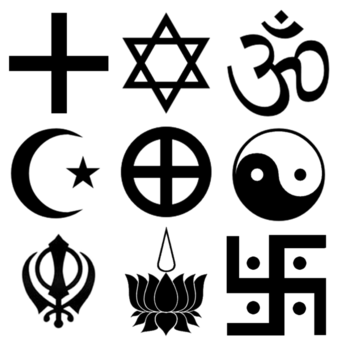
Religious Symbols
Symbols of Various Faiths
14.7: The Structure of Religion in the U.S.
14.7.1: Religion in the U.S.
Due to the First Amendment, which grants freedom of religion, there is a diversity of religious beliefs and practices in the U.S.
Learning Objective
Discuss the relationship between religion and government in the United States
Key Points
- The First Amendment specifically denies the Federal Government the power to enact any law respecting either an establishment of religion or prohibiting its free exercise, thus protecting any religious organization, institution, or denomination from government interference.
- European Rationalist and Protestant ideals influenced the development of separation between state and religious affairs.
- The majority of Americans (76% to 80%) identify themselves as Protestants or Catholics, accounting for 51% and 25% of the population respectively.
Key Terms
- creed
-
That which is believed; accepted doctrine, especially religious; a particular set of beliefs; any summary of principles or opinions professed or adhered to.
- Religious Organization
-
Religious activities generally need some infrastructure to be conducted. For this reason, there generally exist religion-supporting organizations, which are some form of organization that manage the upkeep of places of worship, e.g., mosques, prayer rooms, other similar edifices or meeting places, and the payment of salaries to priests, ministers, or religious leaders. In addition, such organizations usually have other responsibilities, such as the formation, nomination, or appointment of religious leaders; the establishment of a corpus of doctrine; the disciplining of priests or other people with respect to religious law; and the determination of qualification for membership.
- First Amendment
-
The First Amendment (Amendment I) to the United States Constitution is part of the Bill of Rights. The amendment prohibits the making of any law respecting an establishment of religion, impeding the free exercise of religion, abridging the freedom of speech, infringing on the freedom of the press, interfering with the right to peaceably assemble or prohibiting the petitioning for a governmental redress of grievances.
Example
- Religions such as Islam, Judaism, and Hinduism have been accepted in American society despite the country’s majority Christian population. The separation of the church and state has allowed the private practice of diverse religions.
Religion in the United States is characterized by both a diversity of religious beliefs and practices, and by a high adherence level. A wide variety of religious choices have been available to the U.S. population due to the First Amendment of the Constitution, which allows freedom of religion.
Separation of Church and State in the United States
The framers of the Constitution modeled the provisions concerning religion within the Virginia Statute for Religious Freedom and rejected any religious test for office. The First Amendment specifically denies the Federal Government the power to enact any law respecting either an establishment of religion or prohibiting its free exercise. This amendment protects any religious organization, institution, or denomination from government interference. The decision was mainly influenced by European Rationalist and Protestant ideals, but was also a consequence of the pragmatic concerns of minority religious groups and small states that did not want to be under the power or influence of a national religion that did not represent their beliefs.
Robert N. Bellah has argued that although the separation of church and state is grounded firmly in the Constitution of the United States, this does not mean that there is no religious dimension in the political society of the United States. He used the term “civil religion” to describe the specific relation between politics and religion in the United States. His 1967 article, “Civil religion in America,” analyzes the inaugural speech of John F. Kennedy: “Considering the separation of church and state, how is a president justified in using the word ‘God’ at all? The answer is that the separation of church and state has not denied the political realm a religious dimension. “
Robert S. Wood has argued that the United States is a model for the world in terms of how a separation of church and state—no state-run or state-established church—is good for both the church and the state, allowing a variety of religions to flourish. Speaking at the Toronto-based Center for New Religions, Wood said that the freedom of conscience and assembly allowed under such a system has led to a “remarkable religiosity” in the United States that isn’t present in other industrialized nations. Wood believes that the United States operates on “a sort of civic religion,” which includes a generally shared belief in a creator who “expects better of us.” Beyond that, individuals are free to decide how they want to believe and fill in their own creeds and express their conscience. He calls this approach the “genius of religious sentiment in the United States. “
Religious Affiliation in the United States
The majority of Americans (76% to 80%) identify themselves as Protestants or Catholics, accounting for 51% and 25% of the population respectively, according to one survey by Trinity College. Non-Christian religions (including Judaism, Islam, Buddhism, Hinduism, etc.) collectively make up about 5% of the adult population. Another 15% of the adult population claims no religious affiliation. When asked, about 5.2% said they did not know or refused to reply. According to the American Religious Identification Survey, religious belief varies considerably by region. The lowest rate is in the West, with 59% reporting a belief in God, and the highest rate is in the South (the “Bible Belt”) at 86%.
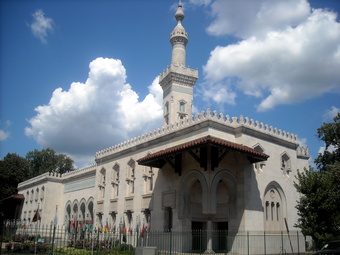
Islamic Center
Islamic Center of Washington located at 2551 Massachusetts Avenue NW in Washington, D.C.
14.7.2: Religious Diversity
Religion in the United States is characterized by both a wide diversity in religious beliefs and practices and by a high adherence level.
Learning Objective
Discuss the scope of religious diversity in the United States
Key Points
- According to the U.S. Census, the most common religions in the United States are Christianity, Judaism, Islam, Buddhism, Hinduism, and unaffiliated religions, including atheists or agnostics.
- Religious pluralism is an attitude or policy regarding the diversity of religious belief systems co-existing in society.
- Interfaith dialogue refers to dialogue between members of different religions for the goal of reducing conflicts between their religions and to achieve agreed-upon, mutually desirable goals.
- Freedom of religion encompasses all religions acts within the law in a particular region.
Key Terms
- interfaith dialogue
-
The term interfaith dialogue refers to cooperative, constructive, and positive interaction between people of different religious traditions (i.e., “faiths”) or spiritual or humanistic beliefs, at both the individual and institutional levels. It is distinct from syncretism or alternative religion; this dialogue often promotes understanding between different religions to increase acceptance of others, rather than attempting to synthesize new beliefs.
- religious pluralism
-
The peaceful coexistence of multiple religions in a community.
- freedom of religion
-
The right of citizens to hold any religious or non-religious beliefs, and to carry out any practices in accordance with those beliefs, so long as they do not interfere with another person’s legal or civil rights, or any reasonable laws, without fear of harm or prosecution.
Example
- The United States under the First Amendment allows people to practice their religious beliefs, despite differences in creed or culture. Indeed the United States is quite religiously diverse.
Religion in the United States is characterized by both a wide diversity in religious beliefs and practices and by a high adherence level. A majority of Americans report that religion plays a “very important” role in their lives, a proportion unique among developed nations. Many faiths have flourished in the United States, including those spanning the country’s multicultural immigrant heritage, as well as those founded within the country; these have led the United States to become one of the most religiously diverse countries in the world.
The U.S. Census does not ask about religion. Various groups have conducted surveys to determine approximate percentages of those affiliated with each religious group. Some surveys ask people to self-identify, while others calculate church memberships. According to the census, religion in the United States is comprised of Christianity, Judaism, Islam, Buddhism, Hinduism, and the unaffiliated, including atheists or agnostics.
The largest religion in the United States is Christianity, practiced by the majority of the population. Due to its large population and history, the United States has numerically more Christians (and more Protestants) than any other country in the world. After Christianity and no-religion, Judaism is the third-largest religious affiliation in the United States, though this identification is not necessarily indicative of religious beliefs or practices. A significant number of people identify themselves as American Jews on ethnic and cultural grounds, rather than religious ones. On the other hand, American Islam effectively began with the arrival of African slaves. It is estimated that about 10% of African slaves transported to the United States were Muslim. Research indicates that Muslims in the United States are generally more assimilated and prosperous than Muslims in Europe.
Religious pluralism is an attitude or policy regarding the diversity of religious belief systems co-existing in society. Religious pluralism is sometimes used as a synonym for interfaith dialogue. Interfaith dialogue refers to dialogue between members of different religions for the goal of reducing conflicts between their religions and to achieve agreed upon mutually desirable goals. Freedom of religion encompasses all religions acting within the law in a particular region, whether or not an individual religion accepts that other religions are legitimate or that freedom of religious choice and religious plurality, in general, are good things.

Religious Diversity
Religious symbols represented in this picture reflect the religious diversity in the United States. Among the symbols one can recognize Islam, Judaism, Christianity, and Buddhism.
14.7.3: Widespread Belief
Christianity is the largest religion in the United States, with around 77% of the population identifying itself as Christian.
Learning Objective
Identify the most common and popular religions in the United States
Key Points
- Christian denominations in the U.S. are usually divided into three large groups: Evangelical, Mainline Protestant and Roman Catholic.
- The mainline Protestant Christian denominations were brought to the U.S. by its historic immigrant groups; for this reason they are sometimes referred to as heritage churches.
- Other parts of the world have different widespread beliefs. Islam, for example, dominates the Middle East.
Key Terms
- evangelicalism
-
Protestant movement basing its theology almost entirely on Scripture, which is held to be inerrant.
- Roman Catholicism
-
The Catholic Church, also known as the Roman Catholic Church, is the world’s largest Christian church, with more than one billion members worldwide.
- Mainline Protestantism
-
Mainline Protestant (also sometimes called “mainstream American Protestant”) are certain Protestant churches in the United States that comprised a majority of Americans from the colonial era until the early 20th century.
Example
- The Protestant denominations encompass a wide array of religious beliefs. That is, there are various denominations within Protestantism including Evangelicals, Methodists and Baptists.
It is common for many societies to be dominated by a single widespread belief. For example, Christianity is the largest and most popular religion in the United States, with around 77% of those polled identifying themselves as Christian as of 2009. Protestant denominations accounted for 51.3%, while Roman Catholicism, at 23.9%, was the largest individual denomination. One study categorizes white evangelicals, 26.3% of the population, as the country’s largest religious cohort, while another study estimates evangelicals of all races at 30–35%. Christianity was introduced to the Americas in the 16th and 17th centuries by European colonization.
Today, most Christian denominations in the United States are divided into three large groups: Evangelicalism, Mainline Protestantism and Roman Catholicism. Christian denominations that do not fall within either of these groups are mostly associated with ethnic minorities, i.e. the various denominations of Eastern Orthodoxy. Evangelicalism is a Protestant Christian movement. In typical usage, the term mainline is contrasted with evangelical. Most adherents consider its key characteristics to be:
- a belief in the need for personal conversion (or being “born again”)
- some expression of the gospel
- a high regard for Biblical authority
- an emphasis on the death and resurrection of Jesus.
Other parts of the world have different widespread beliefs. Islam, for example, dominates the Middle East, with Pakistan, Bangladesh, Iran, Turkey, Egypt, Algeria, Morocco, Iraq, Sudan, Afghanistan, Uzbekistan, Saudi Arabia, Yemen, Syria, and Niger having 90% or more of their population identifying as Muslim. Islam is also the state religion in areas of Asia, the Middle East and North Africa .
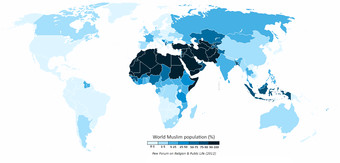
Worldwide Muslim Population
As the map shows, certain regions are dominated by widespread beliefs.

Christian Flag at Covenant Presbyterian Church
The Christian flag displayed with the flag of the USA; note the finials on the flag poles. This is next to the pulpit and baptismal font in Covenant Presbyterian Church, Long Beach, California, USA;
14.7.4: Ecumenism
Ecumenism mainly refers to initiatives aimed at creating greater Christian unity or cooperation.
Learning Objective
Define ecumenism and its central features
Key Points
- Ecumenism contrasts with interfaith dialogue, which aims at unity, respect, and cooperation among diverse religions, under the auspices of a shared sense of spirituality.
- Despite many disagreements over ecumenism and how to approach interfaith dialogue, there exists a sizable group of Orthodox Christians who are vehemently opposed to any kind of interfaith dialogue.
- The general understanding of the ecumenical movement is that it came from the Roman Catholic Church’s attempts to reconcile with Christians who had become separated over theological issues.
Key Terms
- ecumenism
-
Ecumenism mainly refers to initiatives aimed at greater Christian unity or cooperation.
- interfaith dialogue
-
The term interfaith dialogue refers to cooperative, constructive, and positive interaction between people of different religious traditions (i.e., “faiths”) or spiritual or humanistic beliefs, at both the individual and institutional levels. It is distinct from syncretism or alternative religion; this dialogue often promotes understanding between different religions to increase acceptance of others, rather than attempting to synthesize new beliefs.
- Orthodox Christians
-
The Eastern Orthodox Church, officially called the Orthodox Catholic Church and commonly referred to as the Orthodox Church, is the second largest Christian church in the world, with an estimated 300 million adherents mainly in the countries of Russia, Belarus, Ukraine, Moldova, Georgia, Romania, Serbia, Montenegro, Bosnia and Herzegovina, Macedonia, Bulgaria, Greece, and Cyprus, all of which — except Bosnia — are majority Eastern Orthodox. It teaches that it is the One, Holy, Catholic and Apostolic Church established by Jesus Christ and his Apostles almost 2,000 years ago.
Example
- Interfaith dialogue can occur between different religious denominations that come together and work for a common purpose within their communities.
Ecumenism refers to initiatives aimed at greater Christian unity or cooperation . As a term, it usually only refers to predominantly Christian denominations and churches separated by doctrine, history, and practice. Within this particular context, ecumenism refers to the idea that Christians should literally unify under a single Christian church. Ecumenism contrasts with the practice of interfaith dialogue, which is aimed at unity, respect, and cooperation among diverse religions. Interfaith dialogue, also known as interfaith pluralism, refers to “religious unity” not in the sense of a single church, but instead by the advocacy of a greater sense of shared spirituality.

Ecumenism Symbol
Ecumenism mainly refers to initiatives aimed at greater Christian unity or cooperation.
The ecumenical movement is understood to have emerged from the Roman Catholic Church’s attempts reconcile with other Christians who had separated over theological issues. Although this is not the case with all Catholics, most ecumenical Catholics have the goal of reconciling all those with a Christian faith in a single, visible organization, through a union with the Roman Catholic Church. For some Protestants, spiritual unity, and unity in how a church teaches central issues, sufficiently represents this general movement.
The Oriental Orthodox and Eastern Orthodox churches are two distinct bodies of local churches. Within each body, the churches share full communion, although there is not official communion between the two bodies. Many theologians of the Eastern and Oriental Orthodoxies engage in theological dialogue with each other and with some Western churches, but this stops short of full communion.
Members of the Anglican Communion, in the United Kingdom, have generally embraced the Ecumenical Movement, and actively participate in organizations like the World Council of Churches and the NCCC. Within the Anglican Communion, each member church is allowed to make its own decision with regard to intercommunion.
Despite many disagreements over ecumenism and how to approach interfaith dialogue, there exists a sizable group of Orthodox Christians who are vehemently opposed to any kind of interfaith dialogue, whether with other Christian denominations or with religions outside Christianity. In the Eastern Orthodox world, the monastic community of Mount Athos has voiced its concerns regarding the ecumenist movement. They do not want the Orthodox church to play a part in this more general movement.

Taize Prayer
Ecumenical worship service at the monastery of Taizé
14.7.5: Characteristics of Members of Different Religions
Religion plays a “very important” role in the lives of most Americans; a proportion unique among developed nations.
Learning Objective
Identify the characteristics and defining features of members belonging to different religions in the United States
Key Points
- The most prevalent religion in the U.S. is Christianity. Northern European peoples introduced Protestantism, while the Spanish, French, and English introduced Catholicism.
- The Jewish community in the United States is composed predominantly of Ashkenazi Jews who emigrated from Central and Eastern Europe, as well as their U.S.-born descendants.
- American Islam effectively began with the arrival of African slaves. Research indicates that Muslims in the U.S. are generally more assimilated and prosperous than Muslims in Europe.
- Buddhism entered the U.S. during the 19th century with the arrival of the first immigrants from Eastern Asia.
- Sikhs have been a part of the American populace for more than 130 years.
- Buddhism entered the U.S. during the 19th century with the arrival of the first immigrants from Eastern Asia.
- The first time Hinduism entered the U.S. is not clearly identifiable.
- Sikhs have been a part of the American populace for more than 130 years.
Key Terms
- Judaism
-
A world religion tracing its origin to the Hebrew people of the ancient Middle-East, as documented in religious writings known as the Torah or Old Testament.
- Protestantism
-
Protestantism is one of the major groupings within Christianity. It has been defined as “any of several church denominations denying the universal authority of the Pope and affirming the Reformation principles of justification by faith alone, the priesthood of all believers, and the primacy of the Bible as the only source of revealed truth. ” More broadly, it means Christianity outside “of a Catholic or Eastern church. “
- American Islam
-
From the 1880s to 1914, several thousand Muslims immigrated to the United States from the Ottoman Empire and from parts of South Asia; they did not form distinctive settlements, and probably mostly assimilated into the wider society.
Example
- Members of the Muslim community in the United States mostly come from a middle class or affluent background. In addition, many Jews immigrated to the U.S. as a result of WWII and their persecution during the Holocaust.
Religion plays a “very important” role in the lives of most Americans, a proportion unique among developed nations. Many faiths have flourished in the United States, including later imports spanning the country’s multicultural immigrant heritage and those founded within the country, These disparate faiths have led the U.S. to become one of the most religiously diverse countries in the world.
The largest religion in the U.S. is Christianity, practiced by the majority of the population. From those queried, roughly 51.3% of Americans are Protestants, 25% are Catholics, 1.7% are Mormons, and 1.7% are of various other Christian denominations. Northern European peoples introduced Protestantism. Among Protestants, Anglicans, Baptists, Puritans, Presbyterians, Lutherans, Quaker, and Moravians were the first to settle to the U.S. The Spanish, French and English introduced Catholicism. The religion came with the arrival of Hispanics/Latinos, Irish, Highland Scots, Italians, Dutch, Flemish, Polish, French, Hungarians, German, and Lebanese immigrants.
American Jews are citizens of the Jewish faith or ethnicity. The Jewish community in the U.S. is composed predominantly of Ashkenazi Jews who emigrated from Central and Eastern Europe, as well as their U.S.-born descendants. Depending on religious definitions and varying population data, the U.S. is home to the largest or second largest Jewish community in the world, after Israel. In 2007, the population of American adherents of Judaism was estimated to be approximately 5,128,000, or 1.7% of the total population .

Hayley Fields at the Beth Israel Torah Dedication Ceremony
Two weeks after Hurricane Katrina struck the Gulf Coast, volunteers with an Israeli charity rescued seven Torah scrolls from the synagogue.
American Islam effectively began with the arrival of African slaves. It is estimated that about 10% of African slaves transported to the U.S. were Muslim. Research indicates that Muslims in the U.S. are generally more assimilated and prosperous than Muslims in Europe. Like other subcultural and religious communities, the Islamic community has generated its own political organizations and charity organizations.
Buddhism entered the U.S. during the 19th century with the arrival of the first immigrants from Eastern Asia. The first Buddhist temple was established in San Francisco in 1853 by Chinese Americans. The first time Hinduism entered the U.S. is not clearly identifiable. During the 1960s and 1970s, Hinduism exercised a fascination that contributed to the development of New Age thought. Sikhs have been a part of the American populace for more than 130 years. Around 1900, the state of Punjab of British India was hit hard by British practices of mercantilism. Many Sikhs emigrated to the United States, and began working on farms in California.
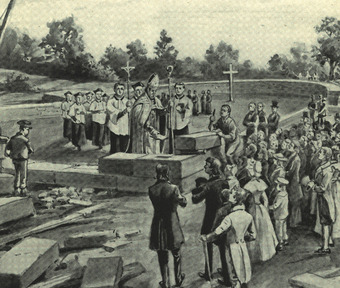
Baltimore Cornerstone
John Carroll, bishop of Baltimore, lays the cornerstone for the Cathedral of the Assumption in Baltimore, the first cathedral in the United States.
14.7.6: Secularism and the Future of Religion
Most modern Western societies are recognized as secular because they enjoy near-complete freedom of religion.
Learning Objective
Discuss the rise of secularism and its response in the West
Key Points
- The secularization of a society refers to the process it undergoes when it shifts away from closely identifying with religious values and institutions towards affiliating with nonreligious values and institutions.
- The term secularization was coined by the British writer George Jacob Holyoake in 1851 and is most closely associated with the Age of Enlightenment in Europe.
- In a political context, secularization is the separation of the state from the church.
- When speaking of social structures, secularization refers to the increasing division of labor and occupational specialization in society (differentiation).
- Evidence suggests that “no religion” is becoming an increasingly prevalent religious status in the United States.
Key Terms
- Age of Enlightenment
-
A period of time ranging from part of the 17th Century through much of the 18th Century, characterized particularly by the importance of logic and reason.
- separation of church and state
-
The separation of church and state is the distance in the relationship between organized religion and the nation state.
In studies of religion, modern Western societies are generally recognized as secular. This is due to the near-complete freedom of religion, the fact that beliefs on religion generally are not subject to legal or social sanctions. Some societies become increasingly secular as the result of social processes, rather than through the actions of a dedicated secular movement; this process is known as secularization. Secularization is the transformation of a society from close identification with religious values and institutions toward nonreligious values and secular institutions. The secularization thesis refers to the belief that as societies “progress,” particularly through modernization and rationalization, religion loses its authority in all aspects of social life and governance.
Secularism
Coined by the British writer George Jacob Holyoake in 1851, secularism is often associated with the Age of Enlightenment in Europe, and it now plays a major role in Western society. In political terms, secularism is a movement towards the separation of church and state. This can refer to reducing ties between a government and a state religion, replacing laws based on scripture with civil laws, and eliminating discrimination on the basis of religion. This is said to add to democracy by protecting the rights of religious minorities. Due in part to the belief in the separation of church and state, secularists tend to prefer that politicians make decisions for secular rather than religious reasons. In this respect, policy decisions pertaining to topics like abortion, contraception, embryonic stem cell research, same-sex marriage, and sex education are the prominent issues many secularist organizations focus on.
Secularization in Different Realms
When discussing social structures, secularization can refer to differentiation. Differentiation refers to the increasing division of labor and occupational specialization in society. When discussing institutions, secularization can refer to the transformation of an institution that had once been considered religious in character into something not thought of as religious. When discussing activities, secularization refers to the transfer of activities from institutions of a religious nature to others without that character. Finally, when discussing religion, secularization can only be used unambiguously to refer to religion in a generic sense. For example, a reference to Christianity is not clear unless one specifies exactly which denominations of Christianity are being discussed.
Responses to Secularization
Because religion continues to be recognized in Western thought as a universal impulse, many religious practitioners have aimed to band together in interfaith dialogue, cooperation, and religious peace-building. Recent interfaith initiatives include “A Common Word,” launched in 2007, which is focused on bringing Muslim and Christian leaders together, the “C1 World Dialogue,” the “Common Ground” initiative between Islam and Buddhism, and a United Nations sponsored “World Interfaith Harmony Week. “
Some evidence suggests that the fastest growing religious status in the United States is “no religion” Irreligion is the absence of religion, an indifference towards religion, a rejection of religion, or hostility towards religion. When characterized as the rejection of religious belief, it includes atheism and secular humanism. When characterized as hostility towards religion, it includes antitheism, anticlericalism and antireligion.

Sacred and Secular
The secularization thesis refers to the belief that as societies “progress,” particularly through modernization and rationalization, religion loses its authority in all aspects of social life and governance.
14.8: Major Religions in the U.S.
14.8.1: Protestantism
Protestantism is one of the major umbrella religions in the U.S., and is constantly evolving in response to political and social changes.
Learning Objective
Describe the various sects of Protestantism and four key moments in their history in the U.S., including any resitance to those moments
Key Points
- Evangelicalism is the conversion of individuals, through the preaching of the Word. from a state of sin to a “new birth”.
- The Great Awakening refers to a northeastern Protestant revival movement that took place in the 1730s and 1740s.
- The Second Great Awakening has been called the central and defining event in the development of Afro-Christianity. It began after many African Americans became dissatisfied with their treatment in white churches, and disappointed by their fellow believers’ disinterest in abolishing slavery.
- The Federal Council of Churches, founded in 1908, marked the first major expression of a growing, modern ecumenical movement among Christians in the United States.
- The National Council of the Churches of Christ in the United States represented, in the 1950s, an extension and expansion of the Federal Council of Churches, the International Council of Religious Education, and several other interchurch ministries.
- Rev. Martin Luther King, Jr. was but one of many notable black ministers involved in the Civil Rights Movement.
- Rev. Martin Luther King, Jr. was but one of many notable black ministers involved in the Civil Rights Movement.
Key Terms
- Civil Rights Movement
-
The civil rights movement was a worldwide political movement for legal equality that occured between approximately 1950 and 1980.
- National Council of the Churches of Christ
-
The National Council of the Churches of Christ in the USA (usually identified as National Council of Churches or NCC) is an ecumenical partnership of 37 Christian faith groups in the United States. Its member denominations, churches, conventions, and archdioceses include Mainline Protestant, Orthodox, African American, Evangelical, and historic peace churches.
Example
- There are different kinds of Protestant denominations such as Methodists and Baptists, which are both Christian. However, they have different congregations due to their different interpretations of the Christian Protestant faith.
The Movement of Christianity to North America
Christianity was introduced to North America when Europeans began colonizing the continent in the 16th and 17th centuries. Spanish, French and British colonists brought Roman Catholicism to the colonies of New Spain, New France and Maryland, respectively. Colonists from Northern Europe, primarily from Great Britain, introduced Protestantism to a number of areas, including Massachusetts Bay Colony, New Netherlands, the Virginia colony, the Carolina Colony, Newfoundland, Labrador, and Lower Canada. These early Protestant settlers represented a diversity of Protestant sects, including Anglicanism, Baptism, Congregationalism, Presbyterianism, Lutheranism, Quakerism, the Mennonite Church and the Moravian Church.
Evangelicalism and the Great Awakening
Evangelicalism in Protestantism is difficult to both date and define. Scholars have argued that, as a self-conscious movement, evangelicalism did not arise until the mid-17th century, perhaps not until the Great Awakening. The fundamental premise of evangelicalism is that individuals can be converted, through preaching the Word, from a state of sin to a “new birth. ” The Great Awakening refers to a northeastern Protestant revival movement that took place in the 1730s and 1740s.
The first generation of New England Puritans required that church members undergo a conversion experience that they could then describe publicly. While initially popular, their descendants were not as successful in reaping the harvests of redeemed souls. The initial movement began with Jonathan Edwards, a Massachusetts preacher who sought to return to the Pilgrims’ strict Calvinist roots. British preacher George Whitefield, as well as other itinerant preachers, spread the movement, traveling across the colonies and preaching in a dramatic and emotional style. Followers of Edwards, and other preachers of similar religiosity, called themselves the “New Lights” in contrast to the “Old Lights,” who disapproved of their movement. To promote their viewpoints, the two sides established academies and colleges, including Princeton and Williams College. The Great Awakening has been called the first truly American event.
The supporters of the Awakening and its evangelical thrust, Presbyterians, Baptists, and Methodists, became the largest American Protestant denominations by the first decades of the 19th century. By the 1770s, the Baptists were growing rapidly both in the North (where they founded Brown University), and in the South. Opponents of the Awakening or those split by it, Anglicans, Quakers, and Congregationalists, were left behind.
Christianity and Black Populations
The Christianity of the black population was grounded in evangelicalism. The Second Great Awakening has been called the “central and defining event in the development of Afro-Christianity. ” During this movement, Baptists and Methodists converted large numbers of blacks. However, many were disappointed at the treatment they received from their fellow believers. They were also disappointed that Baptists and Methodists, many of whom had advocated for abolition after the American Revolution, ended up backsliding on that commitment. When their discontent could not be contained, forceful black leaders followed what was becoming an American habit, and they formed new denominations. In 1787, Richard Allen and his colleagues in Philadelphia broke away from the Methodist Church and, in 1815, they founded the African Methodist Episcopal (AME) Church. This church, along with independent black Baptist congregations, flourished as the century progressed.
Coalitions of Churches
The Federal Council of Churches, founded in 1908, marked the first major expression of a growing, modern ecumenical movement among Christians in the United States. It was active in advocating for the reform of public and private policies, particularly as they impacted the lives of impoverished people. This council developed a comprehensive and widely debated Social Creed, which served as a humanitarian “bill of rights” for those seeking improvements in American life.
In 1950, the National Council of the Churches of Christ in the USA (usually identified as National Council of Churches, or NCC) represented a dramatic expansion in the development of ecumenical cooperation. It was a merger of the Federal Council of Churches, the International Council of Religious Education, and several other interchurch ministries. Today, the NCC is a joint venture of 35 Christian denominations in the United States. It has 100,000 local congregations and 45,000,000 adherents.
As the center of community life, Black churches played a leadership role in the Civil Rights Movement. Their history, as a focal point for the Black community, and as a link between the Black and White worlds, made them natural for this purpose. Rev. Martin Luther King, Jr. was but one of many notable Black ministers involved in the movement. He helped found the Southern Christian Leadership Conference (1957), serving as its first president. King received the Nobel Peace Prize for his efforts to end segregation and racial discrimination through non-violent civil disobedience. He was assassinated in 1968 .
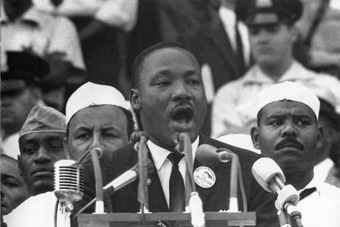
Dr. Martin Luther King Jr.
Dr. Martin Luther King Jr. delivering his famous “I Have a Dream” speech

Methodist Church in Mississippi
Louise United Methodist Church, Louise, Mississippi
14.8.2: Catholicism
Catholicism has a long history in the U.S., with the Catholic Church the single largest religious denomination in the United States.
Learning Objective
Describe why Catholics in the U.S. were initially perceived as a threat by some Protestants and how that bias was more or less overcome
Key Points
- The Pope is the head of the Catholic Church and faith.
- Immigrants in the 19th century made Catholicism the largest religion in the United States.
- Acquisition of territories in the 19th century, formerly possessions of France, Spain, and Mexico, added to the Catholic population in the United States.
Key Term
- parish
-
An administrative part of a diocese that has its own church; found in the Anglican, Eastern Orthodox and Catholic Church and certain civil government entities.
Example
- Estimates of the overall American Catholic population from recent years generally range from 20% to 28%.
The Catholic Church in the United States is part of the worldwide Catholic Church, or the Christian Church that is in full communion with the Pope. It is the largest single religious denomination in the U.S., comprising about 25% of the population. According to a 2011 study by the Center for Applied Research in the Apostolate at Georgetown University, the U.S. Catholic population is currently 77.7 million. The U.S. has the fourth largest Catholic population in the world after Brazil, Mexico and the Philippines.
Catholicism arrived in what is now the U.S. during the earliest days of the European colonization of the Americas. The first Catholic missionaries were Spanish, having come with Christopher Columbus to the New World on his second voyage in 1493. They established missions in what are now Florida, Georgia, Texas, New Mexico, California, and the Commonwealth of Puerto Rico. French colonization came in the early 18th century, with the French establishing missions in the Louisiana Territory districts – St. Louis, New Orleans, Biloxi, Mobile, Alabama, Natchez, Yazoo, Natchitoches, Arkansas, Illinois, and Michigan.
Catholicism’s Growth and Prosecution
Catholicism has grown during the country’s history. It started slowly in the early 19th century through immigration and acquisition of territories with predominately Catholic populations. In the mid-19th century, a rapid influx of Irish and German immigrants made Catholicism the largest religion in the U.S. This increase of Catholics was met by widespread prejudice and hostility, often resulting in riots and the burning of churches. The nativist Know Nothing party was first founded in the early 19th century in an attempt to restrict Catholic immigration. This party believed that the U.S. was a Protestant nation and the influx of Catholics threatened its purity and mission..
Since the 1960s, the percentage of Americans who are Catholic has stayed roughly the same, at around 25%, due in large part to increases in the Latino population over the same period.
By far, most Catholics in the U.S. belong to the Latin Church and the Latin Rite of the Catholic Church. Rite generally refers to the form of worship “liturgical rite” in a church, community owing to cultural and historical differences as well as differences in practice. However, the Vatican II document Orientalium Ecclesiarum “Of the Eastern Churches” acknowledges that these Eastern Catholic communities are “true Churches” and not just rites within the Catholic Church. There are 14 other Churches in the U.S. (23 within the global Catholic Church) that are in communion with Rome and fully recognized in the eyes of the Catholic Church. They have their own bishops and eparchies. The largest of these communities in the U.S. is the Chaldean Catholic Church. Most of these Churches are of Eastern European and Middle Eastern origin. Eastern Catholic Churches are distinguished from Eastern Orthodox, identifiable by their usage of the term Catholic.
By 1850, Catholics had become the country’s largest single denomination. Between 1860 and 1890, their population in the U.S. tripled through immigration; by the end of the decade it would reach seven million. This influx would eventually bring increased political power for the Catholic Church and a greater cultural presence. This led to a growing fear of the Catholic “menace” among America’s Protestants. Some anti-Catholic political movements like the Know Nothings, as well as organizations like the Orange Institution, American Protective Association, and the Ku Klux Klan, were active in the U.S. during this period. Indeed, for most of the country’s history, Catholics have been victims of discrimination and persecution. It was not until the presidency of John F. Kennedy that Catholics lived largely free of suspicion.
There are 68,503,456 registered Catholics in the U.S. (22% of the US population), according to the American Bishops’ count in their Official Catholic Directory 2010. This count primarily rests on the parish assessment tax that pastors evaluate yearly according to the number of registered members and contributors. Estimates of the overall American Catholic population from recent years generally range from 20% to 28%.

Assumption Catholic Church
The oldest Catholic Church in St. Paul.
14.8.3: Judaism
Judaism is the religion, philosophy, and way of life of the Jewish people.
Learning Objective
Discuss the similarities and differences between Judaism and other religions, such as Christianity and Islam, and identify characteristics of the American Jewish population
Key Points
- The Jewish community in the United States is composed predominantly of Ashkenazi Jews who emigrated from Central and Eastern Europe, and their U.S.-born descendants.
- Jewish ethnic divisions are also represented, including Sephardi Jews, Mizrahi Jews, and a number of converts.
- American Jews are more likely to be atheist or agnostic than most Americans, especially so compared with Protestants or Catholics.
- The Holocaust was the genocide of approximately six million European Jews during World War II.
Key Terms
- agnostic
-
Doubtful or uncertain about the existence or demonstrability of God or other deity.
- Sephardi
-
a Jew of Iberian ancestry, whose native language was Ladino
Example
- Released in the 2006, the American Jewish Yearbook population survey estimates the number of American Jews at 6.4 million, or approximately 2.1% of the total population. This figure is significantly higher than the previous large-scale survey estimate, conducted by the 2000–2001 National Jewish Population estimates, which estimated 5.2 million Jews.
Judaism is the religion, philosophy, and way of life of the Jewish people. It is a monotheistic religion originating in the Hebrew Bible (also known as the Tanakh) and explored in later texts such as the Talmud. Judaism is considered by religious Jews to be the expression of the covenantal relationship God established with the Children of Israel. Rabbinic Judaism holds that God revealed his laws and commandments to Moses on Mount Sinai in the form of both the Written and Oral Torah. The sacred texts of Judaism tends to overlap with many of the stories from Christianity and Islam. The Tanakh consists of the same books as the Christian Old Testament, with minor changes in the order of stories.
Judaism in the United States
American Jews, also known as Jewish Americans, are American citizens of the Jewish faith or Jewish ethnicity. The Jewish community in the United States is composed predominantly of Ashkenazi Jews who emigrated from Central and Eastern Europe, and their U.S.-born descendants. Minorities from all Jewish ethnic divisions are also represented, including Sephardi Jews, Mizrahi Jews, and a number of converts. The American Jewish community manifests a wide range of Jewish cultural traditions, as well as encompassing the full spectrum of Jewish religious observance.
Depending on religious definitions and varying population data, the United States is home to the largest or second largest (after Israel) Jewish community in the world. The population of American adherents of Judaism was estimated to be approximately 5,128,000 or 1.7% of the total population in 2007 (301,621,000); including those who identify themselves culturally as Jewish (but not necessarily religiously), this population was estimated at 6,489,000 (2.2%) as of 2008. As a contrast, Israel’s Central Bureau of Statistics estimated the Israeli Jewish population was 5,664,000 in 2009 (75.4% of the total population).
Jews have been present in what is today the United States of America as early as the 17th century. Large scale Jewish immigration, however, did not begin until the nineteenth century, when, by mid-century, many secular Ashkenazi Jews from Germany arrived in the United States, primarily becoming merchants and shop-owners. There were approximately 250,000 Jews in the United States by 1880, many of them being the educated, and largely secular, German Jews, although a minority population of the older Sephardic Jewish families remained influential.
Jewish immigration to the United States increased dramatically in the early 1880s, as a result of persecution and economic difficulties in parts of Eastern Europe. Most of these new immigrants also were Yiddish-speaking Ashkenazi Jews, though most came from the poor rural populations of the Russian Empire and the Pale of Settlement, located in modern-day Poland, Lithuania, Belarus, Ukraine and Moldova. During the same period, a great number of Ashkenazi Jews arrived also from Galicia, at that time the most impoverished region of Austro-Hungarian Empire with heavy Jewish urban population, driven out mainly by economic reasons. Most settled in the New York metropolitan area, establishing what became one of the world’s major concentrations of Jewish population.
American Jews are more likely to be atheist or agnostic than most Americans, especially so compared with Protestants or Catholics. A 2003 poll found that while 79% of Americans believe in God, only 48% of American Jews do, compared with 79% and 90% for Catholics and Protestants respectively. While 66% of Americans said they were “absolutely certain” of God’s existence, 24% of American Jews said the same. And though 9 percent of Americans believe there is no God (8% Catholic and 4% Protestant), 19 percent of American Jews believe God does not exist.
Though Jewish views on evolution are varied, most schools of Jewish thought have reconciled Judaism with evolution. A 2009 Harris Poll showed American Jews as the religious group most accepting of evolution, with 80% believing in evolution, compared to 51% for Catholics, 32% for Protestants, and 16% of Born-again Christians. They were also less likely to believe in supernatural phenomena such as miracles, angels, or heaven.

A Haredi Jew in New York CIty
The Haredi Jews are the most conservative of Orthodox Jews.
14.8.4: Islam
The American Muslim population is a racially diverse group that has been present in the U.S. since before the Civil War.
Learning Objective
Discuss the history and characteristics of the American Muslim population in the U.S., including periods of arrival and religious affiliations
Key Points
- Many of the slaves brought to colonial America from Africa were Muslims. By 1800, some 500,000 Africans arrived in what became the United States. Historians estimate that between 15 to 30 percent of all enslaved African men, and less than 15 percent of the enslaved African women, were Muslims.
- American Muslims come from various backgrounds, and are one of the most racially diverse religious groups in the United States according to a 2009 Gallup poll. Native-born American Muslims are mainly African Americans who make up about a quarter of the total Muslim population.
- Unlike many Muslims in Europe, American Muslims do not tend to feel marginalized or isolated from political participation. Several organizations were formed by the American Muslim community to serve as ‘critical consultants’ on U.S. policy regarding Iraq and Afghanistan.
- Mosques are places of worship for Islamic religions.
- In the United States there exist a number of different traditions. As in the rest of the world, the Sunni Muslims are in the majority. Shia Muslims, especially those in the Iranian immigrant community, are also active in community affairs.
Key Terms
- Nation of Islam
-
A religious and political organization with the declared aim of “resurrecting” the spiritual, mental, social and economic condition of the black people of America and the world.
- mosque
-
A place of worship for Muslims, corresponding to a church or synagogue in other religions, often having at least one minaret; a masjid.
- Muslim
-
A person who is a follower and believer of the Islamic faith.
Example
- Muslims comprise less than two percent of the American population, but they account for approximately one quarter of the religious discrimination. These claims were filed with the Equal Employment Opportunity Commission during 2009.
Islam in the United States
Once very small, the Muslim population of the U.S. increased greatly in the 20th century, with much of the growth driven by rising immigration and conversion, and a comparatively high birth rate. In 2005, more people from Islamic countries became legal permanent United States residents than in any year in the previous two decades (nearly 96,000). In 2009, more than 115,000 Muslims became legal residents of the United States.
American Muslims come from various backgrounds, and are one of the most racially diverse religious groups in the United States according to a 2009 Gallup poll. Immigrant communities of Arab and South Asian descent make up the majority of American Muslims. Native-born American Muslims are mainly African-Americans who make up about a quarter of the total Muslim population. Many of these have converted to Islam during the last seventy years. Conversion to Islam in prison and in large urban areas has also contributed to its growth over the years.
Slavery and Islam
Many of the slaves brought to colonial America from Africa were Muslims. By 1800, some 500,000 Africans arrived in what became the United States. Historians estimate that between 15 to 30 percent of all enslaved African men, and less than 15 percent of the enslaved African women, were Muslims. These enslaved Muslims stood out from their compatriots because of their “resistance, determination, and education”.
Modern Migration
Small-scale migration to the U.S. by Muslims began in 1840, with the arrival of Yemenis and Turks, and lasted until World War I. Most of the immigrants, coming from Arab areas of the Ottoman Empire, came with the purpose of making money and returning to their homeland. However, the economic hardships of 19th century America prevented them from prospering. As a result, the immigrants settled in the United States permanently. These immigrants settled primarily in Dearborn, Michigan; Quincy, Massachusetts; and Ross, North Dakota. Ross, North Dakota is the site of the first documented mosque and Muslim cemetery, but it was abandoned and later torn down in the mid-1970s. A new mosque was built in its place in 2005.
Demographics
According to the U.S. Department of State, the largest ethnic groups of American Muslims are those of South Asian, Arab and African-American descent.
There are 1,209 mosques in the United States and the nation’s largest mosque, the Islamic Center of America, is in Dearborn, Michigan. It caters mainly to the Shi’a Muslim congregation; however, all Muslims may attend this mosque. It was rebuilt in 2005 to accommodate over 3,000 people for the increasing Muslim population in the region. Approximately half (50%) of the religious affiliations of Muslims is Sunni, 16% Shia, 22% non-affiliated and, 16% other/non-response. Muslims of Arab decent are mostly Sunni (56%) with minorities who are Shi’a (19%). Bangladeshis (90%), Pakistanis (72%), and Indians (82%) are mainly Sunni, while Iranians are mainly Shi’a (91%). Of African-American Muslims, 48% are Sunni, 34% are unaffiliated (mostly part of the Community of W. Deen Mohammed), 16% other (mostly Nation of Islam and Ahmadiyya) and 2% Shi’a.
Since the arrival of South Asian and Arab communities during the 1990s, there have been divisions with African Americans due to racial and cultural differences. However, since 9/11, the two groups joined together when the immigrant communities looked towards the African Americans for advice on civil rights.
Comparison to Other Religions
Islam has similarities with other American-practiced religions, including Protestantism and Christianity. Some of the similarities include a belief in a single God, who is supreme to all other gods. Many of the religious stories told in these religions share a similar thread, although certain details or the order of the story may be slightly different, depending upon the religious text it comes from. Also, these religious all believe in an afterlife, promoting good behaviors and adherence to religious doctrine in order to ensure entrance to this revered place.
American Islamic Culture
Muslims in the United States have increasingly contributed to American culture; there are various Muslim comedy groups, rap groups, Scout troops and magazines.
Some Muslims in the U.S. are also adherents of certain global movements within Islam such as the Salafi, the Muslim Brotherhood, the Gulen Movement, and the Tablighi Jamaat.
Muslim Integration into American Society
Unlike many Muslims in Europe, American Muslims do not tend to feel marginalized or isolated from political participation. Several organizations were formed by the American Muslim community to serve as ‘critical consultants’ on U.S. policy regarding Iraq and Afghanistan. Other groups have worked with law enforcement agencies to point out Muslims within the United States that they suspect of fostering ‘intolerant attitudes’. Still others have worked to invite interfaith dialogue to improve relations between Muslim and non-Muslim Americans.
A Pew report released in 2009 noted that nearly six-in-ten American adults see Muslims as being subject to discrimination, more than Mormons, Atheists, or Jews. While Muslims comprise less than two percent of the American population, they accounted for approximately one quarter of the religious discrimination claims filed with the Equal Employment Opportunity Commission during 2009.

Masjid Malcolm Shabazz Mosque
Mosque in New York City.
14.8.5: Social Correlates of Religion
There are correlations between the degree of religious belief in society and social factors like mortality rates, wealth and happiness.
Learning Objective
Identify what might be a tension in understanding highly religious nations and highly religious people
Key Points
- Some sociological research indicates that highly religious, developed nations have higher rates of homicide, mortality, sexually transmitted infections, teen pregnancies, and abortions, whereas so-called “Godless” developed nations have significantly lower mortality rates.
- A BBC research study on religion in Europe suggests that religious belief has declined over the years.
- A study by sociologist Lisa A. Keister found that adherents of Judaism and Episcopalianism attained the most wealth; believers of Catholicism and mainline Protestants were in the middle; and conservative Protestants accumulated the least wealth.
- Surveys by Gallup, the National Opinion Research Center and the Pew Organization conclude that spiritually committed people are twice as likely to report being “very happy” than the least religiously committed people.
Key Term
- National Opinion Research Center
-
NORC at the University of Chicago, established in 1941 as the National Opinion Research Center, is one of the largest and most highly respected social research organizations in the United States.
Example
- The correlation between higher rates of happiness and religious affiliation has been demonstrated by several studies. For instance, of 498 studies published in peer-reviewed journals, a large majority showed a positive correlation between religious commitment and higher levels of perceived well-being and self-esteem and lower levels of hypertension, depression and clinical delinquency.
Religion’s Impact on Societies
Research indicates that in prosperous democracies, higher rates of belief in and worship of a creator correlate with higher rates of homicide, juvenile and early adult mortality, STD infection rates, teen pregnancy, and abortion. As author Stephen Law paraphrases in his book “War For the Children’s Mind,” “The most theistic prosperous democracy, the U.S., is exceptional, but not in the manner Franklin predicted. The United States is almost always the most dysfunctional of the developed democracies, sometimes spectacularly so…The view of the U.S. as a ‘shining city on the hill’ to the rest of the world is falsified when it comes to basic measures of societal health. ” In other words, the U.S., a theistic and prosperous nation, demonstrates that religiosity doesn’t necessarily correlate with creating cultures that reduce death.
The study also notes that more secular, pro-evolution societies come closer to “cultures of life. ” Although these countries are far from perfect, they have, for example, low rates of lethal crime. The authors conclude that the reasonable success of non-religious democracies like Japan, France and Scandinavia has refuted the idea that Godless societies suffer disaster. They add, “Contradicting these conclusions requires demonstrating a positive link between theism and societal conditions in the first world with a similarly large body of data – a doubtful possibility in view of the observable trends. “
BBC news reported on a study that attempted to use mathematical modeling to predict future religious orientations of populations. The study suggests that religion is headed towards “extinction” in various nations where it has been on the decline: Australia, Austria, Canada, the Czech Republic, Finland, Ireland, the Netherlands, New Zealand and Switzerland. The model considers not only the changing number of people with certain beliefs, but also attempts to assign utility values of a belief as per each nation .
Wealth and Organized Religion
A U.S. study conducted by sociology researcher Lisa A. Keister found that Jewish and Episcopalian adherents attained the most wealth. Believers of Catholicism and mainline Protestants were in the middle, and conservative Protestants accumulated the least wealth. In general, people who attend religious services achieved more wealth than those who do not (taking into account variations of education and other factors). The researcher suggests that wealth accumulation is shaped by family processes.
The median net worth of people believing in the Jewish religion is calculated at $150,890, while the median net worth of conservative Protestants (including Baptists, Jehovah’s Witnesses, Seventh-day Adventists, and Christian Scientists) was found at $26,200. The overall median in the dataset was $48,200.
Another study by Keister found that “religion affects wealth indirectly through educational attainment, fertility and female labor force participation. ” The study also found evidence of direct effects of religion on wealth attainment.
Religion and Happiness
Religion and happiness have been studied by a number of researchers. The science of positive psychology has identified many components of happiness, and religion seems adapted to satisfy many of them. Some research suggests that both non-religious and religious meaning systems can be quite effective when it comes to managing death anxiety, and that the latter have a few additional advantages.
Surveys by Gallup, the National Opinion Research Center and the Pew Organization conclude that spiritually committed people are twice as likely to report being “very happy” than the least religiously committed people. An analysis of over 200 social studies contends that “high religiousness predicts a lower risk of depression and drug abuse and fewer suicide attempts, and more reports of satisfaction with sex life and a sense of well-being. ” A review of 498 studies published in peer-reviewed journals concluded that a large majority of them showed a positive correlation between religious commitment and higher levels of perceived well-being and self-esteem and lower levels of hypertension, depression, and clinical delinquency.
A meta-analysis of 34 recent studies published between 1990 and 2001 found that religiosity has a salutary relationship with psychological adjustment related to less psychological distress, more life satisfaction and better self-actualization. Finally, a recent systematic review of 850 research papers concluded that “the majority of well-conducted studies found that higher levels of religious involvement are positively associated with indicators of psychological well-being (life satisfaction, happiness, positive affect and higher morale) and less with depression, suicidal thoughts and behavior, and drug/alcohol use/abuse. “

Religion versus GDP per Capita
Wealth and religion
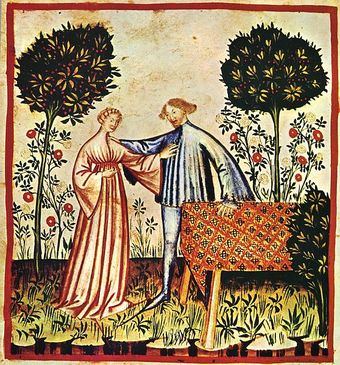
Religion and happiness
The science of positive psychology has identified many components of happiness, and religion seems adapted to satisfy many of them. Some research suggests that both non-religious and religious meaning systems can be quite effective when it comes to managing death anxiety, and that the latter have a few additional advantages.
14.8.6: Affiliation
The main religious preferences in the Unites States include (in order): Christianity, unaffiliate, Judaism, Islam, Buddhism, and Hinduism.
Learning Objective
Diagram religious and non-religious beliefs in the U.S. according to popularity
Key Points
- The U.S. is a very religiously diverse country. People who identify as Christians in the U.S. encompass the majority of the population, although there are a wide variety of denominations that have developed since the introduction of Christianity in colonial times.
- Unaffiliated beliefs, including atheism and agnosticism, are the second largest group. Judaism is the third largest group, and Islam, Buddhism, Hinduism, and other beliefs are less than one percent of the population.
- According to recent surveys, 83% of Americans identify with a religious denomination. A majority of Americans report that religion plays a “very important” role in their lives, a proportion unique among developed nations.
- The First Amendment guarantees the free exercise of religion while also preventing the government from establishing a state religion.
Key Terms
- agnosticism
-
The view that the existence of God or of all deities is unknown, unknowable, unproven, or unprovable.
- denomination
-
A class, or society of individuals, called by the same name; a sect; as, a denomination of Christians.
Example
- From the early colonial days, when some English and German settlers came in search of religious freedom, America has been profoundly influenced by religion. That influence continues in American culture, social life, and politics.
Religion in the United States is characterized by both a wide diversity of religious beliefs and practices and by a high adherence level. According to recent surveys, 83% of Americans identify with a religious denomination, 40% state that they attend services nearly every week or more, and 58% say that they pray at least weekly. A majority of Americans report that religion plays a “very important” role in their lives, a proportion unique among developed nations. Many faiths have flourished in the United States, including both later imports spanning the country’s multicultural immigrant heritage, as well as those founded within the country; these have led the United States to become one of the most religiously diverse countries in the world.
The majority of Americans (76% to 80%) identify themselves as Protestants or Catholics, accounting for 51% and 25% of the population respectively. Non-Christian religions (including Judaism, Islam, Buddhism, Hinduism, etc.), collectively make up about 5% of the adult population. Another 15% of the adult population claims no religious affiliation. When asked, about 5.2% said they did not know or refused to reply. According to the American Religious Identification Survey, religious belief varies considerably by region. The lowest rate is in the West with 59% reporting a belief in God, and the highest rate in the South (the “Bible Belt”) at 86%.
Despite a high level of religious adherence, only 9% of Americans in a 2008 poll said religion was the most important thing in their life, compared with 45% who said family was paramount in their life and 17% who said money and career was paramount. Mark Chaves, a Duke University professor of sociology, religion, and divinity, found that 92% of Americans believed in God in 2008, but that they have significantly less confidence in their religious leaders than they did a generation ago.
From the early colonial days, when some English and German settlers came in search of religious freedom, America has been profoundly influenced by religion. That influence continues in American culture, social life, and politics. Several of the original 13 colonies were established by settlers who wished to practice their own religion within a community of like-minded people: the Massachusetts Bay Colony was established by English Puritans (Congregationalists), Pennsylvania by British Quakers, Maryland by English Catholics, and Virginia by English Anglicans.
The U.S. Census does not ask about religion. Various groups have conducted surveys to determine approximate percentages of those affiliated with each religious group. Some surveys ask people to self-identify, while others calculate church memberships. Christianity comprises 59.9% to 78.4% of affiliation, unaffiliated, including atheist or agnostic are 15.0% to 37.3%, Judaism are 1.2 % to 2.2 %, Islam about .6%, Buddhism 0.5 % to 0.9%, Hinduism 0.4% and other religions 1.2% to 1.4% in the United States.

Salt Lake Temple, Utah
It is the sixth temple completed by the church, requiring 40 years to complete, and the fourth operating temple built since the Mormon exodus from Nauvoo, Illinois.
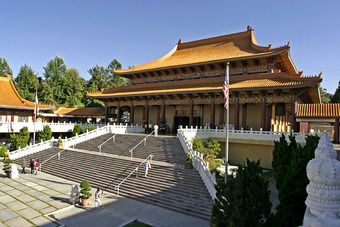
Lightmatter Hsi Lai Temple in Los Angeles, California
The Hsi Lai Temple is the largest Buddhist temple in the United States.
